
Hotels in Pokhara for Couples for a Vacation: Price & Location
Pokhara is a city nestled in a beautiful valley in Nepal that stands as a testament to the epitome of romance. Pokhara has become a must-visit destination for couples seeking a peaceful getaway with its serene lakes, majestic mountains, and tranquil ambiance. This blog aims to guide you through the enchanting realm of the Hotel in Pokhara for a romantic stay, to enhance your vacation experience.
Pokhara known as the “City of Lakes,” captivates visitors worldwide with its natural beauty and cultural charm. Surrounded by the Annapurna and Machapuchare mountain ranges, the city provides a breathtaking backdrop for romantic escapades. The serene Phewa Lake mirrors the snow-capped peaks, creating a tranquil atmosphere that adds up to love and intimacy.
Importance of Choosing the Right Hotel for Couples
Couples can explore the city hand in hand, reveling in the beauty of Devi’s Fall, strolling through the vibrant Lakeside, or trying a boat ride across Phewa Lake as the sun sets behind the hills. Let’s talk about hotels in Pokhara for couples, as the accommodation becomes an integral part of the romantic escape. Pokhara’s nature and culture offer an ideal setting for couples to create lasting memories in an environment that screams romance.
While the destination sets the stage, the choice of accommodation can elevate your romantic retreat to remarkable heights. The right hotel becomes more than just a place to spend a night, it becomes an integral part of the romantic experience. From the ambiance and amenities to the personalized services, the hotel plays a crucial role in shaping the overall mood of your stay.
Selecting a hotel that caters specifically to couples ensures that every moment is designed to enhance intimacy and connection. Whether it’s a cozy room with a panoramic view, a spa retreat for two, or a private dining experience under the stars, the right hotel adds an extra layer of magic to your romantic getaway. In this blog, we will focus on the key factors to consider when choosing hotels in Pokhara for couples, guiding you toward an unforgettable experience in this romantic haven.
Factors to Consider When Choosing a Hotel
When selecting a hotel in Pokhara for a romantic holiday, consider location and proximity to key attractions and ease of transportation. Additionally, ambiance, accommodation options, and available amenities ensure a comfortable and memorable stay.
- Location
When choosing a hotel in Pokhara for a romantic getaway, the location becomes a key factor. Ensure that the hotel is near popular romantic spots. The convenience of being near these attractions allows couples to immerse themselves in the city’s charm effortlessly. Additionally, consider the accessibility to transportation, ensuring that you can explore Pokhara easily and return to the hotel with ease after a day of adventure.
- Ambiance and Atmosphere
The ambiance and atmosphere of a hotel set the tone for a romantic retreat. Look for accommodations that offer a romantic and cozy setting, providing an intimate atmosphere for you and your partner. Seek hotels that provide beautiful views, whether Phewa Lake, Annapurna range, or the lush greenery surrounding Pokhara. A hotel with a captivating ambiance ensures that every moment spent together is filled with romance.
- Accommodation Options
The type of accommodation can significantly enhance your romantic experience. Opt for hotels that offer suites and rooms specifically designed for couples, providing a comfortable and intimate space. Look for amenities such as private balconies or Jacuzzis, adding a touch of luxury to your stay. A thoughtfully designed room can be a haven for intimate moments, allowing you to unwind and connect in a personalized setting.
- Dining Options
A truly romantic experience involves not only the destination but also the dining experience. Choose hotels with on-site restaurants that have a romantic ambiance, for a candlelit dinner with lakeside views or a rooftop terrace overlooking the mountains. Some hotels go the extra mile by offering special arrangements for private dining, allowing you to savor a romantic meal in a more intimate and personalized setting.
- Recreational Facilities
To further enhance your stay, consider the recreational facilities offered by the hotel. Look for accommodations that provide spa and wellness services, allowing you and your partner to indulge in relaxation and rejuvenation. Outdoor activities or recreational options provided by the hotel can also add an element of adventure to your romantic escape, creating a well-rounded experience for you both to enjoy.
List of Hotels in Pokhara for Couples
Glacier Hotel: Luxury Boutique Hotel
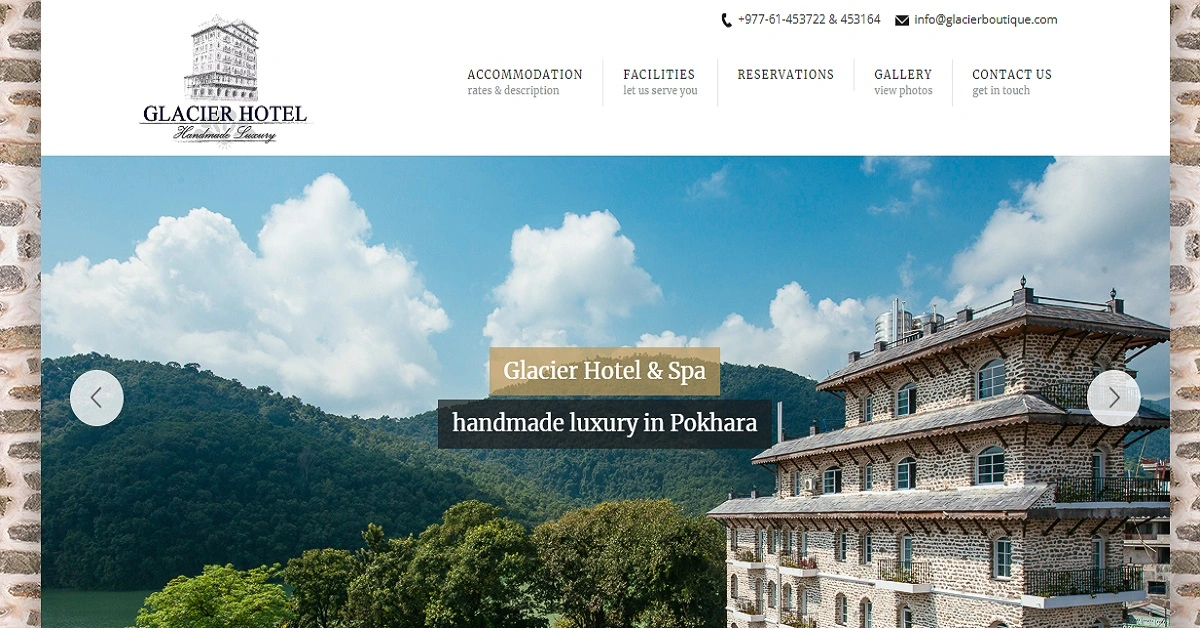
In the heart of Pokhara, Glacier Hotel stands out as a luxury boutique haven for couples. Its striking natural stone design complements the serene Lakeside location, offering breathtaking views of the Annapurna and Dhaulagiri ranges, Phewa Lake, and the Raniban forest. The Honeymoon Suite, with large windows and private balconies, provides couples with magnificent views of the Annapurnas and the city of Pokhara, creating an enchanting atmosphere for a romantic escape.
Estimated Cost Per Night: Rs.12,000 -14,000
Contact Details:
- Location: Lake Side 6, Gaurigaht, Pokhara
- Contact: 061-453164
- Map: Get Direction
- Website: Glacier Hotel
Features:
- Spa
- Friendly Staff
- Airport Shutter
- 24-hour Front Desk
- Mediterranean Restaurant
- Travel and tourist information
Hotel Sarowar: Eco-Friendly Hotel in Pokhara
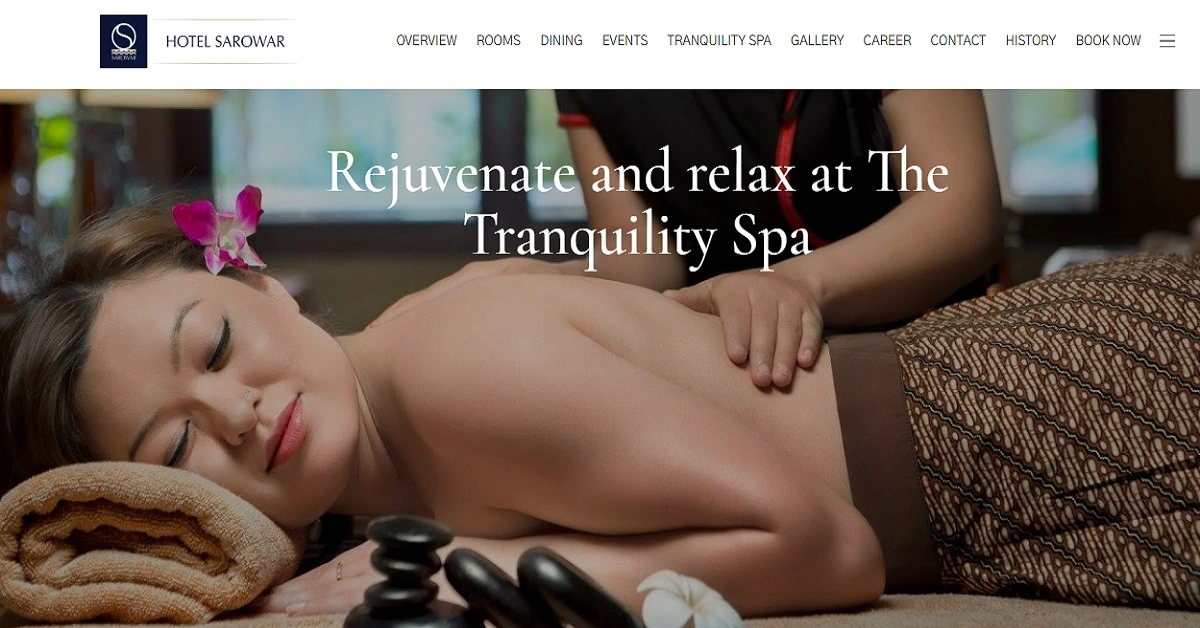
Hotel Sarowar, a 5-star hotel pampers couples with world-class service and a celebrity treatment experience. Nestled 1.3 km from Fewa Lake, the hotel offers an outdoor swimming pool, city-view rooms, and an array of amenities. With a sauna, shared lounge, and terrace, Hotel Sarowar ensures a luxurious stay, also its proximity to Lakeside and other attractions adds the appeal for couples seeking both tranquility and adventure.
Estimated Cost Per Night: Rs. 9,000- 13,000
Contact Details:
- Location: Lakeside-6, Pokhara
- Contact: 061-506302
- Map: Get Direction
- Website: Hotel Sarwar
Features:
- Spa
- BBQ
- Wi-fi
- Sauna
- Beautiful View
- Swimming Pool
Majestic Lake Front Hotel & Suites
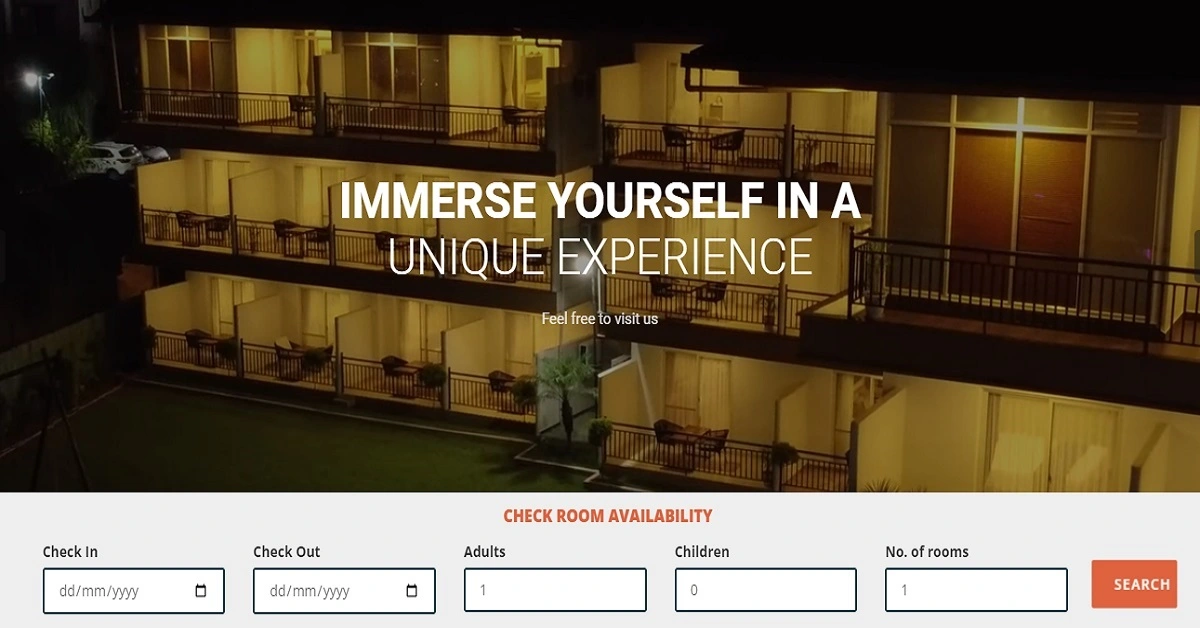
Majestic Lakefront Hotel & Suites, located on 18B Street, seamlessly blend luxury and tranquility with stunning views of Phewa Lake. The well-appointed suites and the charming Ray’s Coffee Shop provide a serene atmosphere for couples to immerse themselves in a unique and unforgettable romantic stay in Pokhara for couples.
Estimated Cost Per Night: Rs.8,000-10,000
Contact Details:
- Location: Baidam Road, Pokhara
- Contact: 061-591601
- Map: Get Direction
- Website: Majestic Lake Front Hotel & Suites
Features:
- Restaurant
- Coffee Shop
- Amazing Lake View
- EV- Charging Station
- Children’s Playground
- Suits and Family Room
Lake View Resort
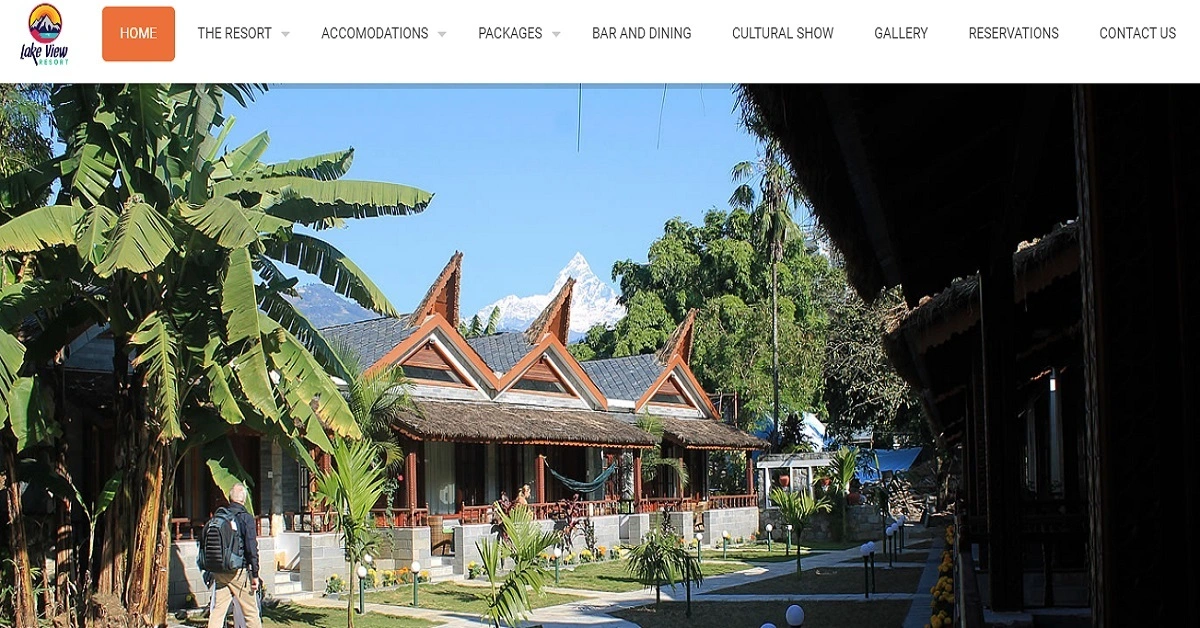
Lake View Resort offers an unparalleled experience for couples allowing spectacular views of Phewa Lake and the Himalayas. The resort provides professional staff, 100,000 square feet of lush greenery, and 21 deluxe bedrooms. For those seeking a more private retreat, the resort offers luxury huts, making it an ideal choice for couples desiring both comfort and peace.
Estimated Cost Per Night: Rs. 4,000 – 6,000
Contact Details:
- Location: Main Road 126, Pokhara
- Contact: 061-451477
- Map: Get Direction
- Website: Lake View Resort
Features:
- Bar
- Lake View
- Private Huts
- Cultural Shows
- Holiday Packages
- Fantastic Food Menu
Hotel White Pearl: Tranquline Retreat

Hotel Peace Plaza, just 60 meters from Phewa Lake, is a tranquil retreat with panoramic lake views. Couples can enjoy complimentary Wi-Fi, a cozy in-house restaurant serving Nepalese and Continental delights, and a convenient location within a 10-minute drive from Pokhara Tourist Bus Station. Some services of the hotels are luggage storage, and tour desk services, making it a practical and peaceful choice for couples.
Estimated Cost Per Night: Rs.5,000 – 8,000
Contact Details:
- Location: Street No.13, Lakeside, Pokhara
- Contact: 061-455600
- Map: Get Direction
- Website: Hotel White Pearl
Features:
- Restaurant
- Lakeside View
- Mountain View
- Travel Assistance
- Tranquil Atmosphere
- Family-Friendly Hotel
Affordable Option: Hotel Peace Plaza
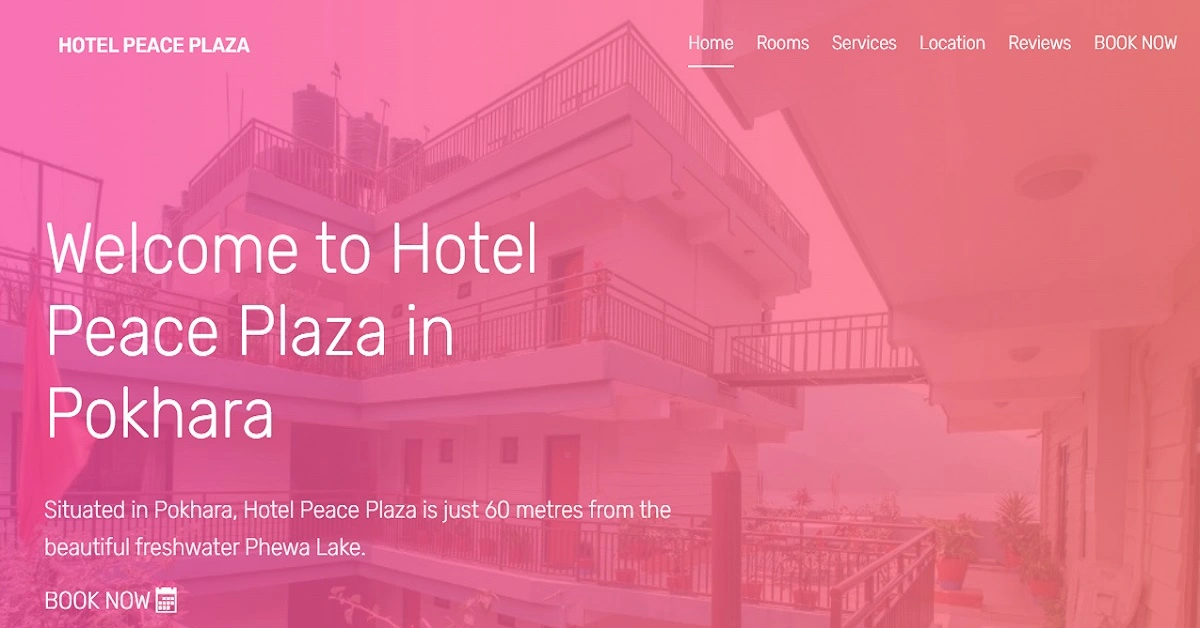
Hotel White Pearl is a serene escape for couples, located 60 meters from Phewa Lake. The hotels offer complimentary Wi-Fi, sweeping panoramic views of the lake, and delicious Nepalese dishes. Accessible location, round-the-clock front desk, a range of services, and affordability make the Hotel White Pearl a top-notch choice for couples.
Estimated Cost Per Night: Rs. 2,000 – 4,000
Contact Details:
- Location: Lakeside Road 06, Pokhara
- Contact: 061-461505
- Map: Get Direction
- Website: Hotel Peace Plaza
Features:
- Wi-Fi
- Free Parking
- Room service
- Family Rooms
- Airport Shuttle
- Great Location
Tips for a Memorable Romantic Stay
Romantic Boat Rides on Phewa Lake/Begnas Lake:
Enhance your romantic getaway by embarking on a serene boat ride across the captivating Phewa Lake or the tranquil Begnas Lake. Glide along the crystal-clear waters, surrounded by the breathtaking panorama of the mountain range, and hills creating a magical setting for intimate moments.
Exploring the Gupteshwor Cave Together:
Explore the mystique of Pokhara by exploring the enchanting Gupteshwor Cave as a couple. Wander through the hidden passages and witness the awe-inspiring underground waterfall, creating a sense of adventure and shared exploration.
Tandem Bungee Jumping for Adventurous Couples:
For adventurous souls, you can spice up your romantic stay with a thrilling experience of tandem bungee jumping at Hemja Pokhara. Share the excitement and adrenaline rush with your partner as you leap together, creating a unique and unforgettable bond.
Short Hike near the City:
Immerse yourselves in nature by embarking on a short hike near the city. Discover hidden trails and enjoy each other’s company amidst the serene beauty of Pokhara’s surroundings.
Cycling Day Tour:
Explore Pokhara Valley on a cycling day tour, pedaling through scenic routes together, and creating cherished memories.
Do a Helicopter Landing at Everest Basecamp:
Boost your romantic adventure with a helicopter landing at Everest Basecamp. Soar above the majestic Himalayas and share the awe-inspiring views of the world’s highest peaks.
-
Communicating with the Hotel Staff for Special Arrangements
Surprise Room Decorations:
Elevate the romance by requesting the hotel staff for surprise room decorations. Whether it is a bed decorated with flower petals, romantic lighting, or a personalized touch, these thoughtful gestures can turn your accommodation into a haven of love.
Arranging for Special Events or Experiences:
Work closely with the hotel staff to plan special events or experiences tailored for you and your partner. This could include arranging a private movie night under the stars, organizing a personalized celebration, or even coordinating a surprise performance, making your stay truly memorable.
-
Utilizing Hotel Amenities for a Romantic Experience
Spa Treatments for Couples:
Indulge in relaxation by taking advantage of the spa treatments offered by the hotel. Pamper yourselves with a couples massage or a rejuvenating spa day, allowing you both to unwind and connect in a tranquil and intimate setting.
Spend a Day at the Swimming Pool and Drink from the Hotel Bar:
Enjoy a day at the hotel’s swimming pool, followed by refreshing drinks from the hotel bar. Lounge together and soak up the sun, creating a perfect day of relaxation and shared enjoyment.
Enjoying a Private Dinner with Scenic Views:
Utilize the hotel’s amenities by arranging a private dinner with scenic views. A rooftop setting overlooking the city lights, a lakeside table with the mountains in the background, savor a romantic meal in a secluded and breathtaking atmosphere are few to name.
Final Say
In the journey through the enchanting realm of romantic hotels in Pokhara for couples, we have explored the magical elements that make this city an ideal destination for couples seeking an unforgettable escape. From the serene boat rides on Phewa Lake to the adventurous tandem bungee jumping at Hemja Pokhara, and the intimate exploration of trekking trails, Pokhara offers a diverse range of experiences for couples.
As you plan your romantic getaway in Pokhara, remember that the choice of hotel can transform your experience from memorable to extraordinary. Whether you seek a cozy retreat with private balconies, a spa haven for couples, or a dining experience with scenic views, the hotel in Pokhara offers a variety of options to cater to your desires.
Choosing the right hotel is paramount, and we have highlighted key factors to consider, from the location’s proximity to romantic spots and accessibility to transportation to the ambiance, accommodation options, dining choices, and recreational facilities provided by the hotel.
May your stay in Pokhara be filled with love, shared adventures, and moments that transcend the ordinary, creating a chapter in your love story that you will cherish for a lifetime. Happy Vacation!
FAQ’s
- What makes a hotel suitable for couples in Pokhara?
A hotel for couples in Pokhara should offer a romantic ambiance, be strategically located in proximity to key attractions, provide luxurious and intimate accommodation options, and offer facilities for couples, such as private balconies, spa services, and special dining experiences.
- Are there hotels in Pokhara with views of the Annapurna range and Phewa Lake?
Yes, several hotels in Pokhara, such as Glacier Hotel and Majestic Lakefront Hotel & Suites, offer rooms and suites with spectacular views of the Annapurna and Dhaulagiri ranges, as well as Phewa Lake.
- Are there affordable hotels in Pokhara for couples?
Yes, there are affordable options available for couples in Pokhara. The blog features a variety of hotels that cater to different budget ranges, ensuring a comfortable stay without compromising on quality.
- Can you recommend a 3-star hotel for couples in Pokhara?
Hotel Peace Plaza, Lake View Resort, and Glacier Hotel, mentioned in our blog, are excellent 3-star options that offer a delightful experience for couples in Pokhara.
- Which is the best honeymoon hotel in Pokhara?
Among the highlighted hotels, Glacier Hotel stands out as an ideal choice for honeymooners. It offers a dedicated Honeymoon Package, providing special amenities and an enchanting atmosphere for couples celebrating their honeymoon.
- What is the average cost of hotels in Pokhara for couples?
The average cost of hotels in Pokhara for couples can range from Rs. 2,000 to Rs. 15,000 and above per night. You can choose accommodations that suit your preferences and budget, ensuring a memorable and comfortable stay in Pokhara.
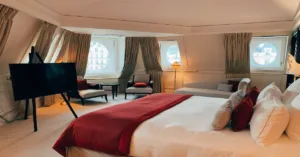
Lists of 5-Star Hotels in Pokhara for Your Luxe Stay
Nestled near the majestic Annapurna Range, Pokhara is a destination that transcends ordinary travel experiences. The breathtaking sight of the sun rays hitting the serene Phewa Lake, and the golden glow on the snow-capped peaks are a few charms of Pokhara. As we traverse the realms of luxury and hospitality, we aim to guide you through the luxury offerings of 5-star hotels in Pokhara, providing insights into the lavish amenities, impeccable service, and distinctive features that define these establishments.
In this blog, we dive into why Pokhara is a destination worth discovering and why choosing a 5-star hotel for your stay can elevate your experience to unparalleled heights.
Join us as we talk about the beauty of the valley, and the tranquility of nature co-existing with the sophistication of a 5-star hotels in Pokhara. By the end of this blog, you will be familiar with the hospitality, highlights, and other essential details of these establishments.
Reasons to Visit Pokhara Valley
Pokhara is a combination of natural wonders and cultural riches that invite travelers from around the globe. Here are some reasons why this enchanting destination deserves your attention.
Natural Attractions
- The Majestic Annapurna Range: Behold the awe-inspiring Annapurna Range, dominating the skyline and providing a breathtaking backdrop to Pokhara. The snow-capped peaks, especially during sunrise and sunset, paint a mesmerizing picture that stays forever in your memory.
- Phewa Lake Serenity: Embark on a serene boat ride across the glassy waters of Phewa Lake. The lake mirrors the surrounding peaks, creating a tranquil atmosphere that invites relaxation.
- Davis Falls: Explore the mystical Devi’s Fall and the complex network of underground passages. The sheer power of the water flowing through the potholes is a testament to nature’s raw beauty.
- Sarangkot Sunrise: Sarangkot provides a panoramic canvas for this ethereal experience. You get to witness the shades of pink and gold as the sun’s rays hit the Annapurna Range.
Cultural Highlights
- Bindhyabasini Temple: Immerse yourself in the local culture at the Bindhyabasini Temple. Situated at the hilltop, this sacred site offers panoramic views of the city and the mountains, creating a serene and spiritual ambiance.
- Gupteshwor Cave: Venture into the mystical depths of this cave decked with sacred stalactites and stalagmites, creating an unearthly ambiance.
Unique Experiences
- International Mountain Museum: Dive into the history and culture of the Himalayas through exhibits, artifacts, and interactive displays that celebrate the mountaineering spirit.
- Gurkha Museum: Discover the rich military history of the Nepali Army at the Gurkha Museum. Learn about the bravery and valor of the Gurkha soldiers through engaging exhibits and artifacts.
- Old Bazaar: Stroll through the vibrant streets of Bagar, and Ganeshtol, where tradition meets modern charm. Discover local crafts, street food, and the warm hospitality of the locals.
- Local Lakeside Culture: Stroll along the Lakeside area, filled with vibrant shops, cafes, and a lively atmosphere. Engage with locals, savor traditional cuisine, and feel the pulse of Pokhara’s nightlife
Adventurous Activities
- Bungee Jumping: Feel the adrenaline rush as you leap from one of the world’s most spectacular bungee spots from the suspension bridge.
- Paragliding: Soar through the skies like a bird, capturing breathtaking views of the Annapurna Range while experiencing the thrill of paragliding.
- Rafting: Navigate the white waters of the Seti River for an adrenaline-pumping rafting experience that combines adventure with the beauty of the surrounding landscapes.
- Boating: Tranquil boating on Phewa Lake offers a serene to the more adventurous activities, allowing you to absorb Pokhara’s beauty at a leisurely pace.
- Trekking: For those seeking a more grounded adventure, trekking trails around Pokhara, like the Annapurna Base Camp trek, promise a blend of challenge and awe-inspiring landscapes.
Pokhara, with its blend of natural wonders, cultural richness, and a plethora of adventurous activities, is a destination that promises an unforgettable experience.
Why Choose a 5-star Hotel in Pokhara for your stay?
While planning your holiday in Pokhara, the choice of accommodation becomes important for your overall experience. Opting for a 5-star hotel is a preference for luxury and comfort that enhance every aspect of your journey. Here’s why choosing a 5-star hotel in Pokhara can elevate your stay:
- Top-notch Service: 5-star hotels in Pokhara are dedicated to service excellence. You can expect a level of personalized attention and care that goes beyond the ordinary in these establishments.
- Luxurious Amenities: You can indulge in a world of exceptional luxury with amenities that redefine comfort. Immerse yourself in lavish bedding, rejuvenate in the spa, and savor exquisite culinary delights from skilled chefs. 5-star hotels in Pokhara are a haven where every detail is curated to exceed your expectations.
- Impeccable Surroundings: The architecture, interiors, and landscapes of 5-star hotels in Pokhara are designed to create an atmosphere of sheer elegance. Bask in the lavish surroundings that not only provide comfort but also elevate the aesthetic appeal of your stay, enhancing your overall sense of well-being.
- Exclusive Experiences: A 5-star hotel in Pokhara is not just a place to rest, it is a portal to exclusive experiences. Enjoy access to facilities and services that are crafted to cater to your every desire, whether it is a private spa session, a gourmet dining experience, or personalized tours arranged by the hotel.
Tips for Choosing the Right Hotel
Here are some of our tips to consider while choosing 5-star hotels in Pokhara for your stay:
- Prioritize your Priorities: Identify your priorities and preferences before you start your hotel search. Whether it is proximity to attractions, specific amenities, or a particular ambiance, having clear criteria will help in the decision-making process.
- Location: Consider the location of the hotel according to your planned activities. Choose a hotel that offers convenient access to the attractions and experiences you are most interested in. A centrally located hotel can save you time and enhance your overall comfort.
- Budget: Set a realistic budget for your accommodation. While 5-star hotels in Pokhara offer unparalleled luxury, there are also quality options across different price ranges. Balancing your budget ensures that you find a comfortable stay without compromising on your financial plans.
- Check Reviews: Harness the power of online reviews while choosing a hotel for your stay. Platforms like TripAdvisor, Google, or booking.com provide valuable insights from fellow travelers. Pay attention to both positive and negative reviews to judge the overall satisfaction of previous guests.
- Facilities: List the amenities that matter most to you. Whether it’s a gym, spa, pool, or free Wi-Fi, ensure that the hotel you choose aligns with your preferences. Some 5-star hotels in Pokhara offer unique amenities that may impact your decision.
- Understand Hotel Policies: Familiarize yourself with the hotel policies, including cancellation policy, check-in/check-out times, and any other rules. Choose hotels with flexible booking options, especially if your travel plans are subject to change. This ensures a smooth experience and avoids any surprises during your stay.
- Book Directly with the Hotel: Consider booking directly with the hotel. This can sometimes lead to better rates or additional bonuses, and it establishes a direct line of communication for any special requests.
List of 5-star Hotels in Pokhara
Hotel Pokhara Grande
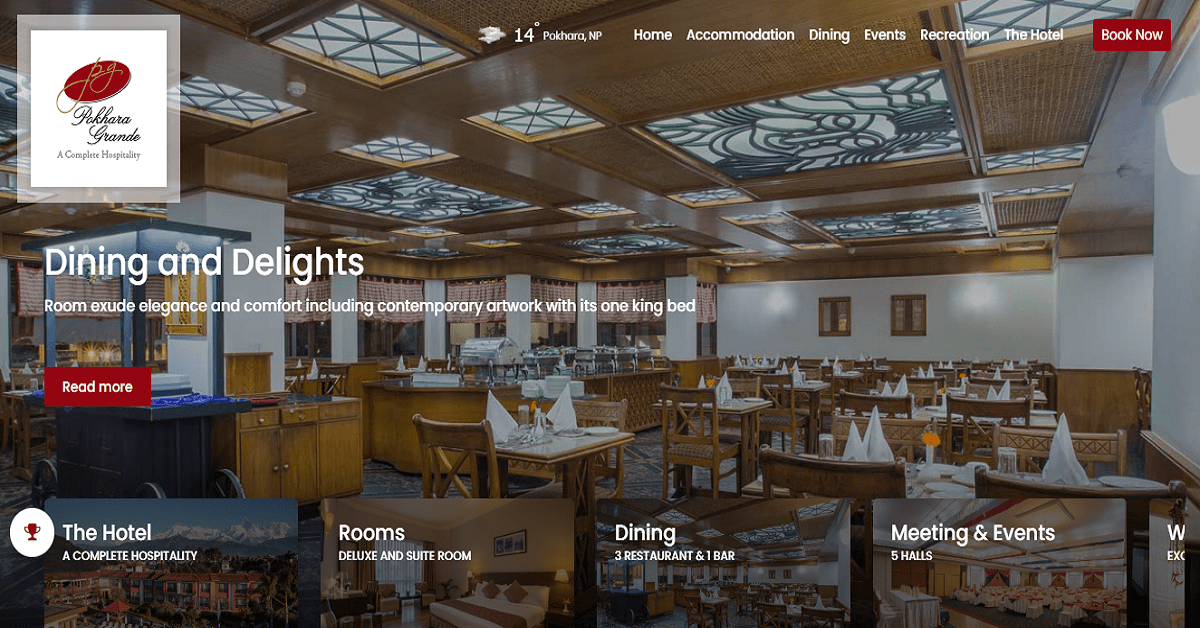
Discover the epitome of luxury at Pokhara Grande, a distinguished five-star hotel that seamlessly blends service, comfort, and efficiency. Recognized internationally for excellence, Pokhara Grande proudly stands among the top 10 hotels in Nepal.
Estimated Cost Per Night: Rs.9,000-11,000
The buildings of hotels seamlessly integrate into elegant style, making Pokhara Grande the ideal retreat for nature enthusiasts seeking style and authenticity in the panoramic city of Pokhara. Nestled at the crossroads of Pokhara, we offer easy access to attractions, restaurants, markets, and Phewa Lake, all while providing a serene escape from the city’s hustle and bustle.
Features of Hotel Pokhara Grande
- Travel Desk
- Free Parking
- Fitness Center
- Airport Shutter
- Shopping Arcade
- Free Luggage Storage
Contact Details
- Contact: 061-450211
- Map: Get Direction
- Website: Hotel Pokhara Grande
- Location: Birauta Chowk, Pardi Pokhara
Temple Tree Resort & Spa
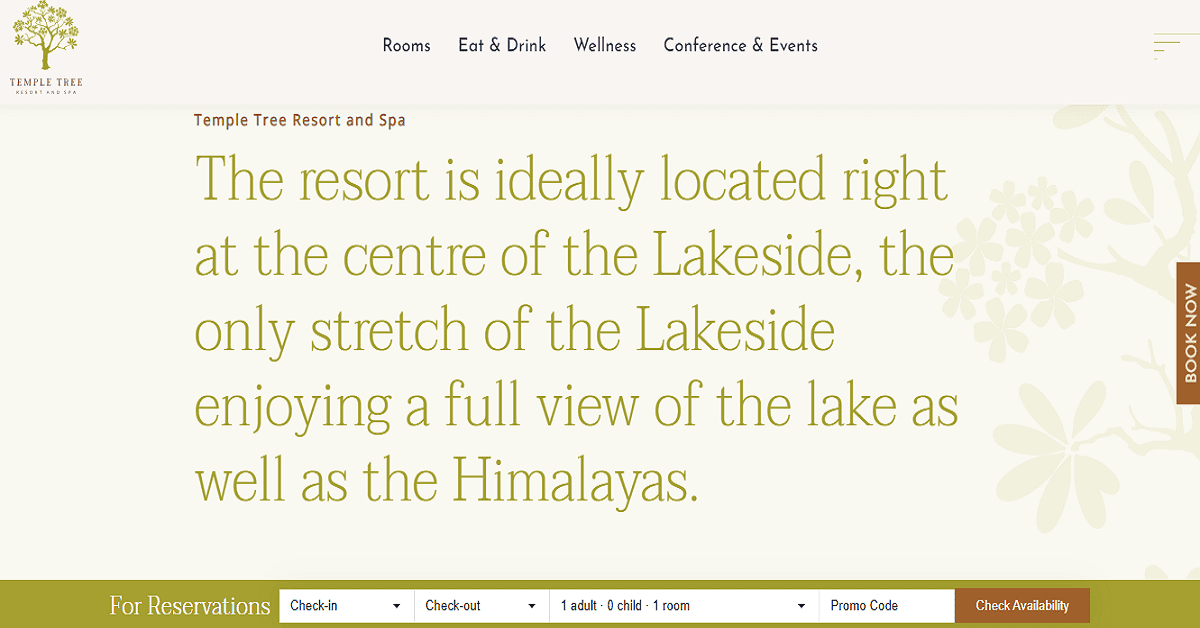
Temple Tree Resort & Spa, a boutique hotel in the heart of Pokhara Valley, seamlessly blends Western standards with the distinctive architecture and culture of Nepal’s Western Himalayas.
Estimated Cost Per Night: Rs.23,000-25,000
Nestled by Fewa Lake and framed by the Annapurna Mountain Range, Temple Tree offers pure, clean air in a warm and pleasant sub-tropical climate. Ideally located at the center of Lakeside in Gaurighat, enjoy a full view of the lake and the Himalayas.
Features of Temple Tree Resort & Spa
- Bar
- Spa
- Wi-Fi
- Sauna
- Lake View
- Swimming Pool
Contact Details
- Contact: 061-455819
- Map: Get Direction
- Website: Temple Tree Resort & Spa
- Location: 6th Street, Gauri Ghat, Lakeside, Pokhara
Hotel Barahi
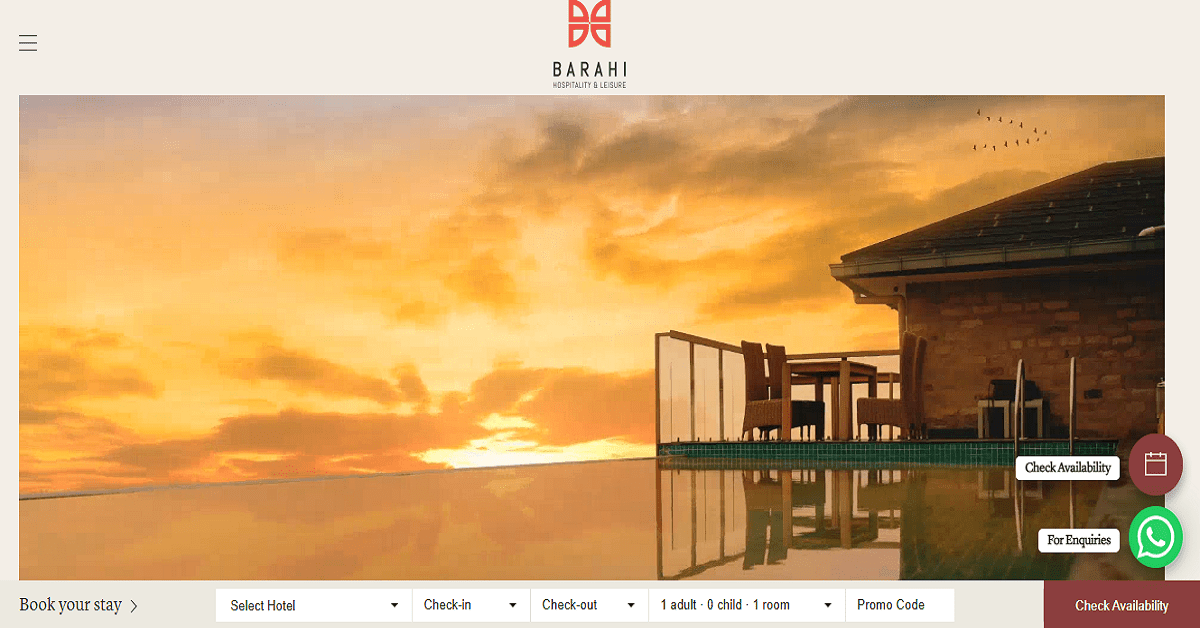
Established in 1993 in Lakeside, Pokhara, Hotel Barahi draws inspiration from the island temple of Barahi in Phewa Lake. Over three decades, it has become synonymous with the finest Nepali hospitality, quality service, and opulent luxury.
Estimated Cost Per Night: Rs.17,000-19,000
As the crown jewel of Barahi Hospitality & Leisure, this establishment embodies the highest standards of comfort and luxury. Proudly expanding its network to major tourist destinations across Nepal, Barahi promises an unwavering commitment to excellence.
Features of Hotel Barahi
- Bar
- Travel Desk
- Sight-seeing
- Beauty Parlor
- Courtyard Cafe
- Exclusive Packages
Contact Details
- Contact: 061-450617
- Map: Get Direction
- Website: Hotel Barahi
- Location: Lakeside Rd 6, Pokhara, Nepal
Fish Tail Lodge by Annapurna
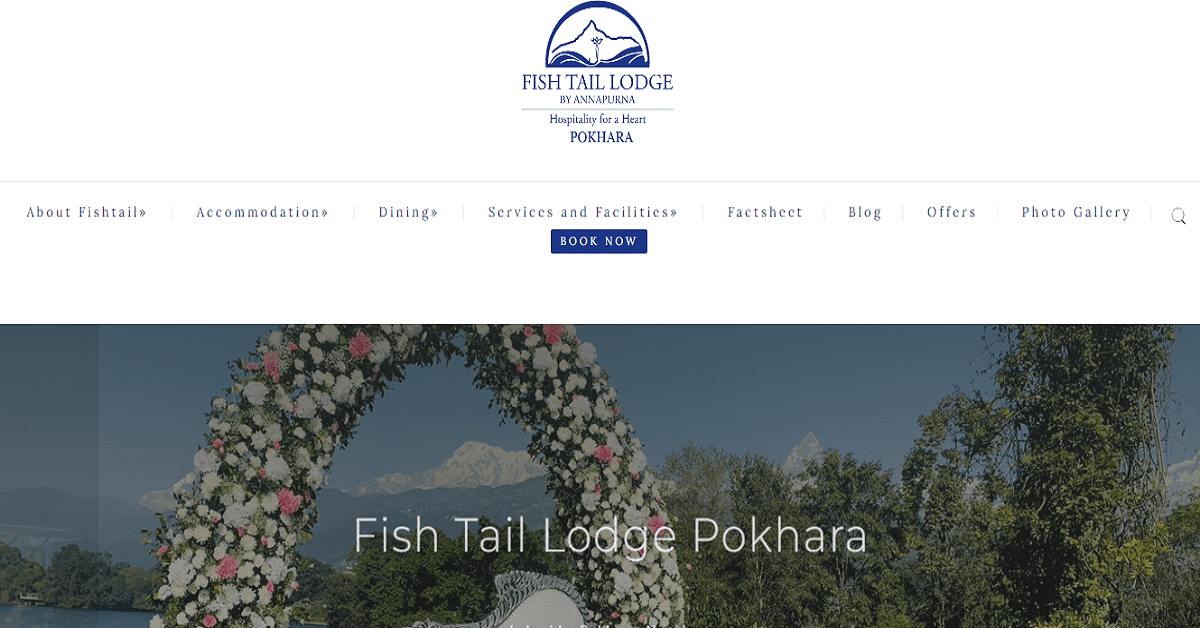
Fish Tail Lodge occupies a unique location on a peninsula across Fewa Lake, offering spectacular views of the Annapurna range and Mount “Machhapuchre” (Fish Tail). Committed to the Jayanti Memorial Trust, the profits of the hotel support the prevention of cardiac disease and accessible cardiac care in Nepal.
Estimated Cost Per Night: Rs.19,000-25,000
Ideally situated in the heart of Pokhara Valley, Fish Tail Lodge provides air-conditioned rooms, spa treatments, and a variety of cuisines. Enjoy tranquility, and breathtaking views, and contribute to a noble cause during your stay.
Features of Fish Tail Lodge by Annapurna
- Spa
- Sauna
- Travel Desk
- Fitness Center
- 24-hour Security
- EV Charging Station
Contact Details
- Contact: 061-455071
- Map: Get Direction
- Website: Fish Tail Lodge by Annapurna
- Location: Lakeside, Pokhara, Nepal
Bar Peepal Resort
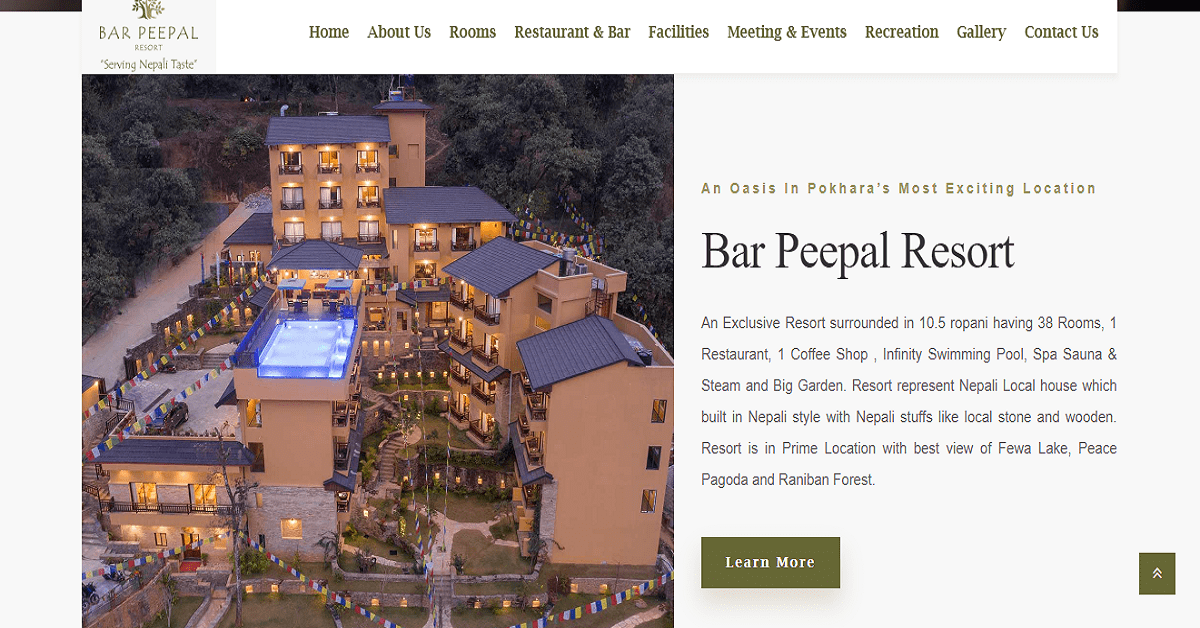
Bar Peepal Resort seamlessly combines sophistication with accessibility, offering a refined home away from home. Situated near city attractions, the resort features a multicuisine restaurant bar, rooftop swimming pool, spa, and sauna.
Estimated Cost Per Night: Rs.11,000-15,000
The guest rooms showcase typical Nepali texture and provide panoramic views of Fewa Lake and Raniban Hill. With open spaces, gardens, and ample parking, Bar Peepal Resort invites you to relax and enjoy the essence of typical Nepali living.
Features of Bar Peepal Resort
- Spa
- Yoga
- Doctor of Call
- Luggage Storage
- Rooftop Swimming pool
- Express Check-In/Check -Out
Contact Details
- Contact: 061-590193
- Map: Get Direction
- Website: Bar Peepal Resort
- Location: Mani Marg Street no. 28, Lakeside Rd, Pokhara
Le Glamour Luxury Resort

Le Glamour Luxury Resort & Wellness Spa stands as a hidden gem in Pokhara’s tranquil valleys, promising an exquisite experience with luxury suites, private villas, and warm Nepalese hospitality. Run by trust, Le Glamour is committed to matching customer expectations with happiness, comfort, and trust.
Estimated Cost Per Night: Rs.50,000
With stunning 360-degree views of mountains, lakes, and the city, Le Glamour offers not only luxurious accommodation but also culinary delights, vacation trips, romantic suites, wedding venues, business facilities, and an array of memorable services.
Features of Le Glamour Luxury Resort
- Free Bar
- BBQ Party
- City Guide
- Luxury Room
- Private Theatre
- Welcome Drinks
Contact Details
- Contact: 061-620732
- Map: Get Direction
- Website: Le Glamour Luxury Resort
- Location: Methlang, Sarangkot – 18, Pokhara
Final Say
Thank you for joining us on this journey into the details of 5-star hotels in Pokhara and uncovering the captivating beauty of Pokhara Valley. We trust that the insights and details of a 5-star hotel in Pokhara have provided you with the knowledge to make informed choices for your stay. As you plan your visit, may the allure of Pokhara’s landscapes and the luxurious experiences within these establishments create lasting memories. Safe travels, and may your vacation be filled with relaxation, adventure, and unmatched hospitality in 5-star hotels in Pokhara.
FAQ’s
Do 5-star hotels in Pokhara offer transportation services for guests?
Many 5-star hotels in Pokhara provide transportation services for guests, including airport transfers, shuttle services to popular attractions, and chauffeur-driven cars for sightseeing or business purposes. Guests can inquire about these services during the booking process or upon arrival at the hotel. Additionally, some hotels may offer car rental services or assistance with arranging local transportation options.
What amenities can I expect at a 5-star hotel in Pokhara?
5-star hotels in Pokhara offer a wide range of luxurious amenities, including but not limited to spacious and elegantly decorated rooms, top-notch dining options, fitness centers, spa facilities, swimming pools, concierge services, and complimentary Wi-Fi. Some may also feature business centers, meeting rooms, and recreational activities.
Are there any family-friendly 5-star hotels in Pokhara?
Yes, many 5-star hotels in Pokhara cater to families, offering amenities such as family suites or interconnected rooms, children’s play areas, kid-friendly dining options, babysitting services, and recreational activities suitable for all ages. Make sure to inquire about these amenities when making your reservation.
What dining options are available at the featured 5-star hotels in Pokhara?
The dining options at 5-star hotels in Pokhara are often diverse and exceptional, ranging from fine dining restaurants serving international cuisine to casual cafes and bars offering local delicacies and refreshing beverages. Many hotels also provide room service for guests who prefer to dine in the comfort of their rooms.
How can I ensure a seamless booking experience for a 5-star hotel in Pokhara?
To ensure a smooth booking experience, it is recommended to book your stay directly through the hotel’s official website or contact their reservations team via phone or email. This allows you to clarify any queries regarding room types, rates, special packages, and any specific requirements you may have. Additionally, consider booking in advance, especially during peak tourist seasons, to secure your preferred dates and accommodations.
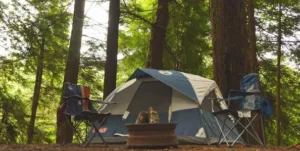
Best Campsites in Pokhara: Camping in Pokhara
Camping in Pokhara is more than just an escape into nature, it is an adventure to explore the region rich in natural beauty, surrounded by serene lakes and captivating landscapes. Nestled in the lap of the Annapurna range, Pokhara stands as a testament to the pristine allure of the Himalayan foothills.
Lakes in Pokhara such as Phewa and Begnas promise a camping experience that goes beyond the ordinary. The serene lakes, with their gentle ripples, reflect the tranquility that defines the atmosphere, offering a peaceful retreat for campers looking to escape the hustle and bustle of city life. The natural canvas of Pokhara transforms the camping experience into a tranquil and rejuvenating escape.
Moreover, for those drawn to the trekking trails surrounding Pokhara, camping seamlessly blends into the adventure. As the gateway to numerous trekking trails, Pokhara invites tourists to navigate these paths while choosing camping as their accommodation. This is a unique opportunity to forge a deeper connection with the breathtaking landscapes of the Annapurna region.
Beyond the breathtaking scenery, Pokhara blends cultural richness and adventure, transforming a camping trip into a holistic experience. The city is a melting pot of diverse ethnicities, invites immersion in local culture, savoring Nepali cuisine, and engaging with warm-hearted locals eager to share their stories.
And as your anticipation builds for tales of camping in nature’s lap, imagine waking up to the symphony of birdsong, surrounded by mist-kissed peaks of the Annapurna range. Envision evenings around a crackling campfire, swapping stories under a star-studded sky.
This blog, Camping in the Lap of Nature: Best Campsites in Pokhara, promises a list of campsites, and various practical tips for a safe and comfortable camping experience in Pokhara. Explore and find solace in the heart of one of Nepal’s most captivating destinations.
Types of Campings
In the heart of Pokhara’s enchanting landscape lies a plethora of camping experiences. As you navigate through the diverse camping options, envision the possibilities that await. Whether you are drawn to the peaceful lakeside retreats, the adrenaline-fueled mountain camps, or the secluded charm of forest camping, each experience can fulfill different desires and expectations. Here are some camping possible in Pokhara:
- Tent Camping
For the traditionalist, tent camping offers a back-to-basics experience, where the rustle of fabric and the open sky become your only companions. Set up your temporary home and let the sounds of nature be your lullaby.
- Glamping
Indulge in the lap of luxury with glamping, and glamorous camping that combines the thrill of the outdoors with the comforts of home. Think cozy beds, ambient lighting, and gourmet meals, all beneath the stars.
- Lakeside Camping
For those seeking tranquility, lakeside camping along the shores of Phewa or Begnas Lake provides a serene retreat. Lakeside camping allows you to wake up to the gentle lapping of water and the sun casting its golden hues across the lake, creating a picturesque morning view.
- Mountain Camping
Daredevils and nature enthusiasts will find their haven in the mountain camps scattered around Pokhara. Nestled amidst the foothills of the Annapurna range, these camps promise breathtaking views and a rugged, adventurous terrain that beckons explorers to conquer the heights.
- Forest Camping
Immerse yourself in the embrace of nature with forest camping experiences. Surrounded by lush greenery and the vibrant sounds of wildlife, these camps offer a more secluded and immersive connection with the natural world.
As you explore the diverse facets of camping in Pokhara, each type beckons you to discover the region’s natural beauty on your terms.
Also, learn about Adventure Sports in Pokhara for 2024/2025
Highlights of Camping in Pokhara
This holistic journey of Camping in Pokhara is a celebration of natural wonders, cultural richness, and the thrill of adventure. As you pitch your tent in the lap of this Himalayan haven, prepare to be captivated by the highlights that make camping in Pokhara an experience like no other.
- Discover Flora and Fauna:
Venture into the camping grounds and a world of biodiversity unfolds before your eyes. From the vibrant and exotic birds to the charm of wildlife, these camping sites offer a front-row seat to nature’s spectacle. Spring, in particular, transforms the landscape into a canvas of colors, with rhododendrons and other flowers painting the surroundings in hues of brilliance.
- Mountain Views:
Nestled close to the Annapurna Mountain Range, Pokhara unfolds like a picturesque canvas where the majestic Himalayan peaks steal the spotlight. The breathtaking views of this iconic mountain range come alive, showcasing their grandeur, especially during the enchanting moments of sunrise and sunset. As the sun paints the sky with vibrant shades, mountains like Macchepuchre, Annapurna, and Dhaulagiri bathe in an ethereal glow, creating memories of a lifetime.
- Adventure Opportunities:
Beyond the confines of the campsite, Pokhara opens doors to thrilling adventures. Many camping destinations serve as starting or endpoints for trekking routes, offering adventurous souls to allow camping while trekking, creating an unforgettable fusion of nature and exploration.
- Peaceful Break:
In the heart of the tranquil ambiance, in the fresh mountain air and the soothing sounds of nature, campers find more than just a getaway, they discover a peaceful break from the stresses of daily life. The serene surroundings become a sanctuary, rejuvenating the mind and spirit.
- Community Interaction:
Engaging with local communities adds a unique layer of adventure to the camping experience. Campers have the opportunity to observe the lifestyles, traditions, and stories of the locals, fostering a connection that goes beyond the natural beauty of Pokhara.
Let the allure of Pokhara unfold as you explore the camping gems hidden within its breathtaking landscapes.
Best time to Camp in Pokhara
Selecting the best time for your camping escapade in Pokhara is crucial to ensure a delightful experience in the lap of nature.
- Ideal Camping Months:
Camping near Pokhara is possible throughout the year, but it is important to be wise about the timing. It is best to avoid the monsoon months, particularly June, July, and August. During these months, heavy rainfall can make camping in Pokhara a less enjoyable experience.
Likewise, the chilly weather of December to February may not be ideal for an overnight camping experience. As temperatures drop during these cold months, it is advisable to postpone your camping plans for a more comfortable experience.
- Perfect Weather Conditions:
From March to May and September to November, Pokhara unveils its ideal weather conditions for camping. Days bask in the warmth of the sun, creating an inviting atmosphere for outdoor activities, while the nights offer a refreshing chill, perfect for cozying up in your camping gear.
To make the most of your camping in Pokhara, meticulous planning is key. Gather information about your chosen camping ground in advance, ensuring it aligns with your preferences and desired camping experience. Additionally, checking the weather forecast can be a good idea. Armed with this knowledge, you can embark on your camping journey fully prepared, maximizing the joy of your time in Pokhara.
List of Campsite in Pokhara
- Dhampus Village:
Situated atop a hill at 1,650 meters, Dhampus Village offers a serene environment just 25 kilometers from Pokhara. The majority Gurung population provides insights into their culture and way of life. Dhampus is an ideal destination for a relaxed camping trip during the hot summer months.
- Australian Camp:
Perched at 2,060 meters, Australian Base Camp provides a breathtaking sunrise over the Annapurna range. Camping accommodation is available in hotels, or you can bring your gear. Campfires are popular here and can enhance the experience on this mountaintop.
- Begnas Lake:
Found in the southeast corner of the Pokhara Valley, Begnas Lake is approximately 16 kilometers from the city’s hustle and bustle. Resorts, lodges, and homestays line the lake, with Majhikuna being a favored spot for night camping. Birdwatching, fishing, and boating activities enrich the lakeside camping experience.
- Rupakot Village:
Approximately 20 kilometers from Pokhara, Rupakot Village offers hiking, sunrise and sunset views, and mountain hiking. Embracing ecotourism, agrotourism, and sustainable tourism, the village provides local organic cuisine. An ideal spot for meditation and yoga amidst nature.
- Nirmal Pokhari Village:
Located 10 kilometers south of Pokhara, Nirmal Pokhari village is renowned for its orange production. Perfect for camping with picturesque views and opportunities for hiking. A great option for those wanting a taste of Nepal’s everyday farming and community life.
- Kaskikot:
Nestled in the hills surrounding Pokhara, Kaskikot offers a tranquil escape with panoramic views of the Annapurna range and Phewa Lake. Kaskikot is also known for cultural richness, traditional Newari architecture, and warm hospitality. This destination is ideal for camping with a touch of cultural and historic immersion.
- Sikles Village:
A Gurung village near Pokhara, Sikles offers rural tourism and a typical cultural experience. The second-largest Gurung settlement in Nepal, the village is reachable by bus, private vehicle, or trek. Sikles is favored for overnight stays in the Annapurna Region, offering magnificent views and the option for homestays and fire camps.
- Nau Danda:
Approximately 20 kilometers from Pokhara, Nau Danda provides a 360-degree vista of the Pokhara valley. Accessible by bus or trek via Sarangkot, it is a spot for witnessing sunrise, sunset, landscapes, cityscapes, and mountains all in one location. Local lodges offer a night’s stay with fire camps and local dishes.
- Lakeside:
Several hotels near Lakeside provide camping options, eliminating the need to carry camping gear. Enjoy a night by the lakeside without the hassle, spending quality time with loved ones amidst the peaceful surroundings.
Each campsite in Pokhara offers a unique experience, from lakeside tranquility to mountaintop panoramas, providing a diverse range of options for campers seeking different atmospheres and activities.
What Camping Equipment and Gear do you need?
Embarking on a camping expedition in Pokhara necessitates a careful selection of gear to ensure a seamless and enjoyable camping experience. Here is a comprehensive list of camping equipment and gear tailored for the diverse environments you might encounter in Pokhara.
Sleeping Equipment:
– Tent
– Sleeping Bag
– Sleeping Mat
– Pillow
Living Gears:
– Camp Chairs
– Hammock
– Towel
– Toiletries: Pack travel-sized toiletries, including toothpaste, toothbrush, and biodegradable soap.
Cooking Kits:
– Camping Stove
– Fue
– Lighter
– Cookware, Dishes, and Cutlery
– Camp Sink
– Water
– Thermos
– Snacks and Meals
Survival Kits:
– Knife
– Headlamps and Lanterns
– Sun and Bug Protection
– Sanitizer
– First Aid Kit
This comprehensive gear list ensures that you are well-equipped for the diverse camping environments awaiting you in Pokhara. Each piece serves as a building block for a memorable and comfortable camping experience among the beauty of the Himalayan foothills.
What to wear during Camping in Pokhara Valley?
Selecting the right clothing is a crucial aspect of ensuring comfortable and enjoyable camping in Pokhara Valley. The diverse weather conditions and elevation changes demand a thoughtful approach to your wardrobe. Whether you are camping by the lakeside or venturing into the mountains, here is our guide on what to wear during your camping odyssey.
Footwear:
Comfortable Waterproof Hiking Boots
Clothing Layers:
Your clothing layers should include:
– Base Layer: Moisture-wicking fabric to keep your skin dry.
– Mid-Layer: Insulating layer like a fleece or down jacket to trap body heat.
– Outer Layer: Waterproof and windproof jacket to shield against rain or chilly winds.
Headwear:
– A brimmed hat
– Bandana
Upper Body:
– Camping Shirt
– Fleece or Insulating Jacket
– Rain Jacket
Lower Body:
– Hiking Pants
– Waterproof Bottoms
Accessories:
– Sunglasses
– Hat and Gloves
– Fluffy Socks
Versatile Clothing:
– Plaid Flannels
– Tank Tops
– Windbreaker
Remember that temperatures can vary significantly between day and night, so by having layers you can easily add or remove the garments in the changing weather conditions. By packing a well-thought-out selection of clothing, you will be prepared to fully enjoy the Camping in Pokhara.
Tips During Camping in Pokhara Valley
Camping in Pokhara Valley is not just about setting up a tent, it is about immersing yourself in nature responsibly. To ensure a successful and harmonious camping trip, consider these practical tips:
Respect for Local Flora and Fauna:
- Stay on Designated Trails: Stick to established trails to minimize your impact on the local ecosystem.
- Avoid Disturbing Wildlife: Observe from a distance and refrain from disturbing the local fauna. Keep noise levels low to maintain the tranquility of the surroundings.
- Leave No Trace: Stick to the Leave No Trace principles pack out all waste, minimize campfire impact, and leave natural and cultural features undisturbed.
Safety Measures:
- Before setting out, inform your friends or family about your camping plans, including your destination and expected return time.
- Ensure you have a first aid kit, sufficient water, and emergency supplies in case of unforeseen circumstances.
- Stay informed about the weather conditions in the region, especially in the mountains, where weather can change rapidly.
Wildlife Interactions:
- Enjoy wildlife from a distance. Do not approach or feed wild animals, as it disrupts their natural behaviors.
- Keep food stored securely to avoid attracting wildlife to your campsite.
- Camp in designated areas to reduce the impact on wildlife habitats.
By integrating these tips into your camping routine, you not only ensure your safety but also contribute to the preservation of the natural beauty of Pokhara Valley.
Conclusion
In conclusion, camping in Pokhara unfolds a tapestry of unique experiences, blending breathtaking natural beauty with cultural richness. From serene lakeside retreats to panoramic mountain views, each campsite offers a distinct adventure. The tranquil ambiance and warm hospitality add a special charm, creating memories that linger long after the campfire embers fade.
Thank you for joining us on this journey through Camping in Pokhara. May your future adventures be as enchanting as the moments you discover in the lap of nature. Happy camping!
FAQ’s
- Is camping in Pokhara suitable for all seasons?
While camping is possible year-round, it is advisable to avoid monsoon months (June to August) due to heavy rainfall. And, December to February can be chilly. The rest of the months offer ideal weather conditions for camping.
- Are there facilities for renting camping gear in Pokhara?
Yes, the Lakeside area has several rental shops where you can find camping equipment, including tents, sleeping bags, and other essential gear.
- Can I camp near Pokhara’s trekking trails?
Yes, Pokhara serves as a gateway to various trekking trails, and camping can be added to your trekking adventure.
- What clothing should I pack for camping in Pokhara?
Pack layers for varying temperatures, including a waterproof jacket. Sturdy hiking boots, comfortable clothing, and a hat are advisable. Finally, don’t forget to check the weather forecast for your chosen camping dates.
- Are there family-friendly campsites in Pokhara?
Yes, Pokhara offers family-friendly campsites with facilities suitable for children. Lakeside areas and Australian Base Camp provide a tranquil environment for families to enjoy nature together.
- Can I engage in water activities near Pokhara’s campsites?
Certainly! Campsites near lakes, such as Phewa and Begnas, often offer opportunities for boating, fishing, and other water activities. Be sure to check with the specific campsite for available amenities.
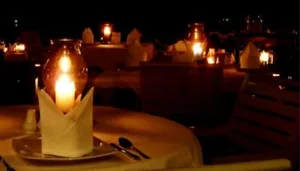
10 Restaurants for a Romantic Dinner in Pokhara: Location & Price
Situated in the heart of Nepal, Pokhara holds the title of the ultimate tourist hub, offering a wide array of adventures and activities for its visitors. Among the many experiences it provides one standout gem is the romantic and luxurious dining scene.
In addition to the excitement of adventure, Pokhara offers the best romantic restaurants, inviting couples to discover captivating settings. Whether you are looking for the peaceful intimacy of a cozy spot or the charm of a luxurious fine dining experience, Pokhara has options for every romantic desire. As the sun sets, Pokhara reveals its more gentle side, creating the perfect setting for an enchanting dinner with your loved one.
This blog is a detailed collection intended to guide you through the delightful experience of a restaurant for a romantic dinner in Pokhara. It reflects our dedication to making sure your evening with your partner is truly special. So, let the soothing breeze of Pokhara and the assurance of an unforgettable dining experience accompany you as we explore the most romantic restaurants this city has to offer.
Restaurant for Romantic Dinner in Pokhara
From a restaurant for a romantic dinner in Pokhara to dinner with an exquisite view of the Fewa Lake and surrounding landscapes, there are many nice establishments. Here we have compiled a list of 10 of them.
Utopia Garden & Snacks Bar
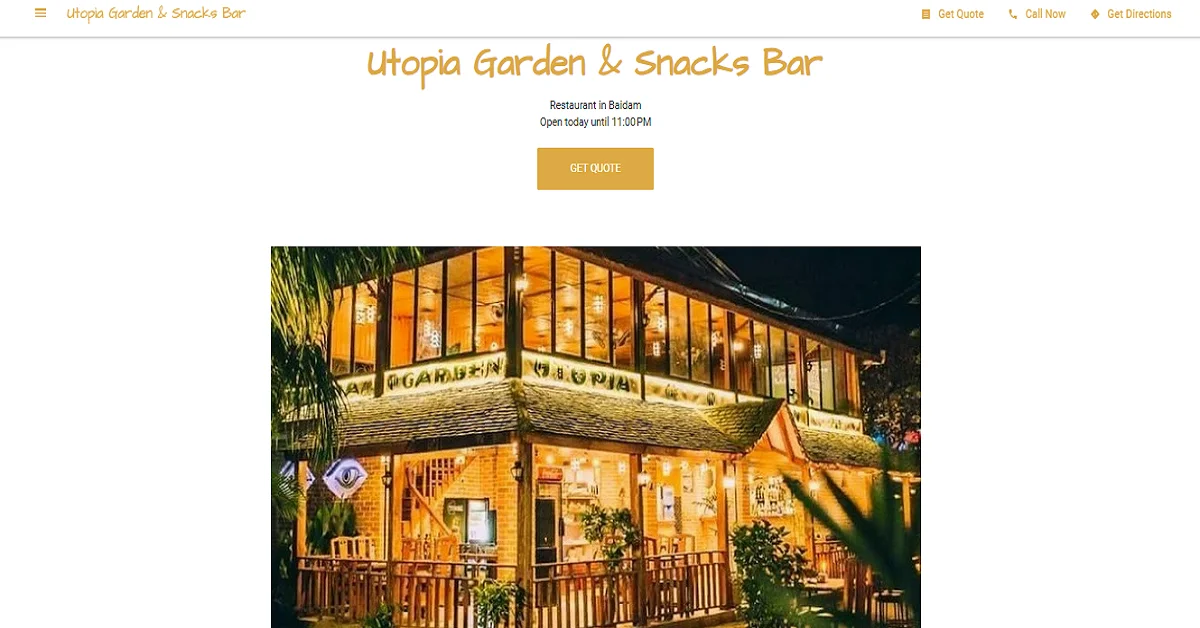
- Location: Baidam, Pokhara
- Contact: 984-6114408
- Specialty: Indian Cuisine
- Map: Get direction
- Website: Utopia Garden & Snacks Bar
- Estimated price for dinner for two: Rs 1,500-2,500
Tucked away near the lake, Utopia Garden & Snacks Bar offers a quiet and perfect setting for a romantic dinner. With lush gardens and friendly service, the restaurant provides a delightful experience.
The diverse menu, featuring items like tandoori chicken and chicken thali, promises pure and flavorful delights. The warm atmosphere and the owner’s hospitality make Utopia a haven for those seeking great food and a relaxing ambiance.
El Bocaito Español
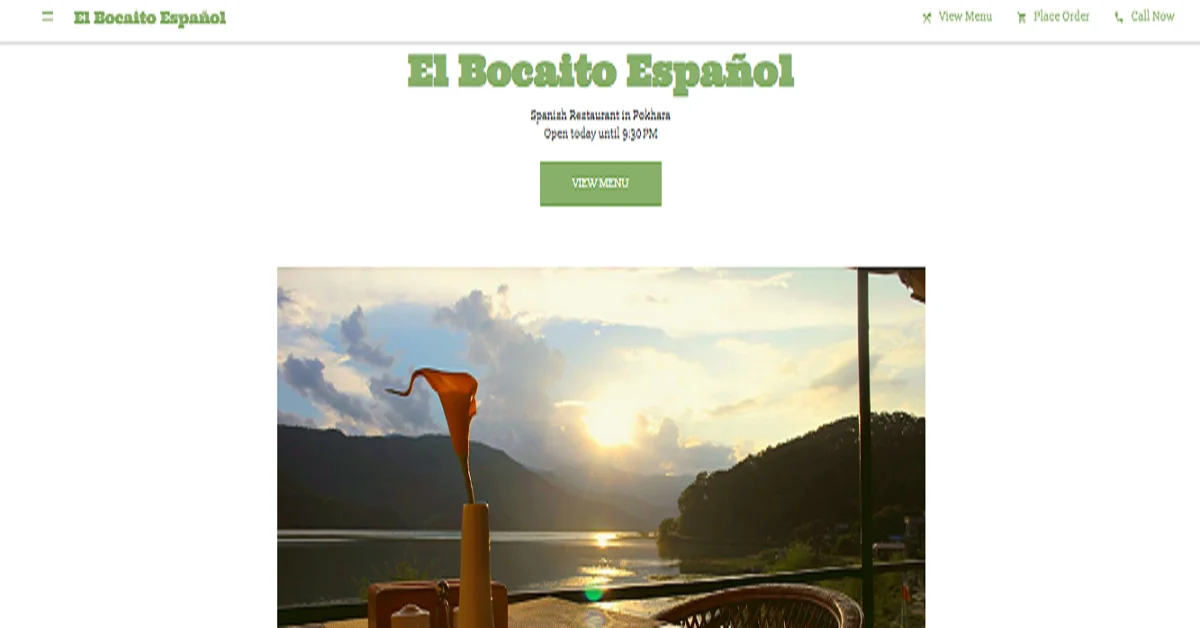
- Location: Kahare 6, Pokhara
- Contact: 982-5167216
- Specialty: Spanish Cuisine
- Map: Get direction
- Website: El Bocaito Español
- Estimated price for dinner for two: Rs 2,500–3,000
Immerse yourself in the romance of Spanish cuisine at El Bocaito Español. Each bite bursts with flavor, prepared with love and the freshest ingredients. Set against a little terrace next to the lake, the restaurant offers a beautiful view, creating a serene and relaxing atmosphere.
With its strategic location, superb views, and a menu ranging from light to heavy meals, El Bocaito Español provides a perfect setting for a romantic dinner in Pokhara.
Byanjan Restaurant
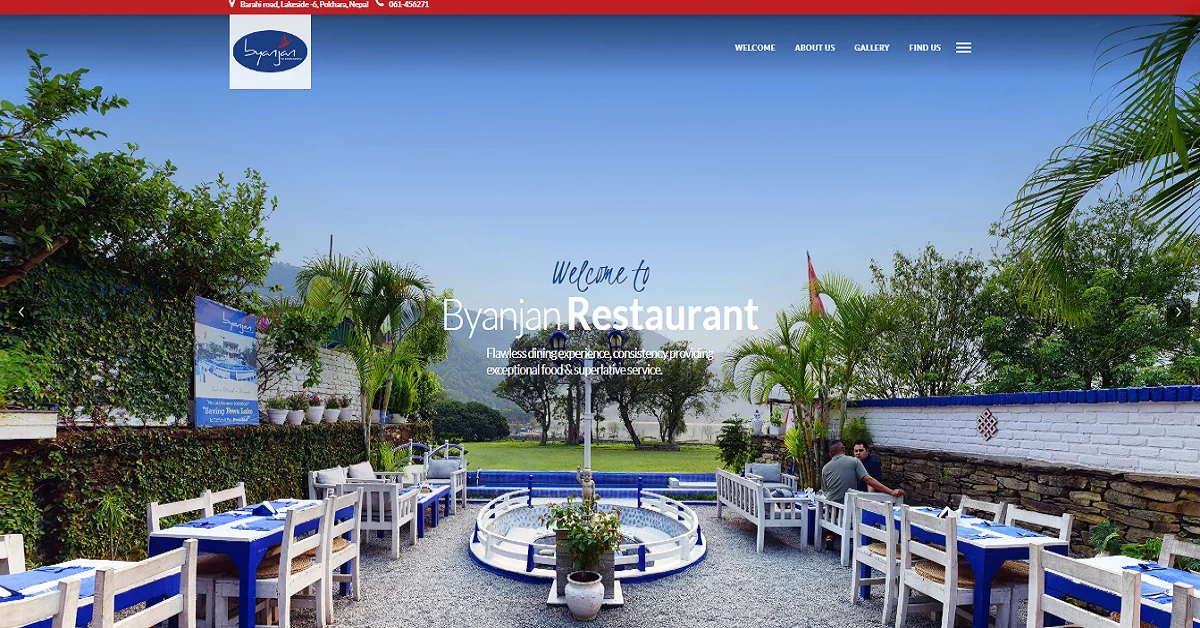
- Location: Barahi Road, Lakeside -6, Pokhara
- Contact: 061-456271
- Specialty: Authentic Nepali Cuisine
- Map: Get direction
- Website: Byanjan Restaurant
- Estimated price for dinner for two: Rs 3,000-3,500
Byanjan offers an authentic range of multi-cuisine delights for your romantic dinner. The dedicated team provides flawless service, ensuring exceptional food, elegant decor, and a warm, and welcoming atmosphere.
The traditional theme enhances the ambiance, blending intimacy with cultural richness. Beyond the excellent taste of the food, Byanjan creates a magical setting, complemented by a spectacular view of Fewa Lake.
Roadhouse Cafe Pokhara
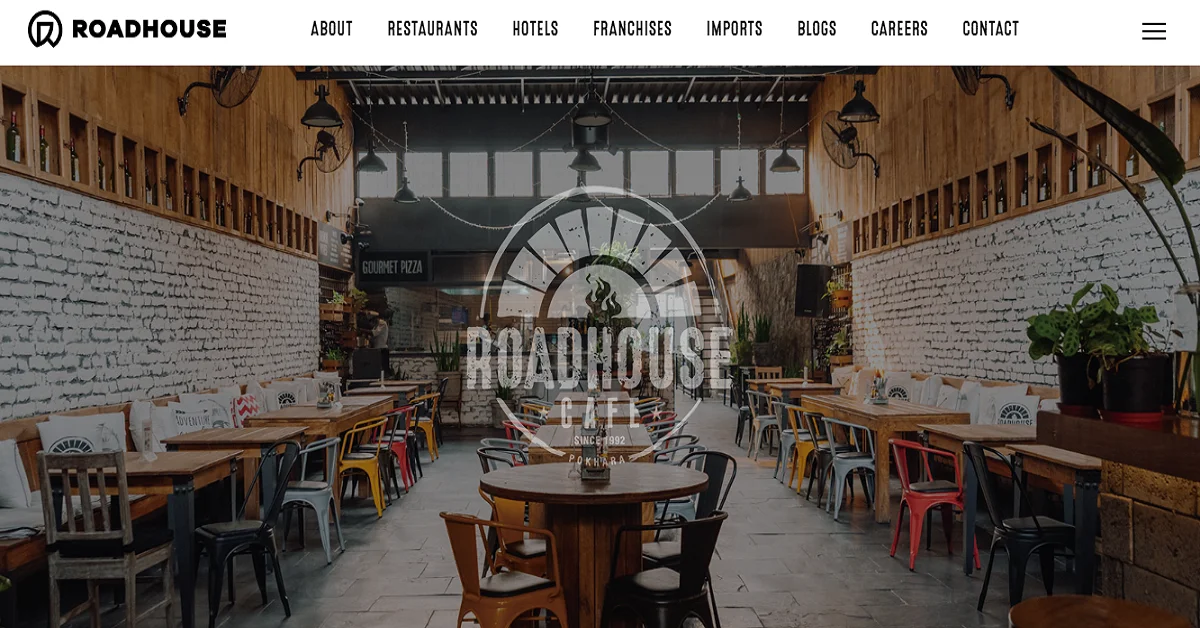
- Location: Lakeside Pokhara
- Contact: 061-457421
- Specialty: Pizza & Pasta
- Map: Get direction
- Website: Roadhouse Cafe
- Estimated price for dinner for two: Rs 2,500–3,000
Upon entering Roadhouse Cafe Pokhara, you enter a realm of style and warmth. The smiling staff, stylish bar, and premiumly designed seating areas contribute to an atmosphere perfect for a romantic dinner in Pokhara. The extensive menu, featuring acclaimed dishes like fish and chips and delightful pizzas, caters to diverse tastes.
The great ambiance, coupled with warm lighting, ensures a memorable dining experience making Roadhouse a go-to choice for a romantic evening in Pokhara.
Med5 Restaurant
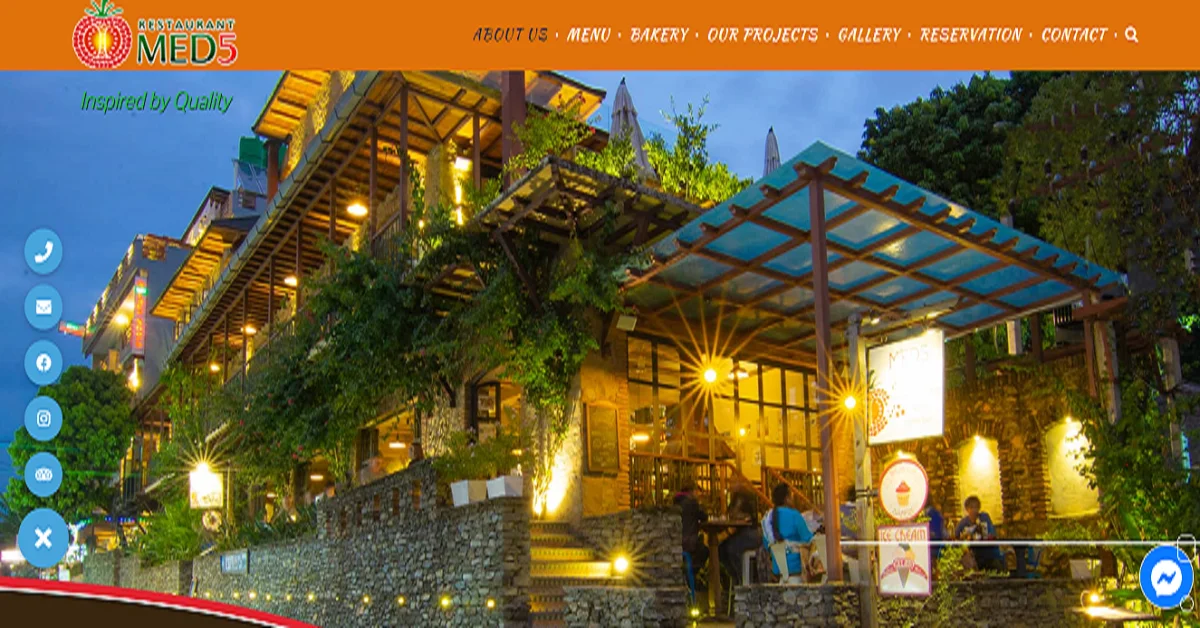
- Location: Lakeside-6, Pokhara
- Contact: 061-457796
- Specialty: Mediterranean Cuisine
- Map: Get direction
- Website: Med5 Restaurant
- Estimated price for dinner for two: Rs 2,500–3,000
Situated by Lake Phewa, Med5 Restaurant is a modern cafe and restaurant offering a complete dining experience. Focused on quality and offering a diverse menu for Nepali and international tastes, the restaurant’s commitment to improvement and sustainability, along with its hardworking and dedicated staff, ensures a memorable and delightful dinner experience by the lake in Pokhara.
The Pavilions Himalayas The Farm
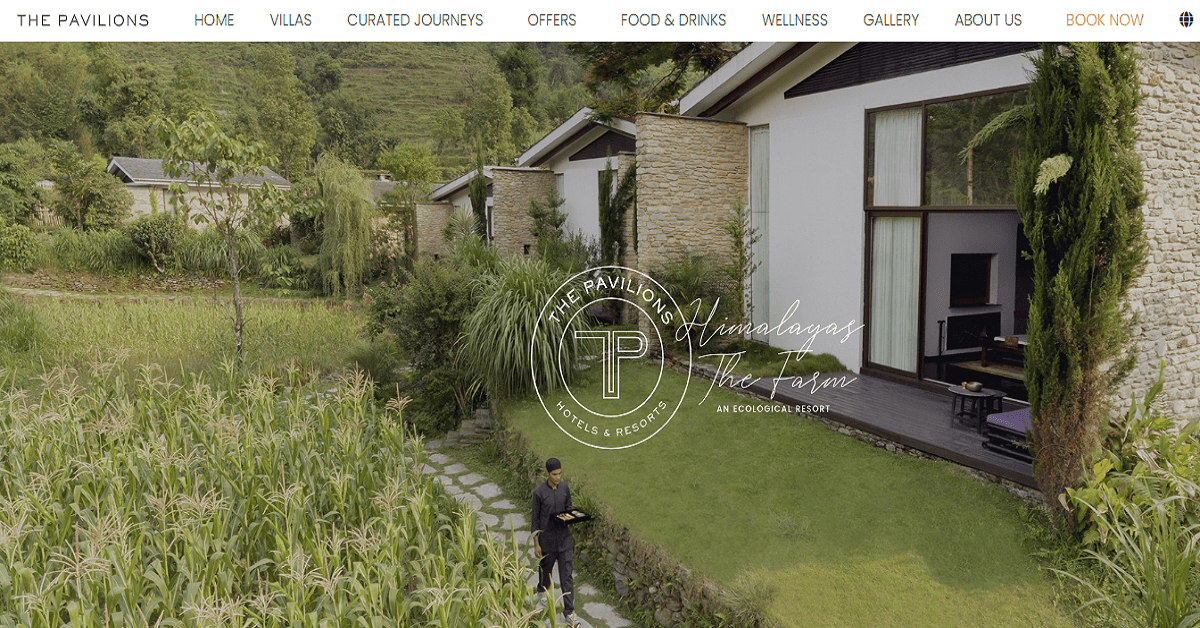
- Location: Ward No. 22, Chisapani, Pokhara
- Contact: 985-6027997
- Specialty: Organic vegetables, eggs and dairy
- Map: Get direction
- Website: The Pavilions Himalayas
- Estimated price for dinner for two: 6,000
The Pavilions Himalayas The Farm promises a dining experience nothing short of exquisite. Nestled in a beautiful property with sustainable practices, this restaurant offers a marvelous view of the valley landscape.
The luxurious dinner, though expensive, is justified by the heavenly pleasure it provides. With organic ingredients sourced from the on-site farm, the food is not just a meal but a journey into the serene hills of the Himalayas.
Also Read: 4 Star Hotels in Pokhara: Where Comfort Meets Serenity
Moondance Restaurant and Bar
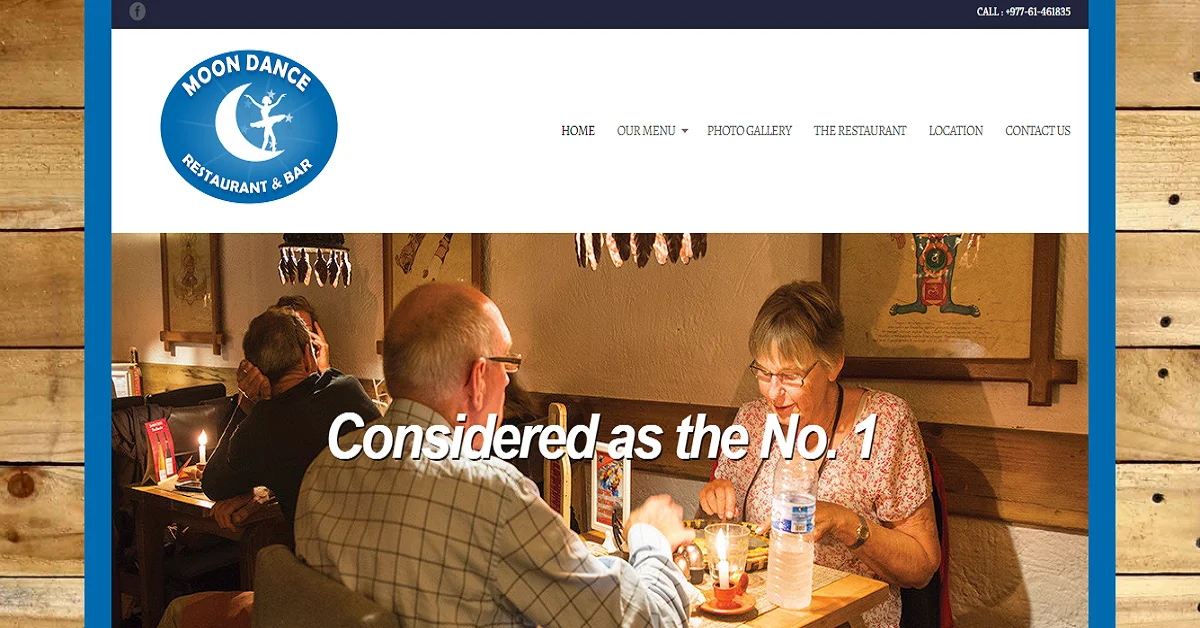
- Location: Lakeside Rd, Pokhara
- Contact: 061-451835
- Specialty: Great Vegetarian Option
- Map: Get direction
- Website: Moondance Restaurant and Bar
- Estimated price for dinner for two: Rs 2,000–2,500
Moondance Restaurant and Bar, a labor of love for the Lama (Tamang) Family, combines great food with continuous improvement. With a commitment to fresh, locally sourced ingredients, this restaurant provides a unique dining experience.
The spacious and airy ambiance, coupled with a variety of seating options, creates an ideal setting for a romantic dinner. Moondance is not just a business, it is a family extending an invitation to savor real food with real taste.
OR2K Pokhara

- Location: Baidam Road, Hallanchowk, Pokhara
- Contact: 061-467114
- Specialty: Vegan Food
- Map: Get direction
- Website: OR2K Pokhara
- Estimated price for dinner for two: Rs 2,000-3,000
OR2K Pokhara stands out for its healthy and diverse menu, offering Mediterranean and Israeli cuisine. With a splendid view of the lake, the restaurant provides a first-class dining experience.
The spacious and airy interior, coupled with candlelight and good music, creates a magical feeling for a romantic dinner in Pokhara. From the fantastic food to the delightful atmosphere, OR2K offers an unforgettable dining experience.
Soul Origin Cafe and Restaurant

- Location: Lakeside, Pokhara
- Contact: 061-590680
- Specialty: Italian Cuisine
- Map: Get direction
- Website: Soul Origin Cafe and Restaurant
- Estimated price for dinner for two: Rs.2,000-2,500
Soul Origin Cafe and Restaurant is a haven for food lovers seeking a romantic dinner in Pokhara. The polite and efficient staff, stylish interior, and a menu offering both local and foreign delights contribute to the restaurant’s charm.
The lakeside view adds to the divine ambiance, making it a perfect spot for creating lasting memories with your partner. Outstanding food, a diverse menu, and top-notch hospitality make this restaurant a must-visit in Lakeside.
Lotus Corner Restaurant & Bar, Pokhara
- Location: Pokhara
- Contact: 981-6134047
- Specialty: Middle Eastern Cuisine
- Map: Get direction
- Website: Lotus Corner Restaurant & Bar
- Estimated price for dinner for two: Rs 1,500–2,000
A family-run establishment, Lotus Corner Restaurant & Bar offers a choice of Nepali, Indian, and Syrian cuisine. With a relaxing environment right by Lakeside, it is an excellent choice for a romantic dinner in Pokhara.
The diverse menu, featuring Turkish delights and Western favorites, coupled with a beautiful view and a nice atmosphere, makes it a perfect spot for a delightful evening in Pokhara with your loved one.
Tips to Make Your Dinner Romanic
Creating the perfect dinner goes beyond just choosing the right restaurant for a romantic dinner in Pokhara. To elevate your dining experience to a realm of enchantment, consider these practical yet heartfelt tips.
- Timing is Key
Selecting the right time to set the stage for a romantic evening is key. Opt for the golden hour when the sun bathes Pokhara in warm hues, enhancing the already magical atmosphere. The play of twilight and city lights will add a captivating touch to your dinner.
- Dress for the Occasion
Dressing appropriately adds an extra layer of charm to your romantic meeting. Choose attire that makes you feel confident and complements the ambiance of the chosen restaurant. Restaurants for romantic dinner in Pokhara often exude a cozy or upscale vibe, therefore, dress accordingly to enhance the experience.
- The Perfect Table
When booking, request a table with a lake view or in a secluded corner for a more intimate setting. The right table can transform your dinner, offering a backdrop of the serene surroundings of Pokhara or a private space where you can relish each other’s company.
- Thoughtful Gestures
Elevate the romantic vibe with thoughtful gestures. Consider ordering a special dessert to share, surprising your partner with a bouquet, or even writing a heartfelt note. These gestures add a personal touch that will be remembered long after the dinner is over.
- Be Present
In the age of distractions, being present is a gift. Put away phones and devices, and focus on each other. Engage in meaningful conversation, share stories, and connect more deeply. The ambiance of Pokhara with genuine connection will make your dinner truly special.
- Enjoy the Moment
Lastly, savor the moment. Let the beauty of Pokhara and the ambiance of the restaurant envelop you. Time slows down when you are immersed in a romantic setting, so take it all in, relish the flavors, and create memories that will linger in your heart.
Incorporating these tips will not only enhance your romantic dinner experience in Pokhara but will also create a night to remember for you and your partner.
How much does a romantic dinner date cost in Pokhara?
Calculating the expenses for a romantic dinner in Pokhara requires taking several factors into account. The city offers diverse dining establishments, ranging from upscale venues to more economical choices. Typically, a romantic date in Pokhara may incur costs ranging from 1,000 to 6,000 for two people. It is essential to remember that these prices can fluctuate based on the chosen restaurant, menu selections, and any additional services provided.
For those on a budget but desiring a romantic dining experience, Pokhara offers several affordable restaurants. These establishments not only deliver delightful culinary experiences but also provide a romantic atmosphere without putting a strain on your wallet. Whether you choose a cozy lakeside spot or a hidden gem, these economical options allow you to enjoy a romantic dinner without overspending. Whether your preference leans towards a more upscale dining experience or a wallet-friendly option, Pokhara boasts a diverse range of romantic dinner choices to cater to every taste and budget.
Final Say
In conclusion, Pokhara is a city that offers an unparalleled selection of romantic dining options for couples. From stunning lake views to exceptional cuisine, the best romantic restaurants in Pokhara make your special occasion an unforgettable experience.
We hope our blog has helped you find the best restaurant for a romantic dinner in Pokhara. Have a romantic time with your loved ones in Pokhara!
FAQ
- What should I wear for a romantic dinner in Pokhara with my partner?
For a romantic dinner in Pokhara, the dress code generally leans towards smart-casual attire. While the city embraces a relaxed atmosphere, opting for well-presented clothing can enhance the overall experience. Consider the ambiance of the chosen restaurant – some may have a more formal setting, while others offer a cozy lakeside vibe. Regardless, aim for an outfit that makes you feel confident and complements the chosen dining venue.
- What is the best restaurant for a romantic date in Pokhara?
Determining the “best” restaurant for a romantic date in Pokhara largely depends on personal preferences. Byanjan, Roadhouse Cafe Pokhara, and El Bocaito Español are among the establishments known for their romantic ambiance. However, the ideal choice varies based on factors like cuisine preference, atmosphere, and location.
- How can I make my candlelight dinner more romantic?
Elevating a candlelight dinner in Pokhara can be achieved through thoughtful gestures. Consider ordering a special dessert, arranging for flowers, or writing a note to your partner. Choosing the right time for your dinner, dressing appropriately, and selecting the perfect table also contribute to the romantic atmosphere. Engage in meaningful conversation, be present in the moment, and savor the enchanting surroundings of Pokhara. Additionally, some restaurants may offer special services like personalized menus or live music – inquire when making your reservation to add an extra touch of romance to your evening.
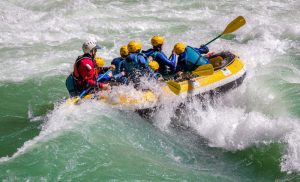
Adventure Sports in Pokhara for 2024/2025
Known as the gateway of Mt. Annapurna, Pokhara emerges as a jewel in the crown of Nepal adventure tourism. This enchanting city, blessed with serene lakes, verdant landscapes, and a rich cultural tapestry, attracts adventurers from around the globe. Pokhara is not just a destination, it is an immersive experience where natural grandeur and the thrill of adventure merge seamlessly. Therefore, Pokhara is a haven for those seeking adrenaline-pumping escapades among unparalleled natural beauty.
The adventure sports in Pokhara are as diverse as the landscape itself. From soaring through the skies on a paragliding to navigating the Seti River’s rapids, Pokhara offers an array of heart-pounding activities against a backdrop of natural splendor. This blog is your comprehensive guide to unlocking the thrill of adventure sports in Pokhara, providing insights into the various activities that allurs the daring and the curious souls.
Are you ready to embark on this exhilarating journey of adventure sports in Pokhara? Let’s dive into the blog and unravel the secrets of this Himalayan haven in Nepal.
Why is Pokhara Famous for Adventure Sports?
- Classic Trekking Routes
Pokhara stands as a testament to the allure of the Himalayas, drawing trekkers from every corner of the globe. The Annapurna Circuit, a classic among trekking routes, transforms Pokhara into a mecca for trekkers. The rugged trails wind through lush forests, quaint villages, and challenging mountain passes, offering an immersive journey that culminates in jaw-dropping views of the Annapurna and Dhaulagiri mountain ranges. Trekkers traverse landscapes that shift from terraced fields to alpine meadows, making every step a visual feast and every ascent a triumph against natural grandeur.
Some of the famous trekking trails that are easily accessible from Pokhara are:
- Mardi Himal Trek
- Australian Base Camp Trek
- Ghorepani Poonhill Trek
- Annapurna Base Camp Trek
- Kori Village Trek
- Panchase Trek
- Mohare Danda Trek
- Dhampus Trek
- Machhapuchhre Model Trek
- Rich in Natural Resources
The natural beauty of Pokhara is not confined to its mountains alone. The city is rich in serene lakes and rivers, making it an ideal playground for water enthusiasts. The beautiful Phewa Lake invites tourists to the boat and glides across its crystal-clear waters, while the Seti River challenges rafters with its exhilarating rapids. The lakes and rivers serve as the stage for unforgettable adventures for the adrenaline junkie.
- Cultural Heritage and Natural Wonders
Adding to Adventure Sports in Pokhara, the city is a tapestry woven with cultural heritage and natural wonders. Temples and pagodas dot the cityscape, offering a glimpse into the rich cultural history of Pokhara. Notable cultural experiences await at the Bindhyabasini Temple and the Old Bazaar, where the echoes of history resonate in every step.
- Tourist Hub
As the tourist city of Nepal, Pokhara has evolved into a well-equipped hub for adventure enthusiasts. The bustling Lakeside area is lined with adventure outfitters, cozy cafes, and vibrant markets catering to the diverse needs of tourists. The city’s status as a tourist hub ensures a seamless arrangement of services, from guided treks to equipment rentals, ensuring every adventurer meets their expectations.
- Sunrise and Sunset
Sunrise and sunset are equally infamous as the adventure sports in Pokhara. Whether from the viewpoint of Sarangkot, or Kaudada. The sun-kissed Annapurna range reflects shades of gold and pink, creating a breathtaking panorama that lasts into the memories of tourists forever.
List of Adventure Sports in Pokhara
-
Paragliding:
Best time for paragliding: March-May and September-November
Paragliding in Pokhara is a breathtaking experience where you gracefully take flight from the stunning Sarangkot. Soaring above the lush landscapes, you will witness the beauty of nature unfold beneath you. As you gently descend to the serene banks of Fewa Lake, the majestic Annapurna Range serves as a silent companion to your aerial escapade, painting the sky with natural hues.
Estimated cost: Rs.12,000-9,000 Per Person
The 15-20 minutes spent suspended in the air deliver not only an exhilarating rush but also an awe-inspiring visual spectacle, making paragliding an essential adventure sport in Pokhara.
-
Boating:
Best time for boating: All year round except monsoon
Known as the “City of Lakes,” Pokhara invites you to glide across the tranquil waters of Fewa Lake and Begnas Lake. Boating in Pokhara is more than any activity, as it provides a serene connection with nature.
Estimated cost: Rs.450-500 per hour
Choose from traditional rowboats or paddleboats, and let the shimmering reflections of the surrounding landscape create a setting for unforgettable memories. The gentle lap of the water against the boat becomes a rhythmic symphony, making boating a must-try experience.
-
Bungee:
Best time to Bungee: March-May, and September – November
For those who seek a heart-pounding leap into the unknown, Pokhara offers a thrilling bungee jumping experience. Nestled amidst the stunning landscapes of the city, the bungee site promises an adrenaline rush like no other. Feel the wind in your hair as you take the plunge from the 70-meter-high tower into the artificial pond.
Estimated cost: Rs. 7,000-10,000
While the panoramic views of the surrounding hills enhance the sensation of freefall. The location is carefully chosen to provide both the thrill of the jump and the scenic beauty that defines Pokhara.
-
Trekking:
Best time for trekking: March-May and September-November
Embark on a journey through the heart of the Himalayas with Pokhara’s classic trekking routes. The Annapurna Circuit calls tourists with its challenging trails and awe-inspiring views. Whether you are a seasoned trekker or a beginner, Pokhara’s trekking options cater to all. Explore terraced fields, small villages, and dense forests as you ascend to mountain passes.
-
Ultralight Flight:
Best time for ultralight flights: March-May and September-November
For the ultimate thrill-seekers, an ultralight flight over Pokhara’s scenic landscapes is a must. Revel in the feeling of freedom as you glide through the air, taking in panoramic views of the city, lakes, and surrounding mountains. The ultralight flight is not just an adventure, it is a symphony of wind, wings, and breathtaking mountain views that redefine your perception of the skies.
Estimated cost: Rs. 10,000-17,000 (15 min)
-
Kayaking:
Best time for kayaking: All year round except monsoon
Dive into the waters of Pokhara with kayaking adventures in pristine lakes and rivers. Whether you are a newbie or an experienced kayaker, Pokhara offers suitable water bodies for a paddling escapade.
Estimated cost: Rs, 600-800 per hour
Navigate the calm waters of Fewa Lake or embrace the challenge of the Seti River, experiencing the thrill of kayaking surrounded by the city’s natural beauty.
-
Annapurna Helicopter Tour:
Best time for Annapurna Helicopter Tour: September-November
For those seeking a unique perspective, the Annapurna Helicopter Tour offers a bird’s-eye view of the majestic Annapurna range. Soar above the Himalayas, witnessing their grandeur from a helicopter flight.
Estimated cost: $1,800 for 7 pax
This helicopter tour is a symphony of adventure and luxury, providing an experience that transcends the ordinary and leaves an indelible mark on your memory. The helicopter lands at Annapurna Base Camp and you get to enjoy the view of Annapurna Mountains and its surrounding mountains on this tour.
-
ZipFlyer:
Best time for ZipFlyer: March-May and September-November
Prepare for an exhilarating ride through the skies as the ZipFlyer unleashes its thrill upon you. Soar in the Sarangkot Hill and Hemja that promise an adrenaline rush like no other.
Estimated cost: Rs.6,000-8,000 per person
The ZipFlyer not only provides an adrenaline-pumping experience but also treats you to breathtaking views of the surrounding mountains and the Fewa Lake below. It is a fusion of speed and scenery, making it a must-try adventure in Pokhara.
-
Sightseeing:
Best time for sightseeing: All year round
Beyond the adrenaline-fueled adventures, Pokhara unfolds its cultural and natural wonders. Explore the Bindhyabasini Temple, the Old Bazaar, and the cultural richness that defines this Himalayan city. The sightseeing opportunities in Pokhara offer a balance between adventure and cultural exploration, ensuring your journey is as enriching as it is thrilling.
-
Canyoning
Best time for Canyoning: March – September
Lwang Ghalel, nestled near Pokhara, emerges as a hidden gem, offering a canyoning experience that seamlessly combines adrenaline and natural beauty. This village is a haven for adventure enthusiasts seeking a thrilling escapade under the untouched landscapes.
Estimated cost: Rs.8,000
The canyoning site in Lwang Ghalel features two majestic waterfalls, standing at heights of 45 and 75 meters respectively, promising an exhilarating descent into the heart of nature. At Lwang Ghalel Canyon, the adventure unfolds with rappelling down stunning waterfalls, navigating natural rockslides, and embracing daring leaps into refreshing natural pools.
-
Rafting
Best time for Rafting: September – November, and March – June
Embark on the Seti Rafting adventure to test your skills against the exhilarating rapids of the Seti River. This white water rafting experience promises a journey through thrilling stretches of water, delivering a perfect blend of excitement and serene moments as you navigate the twists and turns of the river.
Estimated cost: Rs. 7,000
Whether you are a beginner seeking an introduction to rafting or an experienced rafter looking for a dynamic challenge, the Seti Rafting experience caters to adventurers of all levels, ensuring an unforgettable and dynamic river expedition among other adventure sports in Pokhara.
Experience and Memory of a Lifetime
Adventure sports in Pokhara is an immersive journey that creates memories to last a lifetime. For the adventurer, this Himalayan haven offers the perfect holiday blend of heart-pounding excitement and serene landscapes. From paragliding over Lake Fewa to navigating Seti River’s rapids, each experience in Pokhara is a brushstroke in the masterpiece of your own adventure story.
The allure of Pokhara lies in its ability to seamlessly blend the thrill of adrenaline with moments of tranquil beauty. As the sun sets behind the majestic peaks, the memories forged here become more than just souvenirs, they become an integral part of your narrative. For those seeking not just a vacation but an unforgettable journey, Pokhara is the destination where every adventure makes the memory of a lifetime.
Conclusion
In the magnificent landscape of adventure sports in Pokhara, the valley is a kaleidoscope of exhilarating possibilities. From paragliding to navigating the rapids of the Seti River, adventure sports in Pokhara offer a symphony of excitement and natural beauty.
What makes Pokhara a must-visit for adventure enthusiasts is its versatility. Whether you are seeking the challenge of trekking, the thrill of zip-lining, or the tranquility of boating on Fewa Lake, Pokhara caters to every adventurer.
Pokhara calls you to plan your holiday, embrace the extraordinary, and discover the various adventures possible. Thank you for being a part of our adventure sports in Pokhara journey. Adventure awaits, and Pokhara is ready to be your playground.
FAQ’s
- Why is Pokhara Famous for Adventure Sports?
Pokhara is renowned for adventure sports due to its proximity to the Annapurna range, offering classic trekking routes, diverse landscapes, and a perfect blend of cultural heritage and natural wonders. The city is a hub for adventure enthusiasts, providing a wide range of thrilling activities against the backdrop of stunning natural beauty.
- What are the Best Trekking Routes Accessible from Pokhara?
Pokhara serves as a gateway to the Annapurna Circuit, a classic trekking route that takes you through lush forests, charming villages, and challenging mountain passes. Other accessible trekking trails include Poonhill Trek, Everest Base Camp Trek, Upper Mustang Trek, and many more.
- What Adventure Sports are Available on the Lakes and Rivers of Pokhara?
The lakes and rivers in Pokhara offer a playground for water enthusiasts. Activities such as boating on Phewa Lake, kayaking on Fewa Lake, rafting in Seti River, and experiencing the thrill of canyoning in Lwang Ghalel are popular choices.
- How is Pokhara Suited for Tourists Interested in Adventure Sports?
Pokhara has evolved into a well-equipped tourist hub, especially in the Lakeside area, with numerous adventure outfitters, cozy cafes, and vibrant markets. The city’s infrastructure ensures seamless arrangements for services like guided treks, equipment rentals, and other adventure-related activities.
- What Sets Pokhara Apart as a Destination for Adventure Sports?
Pokhara stands out due to its diverse offerings, catering to all adventure levels. Whether it is the thrill of paragliding, the challenge of trekking, or the tranquility of boating, Pokhara provides a unique blend of excitement and natural beauty. The city’s cultural richness and well-developed tourist infrastructure further enhance the overall experience.
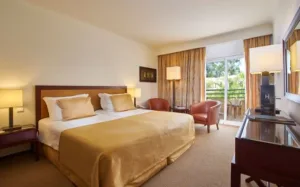
4 Star Hotels in Pokhara: Where Comfort Meets Serenity
Nestled amidst the breathtaking landscapes of Nepal, Pokhara stands as a gem, captivating the hearts of travelers with its beautiful lakes, majestic mountain views, and unique culture. Hundreds of tourists visit Pokhara, drawn by its natural beauty and a plethora of adventure activities that cater to every type of traveler. As you embark on a journey to explore this enchanting destination, the significance of your accommodation becomes an important element in shaping your overall travel experience.
In this blog, we look into the world of 4-star hotels in Pokhara, uncovering their unique offerings and exploring why they make an ideal choice for travelers. So, join us as we guide you through the advantages, options, and considerations in choosing the perfect hotel in Pokhara for your vacation.
Role of Accommodation in Your Travel Experience
Accommodation is more than just a place to rest it is a cornerstone of your adventure, influencing the way you perceive and connect with a destination. Pokhara, known for its diverse offerings, invites travelers to immerse themselves in its unique blend of tranquility and adventure. From lakeside strolls to mountain treks, every experience is complemented by the comfort and convenience provided by your chosen accommodation.
As you traverse the landscapes of Pokhara, each day brings discoveries, and the place you choose to stay becomes a sanctuary, a retreat that mirrors the beauty and charm of the surrounding environment. Your accommodation choice is much more than a room and can be a haven that enriches your journey, making it memorable and immersive.
In the realm of accommodations, 4-star hotels in Pokhara emerge as a harmonious blend of luxury and accessibility, offering a level of comfort that enhances the overall travel experience. These establishments stand as a synonym for quality, providing an array of amenities and services that add a touch of luxury to your stay.
Advantages of Choosing a 4-Star Hotel for Your Stay
When it comes to planning a memorable stay in Pokhara, the choice of accommodation plays a vital role in shaping your overall experience. Opting for a 4-star hotel unveils a realm of advantages that goes beyond mere comfort. Here, we explore why these establishments represent a sweet spot for travelers seeking a perfect blend of luxury and affordability.
Romantic Getaway with Partner
For those seeking a romantic escape, 4-star hotels in Pokhara provide an ideal setting. Imagine waking up to panoramic views of the Annapurna range or enjoying a candlelit dinner overlooking the tranquil Phewa Lake. The ambiance and attention to detail create an intimate atmosphere, making these hotels the perfect choice for a romantic retreat with your partner.
Elevated Comfort and Amenities
Luxury and comfort are seamlessly woven into the fabric of 4-star hotels in Pokhara. Immerse yourself in plush bedding, modern furnishings, and well-designed spaces that cater to your every need. These hotels often provide a range of amenities, from spas and fitness centers to poolside lounges, providing a level of indulgence that transforms your stay into a truly rejuvenating experience.
Enjoy Adventure Pokhara
While Pokhara offers various outdoor activities and adventures, returning to comfortable and well-appointed accommodation is essential. 4-star hotels in Pokhara offer a rest after a day of exploring and serve as a strategic base for your adventures. Whether you have spent the day paragliding over the city or trekking through the scenic landscapes, the comfort of a hotel awaits your return.
Personalized Service and Hospitality
What sets 4-star hotels apart is their commitment to providing personalized service. The staff’s attention to detail and dedication to ensuring your comfort contribute to a hospitality experience that goes beyond expectations. From concierge services to tailored facilities, you will find that the staff at 4-star hotels in Pokhara are eager to make your stay not just satisfactory but exceptional.
In the next section, we will look into a curated list of 4-star hotels in Pokhara, each offering a unique blend of these advantages. Explore the diverse options available, helping you make an informed choice for your upcoming Pokhara vacation.
List of 4 Star Hotels in Pokhara
Landmark Pokhara
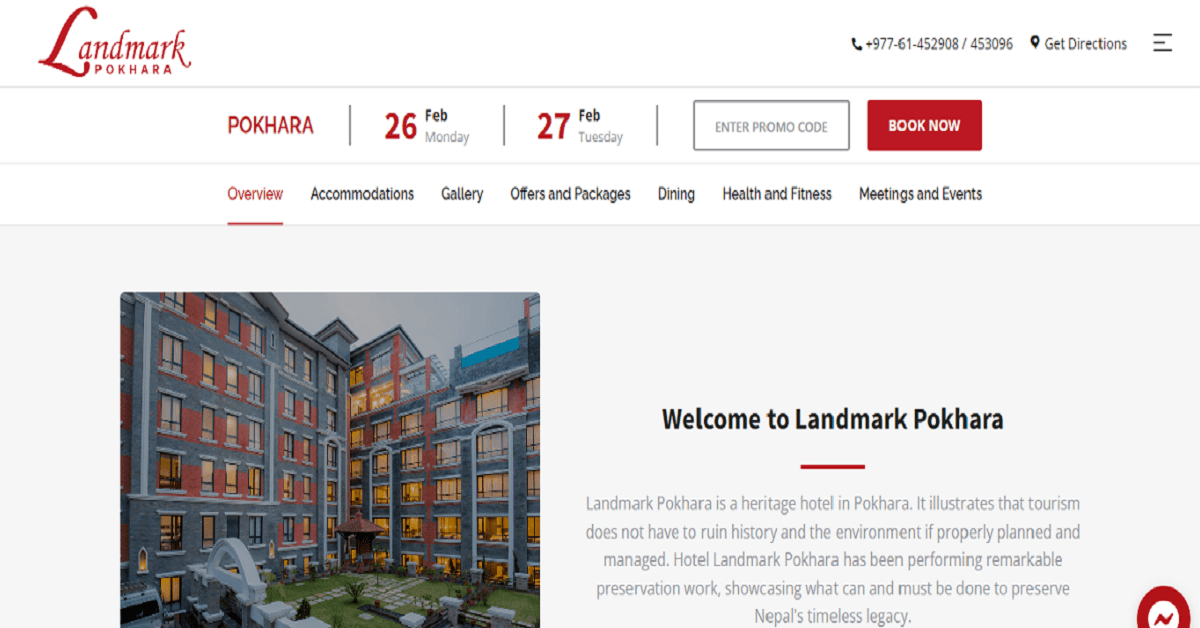
Discover the allure of heritage and environmental preservation at Landmark Pokhara, a distinguished hotel illustrating that tourism can coexist harmoniously with history and nature. The hotel boasts air-conditioned rooms with free toiletries and a seating area. With the Fewa Lake just 250 meters away and the Taal Basarai Temple 500 meters away, Landmark Pokhara ensures a central position for exploration.
Estimated Cost Per Night: Rs.9,000-11,000
The simplicity of the rooms, featuring en suite bathrooms, wardrobes, satellite TV, and mountain views in selected rooms, adds to the charm of your stay. Savor various local and international dishes at Hungry Eye Restaurant, or unwind at the Khukuri Bar for light snacks and refreshing beverages.
Features
- Gym
- SPA
- Swimming Pool
- Souvenir Shop
- ATM (Cash Machine)
- Electric Vehicle Charging Station
Contact Details
- Location: Lakeside, Pokhara 33700
- Contact: 061-452908
- Map: Get Direction
- Website: Landmark Pokhara
Hotel Sarowar
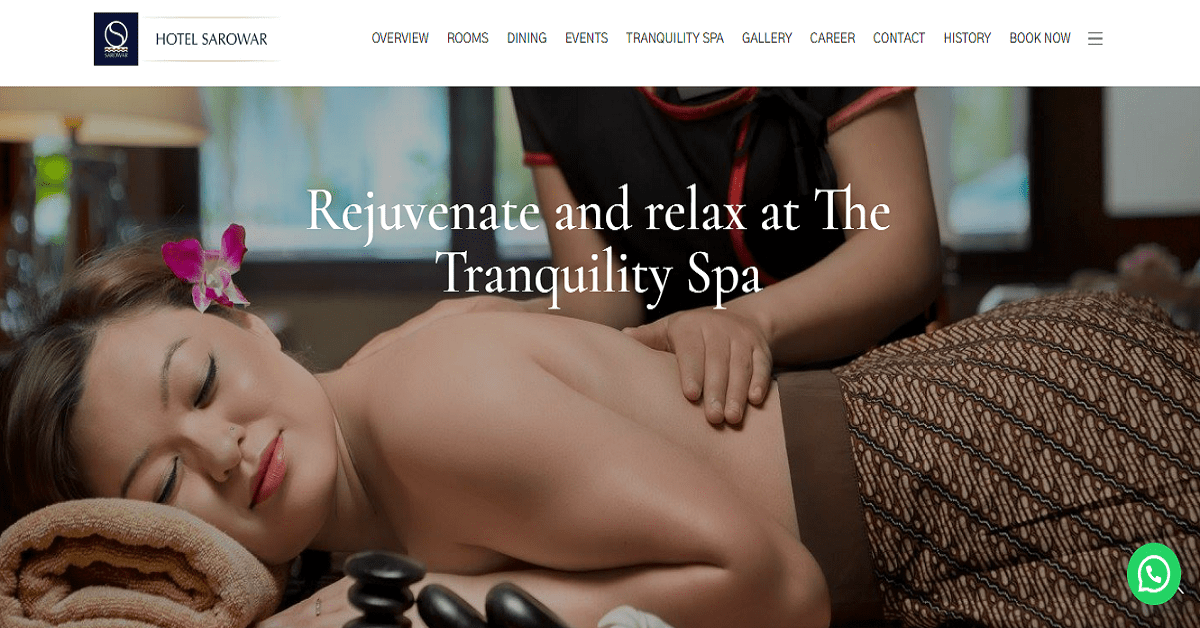
Embark on a sustainable journey at Hotel Sarowar, one of Nepal’s rare eco-friendly hotels. Rooted in a 40-year vision, the hotel seamlessly blends contemporary Nepalese architecture with modern style, embracing sustainability as its core value. With 140 KW of solar panels, geothermal air conditioning, and an eco-conscious design, Hotel Sarowar stands as a testament to responsible hospitality.
Estimated Cost Per Night: Rs.6,000-8,000
Featuring 96 luxury suites and rooms, seven conference halls, a spa, a swimming pool, and a rooftop restaurant offering breathtaking views, the hotel ensures a tranquil and comfortable ambiance for guests with diverse interests.
Features
- Spa
- Wi-Fi
- BBQ Night
- Swimming Pool
- Beauty Treatment
- Tranquil Atmosphere
Contact Details
- Location: 14th Street 15, Pokhara
- Contact: 061-506302
- Map: Get Direction
- Website: Hotel Sarowar
Bodhi Suits Boutique Hotel and Spa
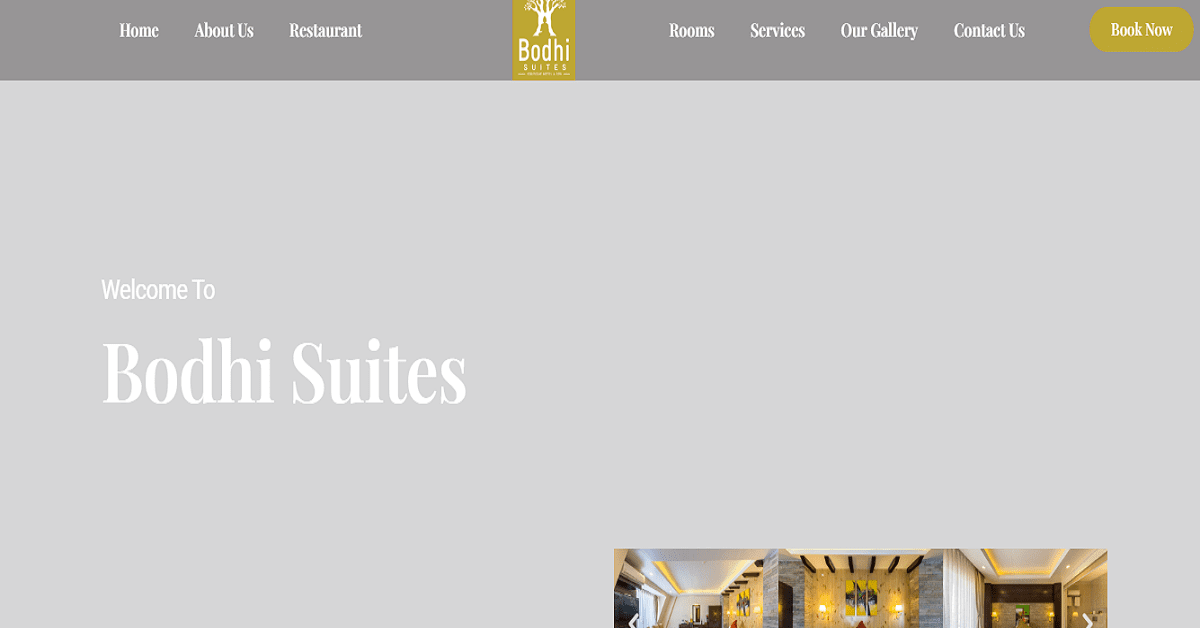
Escape to elegance at Bodhi Suites Boutique Hotel and Spa, a refined establishment in the City of Lakes, Pokhara. This boutique hotel offers a selection of well-furnished rooms, including suites, deluxe, and deluxe family rooms, each designed for stylish comfort.
Estimated Cost Per Night: Rs.4,000-7,000
Notably, Bodhi Suites boasts the distinction of being the first hotel in Pokhara with a rooftop swimming pool. Renowned for its chic interior design, contemporary comforts, and personalized services, Bodhi Suites stands as a beacon among boutique hotels in Pokhara.
Features
- ATM
- Fine Dining
- Doctor on Call
- Spa and Sauna
- Foreign Exchange
- Safe Deposit Locker
Contact Details
- Location: Barahi Street, Lakeside Rd, Pokhara
- Contact: 061-457657
- Map: Get Direction
- Website: Bodhi Suits Boutique Hotel and Spa
Waterfront by KGH Group
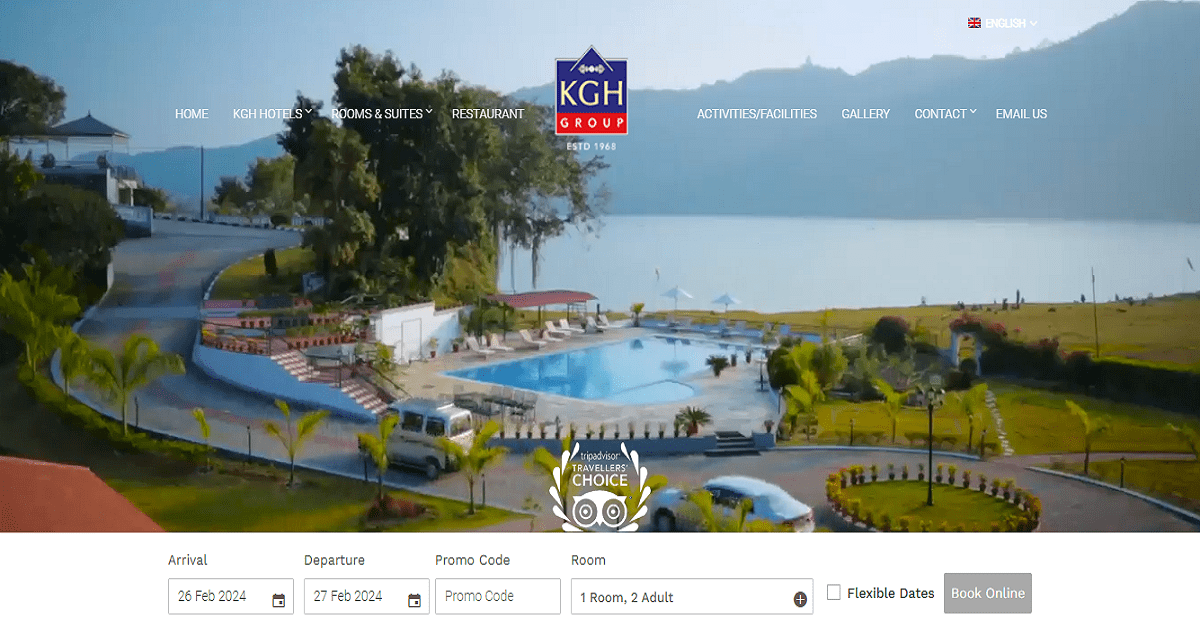
Experience serenity at Waterfront by KGH Group, where each of the 58 deluxe rooms offers remarkable views of Phewa Lake. Positioned as one of the best sites to appreciate the lake’s splendor, this resort provides an idyllic setting. With an outdoor swimming pool, high-speed Internet access, delightful dining options, and air-conditioned rooms featuring lake-view balconies, Waterfront is perfect for relaxation.
Estimated Cost Per Night: Rs.7,000
The hotel also offers free shuttle service into Lakeside, making it easily accessible for guests. Enjoy the tranquility of the surroundings, complemented by the convenience of modern amenities.
Features
- Wi-Fi
- Parking
- Restaurants
- Deluxe Rooms
- Fewa Lake View
- Outdoor Swimming Pool
Contact Details
- Location: Lakeside Rd, Pokhara
- Contact: 980-1166303
- Map: Get Direction
- Website: Waterfront by KGH Group
The Pavillions Himalayas The Farm

Nestled in a lushly forested valley, The Pavilions Himalayas invites you to a paradise where the majestic Himalayan mountain range meets untouched culture. This luxury eco-resort, powered entirely by renewable energy, offers 14 luxurious villas set against the backdrop of Pokhara.
Estimated Cost Per Night: Rs.18,000-19,000
A stay at The Pavilions Himalayas contributes positively to the local community and natural environment. With an organic farm as the source of fresh produce, the resort also provides hospitality training to young people through its FAB School, transforming lives through skills and employment.
Features
- Spa
- Pool
- Yoga Retreat
- Organic Food
- Curated Packages
- Traditional Ambience
Contact Details
- Location: Ward No. 22, Chisapani, Pokhara
- Contact: 985-6027997
- Map: Get Direction
- Website: The Pavillions Himalayas The Farm
Hotel Iceland
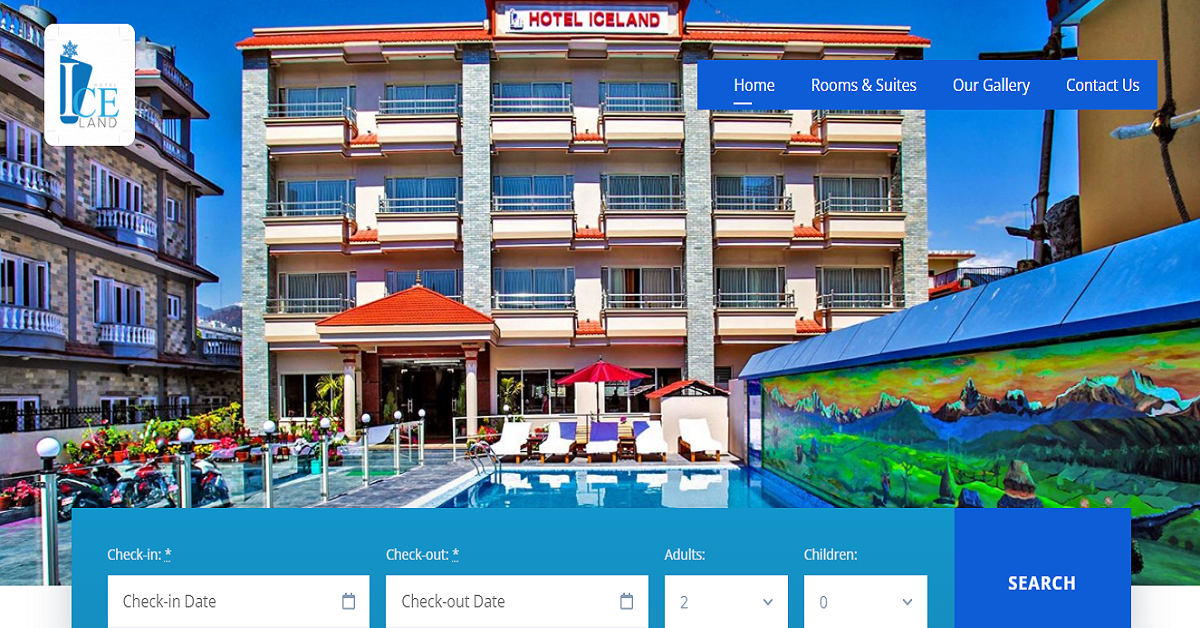
Experience comfort and tranquility at Hotel Iceland, a family-run establishment with 30 years of hospitality expertise. Situated near Lakeside, the hotel offers a peaceful atmosphere while remaining close to popular bars, restaurants, and traditional shops. Boasting a spa, massage facility, and an outdoor swimming pool, Hotel Iceland ensures a relaxing stay. The rooms, some with mountain views and private patios, provide a serene retreat.
Estimated Cost Per Night: Rs. 4,000-6,000
Enjoy Nepalese cuisine at the on-site restaurant and make the most of complimentary one-way airport pick-up. Immerse yourself in the tranquil ambiance while being well-connected to the vibrant surroundings of Pokhara.
Features
- Bar
- Free Parking
- Outdoor Pool
- Airport Shuttle
- Family Rooms
- Tea/Coffee Maker in all Rooms
Contact Details
- Location: Lakeside, Pokhara, Nepal
- Contact: 98061455737
- Map: Get Direction
- Website: Hotel Iceland
How to Choose the Right Hotel for Your Stay?
Selecting the perfect 4-star hotel in Pokhara involves thoughtful consideration of various factors that align with your individual preferences and requirements. Here are some tips to help you through the decision-making process:
-
Location
Consider the location of the hotel for your planned activities. Whether you prefer a lakeside retreat or proximity to the city center, choosing a location that suits your itinerary can significantly enhance your overall experience.
-
Amenities
Evaluate the amenities offered by each 4-star hotel in Pokhara. Look for features that align with your preferences, such as a relaxing spa, a fitness center or swimming pool for staying active, or on-site dining options. The right amenities can elevate your stay and cater to your specific needs.
-
Reviews
Tap into the experiences of previous guests by reading reviews. Platforms like TripAdvisor, Booking.com, or Google Reviews provide valuable insights into the quality of service, cleanliness, and overall satisfaction. Pay attention to reviews that align with your priorities, and take note of any consistent positive or negative feedback.
-
Budget Considerations
While 4-star hotels offer luxury, they come in a range of price points. Define your budget beforehand and explore hotels that fit within that range. Keep in mind that pricing may fluctuate based on factors like the time of year, so consider booking during off-peak seasons for potential cost savings.
-
Online Platforms and Resources
Utilize online platforms and resources to streamline your decision-making process. Booking websites such as Expedia, Hotels.com, or the hotel’s official website can provide comprehensive information about rates, amenities, and special offers. Additionally, engage with travel forums like Lonely Planet or TripAdvisor forums to seek advice from fellow travelers who have explored Pokhara.
-
Special Considerations
If you have specific requirements, such as accessibility features, family-friendly accommodations, or pet-friendly policies, ensure the hotel can accommodate these needs. Directly contacting the hotel to discuss any special considerations can provide clarity and avoid potential inconveniences.
By carefully considering these factors, you can tailor your choice of a 4-star hotel in Pokhara to align with your preferences, ensuring a stay that not only meets but exceeds your expectations.
Final Say
In concluding our exploration of the captivating world of 4-star hotels in Pokhara, let’s recap the key insights that can shape your upcoming travel experience. Opting for a 4-star hotel in this picturesque city offers a unique blend of luxury and accessibility, elevating your stay to memorable heights.
We have unraveled the advantages of choosing a 4-star haven – from the timeless preservation efforts at Landmark Pokhara to the eco-friendly ethos of Hotel Sarowar. Bodhi Suites Boutique Hotel and Spa beckons with elegance, while Waterfront by KGH Group provides an idyllic setting overlooking Phewa Lake. The Pavilions Himalayas – The Farm embraces sustainability, and Hotel Iceland blends comfort with a tranquil atmosphere.
As you contemplate your accommodation choice, consider the advantages of elevated comfort, personalized services, and diverse amenities that accompany a stay in a 4-star hotel. The romantic getaways, family-friendly environments, and serene retreats offered by these establishments cater to a spectrum of preferences.
We extend our heartfelt gratitude for joining us on this journey through the 4-star hotels in Pokhara. Your choice of accommodation can transform your visit into an unforgettable experience, and we hope our insights assist you in making a decision that aligns with your travel dreams. Safe travels, and may your stay in Pokhara be nothing short of extraordinary!
FAQ
- What distinguishes a 4-star hotel from other accommodation options in Pokhara?
4-star hotels in Pokhara offer a higher level of comfort, luxury amenities, and personalized services compared to other accommodation options. They strike a balance between affordability and indulgence, providing a memorable stay.
- How can I ensure that the 4-star hotel I choose meets my specific preferences?
Consider factors such as location, amenities, and reviews. Reading guest reviews on platforms like TripAdvisor can offer valuable insights into the experiences of others, helping you make an informed decision.
- Are 4-star hotels in Pokhara suitable for families with children?
Yes, Many 4-star hotels cater to families, offering family-friendly rooms, amenities, and activities. Some hotels even have children’s playgrounds to ensure a delightful stay for families.
- How do I book a room in advance at the 4-star Hotel in Pokhara?
You can book a room directly through the official websites of the hotels or use popular online booking platforms such as Booking.com or Expedia. Some hotels may offer exclusive deals or promotions on their official sites.
- Do these hotels offer airport shuttle services?
Yes, some of the 4-star hotels in Pokhara provide complimentary airport transportation services. Check with the specific hotel you are interested in, or inquire about it during the booking process.
- Are the hotels mentioned in the blog environmentally conscious or sustainable?
Yes, some of the hotels, such as Hotel Sarowar and The Pavilions Himalayas – The Farm, prioritize sustainability. They incorporate eco-friendly practices, and renewable energy sources, and contribute positively to the local community and environment.
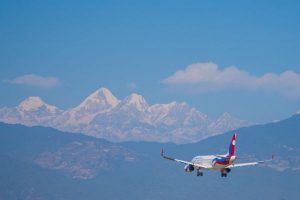
Best Time to Visit Pokhara: Ideal Seasons for a Memorable Trip
Nestled in the Kaski District of Gandaki province, against the backdrop of the majestic Himalayas, Pokhara emerges as a gem in the heart of Nepal. This enchanting city holds profound significance, not just for its breathtaking landscapes but also for the range of experiences it offers to its visitors.
Pokhara, often referred to as the “Gateway to the Annapurna Circuit,” holds immense cultural and natural significance. It serves as a starting point for treks and adventure, offering a gateway to the ethereal beauty of the Annapurna mountain range. The city is rich in serene lakes, the most famous being Phewa Lake, where the clear waters mirror the snow-capped peaks, creating a picture-perfect setting.
But Pokhara is not just a feast for the eyes, it is also a playground for the adventurous soul. So, Brace yourself for an array of heart-pounding activities such as paragliding, bungee jumps, a boat ride, and more sports in this beautiful valley.
Curious to explore more about “When is the best time to visit Pokhara?” Dive into the blog to discover the answer and witness the adventure of a lifetime!
Best Time to Visit Pokhara
Selecting the optimal time for your visit to Pokhara is important for crafting an enriching and enjoyable experience. The timing of your trip not only influences the weather but also matches the range of activities available, making it a key consideration for any traveler.
The best months to explore Pokhara are March-May, and September – November, which coincide with the peak tourist season. During these months, the weather is at its best, offering a delightful mix of pleasant temperatures and clear skies. Importantly, these seasons do not witness rainfall, providing an ideal setting for outdoor adventure activities such as trekking and hiking in the nearby Manang, Mustang, and Annapurna regions.
Is Pokhara Worth Visiting?
The following reasons make Pokhara City worth visiting:
-
Natural Beauty
Pokhara boasts unparalleled views of the Annapurna and Machapuchare mountain ranges, creating a backdrop that seems painted by nature’s finest brushstrokes.
The serene lakes, including Phewa Lake, Begnas, Rupa, and more, add an extra layer of tranquility, making Pokhara a visual feast for any traveler.
-
Adventure Activities
Unlike many destinations, Pokhara is much more than just for sightseeing. It offers various adventurous activities like paragliding, bungee jumping, and trekking, ensuring there will never be a dull moment.
-
Cultural Richness
Immerse yourself in a rich cultural tapestry, evident in its vibrant festivals, rituals, and warm hospitality of Pokhara. The blend of tradition and modernity creates a unique and welcoming atmosphere.
-
Gateway to the Annapurna Circuit
Pokhara is also the starting point for the iconic Annapurna Circuit trek. The city is a hub for trekkers, adding a sense of exploration and anticipation.
-
Peaceful Atmosphere
While adventure thrives, Pokhara offers pockets of tranquility, allowing visitors to unwind in nature. The peaceful ambiance sets the valley apart from bustling tourist destinations, creating a perfect balance.
-
Unique Lakeside Culture
The Lakeside area, with its vibrant cafes, shops, and cultural charm, sets Pokhara apart. The place where modern amenities harmonize with the simplicity of lakeside living.
In essence, what makes Pokhara worth visiting is not just one aspect but the harmonious blend of nature, adventure, culture, and tranquility. It is a destination that caters to diverse interests, ensuring every traveler finds something extraordinary.
Average Weather of Pokhara City
January Weather in Pokhara
- Day Temperature: 17 °C
- Night Temperature: 6 °C, chilly evenings.
January is tourist season providing opportunities for unique experiences. January in Pokhara signifies a shift in weather, welcoming visitors to cool temperatures and the promise of adventure amidst a serene setting.
February Weather in Pokhara
- Day Temperature: 19 °C
- Night Temperature: On the ascent, promising milder nights.
February maintains a dry spell in Pokhara, inviting tourists to explore its wonders as temperatures gradually begin to warm.
March Weather in Pokhara
- Day Temperature: 25 °C
- Night Temperature: 11 °C
- Rainfall: 48 mm (1.88 in), and an increase in rainy days.
Tourist season continues, with the emergence of more sun hours. As March unfolds, Pokhara experiences a surge in temperature, calling tourists to enjoy the vibrant ambiance and cultural richness.
April Weather in Pokhara
- Day Temperature: 28 °C
- Night Temperature: 15 °C
- Rainfall: 71 mm (2.81 in), maintaining the tourist season.
April in Pokhara reaches its peak in terms of temperature and sunlight, creating an inviting atmosphere for travelers.
May Weather in Pokhara
- Maximum Day Temperature: 30 °C
- Night Temperature: 18 °C (65 °F)
- Rainfall: 223 mm (8.79 in), with 7 rainy days.
May in Pokhara offers the warmth of summer but also marks the beginning of increased rainfall, adding a touch of green to the landscape.
June Weather in Pokhara
- Day Temperature: 29 °C
- Maximum Night Temperature: 20 °C
- Rainfall: 354 mm (13.94 in), with 13 rainy days.
Sun hours reduce to 6 hours, signaling the onset of the wet season. June marks the wet season in Pokhara, with decreasing sun hours and an increase in rainfall.
July Weather in Pokhara
- Day Temperature: 27 °C
- Maximum Rainfall in July: The wet season is in full swing.
- Minimum Sun Hours: 4 hours, marking the peak of the rainy season.
July in Pokhara is also the wet season, characterized by descending temperatures and increased rainfall.
August Weather in Pokhara
- Rainfall Amount: 505 mm (19.90 in).
- Humidity: 82%, reaching its maximum.
August witnesses a gradual decrease in rainfall and the beginning of the decline in humidity, signaling the end of the wet season.
September Weather in Pokhara
- Day Temperature: 26 °C
- Night Temperature: 18 °C
- Rainfall: 354 mm (13.94 in), with 13 rainy days.
- Sun Hours: 5 hours, signaling the start of a weather transition.
September in Pokhara marks the conclusion of the wet season, with temperatures and rainfall gradually decreasing.
October Weather in Pokhara
- Day Temperature: 25 °C
- Night Temperature: 15 °C
- Rainfall: 71 mm (2.81 in)
October weather in Pokhara brings cooler temperatures and a sense of crispness to the air. The decreasing rainfall and cooler evenings make it an ideal time for tourists seeking a balance between adventure and tranquility.
November Weather in Pokhara
- Day Temperature: 22 °C
- Night Temperature: 10 °C
Tourist season peaks, offering an enchanting experience amid comfortable temperatures.
November unfolds with a serene ambiance, making Pokhara a perfect destination for those who enjoy cooler weather and a touch of cultural richness. The minimal to no rainfall adds to the charm, creating an atmosphere conducive to exploration.
December Weather in Pokhara
- Day Temperature: 18 °C
- Night Temperature: 7 °C
In summary, each month in Pokhara brings distinct weather patterns, offering a diverse experience for travelers. Whether you prefer the warmth of summer, the refreshing monsoons, or the coolness of winter, Pokhara has something to offer throughout the year.
Best Month to Visit Pokhara for Trekking
The autumn season, from September to November, stands out as the prime time for trekking around Pokhara. This period offers optimal conditions characterized by better visibility of stunning mountains, excellent weather, and vibrant green hills. Daytime temperatures hover around 20 degrees Celsius, creating mild and warm days, while nights cool down to approximately 5 degrees Celsius.
Spring, from March to May, is another exceptional trekking season. As nature awakens, trekkers are treated to blooming flora and fauna, showcasing the vibrant colors of the landscape. The temperature during the day ranges from pleasantly warm to cool in the evenings, creating an inviting environment for outdoor enthusiasts.
Some famous trekking trails near Pokhara are:
- Sirubari Homestay Trek
- Ghandruk Village Trek: 2 Days Itinerary
- Machhapuchhre Model Trail
- Ghorepani Poonhill Trek
- Kori Village Trek
- Mardi Himal Trek
Why Autumn and Spring?
Both autumn and spring bring a spectacle of natural beauty. The landscape comes alive with blooming flora and fauna, showcasing the diversity of wildlife. Different colored flowers add to the visual tapestry, creating a fragrant and attractive environment for trekkers. The clear skies and crisp mountain air contribute to the overall allure of these seasons.
Selecting the season for trekking plays a crucial role in shaping a memorable hiking experience. The combination of excellent weather, mildly warm days, and a clear view of the mountains and sky make both autumn and spring the ideal times for trekking around Pokhara.
Best Month to Visit Pokhara, Nepal for Rafting
The prime seasons for white-water rafting near Pokhara are from September to November and March to June. The rivers offer optimal conditions for an exciting and safe rafting experience during these periods. Rafting is practiced in Seti River which is also ideal for beginners. However, it is crucial to note that attempting rafting during the monsoon season is discouraged due to excessively high river levels. From December to February, the rivers become too cold for an enjoyable experience.
Therefore, to experience the rush of white-water rafting near Pokhara, plan your visit from September to November and March to June. This ensures the thrill of navigating the rapids and a safe and enjoyable rafting escapade amidst the region’s stunning natural beauty.
Best Time to Visit Pokhara for Paragliding
Paragliding in Pokhara is a soaring adventure that unveils stunning views of Phewa Lake and surrounding landscapes. Choosing the right time is vital for an optimal paragliding experience.
The best paragliding seasons in Pokhara are March, April, May, September, October, and November. These months offer clear views of Phewa Lake. Sarangkot is a sought-after spot. Paragliding is practiced during all seasons except the rainy season, with November and December being particularly famous.
When is the Best Month to Visit Pokhara, Nepal for Bungee?
The prime months for bungee jumping in Pokhara span from March to May and September to November. During these windows, the weather in Nepal remains reliably dry and pleasant, providing the perfect conditions for an unforgettable bungee jumping adventure. Opting for these months ensures not only the thrill of the jump but also a safer and more enjoyable escapade against the stunning backdrop of Pokhara’s landscapes.
Best Time to Visit Pokhara for Boating in Fewa Lake
The prime time for boating in Pokhara Lakeside is during the winter months, from October to February. This period offers an unparalleled experience as the skies remain clear, and the mountains cast their majestic shadows upon the crystal-clear waters of the lakes. While winter is considered the optimal season, boating is a cherished activity throughout the year in Pokhara.
However, it is important to note that monsoon months pose a little danger for boating due to unpredictable weather conditions. During other times of the year, the Lakeside beckons with its calm waters and breathtaking surroundings, providing an ideal setting for a leisurely boat ride.
Best Time to Visit Pokhara for Ultralight Flight
Ultralight flight in Nepal is only possible in Pokhara and presents a one-of-a-kind opportunity for aerial sightseeing. These flights utilize lightweight aircraft with no windows, providing an intimate setting for two individuals; a pilot and a passenger.
The optimal time to experience ultralight flights in Pokhara spans from September to May. During these months, the weather conditions are favorable, offering clear skies and stunning visibility. This period ensures that passengers can fully appreciate the aerial views of beautiful Pokhara and the Himalayan backdrop, including the magnificent Annapurna massif.
Best Time to Visit Pokhara for Canyoning
Lwang Ghalel is popular for canyoning in Pokhara. Here, participants can immerse themselves in the thrill of navigating two waterfalls with heights of 45 and 75 meters, respectively.
The perfect time for Canyoning is from March to September. During these months the water flow in the springs rises, creating an ideal environment for this adventurous pursuit. The rising water flow during these months transforms canyoning into an adrenaline-pumping adventure. The rapid waterfalls offer a dynamic and thrilling backdrop for participants, creating an exhilarating journey through the canyons of Pokhara.
Final Say
As we wrap up our exploration of the best times to visit Pokhara, let’s highlight key insights for your upcoming adventure in this stunning destination.
The weather in Pokhara is optimal from March to May and September to November, offering perfect conditions for various outdoor activities like trekking, paragliding, bungee jumping, and ultralight flights. Lakeside, a serene spot amidst aquatic landscapes, welcomes visitors year-round, with winter adding a touch of magic.
Now that we have explored the seasons, consider this your invitation to plan your Pokhara adventure. Whether you seek a connection with nature or an adrenaline rush, Pokhara stands ready to fulfill your desires.
A heartfelt thank you for joining us on this blog. We invite you to embark on your adventure, crafting timeless memories in the heart of Nepal.
FAQ
- What is the best time to visit Pokhara for a trekking adventure?
The best time for trekking in Pokhara is during the autumn season, spanning from September to November. This period offers excellent weather conditions with clear skies, mild temperatures, and breathtaking views of the Himalayas. The spring season from March to May is also favorable, providing a vibrant landscape with blooming flora.
- What is the prime season for canyoning in Pokhara?
The optimal time for canyoning in Pokhara is from March to September. During these months, the water flow in the springs increases, creating an ideal environment for navigating through rapid waterfalls. The rising water levels add an extra thrill to this adventurous activity, providing an unforgettable canyoning experience.
- What is the best time for paragliding in Pokhara?
For adventure enthusiasts, the best time to soar through the skies of Pokhara is during March-May, and September – November. These months offer stunning views of Phewa Lake and mountain creating a scenic backdrop for paragliding.
- Is Pokhara worth visiting during the monsoon season?
While Pokhara is known for its scenic beauty, the monsoon season, from June to August, brings heavy rainfall and increased humidity to the region. During these months, outdoor activities may be affected, and the visibility of the mountains can be limited. It is advisable to plan visits outside the monsoon season for a more enjoyable and adventurous experience in Pokhara.

Best Spas in Pokhara for 2024: Relaxation Destinations
Nestled in the lap of nature’s splendor, Pokhara has earned its place as a captivating destination within Nepal tourism. With its scenic landscapes and serene ambiance, it attracts wanderers seeking an escape into tranquility from around the world. Pokhara city has earned its stripes as a premier tourist destination, offering a rest for tired souls seeking solace in the lap of nature. However, there is more to Pokhara than just its scenic allure, the city has quietly become a hub for those in search of not just scenic beauty but also holistic rejuvenation.
In the hustle and bustle of today’s frenetic pace of life, the significance of self-care and relaxation cannot be overstated. As the world races forward, the need to slow down and invest in our well-being becomes increasingly paramount. In this pursuit of tranquility, the spas in Pokhara have flourished as a culture and aesthetic in this valley.
The growing interest in the spas in Pokhara is a testament to the evolving mindset of modern travelers, who seek not only scenic natural views but also holistic experiences that nurture the body, mind, and soul.
Join us on this exploration of the “Best Spas in Pokhara,” where we dive into the soothing sanctuaries that have emerged as relaxation in this Himalayan paradise. From traditional healing practices to modern wellness innovations, the spas in Pokhara promise a harmonious blend of nature’s grandeur and the therapeutic touch of skilled practitioners.
Why Visit Spas in Pokhara?
The straight answer to “Why Visit Spas in Pokhara?” is to embrace wellness in the heart of the beautiful city of Pokhara. In the hustle of our daily lives, where we constantly worry about deadlines and other issues, the concept of a spa is a luxury and a sanctuary of well-being. As we dive into the exploration of the “Best Spas in Pokhara,” let’s look into the layers of why a visit to a spa is more than just a pampering session, it is an investment in your overall health and vitality.
- Stress Relief
Beyond the aromatic candles and soothing music, spa treatments offer a profound escape from the stressors that often plague our daily existence. Scientifically, spa therapies have been shown to reduce the levels of cortisol, the infamous stress hormone, leading to a sense of relaxation, happiness, and tranquility.
Numerous studies and research have indicated that spa treatments, such as massages and hydrotherapy, can significantly relieve stress and contribute to improved mental well-being.
- Improved Circulation
Spa treatments, particularly massages, play a pivotal role in enhancing blood circulation throughout the body. The manipulation of muscles and tissues not only eases tension but also promotes better oxygen and nutrient delivery to cells.
Studies show that medicine & rehabilitation have highlighted the positive impact of massage therapy on blood circulation, emphasizing its role in reducing muscle soreness and enhancing vascular function.
- Overall Well-Being
The holistic approach of spa treatments extends beyond the physical realm to encompass mental and emotional well-being. From aromatherapy to meditation sessions, spas offer a diverse range of therapies aimed at harmonizing mind, body, and spirit.
Testimonials from individuals who have embraced spa experiences often speak of a profound sense of rejuvenation, improved sleep quality, and heightened self-awareness.
- Scientific Support
The scientific community continues to explore and affirm the positive effects of spa treatments on overall health. From studies on the benefits of hydrotherapy for joint health to the impact of spa interventions on cardiovascular health, the evidence is mounting.
- Connection to a Healthier Lifestyle
A spa visit can catalyze adopting a healthier lifestyle. The rejuvenation experienced at spas in Pokhara often sparks a desire for ongoing self-care practices, such as regular exercise, mindful eating, and stress management.
- Relaxation After the Trek
Pokhara is a gateway to diverse trekking trails in Nepal, spa visits after a trek have a unique significance. After conquering the challenges of trekking, these sanctuaries become havens for unwinding, allowing tired muscles to rejuvenate and the mind to find tranquility, completing the adventure with a touch of luxury.
Some famous trekking trails for adventure near Pokhara Valley:
Facilities Provided by Spas in Pokhara
As we immerse into the exploration of the “Best Spas in Pokhara,” let’s open the door to a world of rejuvenation and luxury, where facilities extend beyond the ordinary to create an unparalleled experience for your body and soul.
- Sauna:
The sauna, a timeless classic in the spa world, is a haven of detoxification. This dry heat experience not only promotes sweating and releasing toxins from the body but also induces deep relaxation. The benefits range from improved circulation to clearer skin, making it a base of many spa retreats in Pokhara.
- Steam Room:
Offering a contrasting experience to the dry heat of the sauna, steam rooms envelop visitors in moist, warm air. Beyond the soothing effect on the skin, the steam enhances respiratory function, relieves muscle tension, and provides a tranquil space for meditation and introspection.
- Jacuzzi:
The gentle embrace of bubbling water in a jacuzzi is synonymous with luxury and relaxation. Beyond the sheer enjoyment, hydrotherapy in a jacuzzi stimulates blood circulation, eases muscle soreness, and contributes to an overall sense of well-being. In the serene landscape of Pokhara, a jacuzzi becomes a sensory oasis.
- Massage Therapy:
The heart and soul of any spa experience, massage therapy is a journey toward rejuvenation. Whether it be a traditional Nepalese massage or a globally-inspired technique, skilled therapists in Pokhara are adept at unlocking the body’s tension points, promoting relaxation, and restoring balance.
- Yoga and Indian Therapy:
Recognizing the profound connection between mind and body, the spas in Pokhara often offer yoga sessions and Indian therapy treatments. Yoga, with its centuries-old roots in promoting holistic well-being, pairs seamlessly with spa experiences to enhance flexibility, balance, and mental clarity.
- Significance of a Tranquil Ambiance:
Beyond the specific amenities, the ambiance of a spa is crucial in crafting an immersive experience. Spas in Pokhara are nested against the backdrop of the Himalayas and often feature open-air spaces or large windows that invite the natural beauty of the surroundings into the treatment areas.
The tranquil ambiance becomes a hub for relaxation, allowing guests to escape the outside world and fully immerse themselves in the healing embrace of the spa environment.
- Skilled Therapists:
Spa therapists in Pokhara are like the architects of relaxation, turning spa facilities into havens of healing. They blend the wisdom of local traditions with their expertise, creating a personalized experience for each visitor. With their professional touch, they navigate the intricacies of the body, ensuring that every treatment becomes a unique and tailored journey for each person.
- High-Quality Products:
The use of premium products amplifies the efficacy of spa treatments. From locally sourced organic ingredients to globally acclaimed skincare lines, spas in Pokhara prioritize the quality of products to enhance the overall experience. This commitment to excellence elevates the sensory journey and nurtures the skin with the care it deserves.
List of Best Spas in Pokhara for 2024
Tranquility Spa-Pokhara
Indulge in a lifestyle of wellness with Tranquility Spa-Pokhara, a distinguished leader in the spa and wellness industry in Pokhara since its establishment in 2008. Recognized by the Nepal Tourism Board, this spa boasts numerous outlets across different cities and luxury hotels in Nepal and abroad. Pioneers in the industry, and their team of professionals, educated in renowned institutes worldwide, ensure an unparalleled experience. With a commitment to a healthier and more balanced life, Tranquility Spa-Pokhara offers a peaceful retreat, loyalty program benefits, and premium membership services.
Services
- Steam
- Zumba
- Jacuzzi
- Aerobics
- Tennis Court
- Yoga & Meditation
Contact Details
- Location: Hotel Sarowar, 14th Street, Lakeside
- Contact: 980-2021282
- Map: Get Direction
- Website: Tranquility Spa-Pokhara
Jiva Spa
Discover the hidden gem, Jiva Spa, nestled on the shores of the picturesque Phewa Lake. This spa offers a serene escape with unique private treatment cottages, a lake view terrace, and a spacious garden. Beyond massages like Traditional Nepali and Swedish, Jiva Spa provides body scrubs, facials, manicures, pedicures, and signature spa packages. Unwind, be pampered, and experience the difference at this tranquil sanctuary.
Services
- Body Scrub
- Swedish Massage
- Trekkers Massage
- Hot stone Massage
- Deep Tissue massage
- Traditional Nepali Massage
Contact Details
- Location: Lakeside Rd, Pokhara
- Contact: 061-465379
- Map: Get Direction
- Website: Jiva Spa
Green Spa Pvt Ltd
Step into Green Spa Pvt Ltd, a state-of-the-art facility designed to soothe stress, pain, and anxiety. Equipped with modern technology, this spa offers a peaceful environment for mind, body, and spirit rejuvenation. Centrally located, Green Spa Pvt Ltd provides the perfect space to enhance your beauty with a range of treatments, seamlessly blending technology with relaxation.
Services
- Facial
- Mehandi
- Shirodhara
- Body Scrub
- Deep Tissue Massage
- Manicure/Pedicure
Contact Details
- Location: Lakeside, Pokhara
- Contact: 981-4121478
- Map: Get Direction
- Website: Green Spa Pvt Ltd
Dreams Spa Pokhara
Dreams Spa Nepal is a sanctuary of bliss, offering a range of holistic treatments based on ancient practices such as yoga, naturopathy, Ayurveda, and Traditional Chinese Medicine. Under the guidance of a naturopathy doctor and a dedicated team, this spa seamlessly blends ancient wisdom with contemporary therapies. Dreams Spa Pokhara promises an unforgettable experience that exceeds expectations, providing the ultimate purpose of life – achieving a state of ‘anand.’
Services
- Sauna
- Hair Care
- Ayurveda
- Physiotherapy
- Beauty Treatment
- Manicure and Pedicure
Contact Details
- Location: Baidam Road, Pokhara
- Contact: 061-590124
- Map: Get Direction
- Website: Dreams Spa Pokhara
Malama Spa
Established in 2015 by Nisha Budha, Malama Spa is not just a spa; it is a dream realized. Nisha’s vision was to create employment opportunities for women while providing excellent service. From its first branch to expansions in the mid-western and far-western regions of Nepal, Malama Spa takes pride in offering professional and skilled services. Experience their standard of care and be a part of their growing reputation for excellence.
Services
- Thai Massage
- Ayurvedic Massage
- Head, Neck & Shoulder
- Aromatherapy Massage
- Traditional Nepali Masage
- Trekker’s Special Massage
Contact Details
- Location: Malama Spa, Hallanchowk, Pokhara
- Contact: 061-462707
- Map: Get Direction
- Website: Malama Spa
Sakura Spa Hallan-Chowk Branch
Sakura Spa Hallan-Chowk Branch offers professional massage and beauty services by well-experienced therapists. Catering to both ladies and gents, this spa provides reasonable prices and happy hour discounts from 1 pm to 8 pm every day. For an affordable yet rejuvenating experience, Sakura Spa Hallan-Chowk Branch invites visitors to their location for a touch of professional pampering.
Services
- Aroma Therapy
- Ayurvedic Massage
- Hot Stone Massage
- Deep Tissue Massage
- Thai Stretching Therapy
- Trekkers Massage Therapy
Contact Details
- Location: Phewa Marga, Hallanchowk
- Contact: 980-6517700
- Map: Get Direction
- Website: Sakura Spa Hallan-Chowk Branch
Conclusion
As we draw the curtain on our exploration of the “Best Spas in Pokhara,” let’s take a moment to recap the key insights that have unfolded in our journey through the realm of relaxation and rejuvenation.
Pokhara, with its breathtaking landscapes and serene ambiance, offers not just a tourist destination but a sanctuary for holistic well-being. The spa facilities, ranging from saunas to jacuzzis and skilled massage therapists, form a symphony of serenity and skill, creating an unparalleled experience for both body and soul.
As you navigate the vibrant landscape of Pokhara, consider prioritizing self-care amidst the cultural tapestry woven with traditions of wellness. A visit to a spa becomes not just a luxury but a necessity, a journey towards a healthier and more balanced life.
Thank you for accompanying us on this exploration. We hope you are inspired to carve out moments for self-care, whether it be through a soothing massage, a tranquil session in a steam room, or a moment of reflection amidst the Himalayan beauty.
FAQ’s
- What types of massage do spas in Pokhara provide?
The spas in Pokhara offer a diverse range of massages to cater to various preferences and wellness needs. From Traditional Nepali and Swedish massages to Deep Tissue, Trekkers, Thai, and Yogic Shiatsu massages, these spas ensure a tailored and rejuvenating experience for every individual.
- What are the best spas in Pokhara?
The best spas in Pokhara are subjective, as preferences vary. However, establishments like Tranquility Spa-Pokhara, Jiva Spa, Green Spa Pvt Ltd, Dreams Spa Pokhara, Malama Spa, and Sakura Spa Hallan-Chowk Branch have garnered acclaim for their unique offerings, serene ambiance, and commitment to wellness.
- Do spas in Pokhara provide good services?
Yes, the spas in Pokhara pride themselves on providing excellent services, blending traditional and modern techniques to offer a holistic wellness experience. With skilled therapists and a commitment to customer satisfaction, these spas ensure that each visit is a journey of relaxation and rejuvenation.
- Is there Yoga in the Spas of Pokhara?
Yes, many spas in Pokhara recognize the importance of mind-body harmony. Some establishments, such as Jiva Spa and Dreams Spa Pokhara, offer yoga sessions as part of their holistic wellness packages. These sessions are designed to complement the spa experience, providing guests with a complete and rejuvenating journey.
- Are loyalty programs offered by spas in Pokhara, and what are its benefits?
Yes, spas in Pokhara, like Tranquility Spa-Pokhara, often have loyalty programs. These programs typically include exclusive benefits for regular customers, such as discounts on services, priority bookings, and access to premium membership perks. It is a way for spas to show appreciation for their loyal customers.

Budget-Friendly Hotels in Pokhara for Your 2024 Stay
Pokhara stands as a gem among tourist destinations around the world. Surrounded by the majestic Annapurna range and serene lakes, Pokhara has become a magnet for travelers seeking a blend of natural beauty and cultural charm.
In this enchanting city, where every corner tells a story, the exploration prospect is boundless. However, to truly immerse yourself in the magic of Pokhara, it is essential to consider every aspect of your journey, starting with your choice of accommodation.
Why Choose Budget-Friendly Hotels in Pokhara?
As the allure of Pokhara draws tourists from around the world, the significance of finding budget accommodations becomes paramount. It allows you to stretch your travel budget and opens up a world of possibilities for discovering the unique offerings of Pokhara.
By choosing budget-friendly hotels, you liberate funds for experiences that truly matter, whether it is savoring local delicacies, embarking on adventure treks, or immersing yourself in Pokhara’s vibrant culture. Your stay in Pokhara is not just a restful break, it is a gateway to a richer, more immersive travel experience of your life. Ready to dive into the list of budget hotels in Pokhara for affordable comfort and unforgettable experiences?
Let’s explore the options together, read our guide on the best budget hotels in Pokhara.
Advantages of Choosing Budget-Friendly Hotels in Pokhara
When it comes to experiencing the magic of Pokhara, opting for budget-friendly hotels brings forth a range of advantages that go beyond just saving money. Here is why choosing affordable accommodations in this Nepalese paradise is a savvy decision:
- Cost Savings for More Activities
Staying at budget hotels allows you to save travel funds. With the extra budget in hand, you can explore and indulge in various activities, making your Pokhara adventure even more memorable.
- Allocate Budget to Experiences and Local Attractions
Rather than spending a significant portion of your budget on accommodation, choosing an affordable hotel allows you to allocate those funds towards unique experiences and local attractions. Immerse yourself in the cultural richness of the valley with affordable hotels in Pokhara without compromising on comfort.
- Potential for a More Authentic Cultural Experience
Budget-friendly hotels often provide a more intimate and authentic experience, allowing you to connect with the local culture on a deeper level. Engage with the community, savor local cuisines, and witness the daily life of Pokhara residents.
- Ideal for a Low-Key Holiday Experience
If you seek a laid-back and relaxed holiday experience, budget hotels in Pokhara offer the perfect setting. Enjoy the tranquility of the surroundings without the hustle and bustle often associated with luxurious accommodations.
- For Backpackers’ Experience
In these hotels, you will likely find backpackers and like-minded adventurers to connect to. These accommodations cater to the needs of budget-conscious travelers, providing a comfortable and welcoming base for exploring the wonders of Pokhara.
Finally, choosing budget hotels in Pokhara is not just about saving money, it is about unlocking a world of possibilities and enriching your travel experience in this captivating destination. So, embrace the charm of Pokhara without breaking the bank.
Who Can Choose Budget-Friendly Hotels in Pokhara for Their Stay?
Exploring Pokhara on a budget does not mean compromising on comfort or missing out on unique experiences. Whether you are a solo traveler, with a partner, or part of a friends group, budget hotels in Pokhara cater to your needs.
- Solo Traveler
For those embarking on solo adventures, budget hotels in Pokhara offer an affordable and convenient accommodation option. This allows you to make the most of your travel budget without sacrificing comfort.
Beyond the cost savings, these accommodations often boast communal areas that foster social interaction. Meet fellow travelers, share stories, and create memories in the company of like-minded individuals.
- With Partner
Budget hotels in Pokhara are not just about saving money, they also provide a cozy and intimate setting for couples. Experience the charm of Pokhara together in accommodations that prioritize comfort and closeness.
Choosing budget-friendly options allows you to allocate your budget towards shared experiences and activities. Whether it is a romantic boat ride on Phewa Lake or a trek through the Himalayan foothills, your budget becomes an investment in shared adventure.
- Friends Group
Budget hotels in Pokhara are perfect for group bookings, providing cost-effective solutions without compromising on quality. Enjoy the company of your group while staying within budget.
Splitting costs among friends further reduces the financial burden, allowing everyone to enjoy the trip without worrying about extravagant expenses. It is a win-win situation for group travelers.
In conclusion, budget hotels in Pokhara are designed to accommodate a variety of travel preferences. Whether you are seeking solitude, romantic moments, or group adventures, these accommodations ensure that your stay is not only budget-friendly but also adds to your unique travel style.
Top 10 List of Budget-Friendly Hotels in Pokhara
Hotel Atrium
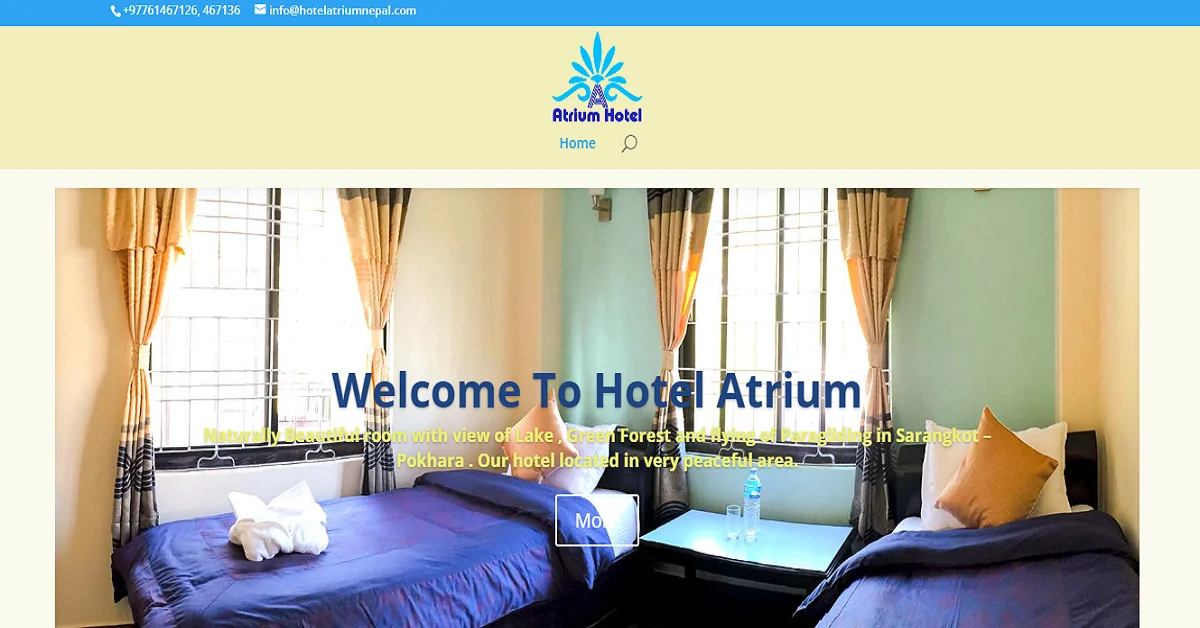
Nestled in the heart of Lakeside, Pokhara, near Fewa Lake, Hotel Atrium P. Ltd. welcomes travelers with its 14 well-appointed rooms. Each room is a sanctuary of comfort, featuring satellite LED TV, telephone, and air conditioning heating/cooling.
- Estimated Cost Per Night: Rs. 1,500 – 1,700
Tastefully decorated and furnished, the rooms ensure a delightful stay, complemented by 24-hour running hot and cold water. Experience the perfect blend of comfort, convenience, and hospitality at Hotel Atrium, where every moment is a celebration of your Pokhara adventure at a low cost.
Features
- TV
- AC
- Wifi
- Telephone
- Hot Shower
Contact Details
- Location: Uday Marg, Lakeside, Pokhara
- Contact: +97761467126
- Map: Get Direction
- Website: Hotel Atrium
Hotel Diplomat

A mere two-minute stroll from the scenic Fewa Lake, Hotel Diplomat stands as a haven of comfort in Pokhara. Each room offers a cozy retreat, equipped with free WiFi, a seating area, and a private bathroom stocked with free toiletries. The hotel’s garden and barbecue facilities provide a tranquil space to unwind, while services like ticket assistance and luggage storage ensure a hassle-free stay.
- Estimated Cost Per Night: Rs. 1,600 – 1,700
Positioned just a few kilometers from key attractions, Hotel Diplomat is a delightful choice for those who seek comfort and proximity to the beauty of Pokhara.
Features
- WiFi
- Breakfast
- Restaurant
- Free Parking
- Airport Shuttle
Contact Details
- Location: 12th street, Pokhara
- Contact: 061-455917
- Map: Get Direction
- Website: Hotel Diplomat
My Beautiful Cottage
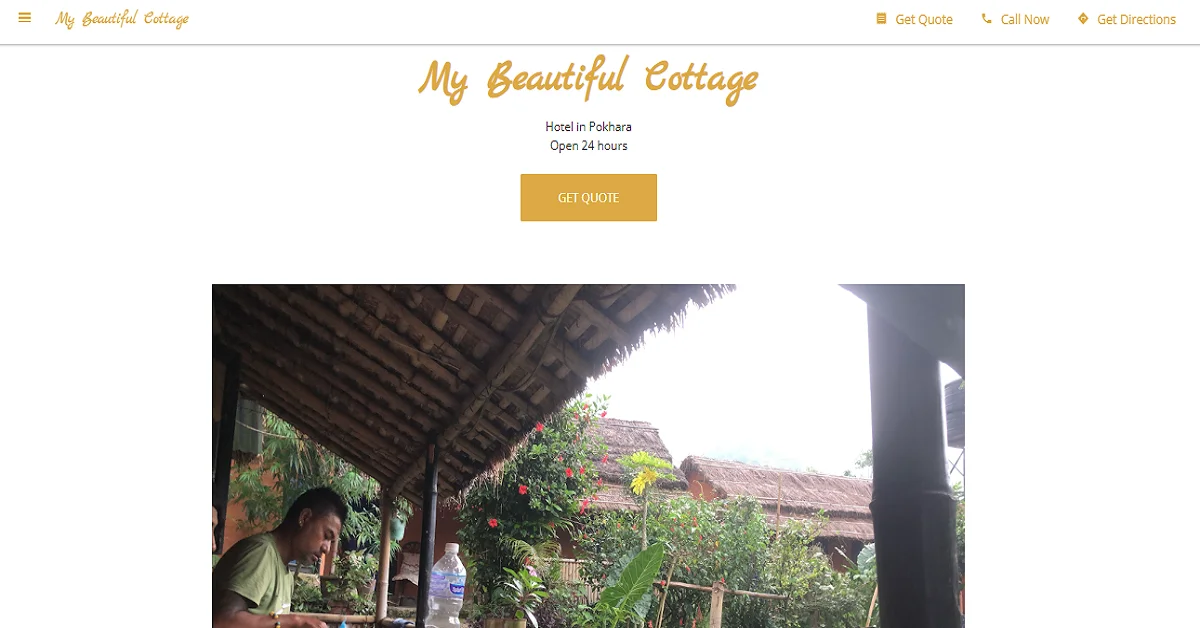
Discover serenity at My Beautiful Cottage in Pokhara, a retreat where the mesmerizing Pokhara Lakeside is just 2.5 km away. This haven has a children’s playground and offers both bicycle and car rental services for exploring the surrounding beauty.
- Estimated Cost Per Night: Rs. 900 – 1,000
The cottage invites guests to a tranquil escape with WiFi and private parking. Located near Fewa Lake and Devi’s Falls, it provides a perfect base for those seeking both relaxation and adventure in the city.
Features
- Garden
- Room service
- Airport shuttle
- No Booking Fees
- No Credit Card Needed
Contact Details
- Location: Panchase Marga, Pokhara
- Contact: 980-4187498
- Map: Get Direction
- Website: My Beautiful Cottage
Hotel Plaza Nepal
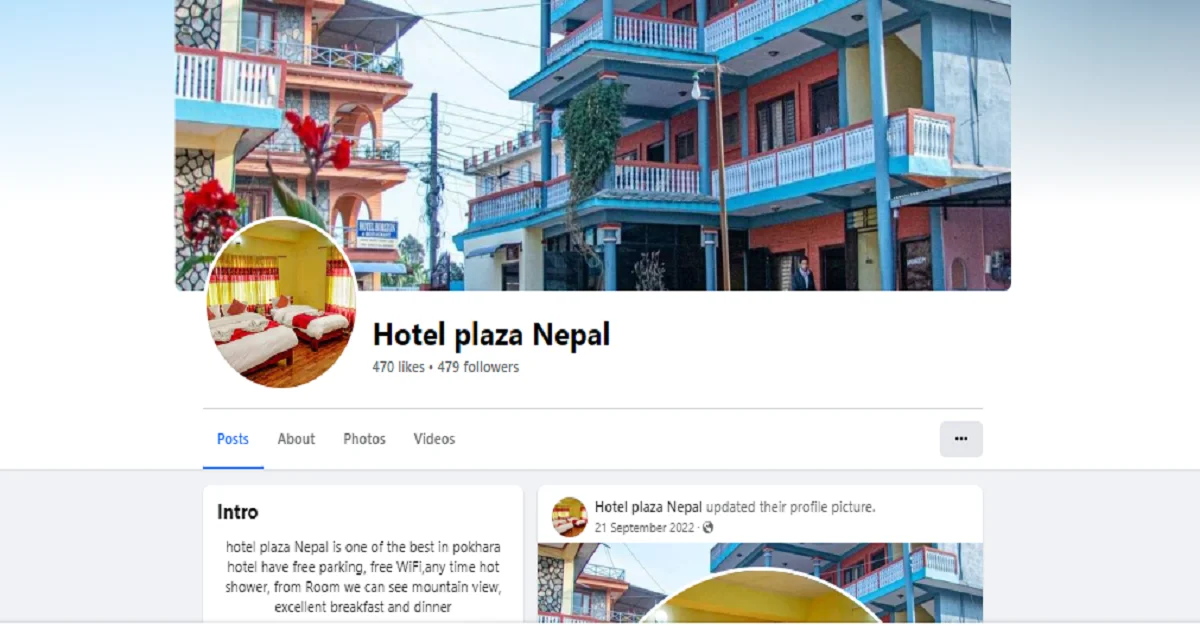
Situated less than a kilometer from Fewa Lake, Hotel Plaza Nepal welcomes guests with a blend of convenience and comfort. This 2-star hotel features a garden, free private parking, and free WiFi. Each room offers a private bathroom, ensuring a pleasant stay.
- Estimated Cost Per Night: Rs. 1,300 – 2,000
With key points of interest like Lakeside and Tal Barahi Temple nearby, Hotel Plaza Nepal is a strategic choice for those who want to explore Pokhara’s charm without compromising accessibility.
Features
- Wi-Fi
- Room service
- Great Location
- Discount Offers
- Private Bathroom
Contact Details
- Location: 7 Lakeside Road Gauri Ghat, Lakeside, Pokhara
- Contact: 984-4286724
- Map: Get Direction
- Website: Hotel Plaza Nepal
Hotel Pushkar Pokhara
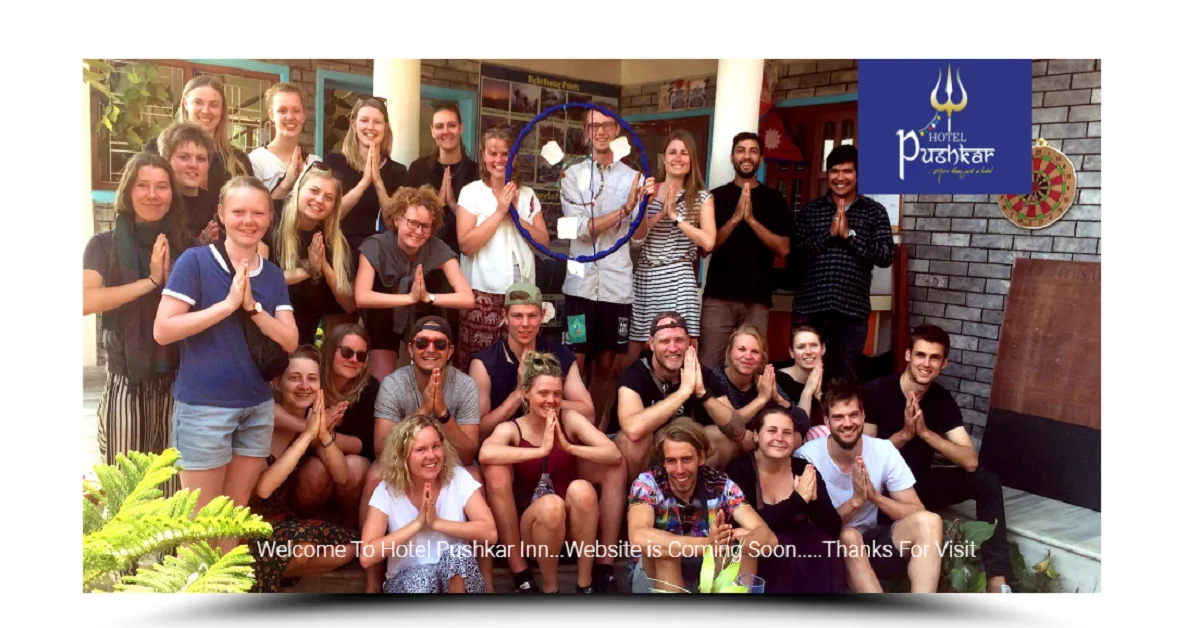
Just a 5-minute walk from Phewa Lake, Hotel Pushkar Pokhara offers a cozy retreat with a touch of simplicity. This 2-star accommodation features various units, some equipped with a refrigerator and glassware.
- Estimated Cost Per Night: Rs.2,000
Located within reach of Pokhara Disneyland, the hostel provides a comfortable stay with access to Hallan Chowk. Perfect for those desiring a budget hotel in Pokhara.
Features
- WiFi
- Safe
- Car hire
- Private balcony
- Wake-up service
Contact Details
- Location: Street No 19 Nahar Marga, Khahare, Lakeside
- Contact: 985-6066963
- Map: Get Direction
- Website: Hotel Pushkar Pokhara
Hotel Buttercup
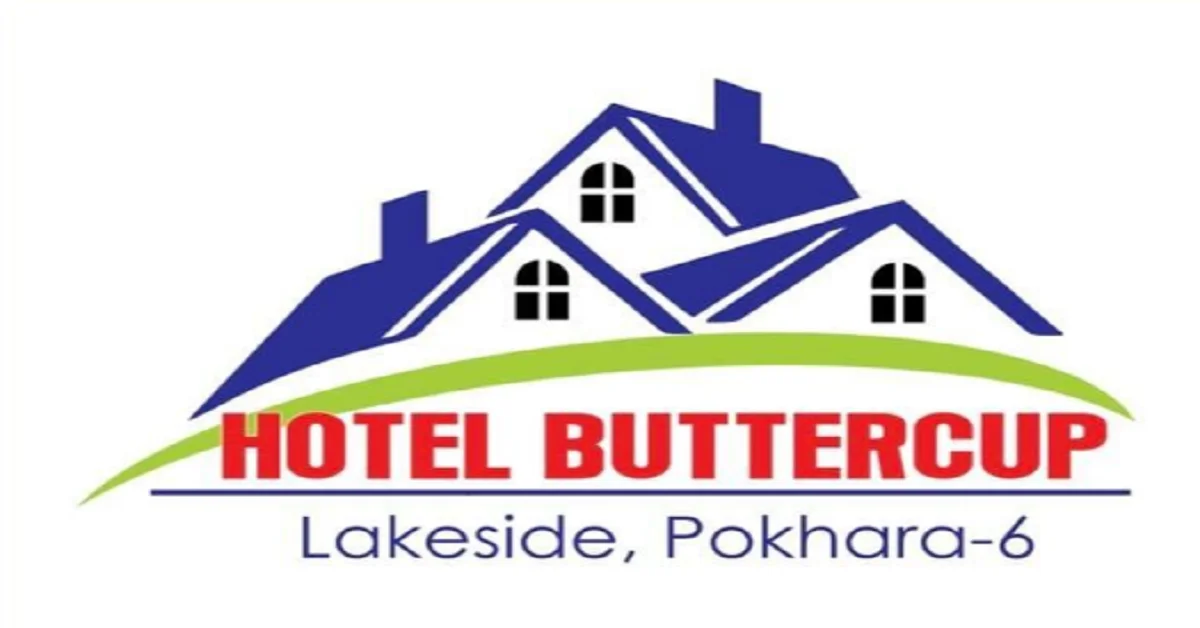
Nestled against the backdrop of the Annapurna & Machhapuchre mountains, Hotel Butter Cup presents a scenic stay in Pokhara. With a garden and an in-house restaurant, the hotel offers a peaceful retreat. Each room, adorned with a flat-screen TV, ensures a comfortable stay.
- Estimated Cost Per Night: Rs. 1,400 – 1,600
Free WiFi and private parking add to the convenience, making Hotel Butter Cup an ideal choice for those seeking comfort and breathtaking views on a budget.
Features
- Front desk
- Friendly staff
- Luggage storage
- Transport rentals
- Currency exchange
Contact Details
- Location: Sedi height Pokhara 18
- Contact: +97761466482
- Map: Get Direction
- Website: Hotel Buttercup
Into the Wild
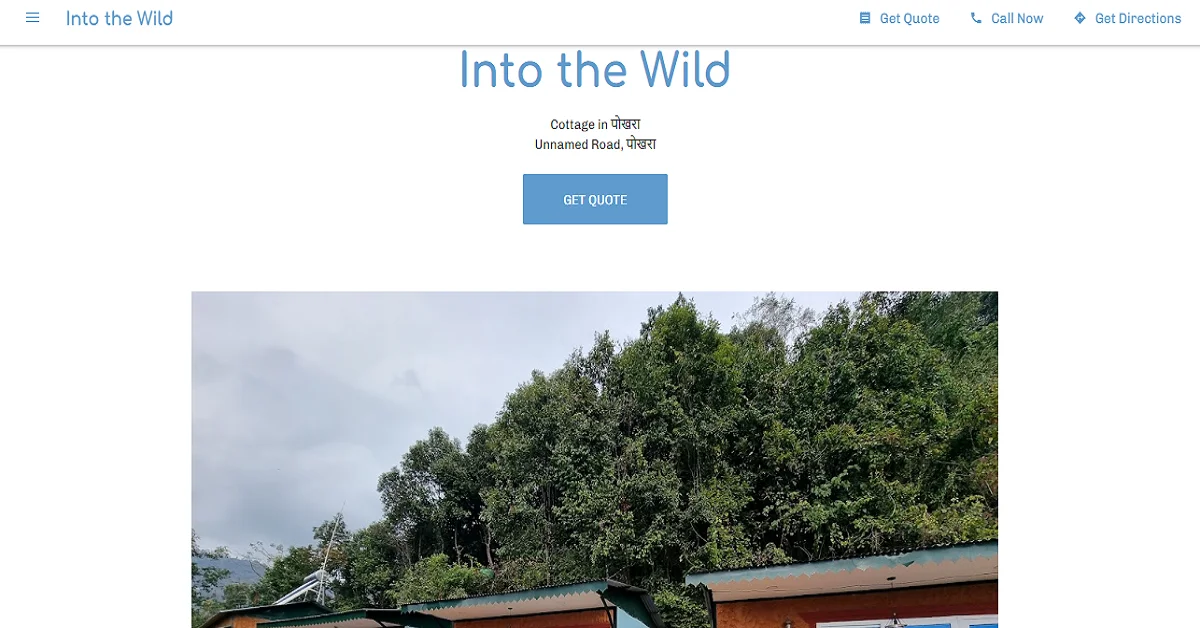
Into the Wild Pokhara, located in Kāskī, provides a unique experience for those yearning to be closer to nature. Set amidst the serene environment, private villas offer tranquility and natural springs for a rejuvenating stay.
- Estimated Cost Per Night: Rs. 1,800
With stunning views of the lake, Into the Wild Pokhara is an ideal escape for couples and those seeking a longer stay in the lap of nature.
Features
- Garden
- Good food
- Private villa
- Beautiful location
- Spring Waterfall/Pool
Contact Details
- Location: Unnamed Road, Pokhara
- Contact: 984-5260400
- Map: Get Direction
- Website: Into the Wild
October Inn
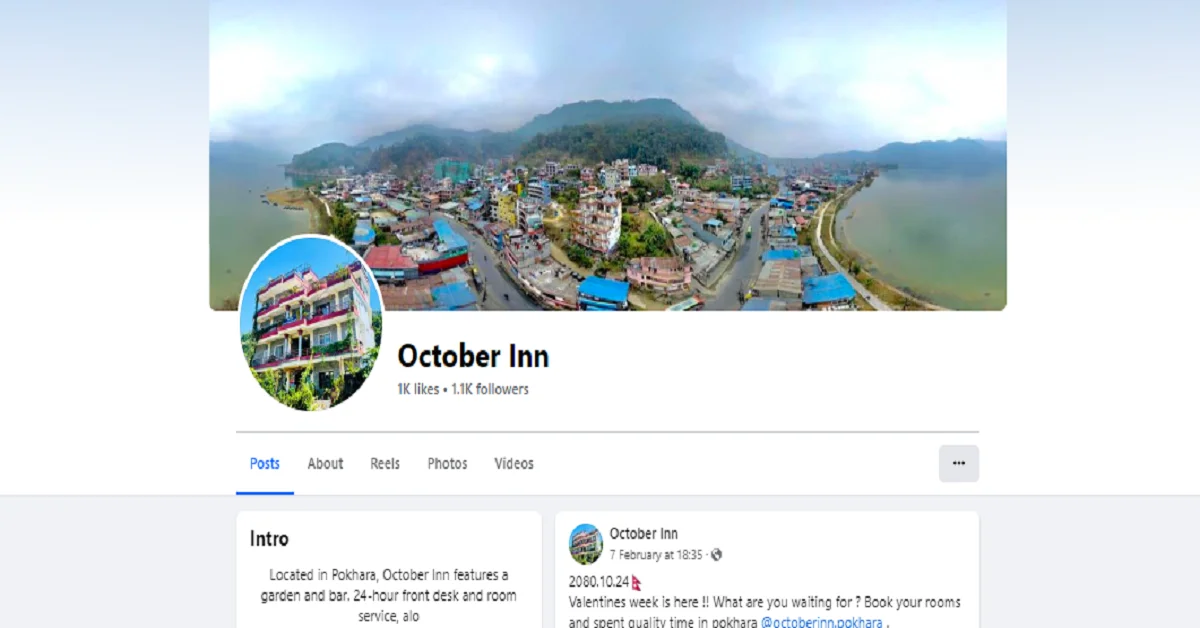
A mere 1.4 km from Pokhara Lakeside, October Inn offers a cozy retreat with a garden and terrace. With free WiFi, room service, and Asian breakfast options, the hotel caters to both comfort and culinary delights.
- Estimated Cost Per Night: Rs. 1,900
Perfect for cycling enthusiasts, bike and car hire services are available, providing a convenient base for exploring Pokhara’s charm.
Features
- Garden
- Lake View
- Organic food
- Shared lounge
- Free private parking
Contact Details
- Location: Baidam Rd, Pokhara
- Contact: 061-451992
- Map: Get Direction
- Website: October Inn
Hotel Brother Inn & Backpackers Stay
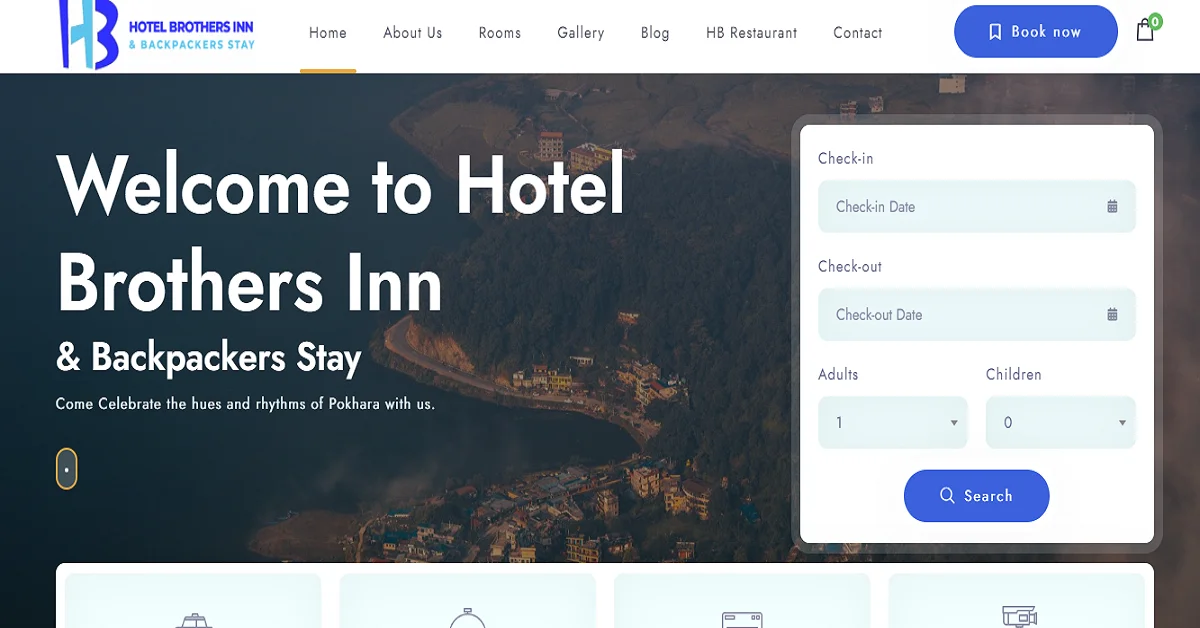
Step into a world of vibrant colors and rhythms at Hotel Brother Inn & Backpackers Stay. The delightful rooms, coupled with breathtaking views, create a harmonious blend of culture and nature.
- Estimated Cost Per Night: Rs. 2,500
Offering modern comforts and renowned for its exceptional service, this hotel invites you to celebrate the beauty and spirit of Pokhara. Hotel Brother Inn & Backpackers Stay is a place where charm and hospitality meet affordability.
Features
- Wi-Fi
- Air-condition
- 24-hrs security
- Airport transfer
- Sharing kitchen
Contact Details
- Location: Lakeside, Pokhara
- Contact: 985-6064464
- Map: Get Direction
- Website: Hotel Brother Inn & Backpackers Stay
Final Say
In the tapestry of your Pokhara journey, the thread that weaves affordability and practicality is found in the embrace of budget hotels in Pokhara. Choosing affordable hotels in Pokhara is a strategic decision, ensuring that every rupee spent contributes to the richness of your adventure.
In a city where nature’s beauty and cultural vibrancy await at every turn, these accommodations become not just places to stay but integral parts of your Pokhara experience. Whether you are a solo adventurer, a couple seeking intimacy, or part of a lively group, the practicality of these choices ensures comfort without breaking the bank. We hope this blog guides you to budget-friendly hotels empowers your journey and adds value to your travel decisions.
Thank you for taking the time to explore the world of Budget Hotels in Pokhara with us. Your adventure begins with a wise choice of accommodation, and we appreciate you joining us on this insightful journey.
FAQ’s
- Are budget-friendly hotels in Pokhara suitable for families with children?
Yes, Hotel Buttercup and Hotel Diplomat are suitable for families with children. These budget-friendly accommodations provide a comfortable and family-friendly environment for travelers with kids.
- What types of budget-friendly accommodation can I find in Pokhara?
In Pokhara, you can choose from a diverse range of budget-friendly accommodations, including hotels, guesthouses, and backpacker hostels. Consider factors such as budget, location, facilities, and services to find the perfect budget hotel for your stay in Pokhara.
- Do budget-friendly hotels in Pokhara provide help with arranging trekking and sightseeing tours?
Yes, several budget hotels in Pokhara, such as Hotel Buttercup and October Inn, offer assistance in arranging trekking and sightseeing tours. Their staff is often well-connected with local guides and tour operators to enhance your Pokhara experience.
- Is the budget-friendly hotels in Pokhara safe for solo female travelers?
Budget hotels in Pokhara are safe for solo female travelers. They can be advantageous as they provide opportunities to connect with like-minded travelers. Pokhara’s budget hotels typically have strong security systems, and the staff ensures that solo female travelers feel secure and at home during their stay.
- How much does it cost to stay at a budget-friendly hostel in Pokhara?
Budget hostels in Pokhara are known for being affordable hubs for global adventurers. However, prices vary based on the services and facilities provided by different properties. On average, you can expect prices ranging from Rs. 800 to Rs. 2,500 per night. It is advisable to check individual hostel listings for specific pricing details and inclusions.
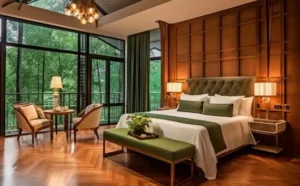
Affordable Hotels in Pokhara Lakeside for 2024
Nestled in the heart of the Himalayas, Pokhara is a stunning destination that captures the essence of natural beauty in Nepal. Surrounded by majestic mountains, including the iconic Annapurna and Machapuchare, this city is a haven for travelers seeking a tranquil escape. Pokhara is renowned for its breathtaking landscapes, vibrant culture, serene lakes, and adventure sports opportunities, making it a must-visit destination for explorers around the world.
Pokhara welcomes a diverse range of travelers, from backpackers to luxury seekers. The city’s charm lies not only in its natural beauty but also in its accessibility to travelers on various budgets. Affordable hotels in Pokhara allow visitors to allocate their budget wisely as well as provide an opportunity to immerse themselves in the local culture and activities without breaking the bank.
We have prepared a blog to guide and assist travelers in discovering affordable Hotels in Pokhara. While the city boasts a range of hotels and lodges, this blog aims to highlight those hotels that offer affordability without compromising comfort and necessary facilities. Read along if you are a solo traveler, a couple, or a family, to unlock the secrets of affordable and delightful lodging in Pokhara.
Factors to Consider When Choosing Affordable Hotels
- Proximity to Popular Attractions
When selecting an affordable hotel in Pokhara, consider its proximity to the popular attractions of Pokhara. Look for hotels near iconic sites such as Phewa Lake, Devi’s Fall, or the Peace Pagoda to ensure you can maximize your time exploring the beauty of Pokhara without spending hours on transportation. A strategically located hotel can add immeasurable value to your overall experience.
- Accessibility to Transportation
Assess the accessibility of your chosen hotel to various modes of transportation. Whether you are arriving by air, bus, or private vehicle, a conveniently located hotel with easy access to a transportation station can save you time and energy. This factor is important for those planning to take part in trekking adventures or day trips around the Pokhara region.
- Basic Amenities Provided
While focusing on affordability, it is also essential to ensure that your chosen hotel offers fundamental facilities for a comfortable stay. Look for basics such as clean and well-maintained rooms, reliable Wi-Fi, and hot water facilities. These fundamental elements contribute to a hassle-free and enjoyable lodging experience.
- Additional Perks Offered
Affordable hotels in Pokhara can go beyond the basics by providing additional services that enhance your stay. Some may offer complimentary breakfast, airport transfers, or guided tours at discounted rates. Considering these extra offerings can elevate your overall value for money and contribute to a more enriching stay.
- Importance of Online Reviews
In the digital age, online reviews serve as invaluable resources for travelers. Prioritize affordable hotels in Pokhara with positive reviews, as they often reflect the experiences of fellow travelers. Reading the reviews on various platforms provides insights into the service quality, cleanliness, and overall guest satisfaction provided by hotels.
Budget-Friendly Tips for Accommodation
By incorporating below mentioned budget-friendly tips into your accommodation search, you can make the most out of your stay in Pokhara without compromising on quality or breaking the bank.
- Off-season
One of the perks of visiting Pokhara during the off-peak season is the serenity that comes with fewer tourists. Hotels often offer more affordable rates during these times, allowing you to enjoy a peaceful stay while saving on accommodation costs.
- Negotiate Better Deals
Hotels may be more open to negotiation with lower demand during off-peak seasons. Do not hesitate to inquire about special rates, discounts, or complimentary upgrades. Dealing directly with the hotel management can often lead to additional savings.
- Explore Multiple Booking Platforms
Take advantage of the various online booking platforms available. Compare prices on websites like Booking.com, Expedia, and Agoda to find the best deals. Sometimes, exclusive discounts or promotions are offered on specific platforms.
- Group Bookings
If you are traveling with a group, ask about group booking discounts. Many hotels in Pokhara offer special rates for larger parties, making it a cost-effective option for families, friends, or organized tours.
Package Deals
Some hotels collaborate with local tour operators to offer package deals that include accommodation, activities, and transportation. Exploring these options can not only simplify your travel plans but also result in cost savings compared to booking each component separately.
Read About: 3 Star Luxury Hotels in Pokhara with Price
List of Affordable Hotels in Pokhara
Hotel Yatri
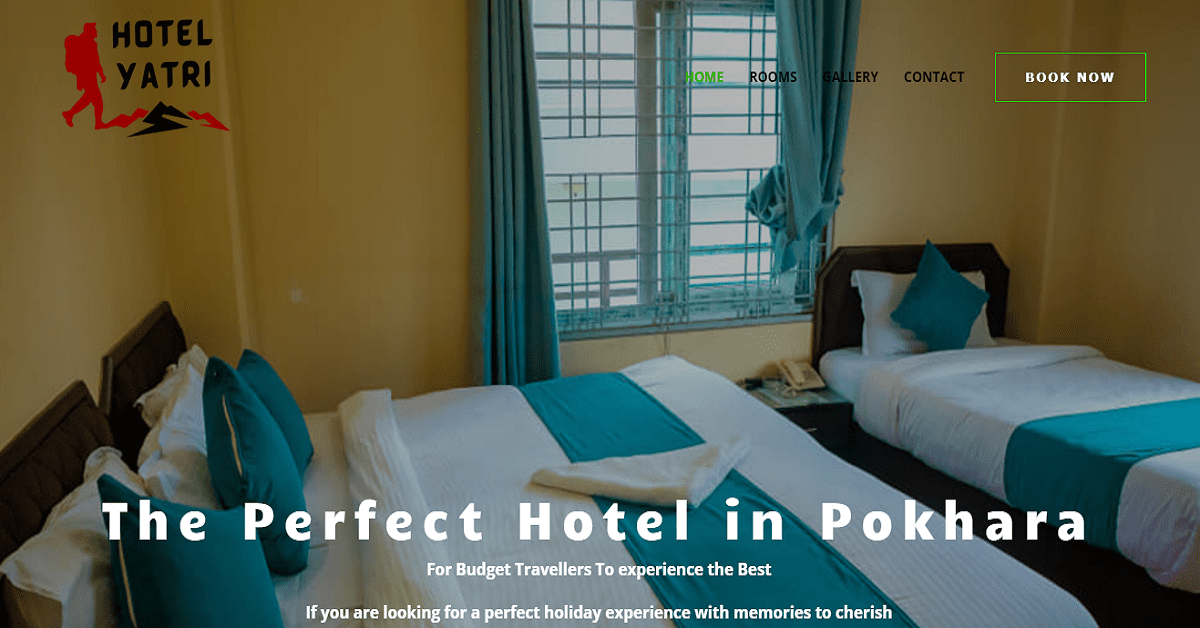
Make your holiday unforgettable by choosing Hotel Yatri, one of the best affordable hotels in Pokhara. Nestled near iconic landmarks such as Pokhara Lakeside and Fewa Lake, this sustainable guest house offers a picturesque setting for your stay.
- Estimated Cost Per Night: Rs.1,500 – 3,000
Immerse yourself in the garden’s tranquility, enjoy lake views, and take advantage of free amenities like private parking and Wi-Fi. With a commitment to sustainability, Hotel Yatri provides an outdoor fireplace, a 24-hour front desk, and air-conditioned units. Make your Pokhara experience both memorable and affordable at Hotel Yatri.
Features
- Breakfast
- Lake view
- Restaurant
- Room Service
- Airport Shuttle
Contact Details
- Location: Lakeside Rd, Pokhara
- Contact: 986-5110646
- Map: Get Direction
- Website: Hotel Yatri
Happy Days Inn
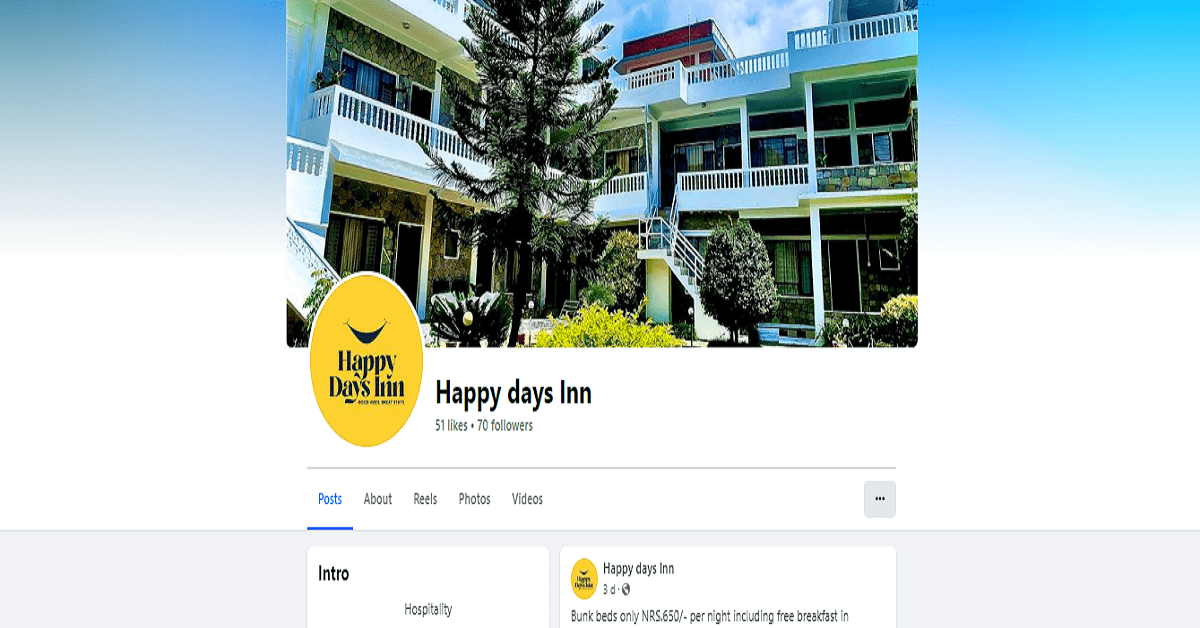
For those seeking an affordable retreat in Pokhara, Happy Days Inn is the perfect choice. Situated less than a kilometer from Fewa Lake, this cozy accommodation option offers a garden, free private parking, and a shared kitchen.
- Estimated Cost Per Night: Rs. 1,500 – 2,500
With a focus on guest convenience, the hostel provides free WiFi, and some rooms even feature balconies for added charm. Enjoy a tranquil stay at Happy Days Inn, where affordability meets comfort.
Features
- WiFi
- Good Food
- Friendly Staff
- Calm Atmosphere
- Excellent Location
Contact Details
- Location: Lakeside, Pokhara, Nepal
- Contact: 061-455073
- Map: Get Direction
- Website: Happy Days Inn
Pokhara Tourist Home
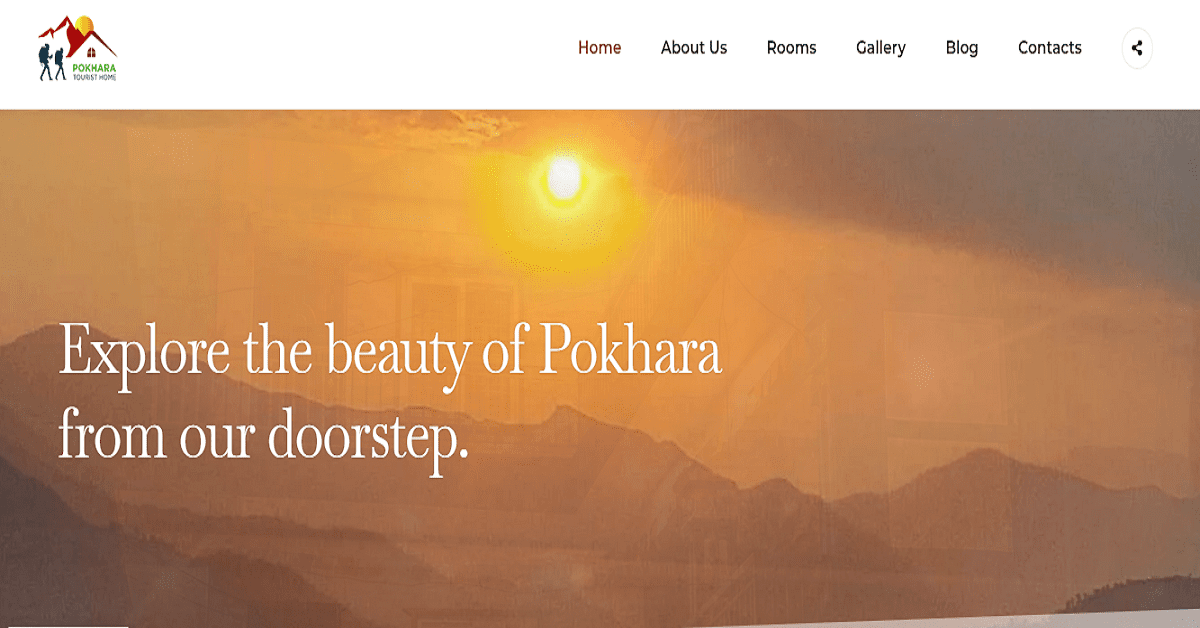
Managed by a local family, Pokhara Tourist Home defines exceptional hospitality near Phewa Lake and the World Peace Pagoda. Offering unparalleled views, this hotel has easy access to Lakeside and Pokhara’s major attractions.
- Estimated Cost Per Night: Rs.2,500- Rs.3,000
Accommodations include rooms with balconies showcasing lake views, private bathrooms, and city views. The hotel’s commitment to top-notch service extends to amenities like a garden, free private parking, and a 24-hour front desk.
Features
- Restaurant
- Free Parking
- Room service
- Breakfast in Bed
- Phewa Lake View
Contact Details
- Location: Street 24, Khahare, Lakeside Road 06, Pokhara
- Contact: 984-8256623
- Map: Get Direction
- Website: Pokhara Tourist Home
Hotel Eagle Zone
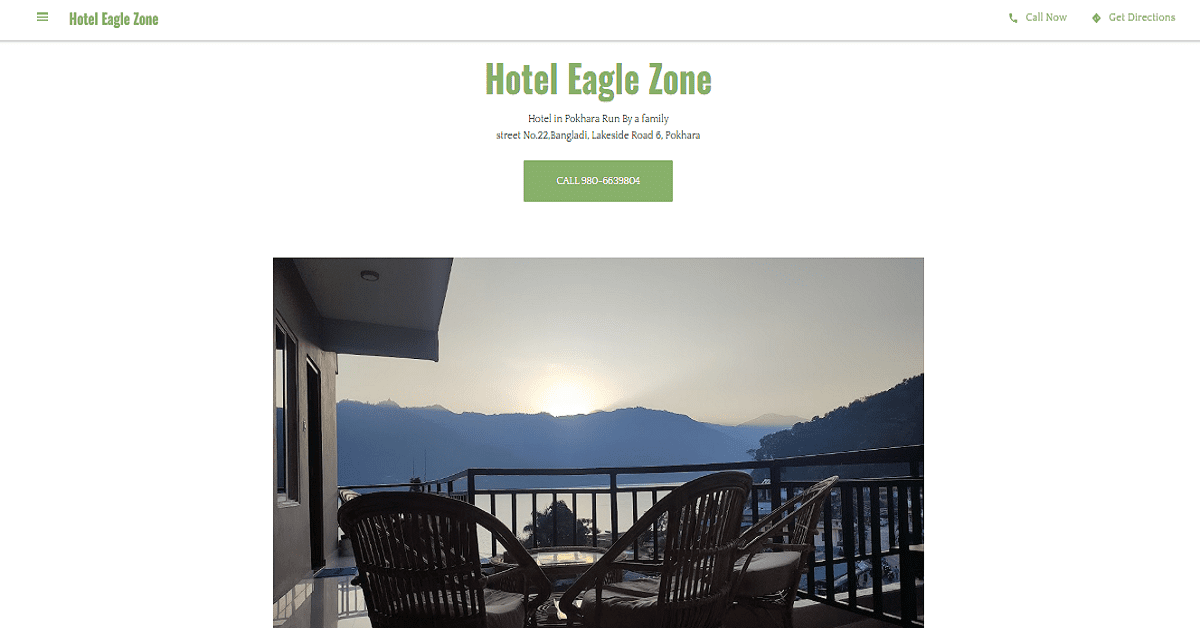
For a budget-friendly escape with a touch of family warmth, Hotel Eagle Zone is just for you. A family-run hotel, Eagle Zone boasts clean rooms, comfortable beds, and blankets to keep you cozy.
- Estimated Cost Per Night: Rs.1,500 – 2,000
This hotel provides stunning views of Fewa Lake and offers simplicity and charm. If you seek affordability a genuine homely atmosphere and a great view, Hotel Eagle Zone should be your ideal choice.
Features
- Kid- Friendly
- Airport Shuttle
- Baggage Storage
- 24-hour Front Desk
- Peaceful Environment
Contact Details
- Location: Street No.22, Bangladi, Lakeside Road 6
- Contact: 980-6639804
- Map: Get Direction
- Website: Hotel Eagle Zone
Hotel Noble Inn
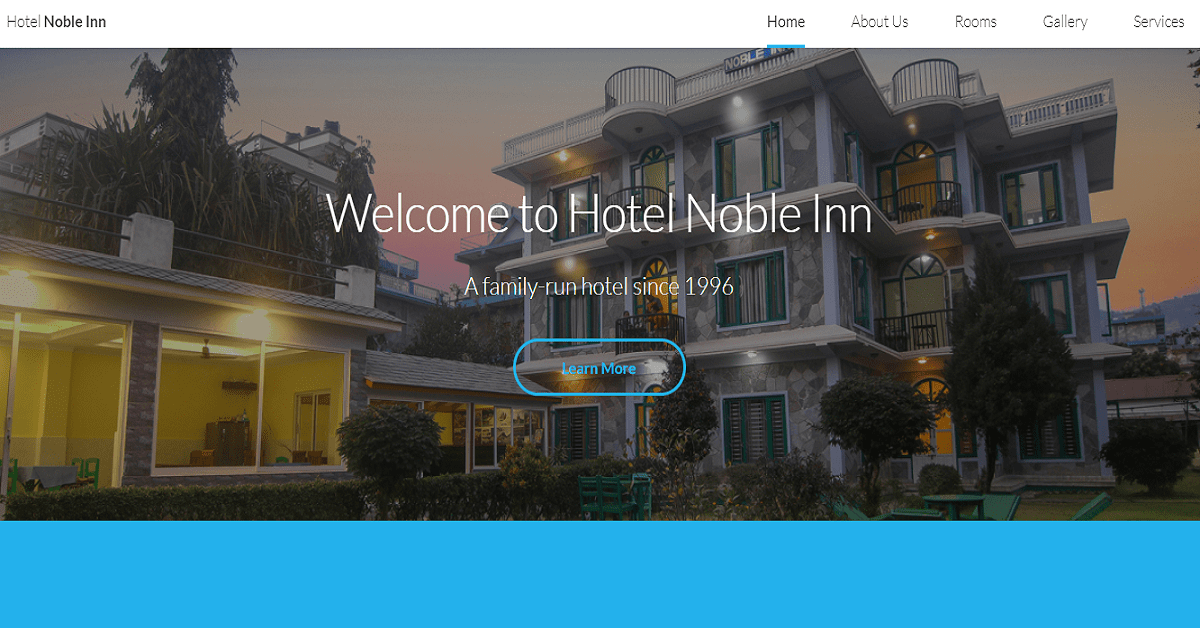
Noble Inn, a family-run hotel for over 25 years, welcomes you with warm hospitality and luxurious amenities. Perfectly situated near Phewa Lake and Lakeside, Noble Inn is an oasis of calm and charm. Offering a blend of lively ambiance, peaceful serenity, and hearty breakfasts, this destination hotel is the epitome of a memorable stay.
- Estimated Cost Per Night: Rs. 1,500 – 2,000
With a commitment to affordability, Noble Inn stands out as a family and child-friendly hotel, ensuring a secure and welcoming environment. Make your stay in Pokhara extraordinary at Noble Inn, where family values meet international standards.
Features
- Garden
- Restaurant
- Free Parking
- Family Rooms
- Free Airport Shuttle
Contact Details
- Location: 14th Street, Pokhara
- Contact: 061-454926
- Map: Get Direction
- Website: Hotel Noble Inn
Hotel Mayur
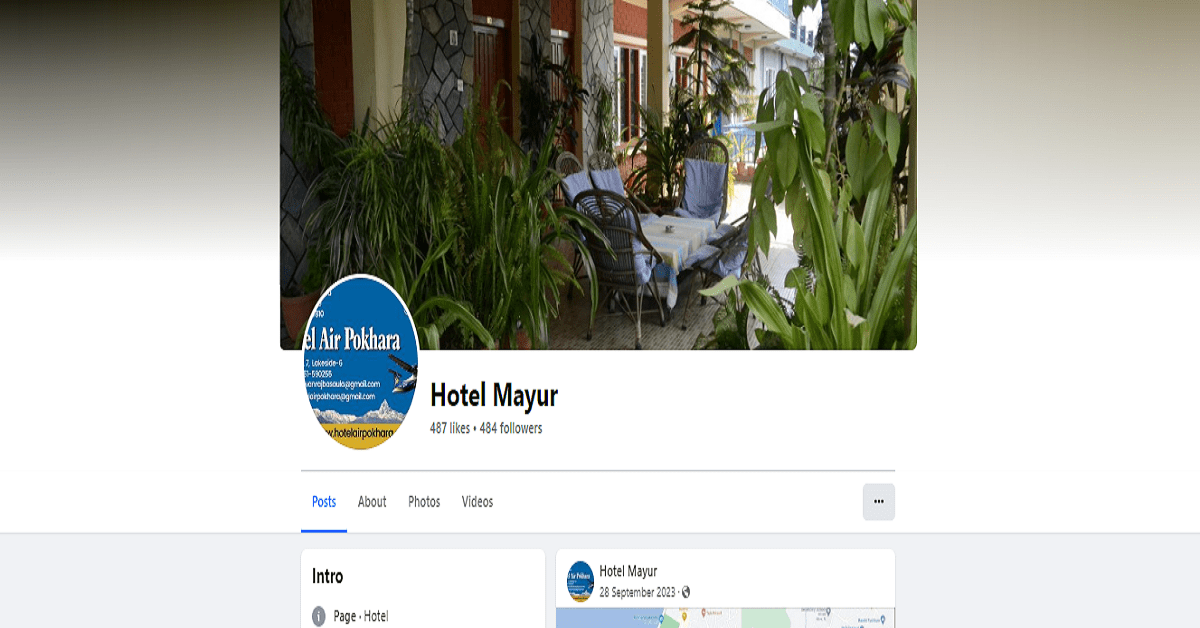
Just 3.5 km from Pokhara Lakeside, Hotel Mayur offers convenient accommodation with a garden, restaurant, and shared kitchen. Each unit is thoughtfully equipped with a terrace boasting garden views, a well-fitted kitchen, and a private bathroom. Enjoy free WiFi and parking during your stay.
- Estimated Cost Per Night: Rs. 18,00 – 2,000
Hotel Mayur is your gateway to comfort and affordability, with the added convenience of bicycle and car rental services. Whether you are exploring Fewa Lake or Devi’s Falls, this aparthotel ensures a seamless and budget-friendly experience in Pokhara.
Features
- Wi-Fi
- Restaurant
- Free Parking
- Shared Kitchen
- Great Hospitality
Contact Details
- Location: 6X55+R6G, Pokhara, Nepal
- Contact: 981-4139298
- Map: Get Direction
- Website: Hotel Mayur
Nepali Cottage Guest House
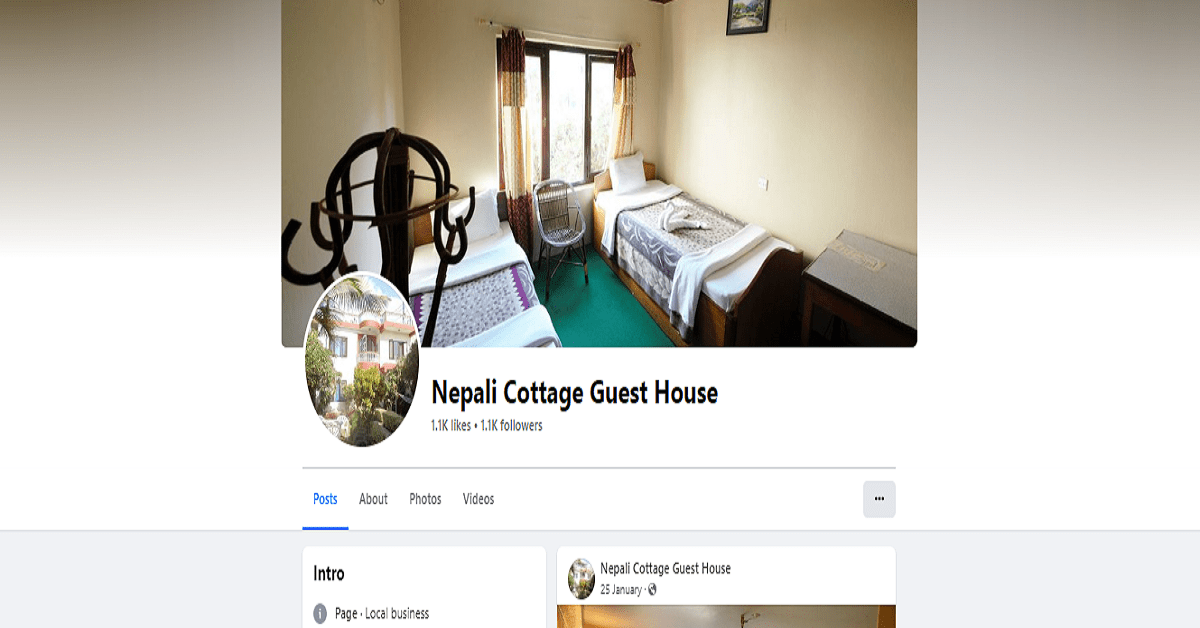
Nepali Cottage Guest House invites you to a sustainable retreat, providing free bikes and a garden oasis. Located just 500 meters from Pokhara Lakeside, this guest house offers a patio and comfortable accommodations. Enjoy free WiFi, room service, and currency exchange services.
- Estimated Cost Per Night: Rs. 1,400
This family-friendly restaurant serves dinner, lunch, brunch, and high tea, making it a convenient choice for guests. Explore nearby attractions like Tal Barahi Temple and Baidam Temple, and unwind near the outdoor fireplace after cycling. Experience affordability and tranquility at Nepali Cottage Guest House.
Features
- Wi-Fi
- Patio
- Helpful Staff
- Outdoor Fireplace
- Currency Exchange
Contact Details
- Location: Pahari Marga, Lake Side Pokhara-6
- Contact: 985-6031094
- Map: Get Direction
- Website: Nepali Cottage Guest House
Final Say
In the heart of the Himalayas lies Pokhara, a city that captivates tourists with its natural beauty and cultural richness. As we conclude our exploration of affordable hotels in Pokhara, it becomes evident that a budget-friendly stay in the city means something other than compromising on quality or experience. The diverse array of accommodations offers affordable yet memorable stays in Pokhara.
In conclusion, our exploration of affordable hotels in Pokhara is a testament to diverse and budget-friendly options for every traveler. Hopefully, you discover the perfect blend of affordability and quality in Pokhara, where every budget traveler finds a home away from home.
FAQ’s
- Name some cheap hotels in Pokhara near Lakeside.
Nepali Cottage Guest House, Hotel Mayur, Hotel Noble Inn, and Hotel Yatri are excellent budget-friendly options situated near the Lakeside area of Pokhara.
- What is the average cost for cheap hotels in Pokhara?
On average, the cost for cheap hotels in Pokhara ranges from Rs. 1,000 to Rs. 3,500, making it a budget-friendly choice for various travelers.
- Can I find affordable hotels in Pokhara with stunning views?
Yes! Happy Days Inn and Pokhara Tourist Home are among the affordable hotels that offer breathtaking views lake views, allowing you to soak in the beauty of the lakeside surroundings.
- Do these affordable hotels provide amenities such as Wi-Fi and parking?
Yes, most affordable hotels in Pokhara offer essential amenities like free Wi-Fi and parking to ensure a comfortable and convenient stay for guests.
- Are there family-friendly options among the affordable hotels?
Yes! Hotel Eagle Zone and Hotel Noble Inn are family-friendly, offering a welcoming atmosphere and secure environments for families traveling on a budget.
- How can I book these affordable hotels in Pokhara?
Booking can be done easily through various online platforms such as Booking.com, Expedia, or the hotel’s official website.

Backpacker Hostels in Pokhara: Affordable Accommodations Option
Pokhara is a paradise for nature enthusiasts and adventure seekers with its serene lakes, majestic mountains, and vibrant cultural tapestry. For adventurers with a zeal for exploration on a budget, there is a range of backpacker hostels in Pokhara, each having its unique charm and offering a gateway to the authentic essence of enchanting affordable accommodation options.
In this blog, we embark on a journey through different backpacker hostels in Pokhara, catering to backpackers in search of more than just a place to rest their weary heads. The Backpackers Hostel experience serves as a portal into the beating heart of this Himalayan gem, where affordability converges with community, and cultural exchange seamlessly integrates into the Pokhara journey.
Introduction
Pokhara, renowned for its natural beauty and the potential for various adventurous activities, has become the chosen destination for tourists seeking to immerse themselves in the heart of this beautiful valley. Let’s delve deeper into the possibilities of affordable accommodation options in Pokhara. Whether you are into adventurous activities, seeking like-minded travelers, or are on a budget, this blog is just for you. Welcome to our blog on Backpackers Hostel in Pokhara to discover a budget-friendly, culturally rich, and adventurous accommodation choice.
Why visit Pokhara?
As we embark on our Pokhara adventure, the city unfolds its captivating charm, leaving an unforgettable mark on the memory of every tourist.
- Scenic Beauty and Natural Attractions:
Nestled by the Annapurna mountain range, Pokhara showcases breathtaking natural wonders. Phewa Lake, a tranquil lake reflecting surrounding peaks, sets the stage for serenity. With each evening, the sun dips behind mountains, painting the sky with breathtaking hues.
Furthermore, discover cascading waterfalls like the ethereal Devi’s Fall, where water dances to its melody. The lush greenery of the World Peace Pagoda and the spiritual allure of the Gupteshwor Cave add layers to the charm of Pokhara.
- Cultural and Adventure Activities:
Beyond natural beauty, Pokhara invites exploration of its rich culture and adventurous spirit. Bustling markets of Lakeside and diverse eateries beckon exploration. The Old Bazaar reflects history in its narrow ways, while the Bindhyabasini Temple reflects the spiritual resonance.
For adrenaline seekers, Pokhara offers a variety of activities. Such as paragliding from the Sarangkot viewpoint offers an unparalleled aerial perspective, while trekking trails like the Annapurna Circuit promise an immersive journey through Himalayan landscapes.
- Is Pokhara suitable for backpackers?
The beauty of Pokhara lies not just in landscapes but also in the genuine warmth of its people. The calm atmosphere of the city forms an ideal location for backpackers seeking an authentic experience. Whether unwinding by the lakeside, savoring local delicacies, or sharing stories with fellow travelers, Pokhara weaves a charm that makes every moment memorable.
What is a Backpacker Hostel?
A backpacker hostel is a budget-friendly accommodation option designed for travelers. The hostels usually feature shared dormitory-style rooms that promote a social atmosphere among guests. These hostels prioritize affordability and often provide communal spaces for socializing, making them a hub for like-minded individuals seeking budget-conscious lodging and a unique travel experience. Backpacker hostels attract a diverse array of travelers, ranging from solo adventurers and digital nomads to students on gap years and those looking forward to cultural immersion in a foreign land. The main feature of the backpacker hostel is that it is a hub for travelers seeking an authentic travel experience. Therefore, these hostels are lively and foster an atmosphere where cultural exchange and making new friends are easy.
The Backpacker’s Experience
Now that we know about the charm of Pokhara, let’s look into our adventure, the Backpacker’s Experience. In a world where travel is often synonymous with luxury, backpacking offers a unique and enriching perspective, especially with the welcoming atmosphere of backpacker hostels in Pokhara.
- Advantages of Staying in a Backpacker Hostel:
The decision to stay in a backpackers hostel in Pokhara is merely about saving a few bucks, it is a conscious choice to immerse yourself in an atmosphere filled with fellow travelers. These hostels go beyond providing affordable accommodation, they cultivate a community of like-minded individuals sharing stories, tips, and the sheer joy of exploration. These hostels are the vibrant hubs of cultural exchange, creating an environment where strangers become travel companions.
- Sense of Community and Cultural Exchange:
One of the most rewarding aspects of the backpacker’s experience is the genuine sense of community that flourishes within hostel walls. Whether gathered around a bonfire swapping tales or collaborating on spontaneous adventures, the friendships in these spaces often transcend borders.
- Cost-Effective Accommodation Options:
Let’s now address the elephant in the room: the budget. Backpackers hostels in Pokhara not only provide an affordable roof over your head but also open doors to a network of fellow budget-conscious explorers. Shared dorms and communal spaces make these accommodations light on the wallet, allowing you to distribute funds where they matter most, experiences. The money saved on accommodation can be transformed into unforgettable activities, whether it is paragliding over the Pokhara Valley or savoring the local delicacies in Lakeside.
As you consider your accommodation choice in Pokhara, consider more than just a place to sleep. The Backpacker’s Experience is a dynamic immersion into the heart of travel where affordability meets community, and every stay is a chapter in the epic tale of exploration. So, gear up for a journey beyond the conventional, where the true magic lies in the connections made and the stories shared within the walls of a backpackers hostel.
Tips for Choosing the Right Hostel
Selecting the perfect backpacker hostels in Pokhara is similar to finding the key to a treasure trove of memorable experiences. As you navigate the diverse options, consider these active and practical tips to ensure your stay aligns seamlessly with your travel aspirations.
- Consideration of Personal Preferences and Location:
Start your quest by identifying what matters most to you. Are you someone who thrives in a social atmosphere, or do you prefer a quieter space for introspection? Check if the hostel aligns with your preferred vibe. Whether it is a lakeside view, proximity to adventure activities, or a more laid-back ambiance, prioritize hostels that resonate with your travel style.
- Budget-Friendly Options:
Budgets are the backbone of backpacking adventures, and your choice of accommodation can significantly impact your overall spending. Look for hostels that strike the right balance between affordability and value. Explore the facilities they offer Wi-Fi, communal kitchens, or organized activities making them align with your needs without breaking the bank.
- Reading Reviews and Doing Research:
In the digital age, the wisdom of fellow travelers is just a click away. Before finalizing your booking, look into online reviews and testimonials. Platforms like TripAdvisor or bookin.com provide valuable insights into the actual experiences of previous guests. Pay attention to comments about cleanliness, staff friendliness, and the overall atmosphere to make an informed decision.
List of Backpacker Hostels in Pokhara
-
Pokhara Backpackers Hostel
Contact: 980-3003030
Map: Get Direction
Website: Pokhara Backpackers Hostel
Location: 5th Ammat Street Lakeside 06
Situated just 1.1 km from Fewa Lake, Pokhara Backpackers Hostel offers a blend of convenience and comfort. With free private parking, a shared lounge, and a terrace, this hostel provides a vibrant atmosphere. The rooms, equipped with private bathrooms and free WiFi, ensure a pleasant stay. Guests can enjoy continental, American, or Asian breakfast options, and the location of the hostel is close to major attractions like Pokhara Lakeside and Tal Barahi Temple.
Features of Pokhara Backpackers Hostel
- Bar
- Wi-Fi
- Travel Desk
- Exercise Area
- 24 hrs security
- Free Breakfast
-
Kiwi Backpackers Hostel
Contact:980-4158455
Map: Get Direction
Website: Kiwi Backpackers Hostel
Location: 7 Kiwi Ln, 5th Street Ammat, Lakeside
Kiwi Backpackers Hostel stands out as the best workstation hostel in Nepal, featuring high-speed internet. Located at the south end of Lakeside, the hostel offers superior Himalayan views and proximity to various amenities. With dormitories, private rooms, and a range of facilities such as a rooftop hammock area, a movie room, and a 5 O’clock Happy Hour bar, Kiwi creates a lively and engaging atmosphere.
Features of Kiwi Backpackers Hostel
- Wi-Fi
- Barbecue
- Free Breakfast
- Meeting Rooms
- Security Lockers
- Luggage Storage
-
Zostel
Contact: 986-9273860
Map: Get Direction
Website: Zostel
Location: Pokhara 18, Sedi Bagar, Lakeside
Overlooking Phewa Lake, Zostel Pokhara invites backpackers to a delightful stay with scenic spaces and good food. With a 5-minute drive from the main street of Pokhara, the hostel provides easy access to paragliding, biking trails, and nature hikes. The vibrant ambiance, coupled with a lakeside cafe and rooftop area, adds to the overall charm, making it a hub for adventure seekers.
Features of Zostel
- Cafe
- Hot water
- Free Wi-Fi
- Laundry Services
- In-house Activities
- Card Payment Accepted
-
Gypsy Hostel
Contact: 061-590526
Map: Get Direction
Website: Gypsy Hostel
Location: Khahare, Street No 23, Lakeside
Gypsy Hostel & Backpackers, located 1.5 km from Pokhara Lakeside, offers comfort and entertainment. The property features a garden, free private parking, a shared lounge, and a terrace. With a restaurant and bar, the hostel ensures a pleasant stay with room service and a 24-hour front desk. The availability of billiards, a children’s playground, and proximity to various attractions make this hostel a versatile choice.
Features of Gypsy Hostel
- Bar
- Restaurant
- Family rooms
- Room service
- Airport shuttle
- Dormitory Room
-
Gaurishankar Backpacker’s Hostel
Contact: 061-462422
Map: Get Direction
Website: Gaurishankar Backpacker’s Hostel
Location: Durbar Marg, Pokhara
Nestled among lush greenery, the Gaurishankar Backpackers Hostel offers a tranquil retreat. With a garden, shared lounge, and a terrace, this hostel provides a range of rooms with different views. The accommodation includes free WiFi, a restaurant with diverse cuisine options, and activities like table tennis and darts. The location of the hostel with proximity to Fewa Lake and other attractions, adds to its appeal.
Features of Gaurishankar Backpacker Hostel
- BBQ
- Book exchange
- Air Conditioning
- Hot/Cold Shower
- 24-hour security
- Tranquil Environment
-
Pokhara Youth Hostel
Contact: 980-3885084
Map: Get Direction
Website: Pokhara Youth Hostel
Location: Hallan Chowk-6, Lakeside
Pokhara Youth Hostel is located just 50 meters from Fewa Lake and offers a scenic and mountainous retreat. With a barbecue area, free WiFi, and free private parking, the hostel caters to various interests such as cycling, fishing, and hiking. The 24-hour front desk ensures convenience, making it an ideal choice for those seeking a blend of nature and adventure.
Features of Pokhara Youth Hostel
- Free Parking
- Postal Service
- Outdoor Terrace
- Safe Deposit Box
- Accessible Location
- Express Check-in/out
-
Dharma Backpackers
Contact: 982-4138600
Map: Get Direction
Website: Dharma Backpackers
Location: Street No 5 Lakeside
Dharma Backpackers, situated 1.1 km from Fewa Lake, provides a serene escape with its garden, terrace, and restaurant. The hostel’s bar and proximity to attractions like Pokhara Lakeside make it a well-rounded choice for travelers. With room service and an Asian breakfast offered, guests can enjoy a comfortable stay with easy access to the beauty of Pokhara.
Features of Dharma Backpackers
- Affordable
- Mountain View
- Free Breakfast
- Book exchange
- Airport Transfers
- Safe Deposit Box
-
Hostel The Good Earth Pvt. Ltd.
Contact: 061-590066
Map: Get Direction
Website: Hostel The Good Earth Pvt. Ltd.
Location: Devisthan Path, Street No 16B, Lakeside, Pokhara
The Good Earth Pvt. Ltd. offers a centrally located accommodation option, just 400 meters from Pokhara Lakeside. The hostel provides a comfortable and convenient stay with a garden, private parking, and a terrace. The availability of bike and car rentals, along with proximity to attractions like Fewa Lake and Tal Barahi Temple, makes it an appealing choice for exploring Pokhara.
Features of Hostel The Good Earth Pvt. Ltd.
- Wi-Fi
- Terrace
- Lockers
- Lake view
- Airport shuttle
- Board Games
Final Say
In bidding farewell to our exploration of “Backpacker Hostels in Pokhara,” we find ourselves at the intersection of affordability, community, and cultural immersion. As we have explored the scenic beauty and adventure-packed avenues of Pokhara, the backpacker’s experience emerges as a vibrant chapter in this Himalayan haven.
With its serene lakes, majestic mountains, and rich cultural tapestry, Pokhara draws nature enthusiasts and adventure seekers with a zest for exploration on a budget. The array of backpacker hostels in this enchanting city offers more than just a place to rest, they serve as gateways to Pokhara, an essence where affordability converges seamlessly with community spirit.
So, as you embark on your adventure, consider the listed backpacker hostels in Pokhara, each offering a unique experience within the tapestry of this Himalayan gem. From Pokhara Backpackers Hostel to Gaurishankar Backpacker’s Hostel, the choices are diverse, each promising not just a place to stay but an integral part of your Pokhara exploration.
In conclusion, the Backpacker Hostels in Pokhara are more than budget-friendly accommodations, they are the gateways to a culturally rich, community-driven adventure. As you plan your journey, may your choice of hostel be as memorable as the experiences awaiting you in the heart of Pokhara!
FAQ’s
- What makes backpacker hostels in Pokhara different from hotels?
Backpacker hostels in Pokhara offer a unique communal experience with shared dormitory-style accommodations, creating a vibrant atmosphere that makes social interaction easy. Unlike traditional hotels, these hostels prioritize affordability and are best for budget-conscious travelers.
- Are backpacker hostels suitable for solo travelers?
Yes! Backpacker hostels in Pokhara are ideal for solo travelers. The communal nature of these accommodations provides an excellent opportunity to meet like-minded individuals, share travel stories, and possibly find companions for exploring the beautiful Pokhara.
- What facilities can I expect in a backpacker hostel?
Most backpacker hostels offer basic amenities such as shared dormitory-style rooms, communal kitchens, common areas for socializing, and often organized activities. While the facilities may vary, the focus is on providing a budget-friendly and socially engaging experience.
- How do I ensure the safety of my belongings in a shared dormitory?
Backpacker hostels usually provide lockers for securing your valuable belongings. Additionally, many hostels have 24-hour front desk services and practice security measures to ensure a safe and enjoyable stay.
- Can I book a private room in a backpacker hostel in Pokhara?
While the primary offering is shared dormitory-style rooms, some backpacker hostels in Pokhara provide private room options for their customers. You can check with the specific hostel in advance to confirm availability and pricing for private accommodations.
- Are backpacker hostels in Pokhara family-friendly?
Backpacker hostels are generally more inclined towards solo travelers and small groups, but some of the hostels welcome families as well. It is recommended to check with the specific hostel about their policies regarding children, pets, and family accommodations before making a reservation.

10 Best 3-Star Luxury Hotels in Pokhara [Price & Location]
Nestled in the lap of the majestic Himalayas, Pokhara stands as a jewel of the tourism industry of Nepal. The valley captivates travelers with breathtaking landscapes, serene lakes, and panoramic views of the Annapurna mountain range. Pokhara, known for its vibrant culture, friendly locals, and the backdrop of the Annapurna and Machapuchare peaks, is a must-visit destination among tourists visiting Nepal.
Pokhara is famous for many reasons, from adventure activities like trekking and paragliding to tranquil boat rides on Phewa Lake. The vibrant culture, friendly locals, and the view of the Annapurna and Machapuchare peaks of the city create an enchanting atmosphere that fascinates visitors.
Why You Must Choose 3-Star Luxury Hotels in Pokhara?
While the valley offers a range of accommodation options, choosing luxury hotels in Pokhara for your stay elevates the entire travel experience. A luxury hotel is not just a place to spend a night, it is a destination in itself, combining extravagance and comfort seamlessly. Opting for a luxury hotel in Pokhara adds an extra layer of richness to your journey, turning it into a memorable and poise retreat.
3-Star Luxury hotels in Pokhara go beyond being places to sleep, they are gateways to exclusive experiences. These establishments offer lavish accommodations along with various amenities and services that cater to the tastes of guests. These hotels also provide the dining experience, and spa retreats rejuvenating the mind and body – luxury hotels in Pokhara are designed to provide a holistic and unforgettable escape.
Beyond luxury, these hotels often boast strategic locations that maximize the natural beauty of Pokhara. Guests wake up to the sight of sunrise over the Himalayas from their private balconies and can unwind in a relaxing spa in a quiet atmosphere. These are the experiences that set luxury hotels apart.
This blog will explore the top 3-star luxury hotels in Pokhara, diving into the unique features of each establishment. Join us on a journey where comfort meets extravagance, and the hospitality of these finest hotels complements the beauty of Pokhara.
Things to Consider while Choosing 3-Star Luxury Hotels in Pokhara
Choosing the perfect 3-star luxury hotels in Pokhara becomes a key decision that shapes your overall travel experience. Consider the following crucial factors when selecting the ideal accommodation for you:
1. Location: Proximity to the Key Attractions
Measure the hotel’s closeness to attractions like Phewa Lake, Sarangkot, and the World Peace Pagoda. Furthermore, choose a location with access to transportation to guarantee smooth travel to and from the hotel.
2. Amenities: Assessing the Range and Quality
Find out the amenities and the hotel’s quality of facilities. To ensure a lavish stay, 3-star luxury hotels in Pokhara should boast a well-equipped spa, fitness center, swimming pool, and other recreational options.
3. Reviews and Testimonials: Insights from Previous Guests
Gain insights from previous guests by reading reviews and testimonials. Platforms like TripAdvisor and hotel booking websites offer valuable insights into the strengths and weaknesses of the hotel. Pay attention to recurring matters in the feedback to find out the overall satisfaction of past visitors.
4. Budget
Establish a realistic budget for your stay. While luxury is a priority, try to strike a balance with personal budget constraints. Compare various 3-star luxury hotels in Pokhara within your budget range, ensuring that the chosen accommodation suits your budget and desired level of luxury.
5. Special Packages and Offers
Before finalizing your choice, inquire about any special packages or promotions the hotel may offer. Many luxury establishments provide offers, including seasonal discounts, early booking discounts, or packages that can add significant value to your stay.
6. Unique Features: Identifying What Sets Each Hotel Apart
Explore the distinctive features that set 3-star luxury hotels in Pokhara apart. Whether it’s a captivating ambiance, architectural design, or exclusive services, identifying these elements ensures a stay that goes beyond the ordinary.
7. Travel Companions: Who Are You Traveling With?
Consider the taste and needs of your travel companions. Whether you’re traveling with family, and friends, or on a romantic getaway, ensure that the chosen hotel caters to the interests and requirements of everyone in your group. Some hotels offer family-friendly amenities, while others may specialize in providing a romantic and intimate atmosphere.
List of 3-star Luxury Hotels in Pokhara
1. Lake View Resort
Nestled at the heart of the bustling tourist hub of Lakeside, Lake View Resort promises unparalleled experiences to its guests. From its spectacular views of Phewa Lake and the Himalayas to the attentive and professional staff, the resort ensures a fully satisfying stay.
- Estimated Cost Per Night: Rs. 5,000 – 7,000
Boasting 100,000 square feet of lush greenery, this hotel offers 21 deluxe bedrooms, and luxury huts for those seeking a more spacious and private retreat. Lake View Resort invites you to indulge in a local experience with a global mindset, making it the ideal haven for a truly enchanting stay in Pokhara.
Features
- Travel Desk
- Private Huts
- Bar & Dining
- Cultural Show
- Pool Lanai Rooms
- Honey Moon Package
Contact Details
- Location: 126 Main Road, Lakeside, Pokhara
- Contact: +977-61-451477
- Map: Get Direction
- Website: Lake View Resort
2. Himalayan Front by KGH Group
Situated in the beautiful Sarangkot, the Himalayan Front Hotel by KGH Group offers an elevated stay experience. With a strategic location near Bindhyabasini Temple and Seti River, the hotel provides not only breathtaking views but also an array of recreational opportunities, including an outdoor pool and rooftop terrace.
- Estimated Cost Per Night: Rs. 13,000 – 22,000
Complemented by three restaurants, two bars/lounges, and a complimentary full breakfast, this hotel seamlessly blends comfort and luxury. Its 44 individually furnished guestrooms feature modern amenities, ensuring a delightful stay enhanced by concierge services, complimentary Wi-Fi, and a business center.
Features
- Horse Riding
- 2 Restaurants
- Family Friendly
- Banquette Facilities
- Currency Exchange
- Safety Deposit Vault
Contact Details
- Location: Sarangkot, Pokhara
- Contact: 980-1166350
- Map: Get Direction
- Website: Himalayan Front by KGH Group
3. Kuti Resort & Spa
Kuti Resort & Spa welcomes you to the heart of Pokhara, offering 90 stylish, well-appointed guest rooms within a 5-minute walk to the serene Phewa Lake. Reflecting warmth and service excellence, the resort provides on-site dining options, three modern meeting halls, parking facilities, an indoor heated swimming pool, a gym, a spa, and complimentary high-speed wireless internet.
- Estimated Cost Per Night: Rs. 8,000 – 10,000
With glorious views of Phewa Lake, mountains, and green hills, Kuti Resort & Spa is not just a vacation spot but also an ideal choice for meetings or social occasions.
Features
- Gym
- Sauna
- Doctor On Call
- Swimming Pool
- 24hr Room Service
- Currency Exchange
Contact Details
- Location: Lakeside-6, Pokhara
- Contact: +977 1 4521628
- Map: Get Direction
- Website: Kuti Resort & Spa
4. Hotel Middle Path & Spa
Positioned as the best service-oriented hotel in Pokhara, Hotel Middle Path & Spa boasts excellent mountain and lake views. Located in the center of Lakeside, just a 5-minute walk to the charming Phewa Lake, the hotel offers convenience paired with a quiet and restful ambiance.
- Estimated Cost Per Night: Rs. 5,000 – 7,000
With excellent reviews for cleanliness and service, Hotel Middle Path & Spa ensures a comfortable and highly ranked stay, making it an ideal choice for global travelers.
Features
- Spa
- Free Wi-Fi
- Friendly Staff
- In-house restaurant
- Tranquil Atmosphere
- Serves organic meals
Contact Details
- Location: Center Point, Lakeside, Pokhara
- Contact: +977 985-6032233
- Map: Get Direction
- Website: Hotel Middle Path & Spa
5. Raniban Retreat
Perched on the remote hillock of Raniban Hill, Raniban Retreat stands as a unique boutique hotel offering an eco-friendly environment. Accessible through 522 stone steps or a four-wheel-drive vehicle, Raniban Retreat is renowned for its magnificent panoramic views of the Himalayan panorama, Fewa Lake, World Peace Pagoda, and Pokhara Valley.
- Estimated Cost Per Night: Rs. 15,000 – 20,000
With 10 clean and comfortable rooms, magnificent food, a spa, traditional hospitality, and 24-hour solar power backup, the retreat invites you to experience a complete retreat with family and friends.
Features
- Bar
- Campfire
- Deluxe Rooms
- Airport Transfers
- Traditional Hospitality
- Terraces with a view of the beauty of Pokhara
Contact Details
- Location: World Peace Pagoda, Pokhara
- Contact: 9863776593
- Map: Get Direction
- Website: Raniban Retreat
6.Hananoie-A Permaculture Resort
Nestled in the small mountain village of Astam, 17 kilometers from Pokhara, Hananoie provides an escape into nature’s embrace. Offering 180° panoramic views of the Annapurna range, rivers, and villages, Hananoie harmonizes traditional wisdom, such as clay walls, with modern comfort.
- Estimated Cost Per Night: Rs. 29,000 – 31,000
Surrounded by the sacred peaks of the Himalayas, Hananoie is designed for comfort and sustainability, providing an intimate connection with the natural beauty of its surroundings.
Features
- Salon
- Kid-friendly
- Goemonburo
- Organic Food
- Remote Location
- Cultural Immersion
Contact Details
- Location: Hananoie Astam 8, Pokhara
- Contact: 984-6083241
- Map: Get Direction
- Website: Hananoie-A Permaculture Resort
7. Tuki Resort
Tuki Resort, situated in the lakeside area of Pokhara, presents a spectacular and luxurious retreat. This secure oasis of peace and tranquility offers an elegant stay backed by personalized service.
- Estimated Cost Per Night: Rs. 3,000 – 5,000
Ideal for unique moments of relaxation and comfort, Tuki Resort invites guests to immerse themselves in the breathtaking beauty of the lakeside.
Features
- Bar
- Café
- Free Parking
- Laundry Service
- Rooftop Restaurant
- Convenient Location
Contact Details
- Location: Pragati Marga 06, Pokhara
- Contact: +977-61-456036
- Map: Get Direction
- Website: Tuki Resort
8. The Culture Resort
Surrounded by lush green hills on the side of Fewa Lake, The Culture Resort is a captivating blend of traditional elements and modern comfort.
- Estimated Cost Per Night: Rs. 15,000 – 20,000
The resort offers a feast for the senses infused with ethnic flavors. Guests can indulge in the best of local and continental cuisines, savoring the traditional and natural blend of comfort and luxury from the resort’s garden space.
Features
- Fishing
- Pony Ride
- Live Music
- Garden Bar
- Private Party
- Cultural Shows
Contact Details
- Location: Sedi 18, Pame Road, Pokhara
- Contact: +977 61 420077
- Map: Get Direction
- Website: The Culture Resort
9. Hotel Mala Pokhara
Rising like a landmark in Pokhara, Hotel Mala seamlessly combines nature and traditional Tibetan/Nepali architecture. Located within walking distance of Fewa Lake, this boutique hotel offers astounding landscape views, wellness services through an international-quality spa and sauna, and an intimate ambiance.
- Estimated Cost Per Night: Rs. 5,000 – 7,000
Hotel Mala is not just a stay but a blend of comfort, luxury, and breathtaking views that promises an unforgettable memory.
Features
- Spa
- Wi-Fi
- Rooftop Bar
- Safety locker
- Family Room
- Rooftop Swimming Pool
Contact Details
- Location: 13th Street, 72 Barahi Path, Lakeside
- Contact: +977 9816655445
- Map: Get Direction
- Website: Hotel Mala Pokhara
10. Hotel Lake Shore
Providing a home-like environment, Hotel Lake Shore welcomes guests with friendly and professional staff, ensuring a memorable stay. The hotel offers a range of accommodation options, including Deluxe Rooms, Superior Rooms, and Family Rooms, each elegantly decorated with modern interiors.
- Estimated Cost Per Night: Rs. 4,000 – 6,000
Enjoy stunning views of the mountain ranges from the hotel rooms, making your stay comfortable and unforgettable in the beautiful Lakeside, Pokhara.
Features
- Wi-Fi
- Mini Fridge
- Cable Television
- Professional Staffs
- Convenient Location
- Mountain and Lake view
Contact Details
- Location: Gauri Ghat, Lakeside, Pokhara
- Contact: +977 9745289898
- Map: Get Direction
- Website: Hotel Lake Shore
Final Say
In conclusion, Pokhara is a city that offers an unparalleled selection of accommodation options for tourists. From stunning views to exceptional cuisine, these 3-Star Luxury hotels in Pokhara make your vacation an unforgettable experience. We hope Pokhara.info helped you find the best luxury hotels in Pokhara for your stay. Have a delightful time!
FAQ’s
- What are the Luxury Hotels in Nepal?
Some 3-star luxury hotels in Pokhara are Lake View Resort, Himalayan Front by KGH Group, Kuti Resort & Spa, Hotel Middle Path & Spa, Raniban Retreat, Hananoie-A Permaculture Resort, Tuki Resort, The Culture Resort, Hotel Mala Pokhara, and Hotel Lake Shore.
- When is the best time to plan a luxury getaway in Pokhara?
The best times to visit Pokhara for a lavish experience are during the spring (March to May) and autumn (September to November). These seasons offer pleasant weather, clear skies, and ideal conditions for enjoying the luxurious facilities and adventurous activities the region has to offer. The comfortable temperatures and vibrant landscapes enhance the overall experience of a luxury stay in Pokhara.
- What factors should I consider when selecting the perfect luxury hotel in Pokhara?
Choosing the right luxury hotel in Pokhara involves considering several key factors. Firstly, choose the location based on your preferences, whether it is lakeside, mountain views, or proximity to popular attractions. Next, choose the hotels that provide facilities such as spa services, fine dining, and recreational activities. Also, pick the hotel that suits your budget, and lastly, read reviews from websites like booking.com to gain insight about the particular hotel.
- Do luxury hotels in Pokhara provide any distinctive signature experiences for guests?
Yes! Many 3-star luxury hotels in Pokhara offer exclusive and memorable experiences to their guests. Facilities such as personalized spa treatments, private guided tours to local attractions, private dining with panoramic views, and unique adventure packages are offered. Whether it is a hot air balloon experience over the skies of Pokhara, a private rooftop dinner, or customized wellness programs, these signature experiences aim to elevate your stay, making it special and tailored to your desires.
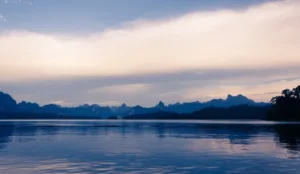
Begnas Lake Pokhara: Retreat in the Heart of the Valley
Situated among the serene landscapes of Pokhara, Begnas Lake is a hidden gem that mirrors the tranquility of nature. This enchanting freshwater lake, embraced by lush green hills and framed by the majestic Annapurna and Manaslu mountain ranges, attracts tourists from around the world.
Quick Facts about Begnas Lake
- Depth: 10m
- Altitude: 650m
- Area: 3.28 km²
- Location: Lekhnath, Pokhara
In this blog, we embark on a journey to uncover the magic of Begnas Lake Pokhara, from its fascinating depths to the surrounding treasures that enhance the allure of this pristine destination. Join us as we discuss the best times to visit, possible activities, and the hidden attractions that make Begnas Lake a haven for wanderers and nature enthusiasts. Let’s dive deep into the captivating world of Begnas Lake, where each ripple tells a story and every moment is a brushstroke on the canvas of serenity.
About Begnas Lake
Begnas Lake Pokhara is a jewel in the crown of the natural wonders of Pokhara and is a haven of tranquility and natural beauty. Situated in the charming town of Lekhnath, this lake is a short distance from the bustling area of Pokhara and is a testament to the unspoiled allure of the landscape of Nepal.
Covering an expanse of 3.28 square kilometers, Begnas Lake is a perfect example of the symbiotic relationship between humans and nature. With a maximum depth of 10 meters and an elevation of 650 meters, the lake’s pristine waters mirror the surrounding hills and mountains, creating a panorama that changes shades with the shifting sunlight.
What sets Begnas Lake apart is not just its physical dimensions but the cultural and ecological significance it holds for the locals. The lake is not just a body of water, it is a source of livelihood for the local communities, providing sustenance through fishing, and boating, and fostering a unique bond between the people and natural surroundings.
Begnas Lake promises an immersive experience for its visitors. Join us as we delve into the heart of Begnas Lake Pokhara, uncovering its mystery, and discovering the enchantment that has made it a cherished destination for those in search of sublime beauty and cultural richness.
Best Time to Visit Begnas Lake
Timing is everything when it comes to experiencing the full splendor of Begnas Lake Pokhara. Each season portrays unique features, offering visitors distinct glimpses of the lake. To make the most of your Begnas visit consider the following insights of the best times to visit:
- Spring (March to May): Begnas Lake Pokhara reveals its full splendor during spring as it marks the end of winter. The rhododendron and wildflowers blooming in the neighboring hills create a vibrant backdrop. The pleasant weather of spring is perfect for strolls around the shore and for boat rides. Begnas Lake reflects the restoration of nature during the springtime, which is a season of renewal.
- Summer (June to August): Summer brings warm days, and monsoon season in Pokhara. The days are either sunny or rainy adding a touch of freshness to the air. This season transforms the landscape into a lush green paradise. You can visit the lake on a sunny day during summer to enjoy the vibrant energy of nature and experience the clear view of the Annapurna Range.
- Autumn (September to November): Autumn is the best time to visit Begnas Lake Pokhara. The weather is stable with the clear sky and the surrounding hills shimmering in a golden hue. This post-monsoon season allows the visibility of breathtaking views of the Annapurna and Manaslu mountain ranges.
- Winter (December to February): Winter adds a touch of serenity to Begnas Lake. The temperatures drop, and a crisp chill fills the atmosphere. Boat rides are less frequent during this season, but the tranquility of Begnas Lake in winter appeals to those who prefer a solitude experience in the lake.
So, whether you like the flowers of spring, the green of summer, the gold of autumn, or the calm of winter. Begnas Lake Pokhara is ready to serve you. Each season has its own magic and unique natural beauty.
How do you get to Begnas Lake from Lakeside?
You can start your Begnas Lake journey from Lakeside, as it takes about a 45-minute ride/drive. Winding roads surrounded by greenery will take you to this pristine lake. The distance from the lakeside to Begnas Lake is about 17 kilometers. The mode of transportation available are public buses, private vehicles, or taxis.
Activities Possible in Begnas Lake
Begnas Lake a freshwater lake offers a wide range of experiences from boating to birdwatching. Here is a list of activities that will make your visit to Begnas Lake not just memorable but truly magical:
- Boating: Take a relaxing boat ride on the calm waters of Begnas Lake. Whether you prefer rowing yourself or hiring a local boatman, the boating experience allows you to soak in tranquility while being surrounded by stunning nature.
- Fishing: For those who find joy in the art of fishing, Begnas Lake offers a chance to connect with nature differently. Cast your line into the clear waters and enjoy the serenity as you wait for your catch.
- Swimming: If you are a water enthusiast, take a refreshing dip in Begnas Lake on a hot summer day. The clean, freshwater invites you for a swim, providing a unique opportunity to connect with nature.
- Yoga and Meditation: The peaceful atmosphere of Begnas Lake makes it an ideal spot for yoga and meditation. Find a quiet spot along the shore, breathe in the fresh air, and let the natural surroundings enhance your moments of mindfulness.
- Mountain View: Treat your eyes to the breathtaking views of the Annapurna and Manaslu mountain ranges. The lake serves as a perfect vantage point, offering a panoramic wonder that will leave you in awe.
- Birdwatching: Begnas Lake Pokhara is a haven for birdwatchers. Bring your binoculars and witness a variety of bird species in their natural habitat on a clear day. The peaceful environment and abundant species of birds make Begnas Lake an ideal place for birdwatching.
- Photoshoot at Begnas Lake: Begnas Lake is a paradise for photographers due to its stunning beauty. You can capture the reflections, the changing colors, and the moments of peace that define this enchanting location.
- Try Local Delicacy (BBQ Fish): Indulge your taste buds in the local flavors by trying the specialty of the area– BBQ fish. Local cafes offer a unique culinary experience, allowing you to savor the deliciousness of freshly grilled fish throughout the area.
Must-Vist Sights Near Begnas Lake Pokhara
As we dive deeper into the allure of Begnas Lake, it is important to explore the treasures that surround this natural haven to turn your visit into a truly enriching experience.
-
Majhikuna
Near Begnas Lake lies Majhikuna, a charming village that offers a glimpse into the local way of life. Stroll through its narrow lanes, interact with friendly villagers, and experience the warmth of Nepali hospitality.
In recent times, Majhikuna has become the talk of the town, drawing travelers in for the unique lakeside experience. This charming village near Begnas Lake has transformed into a trendy hub, boasting a collection of cafes with a delightful ambiance.
-
Pachhabhiya Deurali Temple
Located on a hill, overlooking the tranquil waters of Begnas Lake, Pachhabhiya Deurali Temple offers not only breathtaking views but has a spiritual connection to the cultural roots of the area. The hike to the temple becomes a pilgrimage of sorts, allowing you to absorb the serene atmosphere and gain insights into the local beliefs.
-
Sundari Danda
Sundari Danda stands as a viewpoint near Begnas Lake Pokhara. You can witness the magical sunrise or sunset from this spot that transforms your Begnas Lake experience into a visual symphony. The hills, the lake, and the distant mountains become picture-perfect with the hues of the sky in gold and pink.
-
Seven Lake View Point
Venture to the Seven Lake View Point for a breathtaking panorama that includes views of not just Begnas Lake but also other 6 nearby lakes. This is a perfect spot for nature enthusiasts and photographers to capture the beauty of multiple lakes in one frame.
-
Cultural Reverence at Gorakhnath Temple
Gorakhnath Temple lies a short distance from Begnas Lake Pokhara and serves as a sacred site and a cultural heritage. This temple is dedicated to Lord Gorakhnath and contributes to a sense of tranquility and cultural significance around the area. Visiting this temple provides an opportunity to connect to the spiritual aspect of the region.
-
Begnas Thulokote
If you are an adventure lover lace up your hiking boots and explore the scenic trails leading to Begnas Thulokote. The hike reveals stunning views of Begnas Lake and its surrounding landscapes. Hiking to Thulokot is an opportunity to connect with nature on an intimate level.
-
International Zoological Park of Pokhara
Animal lovers and families will enjoy a visit to the International Zoological Park near Begnas Lake Pokhara. The park is home to a variety of wildlife and provides an educational and entertaining experience for visitors of all ages.
These attractions near Begnas Lake Pokhara add depth to your journey, providing a diverse range of experiences from cultural immersion to scenic exploration. As you venture beyond the shores of Begnas Lake, each destination unfolds a new chapter in the story of this captivating region.
Final Say
In the heart of the enchanting city of Pokhara, Begnas Lake acts as a sanctuary for those in search of peace and natural beauty. Finally, Begnas Lake is not just a destination, it is an invitation to connect with nature, explore, rejuvenate, and discover the beauty of Pokhara.
Begnas Lake Pokhara invites travelers to step into a realm where time slows down, and the symphony of nature takes center stage. As you carry on your journey, may the tranquility of this haven stay with you. Until we meet again, may your adventures be as vibrant as the reflections on the waters of Begnas Lake.
FAQ’s
- Are there accommodations available near Begnas Lake?
Yes, there are accommodations ranging from cozy guesthouses to lakeside resorts, providing options for various budgets. Staying near Begnas Lake allows you to wake up to serene views and immerse yourself in nature.
- Can I swim in Begnas Lake?
Yes, you can enjoy a refreshing swim in the clear waters of Begnas Lake. This freshwater lake provides a delightful experience for those looking to cool off on a hot summer day and connect with nature.
- Are there local dining options near Begnas Lake Pokhara?
Certainly! Majhikuna, a nearby village, has become a popular spot with cafes offering local delicacies. Don’t miss the chance to try BBQ fish, a specialty of the area.
- Can I explore nearby viewpoints for panoramic views?
Absolutely! Sundari Danda and Seven Lake View Point provide stunning panoramic views of Begnas Lake and the surrounding landscapes. These viewpoints are perfect for taking a photograph to capture the beauty of the region.
- Are there cultural attractions near Begnas Lake?
Yes, the surroundings of Begnas Lake are rich in cultural gems such as Pachhabhiya Deurali Temple and Gorakhnath Temple. These sites offer not only spiritual experiences but also insights into the rich cultural tapestry of the surrounding Begnas Lake.
- Is Majhikuna worth a visit?
Definitely! Majhikuna has become a trendy tourist destination with various cafes, offering a delightful blend of local charm and modern comfort. It is an ideal spot to relax and enjoy the ambiance while taking in views of Begnas Lake Pokhara.
- Are there opportunities for birdwatching near Begnas Lake?
Yes, Begnas Lake and its surroundings are a haven for birdwatchers. The diverse ecosystem attracts various bird species, providing a rewarding experience for nature enthusiasts.
- Are there activities for adventure seekers at Begnas Lake?
Indeed! Begnas Lake offers various activities like boating, fishing, sightseeing, and hiking. Adventurous souls can find plenty of activities among the natural beauty of the region.
- What is the best time to visit Begnas Lake Pokhara?
Begnas Lake is captivating year-round, but the ideal time to visit is during autumn (September to November) when the weather is stable, and you can enjoy clear skies and breathtaking views of Annapurna Range.
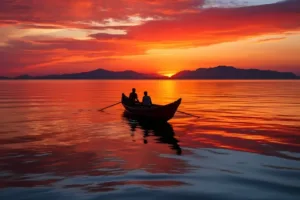
Pokhara Valley: Everything You Need to Know
Situated in the Gandaki Pradesh of Nepal, Pokhara is the heaven for adventurers, and nature and culture enthusiasts. This city is the definition of beauty due to the tranquil shores of Phewa Lake and the awe-inspiring views of the Annapurna and Dhaulagiri mountain ranges.
Pokhara Valley also stands as a jewel in the crown of the Himalayan nation as the city is close to the Annapurna Region. This enchanting city is also known as the “Gateway to the Annapurna Circuit,” with its unparalleled natural beauty and rich cultural tapestry. Travelers around the world begin their trekking adventure from this beautiful valley.
Facts about Pokhara
- District: Kaski
- Area: 464.2 km²
- Elevation: 1,400 m
- Population: 476,000
- Province: Gandaki Pradesh
In the blog, we are going to discuss details like the origins and history, its demographics, cultural influences, and natural wonders and major tourist attractions of this remarkable city. Pokhara is a destination where history, culture, and natural beauty converge in perfect harmony. From the serene waters of Phewa Lake to the cultural vibrancy of the World Peace Pagoda.
Whether you are into trekking, a culture enthusiast, or simply a seeker of serenity, Pokhara is exactly for you.
Read more as we discuss the history-rich streets, partake in cultural festivities, and witness the wonders that make Pokhara Valley a must-visit destination in a lifetime.
History of Pokhara
The name “Pokhara” is believed to be derived from the Newari language, “Pokhari” which means “pond”. Due to the presence of abundant lakes throughout the region.
The earliest settlements in the Pokhara Valley date back to the 5th century, and it is believed that business persons of the Newar community played a significant role in the early development of the city. The valley was the trade route between India and Tibet.
The political aspects of Pokhara are unclear as it is infamous for its beauty and cultural heritage. This city is a harmonious blend of Hindu and Buddhist traditions, evident in the temples, and monasteries throughout the spectacular landscape.
As you explore Pokhara, you will discover the rich cultural legacy, with Bindhyabasini Temple and Tal Barahi Temple among others. The warmth of the residents and the vibrancy of the festivals add an enchanting dimension to the city’s history.
Demographics and Culture
Let’s understand the diverse demographics and cultural significance that shape this Pokhara Valley. With a population of approximately 476,000 people, this beautiful city is the epitome of Nepal’s cultural diversity.
One of the defining features of Pokhara Valley is its ethnicity. The city is home to many ethnic groups, such as Gurungs, Magars, Newars, Brahmins, Chhetris, and more. These diverse backgrounds fuse to create a harmonious blend of customs, traditions, and languages.
Among various ethnic groups, the Gurungs have a significant presence in the city. They are known for their rich cultural heritage, including unique dance forms, songs, and festivals. Visitors often have the opportunity to witness these cultural manifestations, adding depth to their travel experiences.
Weather in Pokhara Valley
Understanding the weather patterns can help you plan your trip accordingly, ensuring an enjoyable and comfortable experience. This picturesque city in Nepal experiences a diverse range of climates throughout the year, making it a year-round destination for travelers with varying tastes.
Seasonal Variation
The climate of Pokhara Valley is characterized by four distinct seasons, each offering a unique experience for visitors.
- Spring (March to May): Spring is a delightful time to visit this beautiful valley. The weather is moderate, with warm days and cool nights. The lush landscapes surrounding the valley burst into vibrant colors as the flowers bloom, creating a scenic backdrop for your explorations.
- Summer (June to August): Summer is warm and brings the monsoon season. While the days can be hot and humid, the rainfall contributes to the lush greenery of the city. This season is not ideal for visiting as it rains heaviest among other places in Nepal.
- Autumn (September to November): Autumn is considered one of the best times to visit Pokhara Valley. The weather is clear and pleasant, making it perfect for trekking and adventurous activities. The mountain and landscape views are at their most stunning during this time.
- Winter (December to February): Winters are chilly, with cool days and cold nights. While trekking is still possible, the higher elevations can get quite cold. However, the clear skies offer a unique perspective of the surrounding snow-capped peaks.
Best Time to Visit Pokhara Valley
Pokhara is an ideal year-round destination, every season offers unique advantages depending on your interests and preferences.
Autumn (September to November)
- Ideal for Trekking: Autumn is regarded as the best time to visit Pokhara Valley, especially for a trekking enthusiast. The weather is clear and mild throughout the day and cool during the evenings. The view of the Annapurna and Dhaulagiri ranges are spectacular during this season.
- Vibrant Landscapes: The lush hills and valleys are happening with colors as flowers bloom, creating a beautiful backdrop for your adventures.
- Festivals: You might have the opportunity to witness and participate in local festivals and cultural events that are celebrated during this time.
Spring (March to May)
- Flourishing Nature: Spring is also ideal to visit as the weather is mild, with warm days and cool nights. The city and its surroundings burst into vibrant colors as rhododendrons and other flowers bloom.
- Good for Outdoor Activities: Spring is perfect for outdoor activities like trekking, boating on Phewa Lake, or exploring cultural sites.
Winter (December to February)
- Clear Skies: Winter is characterized by cool days and chilly nights. The skies are clear, offering a clear perspective of the mountains. This is a great time for photographers and those who prefer a quieter, more introspective visit.
- Trekking: While some higher-altitude treks may be challenging due to the cold, there are still plenty of lower-altitude treks and cultural activities to enjoy.
- Peaceful Retreat: If you seek a peaceful and serene experience, winter is an excellent choice.
Summer (June to August)
- Lush Greenery: The monsoon season brings warmth and humidity. While trekking and mountain views can be affected by clouds and rain, the city and its surroundings become incredibly lush and green.
- Lake and Waterfall Exploration: The serene lakes and gushing waterfalls are at their most beautiful during the monsoon, making it an excellent time for boat rides and nature enthusiasts.
Sacred Sights in Pokhara
The spiritual zeal of Pokhara is reflected in the numerous temples and monasteries that gracefully blend with the landscape. These sites serve as spiritual anchors and pilgrimage destinations.
- Bindhyabasini Temple: This sacred Hindu shrine is dedicated to the goddess Bindhyabasini, a form of Goddess Durga. It is one of the most important spiritual sights in Pokhara Valley. The tranquil surroundings of the temple provide a serene atmosphere for prayer and reflection.
- Tal Barahi Temple: Situated on the calm waters of Phewa Lake, the Barahi Temple is dedicated to Goddess Barahi. Devotees and visitors reach the temple by boat ride, making it a unique and serene pilgrimage site to visit.
- World Peace Pagoda: This iconic stupa is not only a symbol of peace but also a viewpoint for the panoramic Annapurna and Dhaulagiri mountain ranges.
- Gupteshwor Cave: Gupteshwor cave holds religious value as it exists together with a holy temple of Lord Shiva. Exploring this cave is both an adventurous and spiritual experience.
- Jangchub Choeling Monastery: Located on the outskirts of the city, this Tibetan Buddhist monastery offers a peaceful getaway and an opportunity to witness Buddhist rituals and ceremonies.
- Gaighat Church: The Gaighat Church is the first Church in Nepal and is a significant religious site for the Christian community in Pokhara. It serves as a place of worship and reflection for Christians. This Church is also a testament to the religious diversity of the city.
Festivals in Pokhara Valley
Pokhara, a city nestled in the lap of the Himalayas, resonates with the vibrant beats of numerous festivals throughout the year.
Throughout the year, Pokhara is full of festivals like Dashain, Tihar, Buddha Jayanti, and Jatras, where cultural traditions come to life in vibrant celebrations. These festivals, along with the spiritual sites, are an integral part of the history and culture, adding depth and dimension to the city’s identity.
-
Bhairab Nach
Bhairab Nach stands out as a distinctive cultural celebration in Pokhara. This festival is a vibrant display of traditional dances and rituals every 5 years, where locals adorned in colorful costumes. The rhythmic beats of drums and the mesmerizing dance movements of the performers make Bhairab Nach a unique and captivating experience.
-
Lhoshar
Another significant festival that adds to the flavor of the cultural scene of Pokhara. Gurung, Tibetan, Tamang, and Yolmo communities celebrate Lhosar with enthusiasm as it marks the Tibetan New Year. The festivities include traditional dances, music, and rituals, creating a joyous atmosphere that reflects the tight community spirit of Pokhara.
-
Pokhara Street Festival
The Pokhara Street Festival is a testament to the dynamic social life of Pokhara. Streets of Lakeside come alive with food stalls, cultural performances, and local artists displaying their crafts. This festival not only promotes a sense of community but also provides a platform for residents and visitors to immerse themselves in the diverse cultural offerings, food, music, and more.
-
Teej
Teej is a festival dedicated to the goddess Parvati and celebrated with zeal in Pokhara. Women clad in vibrant red attire gather and perform traditional dances and rituals, symbolizing devotion and marital bliss. Teej not only holds religious significance but also serves as a platform for cultural expression and solidarity among women.
-
Dashain
The grandeur of Dashain covers Pokhara in a festive spirit. This major Hindu festival symbolizes the victory of good over evil. Families come together to receive blessings, exchange gifts, and partake in feasts. Dashain, with its rich cultural and religious undertones, is an integral part of the festivals of Pokhara.
-
Tihar
Tihar, the festival of lights, illuminates Pokhara with joy and enthusiasm. Each day of Tihar is dedicated to honoring different animals, including crows, dogs, and cows. The cityscape is full of colorful rangoli and lights creating a mesmerizing spectacle during this five-day celebration.
-
Chat Puja
Chat Puja holds a special place in the hearts of the people of Pokhara. Devotees gather on the banks of rivers to offer prayers to the setting sun, expressing gratitude and seeking blessings. The rituals and festivities associated with Chat Puja add a spiritual touch to the cultural calendar of Pokhara.
-
Maha Shivaratri
Hindus of Pokhara celebrate Maha Shivaratri with great devotion. On this day devotees flock to temples to worship Lord Shiva. In addition, different parts of the city are covered with the lights of a campfire. The spiritual significance of Maha Shivaratri blends seamlessly with the cultural celebrations, creating a harmonious festival.
-
Buddha Jayanti
Buddha Jayanti marks the birthday of Lord Buddha and is a significant occasion for Buddhists in Pokhara. Pilgrims and visitors participate in prayer rites, parades, and cultural events to honor the teachings of Buddhism. The tranquil ambiance of Pokhara resonates with the spiritual essence of Buddha Jayanti.
-
Janai Purnima
Janai Purnima holds cultural importance in Pokhara as communities come together to observe sacred rituals. Today, boys and men of the Aryan community of Pokhara tie sacred threads (janai). Also, the bond of brothers and sisters is celebrated by tying Rakhi. Janai Purnima beautifully blends tradition with family bonds.
-
Holi
Holi is the festival of colors that transforms Pokhara into a canvas of vibrant shades. Locals and tourists celebrate this joyous day, by applying colored powders on their loved ones. The spirit of Holi reflects a sense of unity and celebration, making it a loved event in Pokhara.
-
Thote Parba
Thote Parba is rooted in Pokhara’s cultural heritage, celebrating the indigenous communities and their unique traditions. The festival showcases traditional dances, music, and rituals, providing a platform for locals to connect with their roots and share their heritage with the wider community.
Festivals of Pokhara are a testament to the cultural richness and diversity of the valley. From the spiritual sincerity of Dashain and Maha Shivaratri to the spirited celebrations of Holi and the Pokhara Street Festival, each event contributes to the richness of the city. These festivals not only honor tradition but also bring communities together, creating an unforgettable tapestry of cultural experiences in Pokhara.
Administrative Divisions of Pokhara Valley
Pokhara-Lekhnath Metropolitan City is divided into 33 wards, each of which has a significant role in a local administrative unit. These wards are responsible for providing various essential services to residents and ensuring local development. They play a vital role in urban planning, infrastructure development, and public service delivery. These administrative divisions play a major role in the preservation and promotion of the cultural heritage and traditions of the city. Many wards have their temples, and cultural landmarks, which are focal points for various cultural and religious activities. These sites offer visitors a deeper understanding of the local way of life.
How to Get to Pokhara?
Navigating your way is an essential part of the adventure. Here is a comprehensive guide on how to get to Pokhara from two key starting points: Kathmandu and Sonauli.
From Kathmandu
- Via Air:
The journey to Pokhara begins at the Tribhuvan International Airport in Kathmandu, a bustling hub that connects you to the Pokhara International Airport. The flight from Kathmandu to Pokhara is a short yet sensational experience, lasting approximately 25 to 30 minutes. During the flight, you can observe the views of diverse landscapes, lush hills, and the iconic Himalayan peaks of Nepal.
- Via Road:
If you prefer the roadway, the trip starts from Kathmandu following the Prithvi Highway. This highway is a major arterial road that winds its way through the heart of Nepal, offering glimpses of terraced fields, quaint villages, and flowing rivers. The journey by road takes approximately 6 to 7 hours, depending on traffic and weather conditions. The total road distance from Kathmandu to Pokhara is 200 kilometers, this road trip allows travelers to immerse in the beauty of the Nepalese countryside. Talking about the mood of transportation, public buses, tourist buses, private cars, and jeeps are easily available for the journey to Pokhara.
From Sonauli
- Via Air:
If you want to fly from Sonauli, the journey involves transit through key airport connections to Pokhara. You can fly from your city in India to Kathmandu and take another flight to Pokhara. You also can drive about 10km from Sonauli to Gautam Buddha Airport, Bhairahawa to take another flight to Pokhara. The flight duration from Bhairahawa to Pokhara is 30-35 minutes.
- Via Road:
A road trip from Sonauli to Pokhara promises scenic views and a taste of the Nepalese countryside. The highway journey allows travelers to witness the changing landscapes and soak in the beauty of the region. There are two major roadways to get to Pokhara, Siddhartha Highway and Mahendra Highway.
The Siddhartha Highway road trip takes approximately 7 hours, offering a leisurely pace to enjoy the journey. The distance of the road trip from Sonauli to Pokhara via Siddhartha Highway is about 188 kilometers. Another route that connects Sunauli to Pokhara is the Mahendra Highway which passes through Narayangarh and Mugling. If you choose this route to travel it takes about 8-9 hours. You can choose either route to travel at your convenience. Just like the Kathmandu route, travelers from Sonauli can choose various modes of transportation, such as bus, private vehicle, or taxi.
Top Tourist Attractions in Pokhara Valley
Pokhara has a surplus of natural beauty and cultural treasures at every turn. Here, we explore some of the city’s top tourist attractions, each offering a unique and memorable experience.
-
Phewa Lake
Phewa Lake, also known as Phewa Tal, is the gem of Pokhara. It is the largest freshwater lake set against the backdrop of the Annapurna and Machapuchare mountains.
Visitors can hire a rowboat and paddle on the lake, soaking in the stunning views and the peaceful atmosphere. The Lakeside area surrounding Phewa Lake is also surrounded by cafes and restaurants, making it an ideal spot for relaxation with friends and partners.
-
Davis Falls
Davis Falls is a unique and powerful waterfall that plunges into an underground tunnel, creating a mesmerizing sight and sound. It is also known as “Patale Chango,” which translates as “underground waterfall.”
-
Gupteshwor Cave
Neighboring Davis Falls is the Gupteshwor Cave. This cave houses a sacred temple dedicated to Lord Shiva and is a fascinating place to explore.
-
Pumdikot
Pumdikot is a destination with cultural and natural delights. Pumdikot is famous for its Shiva temple and as a scenic viewpoint of Pokhara.
-
Annapurna and Dhaulagiri Mountain Ranges
The Annapurna and Dhaulagiri mountain ranges are a trekker’s paradise. The city serves as a gateway to these towering peaks, offering a wide range of trekking routes and experiences.
Some of the famous trekking trails in Annapurna Regions are:
- Annapurna Circuit Trek
- Ghorepani Poonhill Trek
- Annapurna Base Camp Trek
- Pokhara to Australian Base Camp
-
Sarangkot
Sarangkot, a popular viewpoint near the valley, offers breathtaking sunrise and sunset views of the Annapurna and Dhaulagiri ranges. It is a must-visit spot for panoramic mountain views.
-
Matepani Gumba
Matepani Gumba is a serene Buddhist monastery nestled in the hills near Mahendrapul. Known for its peaceful ambiance and breathtaking views, this Gumba offers a spiritual retreat for visitors. The intricate architecture and colorful prayer flags add to the cultural richness of the site.
-
Gharmi Danda
Gharmi Danda is a picturesque hilltop offering panoramic views of Pokhara Valley and the surrounding Himalayan peaks in Lamachaur. It is a perfect spot for nature enthusiasts and trekkers seeking a peaceful escape. The lush greenery and cool breeze make Gharmi Danda truly a hidden gem.
Hidden Gems of Pokhara Valley
-
Kaudada
Kaudada is a landmark that offers a scenic view of the mountains from Pokhara. Kaudada is the perfect sight if you want to experience sunset and sunrise.
-
Dhiki Danda
Dhiki Danda is a tranquil beauty near Pokhara Valley. This spot offers panoramic views of the surrounding landscapes, providing a serene escape from the hustle and bustle of daily life.
-
Birendra Cave
Birendra Cave is an underground marvel in the captivating terrain of Pokhara. The cave is a deep and mysterious chamber with naturally sculpted stalactites and stalagmites.
-
Methlang
Methlang is a tranquil village surrounded by terraced fields and lush landscapes. It provides a peaceful retreat away from the bustling city life, very close to Pokhara. Visitors can take leisurely walks, enjoy the scenic beauty, and experience the genuine warmth of the local community in Methlang.
-
Rupakot
Rupakot, with its majestic hilltop location, offers breathtaking views of the Annapurna mountain range. Rupakot is famous for Rupakot Resort which provides a luxurious retreat, combining natural beauty with modern amenities. The resort is an ideal destination for those seeking luxury, relaxation, and adventure.
-
Sundari Danda
Sundari Danda is a ridge offering stunning sunrise and sunset views. The name “Sundari Danda” translates to “Beautiful Hill,” and the location lives up to its name. You can hike up to Sundari Danda for a clear view of Begnas Lake and the surrounding landscape. It is a perfect spot for photographers and nature enthusiasts to capture Begans Lake and the changing hues of the sky.
-
Pachabhiya Zoological Park & Wildlife Rescue Center
Pachabhiya Zoological Park & Wildlife Rescue Center is dedicated to the conservation and rehabilitation of local wildlife in Lakhnath, Pokhara. You can reach this rescue center in just 30 30-minute ride from Pokhara. And can learn about the region’s fauna, and the center plays a crucial role in raising awareness about wildlife protection and environmental conservation.
-
Majhikuna
Majhikuna offers an off-the-beaten-path experience for travelers looking to immerse themselves in a tranquil and authentic village atmosphere. It is an opportunity to connect with the local culture and enjoy the serene landscapes of rural Nepal. Begnas Lake, the second-largest lake in Pokhara Valley is also distinctly visible from Majhikuna.
-
Dhiki Danda
Dhiki Danda is a quaint village that provides a glimpse into the authentic rural life of Pokhara. Surrounded by terraced fields and traditional houses, Dhiki Danda offers a unique cultural experience. Visitors can interact with locals, savor local cuisine, and appreciate the simplicity of rural living. Dhiki Danda is perfect if you want to experience the magical sunset of Pokhara.
-
Bhalam
Bhalam is a charming village known for its traditional architecture, warm hospitality, and natural beauty. Strolling through its narrow lanes, you will encounter rustic houses with woodwork. Bhalam offers a serene escape, allowing visitors to immerse themselves in the cultural tapestry of Pokhara.
-
Mahendra Cave
Mahendra Cave is a natural wonder, featuring a series of limestone formations and stalactites. As you venture into the cave’s depths, you will be captivated by the unique geological features. The cave holds cultural significance, and exploring its dark recesses is an adventure for those seeking a blend of nature and history.
-
Tiger Top
Tiger Top is a vantage point offering breathtaking views of the surrounding valleys and mountains. You can get to Tiger Top by ride or trek. The interesting thing about this place is there is a single beautiful tree on top of the hill. Tiger Top is the famous destination to chill out among the youths of Pokhara.
-
Hudikot
Hudikot is a charming village that has preserved its cultural heritage and natural beauty in a Bharat Pokhari. With its traditional architecture and friendly locals, Hudikot provides an authentic experience of life in the Pokhara Valley. Visitors can witness a clear view of the Seti River, and many districts near Pokhara, as well as a clear view of the mountains such as Machhapuchchhre, Annapurna, Dhaulagiri, and more.
Museums in Pokhara Valley
-
International Mountain Museum
The International Mountain Museum stands as a tribute to the majestic mountains that grace our planet. This museum exhibits the rich culture and history of the Himalayas of Nepal. Visitors can learn about the diverse landscapes of Nepal and the culture and lifestyle of Sherpa.
-
Gurkha Memorial Museum
The Gurkha Memorial Museum in Pokhara pays tribute to the legendary Gurkha soldiers and their history. This museum is a living testament to the bravery of the Gurkha regiments, showcasing their remarkable achievements on the battlefield. The museum displays a rich collection of artifacts, including weapons, uniforms, and personal items, allowing visitors to connect with the spirit of warriors.
-
The White Gallery
The White Gallery in Pokhara is a testament to its commitment to the arts. This contemporary space serves as a space for local and international artists to display their art. With its minimalist aesthetic, The White Gallery provides a tranquil setting for visitors to immerse themselves in a diverse array of artistic expressions, from paintings to sculptures. This gallery is a hub of art in Pokhara Valley.
-
Pokhara Museum
Pokhara Museum displays the cultural heritage of the Pokhara Valley. This museum holds the history of the city, showcasing artifacts that mark the evolution of the city. From traditional tools and implements to glimpses of daily life through the ages, the Pokhara Museum takes visitors on a captivating journey through time. Immerse yourself in exhibits that reflect the essence of the identity of Pokhara, from history to the vibrant present.
-
Annapurna Butterfly Museum
Annapurna Butterfly Museum is a unique museum. As you step into this museum, you are greeted by the delicate beauty of butterflies. The museum contains the diverse butterfly species found in the Annapurna region. Visitors have the opportunity to witness the metamorphosis from caterpillar to butterfly and gain a deeper appreciation for the delicate balance of nature that thrives in the shadows of the towering Annapurna mountains.
Adventurous Activities Possible in Pokhara
There are a wide variety of adventurous activities possible in Pokhara Valley. Whether you are seeking the tranquility of a boat ride on the pristine lakes, the adrenaline rush of a zip-line descent through the Himalayan foothills, or the heart-pounding excitement of a bungee jump, Pokhara has it all. Glide like a bird in the sky with paragliding, paddle through waters with kayaking. Make the landscape of Pokhara your playground and experience both serenity and excitement against the backdrop of the majestic Himalayas.
-
Boating
Boating in various lakes in Pokhara Valley offers a tranquil escape, allowing you to soak in the breathtaking views of the surrounding mountains and lush landscapes. Fewa and Begnas Lake are popular for boat rides, you can row on your own or hire a guided boat tour to enjoy boating in these lakes. The lakes of Pokhara provide a romantic setting for a leisurely water adventure.
-
ZipFlyer
For thrill-seekers, the ZipFlyer is an adrenaline-pumping experience that lets individuals soar through the air, taking in panoramic views of the stunning scenery of the valley. This high-speed zipline adventure offers an exhilarating ride, combining the rush of wind with the awe-inspiring beauty of the Himalayan foothills.
-
Bungee Jumping
Take a leap of faith from one of the most spectacular bungee jumping platforms of Hemja, Pokhara. Suspended over the artificial pond, the bungee experience in Pokhara is not just a free fall, it is a heart-pounding plunge among the natural wonders of Nepal.
-
Paragliding
Soar like a bird above the Pokhara Valley with paragliding adventures. The tandem flights offer a unique perspective of the landscape, allowing you to glide effortlessly over the city, lakes, and lush hills. Paragliding in Pokhara is an unforgettable experience, combining the thrill of flight with the view of the surroundings Himalayans.
-
Kayaking
Navigate the waters of Fewa Lake through the exhilarating activity of kayaking. You can spend a day in the lake kayaking and soaking in all the natural beauty around you.
-
Ultralight Flight
Experience the magic of flight with ultralight aircraft that take you on a thrilling journey above Pokhara. Feel the wind in your hair as you enjoy a panoramic view of the landscapes, lakes, and mountains that make Pokhara Valley a haven for adventure enthusiasts.
-
Canyoning
Discover the thrill of canyoning as you descend through cascading waterfalls in Lwang Ghalel. This adventure activity in Pokhara combines rappelling, and swimming, for an adrenaline-packed exploration of the natural waterfall.
Trekking Options Near Pokhara Valley
Annapurna Base Camp (ABC) Trek
- Duration: 7-12 days
- Trek Length: 110 km
The ABC Trek offers trekkers the opportunity to discover less traveled parts of the Annapurna range. This trek is a striking combination of mountain views, diverse landscapes, and encounters with warm Gurung communities.
Major Highlights
- Close-up view of the Annapurna and Machapuchare range.
- Explore lush forests, alpine meadows, and rhododendron forests.
- Immerse into the local culture and hospitality of Gurung communities along the route.
Ghorepani Poon Hill Trek
- Duration: 4-7 days
- Trek Length: 54km
The Poon Hill Trek offers a shorter but no less rewarding experience. You hike through rhododendron forests, witness unforgettable sunrises, and engage with the local Gurung and Magar culture on this trek.
Major Highlights:
- Witness the warm hospitality of the Gurung and Magar people.
- Trek through vibrant rhododendron forests, especially during the spring season.
- Witness a spectacular sunrise over the Annapurna and Dhaulagiri ranges from Poon Hill.
Mardi Himal Trek
- Duration: 5-7 days
- Trek Length: 41km
The Mardi Himal Trek provides a path to stunning mountain views. Trekkers are immersed in pristine wilderness, enjoying close-up views of the Annapurna and Machapuchare peaks on this route.
Major Highlights:
- Experience a short yet fulfilling trekking experience.
- Explore remote trails in a tranquil and untouched natural environment.
Dhampus Trek
- Duration: 2-3 days
- Trek Length: 1650m
The Dhampus Trek is perfect for those with limited time. The trail leads to the charming Dhampus village, where you can savor stunning mountain vistas and a glimpse of local culture.
Major Highlights:
- Ideal short and rewarding trek for those with limited time.
- Discover the Dhampus village and its traditional architecture.
- Enjoy close-up views of the Annapurna and Machapuchare mountains.
Sikles Trek
- Duration: 5-7 days
The Sikles Trek takes you off the beaten path to explore remote villages and connect with the Gurung community. This trek is a serene and immersive experience in the Annapurna region.
Major Highlights:
- Visit remote villages among the hills and valleys of the Annapurna region.
- Explore a less-traveled trail, allowing an authentic and immersive experience.
- Connect with the Gurung community and gain insights into their unique customs.
Gurung Hill Trek
- Duration: 3-4 days
The Gurung Hill Trek offers a short and sweet cultural experience. Immerse yourself in Gurung traditions while enjoying serene landscapes and panoramic mountain views.
Highlights:
- Experience a slice of local life while staying in Gurung homestays.
- Enjoy peaceful and scenic landscapes with panoramic mountain views.
- Immerse yourself in the rich culture and traditions of the Gurung people.
Khopra Danda Trek
- Duration: 7-9 days
- Trek Length: 8km
The Khopra Danda Trek is a quieter alternative to the ABC Trek. It leads trekkers to the breathtaking viewpoint of Khopra Danda, offering pristine wilderness and unforgettable mountain sights.
Highlights:
- Trek through pristine wilderness and serene landscapes.
- Experience the beauty of the Annapurna region with fewer trekkers.
- Panoramic vistas of the Annapurna and Dhaulagiri range from Khopra Danda.
Final Say
Concluding this blog on the enchanting Pokhara Valley, a destination that perfectly blends the realms of natural beauty, culture, and adventure. The city embodies the essence of paradise from the serene shores of Phewa Lake to the awe-inspiring vistas of the Annapurna and Dhaulagiri mountain ranges.
As the “Gateway to the Annapurna Circuit,” this is a city rich in history, culture, and natural wonders. In this blog, we embarked on a journey to uncover the origins and history, demographics and culture, famous sights, festivals, trekking options, weather, and best time to visit.
Finally, this city is a destination where history, culture, and natural beauty converge in perfect harmony. Whether you are a trekking enthusiast, a culture connoisseur, or simply a seeker of serenity, Pokhara Valley has something special to offer. So, pack your bags and embark on an unforgettable journey through the history-steeped streets, partake in cultural festivities, and witness the wonders that make “The City of Lakes” a must-visit destination in a lifetime.
FAQ’s
- Is Pokhara Worth Visiting?
Yes, Pokhara is worth visiting. It is renowned for its spectacular natural beauty, serene lakes, and proximity to the Annapurna and Dhaulagiri mountain ranges. The city offers a wide range of experiences, from trekking adventures to cultural exploration and relaxation by Phewa Lake.
- Is Pokhara Bigger than Kathmandu?
No, Pokhara is not bigger than Kathmandu. Kathmandu is the capital and the largest city in Nepal, while Pokhara, the capital of Gandaki Pradesh, is the second-largest city in the country.
- What is Pokhara Famous For?
Pokhara Valley is famous for stunning mountain views, particularly of the Annapurna and Machapuchare range. The city is also known for its serene Phewa Lake, adventure activities, and as a gateway to some of the world’s best trekking routes.
- Where is Pokhara Located on the Map of Nepal?
Pokhara is located in the central part of Nepal, approximately 200 kilometers west of the capital city, Kathmandu. Pokhara Valley lies in the Kaski District of Gandaki Pradesh and is beautifully situated near the Annapurna and Dhaulagiri mountain ranges.
- Is Pokhara Safe for Tourists?
Yes, Pokhara Valley is generally considered a safe destination for tourists. The city is known for its warm hospitality, and the local authorities take measures to ensure the safety of visitors. However, like any travel destination, it is advisable to take standard precautions and follow local guidelines to have a safe and enjoyable experience.
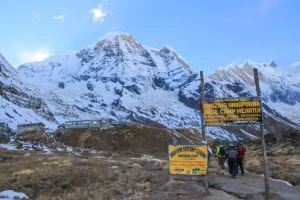
Annapurna Base Camp Trek Cost Breakdown: A Detailed Analysis
One of the most renowned and stunning trekking adventures in Nepal is the Annapurna Base Camp Trek or ABC Trek. This journey presents astonishing views of the magnificent Annapurna mountain range, several landscapes, and the opportunity to fully experience the vibrant local culture. This trek is situated in the Annapurna Conservation Area. Before boarding on this adventure, it is essential to understand the Annapurna Base Camp Trek Cost breakdown to plan and budget the trek effectively.
Annapurna Base Camp Trek Cost: Introduction
Participating in the Annapurna Base Camp trek is a dream come true for adventure seekers. However, to confirm a smooth and enjoyable journey, it is important to have a comprehensive knowledge of the cost breakdown associated with this trek. Budgeting and planning ahead can make a significant difference in the overall experience, allowing trekkers to focus on the breathtaking vistas and unique cultural encounters without financial concerns.
The Annapurna Base Camp Trek comprises several costs, including permits, travel, lodging, food, and more, similar to any other trekking adventure. By exploring into the cost breakdown beforehand, trekkers can estimate their budget accurately and make informed decisions about where to allocate their funds wisely. Understanding the expenses involved will help avoid surprises and ensure that the journey remains within one’s financial capabilities.
Moreover, comprehending the cost breakdown enables trekkers to strategize and adopt cost-saving measures, such as choosing the most economical transportation options, sharing accommodation, and packing efficiently. In addition to lowering total costs, this lets trekkers stay longer or partake in other activities while discovering the allure of the Annapurna region. If you have already done Annapurna Base Camp Trek then you can go with Annapurna Circuit Trek or Everest Base Camp Trek.
Annapurna Base Camp Trek Cost: Trekking Permits and Fees
Trekking in the Annapurna region requires getting specific permits and paying fees for those permits. These permits are essential for both environmental conservation efforts and trekker safety.
Annapurna Conservation Area Permit (ACAP)
All adventure seekers trekking in the Annapurna region must have an Annapurna Conservation Area Permit (ACAP). The ACAP aims to conserve the natural biodiversity, culture, and heritage of the region. The cost of the ACAP varies for Nepali nationals, SAARC nationals, and foreign nationals.
- For Nepali nationals: NRS 100 per person
- For SAARC nationals: NRS 1,000 per person
- For foreign nationals: USD 30 per person
Trekker’s Information Management System (TIMS) Card
The Trekker’s Information Management System (TIMS) card is another essential document for trekkers in Nepal. It helps in maintaining a database of trekkers for safety and security purposes. The TIMS card is available in two categories: Group TIMS and Individual TIMS.
- Group TIMS (for group trekkers): NRS 300 per person
- Individual TIMS (for individual trekkers): NRS 2,000 per person
Note: Before beginning the journey, it is recommended to confirm the most recent permit costs with the appropriate authorities or your trekking company.
Annapurna Base Camp Trek Cost: Accommodation
Accommodation during the Annapurna Base Camp trek plays a crucial role in ensuring trekkers’ comfort and rest after long days of hiking. The trek offers two main types of accommodation: teahouses (lodges) and camping. Each option has its unique advantages and costs.
Teahouses (Lodges)
Teahouses are small, family-run guesthouses that are strategically located along the trekking route. They offer trekkers basic amenities such as a bed, blanket, and shared bathroom facilities. Staying in teahouses provides an opportunity to interact with fellow trekkers and experience the local culture.
- Cost Range: The cost of accommodation in teahouses varies based on the location and level of comfort. On average, trekkers can expect to pay around USD 20 to USD 40 per night for a basic twin-sharing room.
Camping
Setting up camp in authorized camping areas requires bringing your camping supplies, such as tents and sleeping bags. This option offers greater privacy and flexibility in choosing camping locations.
- Cost Range: Camping costs can be higher compared to teahouses due to the additional equipment required. Depending on the camping equipment leased or carried along, the typical cost of camping can range from USD 30 to USD 50 per night.
Hybrid Option
Some trekkers opt for a hybrid option, where they combine teahouse stays with a few nights of camping. With this strategy, trekkers may enjoy the convenience and companionship of teahouses as well as the peace of camping.
Teahouse vs. Camping
Choosing between teahouses and camping depends on personal preferences, budget, and the level of comfort desired during the trek.
Advantages of Teahouses
- Convenience: Teahouses are readily available along the trekking route, eliminating the need to carry camping gear.
- Social Interaction: Staying in teahouses allows trekkers to meet and connect with other travelers, creating a sense of camaraderie.
- Warm Meals: Teahouses offer hot meals, which can be especially comforting during chilly nights.
Advantages of Camping
- Privacy: Camping provides a more secluded and private experience amidst the stunning landscapes.
- Flexibility: Campers have the freedom to choose their camping spots, allowing for a customized experience.
- Serenity: Camping under the starlit sky offers a unique connection with nature and the mountains.
Regardless of the accommodation choice, trekkers are advised to carry a suitable sleeping bag for added warmth and comfort. It’s also recommended to make reservations during peak trekking seasons to ensure availability, particularly in popular teahouse locations. By carefully considering the accommodation options and costs, trekkers can tailor their journey to match their preferences and budget, enhancing their overall Annapurna Base Camp trek experience.
Annapurna Base Camp Trek Cost: Food and Water
Availability of Food and Water along the Trek
The Annapurna Base Camp trek offers a variety of food and water options at teahouses and restaurants scattered along the trail. Trekkers will find basic yet nourishing meals to keep them energized during their journey. While the availability of food is generally good, the options might be limited in some remote areas. It’s essential to be open to trying local dishes and embracing the cultural experience.
Cost of Meals and Snacks at Teahouses
Meals at teahouses and restaurants along the Annapurna Base Camp trek are reasonably priced considering the remote location. Depending on the location and the cuisine, meal prices might vary slightly. Here’s an approximate cost breakdown:
- Breakfast: USD 5 to USD 10
- Lunch: USD 7 to USD 12
- Dinner: USD 8 to USD 15
These costs cover traditional Nepali dishes like dal bhat (rice with lentil soup), momo (dumplings), and noodle soups, as well as a selection of Western-style dishes. Some teahouses also offer snacks and beverages, such as energy bars, chocolate, tea, and coffee, at additional but reasonable costs.
Importance of Packing Water Purification Methods
Access to safe and clean drinking water is vital during the trek. While bottled water is offered in tea houses and restaurants, the usage of plastic bottles makes it more costly and ecologically harmful. Therefore, it is highly recommended for trekkers to carry their own water bottles and purification methods.
Water Purification Options
- Water Purification Tablets: These tablets effectively purify water by killing harmful microorganisms. They are a preferred option for trekkers because they are portable and light.
- Water Filters: Another effective technique for cleaning water from natural sources like streams and rivers, is to use portable water filters. Without the need for chemical additions, they deliver clean drinking water. They deliver potable water without the need for chemical additions.
- Steripen or UV Purifiers: UV purifiers, like Steripen, use ultraviolet light to kill waterborne bacteria and viruses, ensuring safe drinking water in just a few seconds.
By carrying water purification methods, trekkers can refill their water bottles from available water sources, such as streams and taps, without worrying about the quality. This technique not only saves money but also reduces environmental consequences by minimizing plastic waste.
Note: It’s essential to stay well-hydrated during the trek to avoid altitude sickness and ensure optimal performance while hiking. At higher elevations when dehydration is more likely, trekkers should strive to consume at least 3 to 4 liters of water a day.
Annapurna Base Camp Trek Cost: Trekking Gear and Equipment
The Annapurna Base Camp trek requires appropriate trekking gear and equipment to ensure comfort, safety, and a successful journey through the rugged Himalayan terrain. Here’s a comprehensive list of essential trekking gear required for the trek, along with estimated prices for renting or purchasing the items:
Trekking Clothing
- Moisture-wicking Base Layers: These include quick-drying t-shirts and long-sleeved shirts. (Estimated cost: USD 20 to USD 40 each)
- Insulating Layer: A warm fleece or down jacket to provide insulation against cold temperatures. (Estimated cost: USD 60 to USD 100)
- Waterproof and Windproof Jacket: A durable waterproof and windproof jacket to protect against rain and strong winds. (Estimated cost: USD 80 to USD 150)
- Trekking Pants: Lightweight, quick-drying, and comfortable trekking pants. (Estimated cost: USD 30 to USD 60)
- Trekking Shorts/Skirts: For warmer days and lower altitudes. (Estimated cost: USD 20 to USD 40)
- Warm Hat and Gloves: To keep your head and hands warm during cold weather. (Estimated cost: USD 20 to USD 40 each)
- Buff or Scarf: To protect against dust and cold winds. (Estimated cost: USD 10 to USD 20)
- Trekking Socks: Moisture-wicking and cushioned socks to prevent blisters. (Estimated cost: USD 10 to USD 20 per pair)
- Trekking Boots: Sturdy and comfortable waterproof boots with good ankle support. (Estimated cost: USD 80 to USD 150)
Backpack and Daypack
- Trekking Backpack: A durable and waterproof backpack with a capacity of 50-70 liters to carry all essential gear and clothing. (Estimated cost: USD 80 to USD 150)
- Daypack: A small daypack (20-30 liters) for carrying water, snacks, camera, and other essentials during day hikes. (Estimated cost: USD 30 to USD 60)
Sleeping Gear
- Sleeping Bag: A warm and lightweight sleeping bag suitable for cold temperatures. (Estimated cost: USD 80 to USD 150 for renting, USD 150 to USD 300 for purchasing)
Trekking Poles
- Trekking Poles: Adjustable and lightweight trekking poles to reduce strain on knees and provide stability during descents. (Estimated cost: USD 30 to USD 60 each)
Other Essentials
- Headlamp or Flashlight: For visibility during early morning or late-night treks. (Estimated cost: USD 20 to USD 40)
- Sunglasses: To protect against harsh sunlight and snow glare. (Estimated cost: USD 20 to USD 40)
- Water Bottles or Hydration System: To carry sufficient water during the trek. (Estimated cost: USD 10 to USD 30)
- First Aid Kit: Including basic medications, bandages, and blister treatment. (Estimated cost: USD 20 to USD 40)
- Toiletries: Including biodegradable soap, wet wipes, and hand sanitizer. (Estimated cost: USD 20 to USD 40)
- Sunscreen and Lip Balm: To protect against sunburn and chapped lips. (Estimated cost: USD 10 to USD 20)
Note: The previously mentioned costs are approximations that might change depending on the brand, caliber, and location of the purchase or rental. It’s essential to invest in good-quality gear to ensure comfort and safety during the trek.
Annapurna Base Camp Trek Cost: Transportation
Reaching the starting point of the Annapurna Base Camp trek requires travelers to reach the city of Pokhara first. Pokhara serves as the main gateway to many trekking adventures in the Annapurna region, offering various transportation options.
Domestic Flights
- Kathmandu to Pokhara Flight: Taking a domestic flight from Kathmandu to Pokhara is the fastest and most convenient option. The flight duration is approximately 25-30 minutes, and it provides stunning aerial views of the Himalayan peaks. Depending on the airline, the season, and the availability, a one-way flight ticket may cost from USD 100 to USD 200.
Private Vehicles
- Private Car/Van: For a more comfortable and flexible journey, travelers can hire private cars or vans. The travel time is similar to tourist buses, but private vehicles offer the advantage of customized stops along the way. The cost of hiring a private car or van for a one-way trip can range from USD 100 to USD 200, depending on the vehicle and negotiation.
Micro Buses
- Kathmandu to Pokhara Micro Bus: Micro buses are smaller than tourist buses and can be slightly faster due to fewer stops. They offer a more local experience of travel. The cost of a one-way micro bus ticket ranges from USD 15 to USD 35.
Tourist Buses from Other Cities
- Kathmandu to Pokhara Tourist Bus: Tourist buses are a popular and economical choice for travelers. It can take 6 to 8 hours to go to Pokhara from Kathmandu because the Prithvi Highway continues to be constructed. The cost of a one-way tourist bus ticket varies between USD 10 and USD 30.
- Lumbini to Pokhara Tourist Bus: Travelers coming from Lumbini (the birthplace of Buddha) can take a tourist bus to Pokhara. One-way trip from Lumbini to Pokhara might cost you from USD 15 to USD 30 and depending on traffic it can take 6 to 8 hours to reach Pokhara Valley.
- Chitwan to Pokhara Tourist Bus: Those visiting Chitwan National Park can take a tourist bus to Pokhara, which takes about 4-6 hours. While talking about travel costs from Chitwan to Pokhara it might cost you between USD 10 and USD 25.
Local Buses
- Local Buses: Local buses are the most budget-friendly option, but they may take longer due to frequent stops and crowded conditions. They offer an authentic experience of traveling like the locals. The cost of a local bus trip one way can range from $5 to $15.
Note: The above-mentioned transportation expenses are approximations that might change depending on the season, availability, kind of vehicle, and negotiating prowess. Prices may be slightly higher during peak trekking seasons. It’s advisable to inquire about the latest rates and book in advance, especially for flights and private vehicles
Annapurna Base Camp Trek Cost: Guide and Porter Fees
Benefits of Hiring a Guide and/or Porter
Hiring a guide and/or porter for the Annapurna Base Camp trek offers numerous advantages, enhancing the overall trekking experience and ensuring a safer and more enjoyable journey. Here are some benefits of having a guide and/or porter:
- Local Expertise: Guides possess extensive knowledge of the trekking route, local culture, and the surrounding mountains. Their knowledge enriches the journey as they provide profound knowledge about the history, flora, animals, and customs of the area.
- Safety and Navigation: Navigating through the Himalayan trails can be challenging, especially for first-time trekkers. A guide ensures trekkers stay on the right path, avoiding potential risks and hazards, and providing support in case of emergencies.
- Cultural Exchange: Guides facilitate cultural interactions with local communities along the trail. They bridge the language gap and offer opportunities to engage with locals, enriching the cultural experience of the trek.
- Assistance and Support: Guides offer encouragement, motivation, and emotional support throughout the trek. They provide advice to overcome the difficulties that trekkers confront on a physical and emotional level.
- Lightened Load: Porters help carry the bulk of trekkers’ heavy belongings, allowing them to trek with a lighter backpack. This relieves physical strain, increasing trekking comfort and endurance.
- Enjoyable Experience: By handling logistical aspects such as accommodation and meals, guides and porters free trekkers to fully immerse themselves in the breathtaking scenery, culture, and camaraderie with fellow trekkers.
Average Costs and Tipping Etiquette for Guides and Porters
Guide Fees
The cost of hiring a guide for the Annapurna Base Camp trek can vary based on experience, language proficiency, services provided, and trek duration. On average, a licensed guide may charge approximately USD 25 to USD 35 per day.
- Tipping Etiquette for Guides: Tipping is a customary practice in Nepal to show appreciation for good service. While it is not mandatory, it is a thoughtful gesture to tip your guide at the end of the trek. A recommended tip is around USD 5 to USD 10 per day per guide, depending on their level of service.
Porter Fees
Porter fees depend on the weight they carry and the trek duration. On average, a porter may charge approximately USD 15 to USD 25 per day.
- Tipping Etiquette for Porters: Tipping porters is also a considerate gesture. An appropriate tip for a porter is around USD 3 to USD 5 per day, per porter, as an acknowledgment of their hard work and dedication.
Note: It’s important to ensure that guides and porters receive fair wages and proper treatment. Hiring from a reputable trekking agency or cooperative that follows ethical practices is recommended.
Additional Expenses
Aside from the core costs of permits, accommodation, food, transportation, and hiring guides and porters, trekkers should be prepared for various miscellaneous expenses during the Annapurna Base Camp trek. These additional expenses may arise from various sources, including extra activities and unexpected needs. Here are some common miscellaneous expenses to consider:
- Hot Showers: While some teahouses offer hot showers, they usually come at an additional cost. The cost of a hot shower ranges between USD 2 to USD 5 per usage. Also, keep in mind higher elevation might impact the cost variation.
- Battery Charging and Electronics: Charging electronic devices, such as cameras, phones, and power banks, may incur a small fee at teahouses or lodges. The cost for battery charging typically ranges from USD 2 to USD 5 per device.
- Wi-Fi and Internet Access: Wi-Fi and Internet facilities are available at some teahouses, but there may be a fee for usage. The cost for Wi-Fi access can range from USD 2 to USD 5 per hour or as a daily package.
- Snacks and Drinks: On the ABC Trek journey, Hikers can purchase food, energy bars, chocolates, or drinks such as bottled water, soda, or alcoholic beverages. The cost of these things may vary, so, budget $5 to $10 each day for snacks and drinks.
- Personal Medications: If trekkers require specific medications or first aid supplies, they should allocate funds for purchasing these items before starting the trek. Prices can vary based on individual needs.
- Trekking Gear and Equipment Rental: For trekkers who prefer to rent trekking gear and equipment instead of purchasing them, rental costs should be considered. The rental price will depend on the type and duration of the gear rented.
- Unexpected Expenses: It’s always prudent to have some emergency funds set aside for unexpected expenses, such as medical needs, unplanned rest days due to weather conditions, or unforeseen circumstances.
Allocating Funds for Tipping Guides and Porters
Tipping guides and porters is an important aspect of trekking etiquette and a way to show appreciation for their hard work and support. As mentioned earlier, it’s recommended to budget around USD 5 to USD 10 per day for tipping guides and USD 3 to USD 5 per day for tipping porters. Trekkers can allocate funds accordingly based on the trek duration and the number of guides and porters hired.
Annapurna Base Camp Trek Cost: Travel Insurance and Medical Expenses
Importance of Travel Insurance for Trekking in Nepal
Having comprehensive travel insurance is of paramount importance for trekkers heading to the Annapurna Base Camp or any other trekking destination in Nepal. Trekking in the Himalayas involves inherent risks, such as altitude-related illnesses, unpredictable weather conditions, and accidents on rugged terrain. Travel insurance provides financial protection and peace of mind in case of unforeseen events, ensuring trekkers can focus on their adventure without worrying about the financial burden of medical emergencies or evacuation.
Coverage Details for Trek-Related Injuries or Illnesses
A robust travel insurance policy for trekking in Nepal should include the following coverage details:
- Medical Expenses: Coverage for medical expenses, including doctor consultations, hospitalization, medications, and treatment for trek-related injuries or illnesses.
- Emergency Evacuation and Repatriation: Coverage for emergency helicopter evacuation or rescue from remote areas in case of severe injuries or life-threatening conditions.
- High-Altitude Sickness: Coverage for medical treatment and evacuation in case of altitude-related illnesses, such as Acute Mountain Sickness (AMS), High-Altitude Pulmonary Edema (HAPE), or High-Altitude Cerebral Edema (HACE).
- Trip Cancellation or Interruption: Coverage for trip cancellation or interruption due to unforeseen circumstances, such as flight cancellations, natural disasters, or personal emergencies.
- Lost or Delayed Baggage: Coverage for the loss, theft, or delayed arrival of baggage, including trekking gear and essential items.
- Emergency Dental Care: Coverage for emergency dental treatment in case of dental issues during the trek.
- Personal Liability: Coverage for legal expenses and compensation in case of accidental damage or injury caused to others during the trek.
Budgeting for Medical Expenses and Emergency Evacuation
When budgeting for the Annapurna Base Camp trek, allocating funds for travel insurance and potential medical expenses is crucial. Depending on the coverage limitations, length of the journey, age of the traveler, and the insurance company, travel insurance prices might shift. On average, trekking travel insurance can cost between USD 50 to USD 150 for a two-week trek in Nepal.
It’s also crucial to take emergency evacuation costs into account, which in isolated mountain areas might be high. The price of a helicopter rescue or evacuation may range from USD 5,000 to USD 10,000 or more, depending on the circumstance and location.
By budgeting for travel insurance and setting aside emergency funds for medical expenses and evacuation, trekkers ensure they are well-prepared for any unforeseen circumstances that may arise during their trekking adventure. Prioritizing travel insurance not only safeguards against financial burdens but also prioritizes personal safety and responsible trekking practices in the beautiful yet challenging Himalayan landscape.
Cost-Saving Tips and Strategies
Trekking in the Annapurna region can be an enriching experience without breaking the bank. With some smart planning and budget-conscious choices, trekkers can minimize expenses while ensuring their safety and enjoyment. Here are some cost-saving tips and strategies to consider:
- Trek in the Off-Season: Choosing to trek during the off-season (monsoon and winter months) can lead to cost savings on accommodation and permits. However, be prepared for possible weather challenges and limited services during these periods.
- Join Group Treks: Joining a group trek can help share the cost of guides, permits, and transportation. Many trekking agencies offer group packages, making them more budget-friendly for solo or small-group travelers.
- Be Self-Sufficient with Water and Snacks: Rather than purchasing bottled water and snacks at teahouses, bring a reusable water bottle and water purification tablets or filters to refill at water sources along the trail. Packing your snacks can also save money.
- Share Accommodation and Meals: Sharing accommodation with fellow trekkers in teahouses can reduce room costs. Additionally, many teahouses offer large portions of meals that can be shared, further lowering expenses.
- Bargain and Negotiate Prices: When renting trekking gear, hiring guides, or booking transportation, don’t hesitate to negotiate prices. However, always confirm that quality and safety are not compromised in the process.
- Carry Essential Items: Pack essential items like trekking poles, a reusable water bottle, and a basic first aid kit from home to avoid buying or renting them on the trail.
- Choose Teahouses Wisely: Teahouse prices can vary along the trek. Opt for teahouses that offer clean and comfortable rooms at reasonable rates. Be mindful of any hidden charges and clarify prices upfront.
- Consider Self-Guided Treks: Experienced trekkers with good navigation skills may opt for self-guided treks, eliminating the cost of hiring a guide. However, ensure that you are well-prepared and have reliable trekking maps and information.
- Explore Alternative Routes and Shorter Treks: Consider alternative routes or shorter treks in the Annapurna region, such as the Ghorepani Poon Hill trek or Ghandruk trek. These treks offer stunning views and cultural experiences at a fraction of the cost and duration.
- Support the Local Economy: Purchase meals and souvenirs from locally-owned teahouses and shops. Supporting the local economy helps sustain the communities and ensures a more authentic experience.
- Plan a Hybrid Trek: Opt for a combination of teahouse stays and camping. Camping allows for cost savings on accommodation, and teahouse stays provide comfort and social interaction.
Conclusion
The Annapurna Base Camp trek involves key cost components such as permits, accommodation, food, transportation, and guide/porter fees. Travel insurance and medical expenses are vital for safety. Trekkers should budget for miscellaneous expenses like hot showers, battery charging, and tipping guides/porters. Minimize costs by trekking in the off-season, sharing accommodation/meals, and negotiating prices. Explore shorter treks or join group treks for cost-saving benefits. Prioritize safety and plan to allocate funds for emergencies. A well-planned budget ensures a smooth and rewarding trekking experience, allowing trekkers to savor the beauty of the Annapurna region without financial worries.
FAQs
- What is the total cost estimate for the Annapurna Base Camp Trek?
The total cost varies depending on factors such as trek duration, accommodation choices, permits, guide/porter fees, and additional expenses. On average, budget around USD 800 to USD 1200 for a 10-15 day trek.
- Is it possible to do the ABC trek without a guide or porter?
Yes, experienced trekkers can do the trek independently. However, hiring a guide or porter is recommended for safety, local expertise, and comfort.
- Are there any hidden costs that trekkers should be aware of?
Some teahouses may charge extra for hot showers, Wi-Fi, or electronic charging. Clarify prices beforehand to avoid surprises.
- How much money should I carry in cash during the ABC trek?
Carry enough cash for personal expenses and emergencies. It’s advisable to have USD 200 to USD 300 in Nepalese rupees.
- What are the visa requirements for trekking in Nepal?
Most nationalities can obtain a visa on arrival at Kathmandu airport. A 15-day tourist visa costs USD 30.
- Can I bring my own trekking gear or should I rent it in Nepal?
You can bring your gear, but renting in Nepal is cost-effective. Ensure gear quality and condition if renting.
- Are there ATMs or money exchange facilities along the ABC trail?
ATMs are available in Pokhara and some larger villages. Carry enough cash before starting the trek.
- What are the most economical options for reaching Pokhara?
Tourist buses or micro-buses from Kathmandu are economical. Flights are faster but more expensive.
- Is altitude sickness common, and how can I avoid it?
Altitude sickness is possible. Acclimatize gradually, hydrate, and ascend slowly. Listen to your body and seek medical attention if needed.
- Can I customize my meals at teahouses to suit my dietary preferences?
Yes, teahouses offer varied meals. Inform them about dietary preferences or restrictions.
- How challenging is the Annapurna Base Camp Trek for beginners?
The trek is moderately challenging. Adequate preparation and a gradual ascent help beginners succeed.
- Are there any special permits required for the ABC trek?
Yes, trekkers need an Annapurna Conservation Area Permit (ACAP) and a TIMS (Trekkers’ Information Management System) card.
- Is it safe to trek in the Annapurna region during the monsoon season?
Monsoon brings heavy rain and landslides, making some trails challenging. Trek with caution during this season.
- Are there any communication facilities available during the ABC trek?
Teahouses offer Wi-Fi and charging facilities, but connections may be slow and unreliable.
- What should I do in case of an emergency or injury during the trek?
Contact your guide or teahouse owner immediately for assistance. Helicopter rescue is available if needed.
- Are there any age restrictions for the ABC trek?
There are no specific age restrictions for the ABC trek, but trekkers should be physically fit and capable to handle the difficulty of the terrain.
- How can I contribute to local communities and conservation efforts?
Support local businesses and lodges. Avoid single-use plastics and follow responsible trekking practices.
- Can I combine the Annapurna Base Camp Trek with other treks in Nepal?
Yes, you can combine it with the Ghorepani Poon Hill trek or Mardi Himal Trek to extend your adventure.
- What are the best ways to prepare physically for the trek?
Build cardiovascular endurance, stamina, and leg strength through regular exercise and hiking.
- Is it possible to trek solo or join a group for cost-saving?
Solo trekking is possible, but joining a group can be more cost-effective, enjoyable, and safer with shared expenses.

Altitude Sickness: What Every Traveler Needs to Know in 2024
If you have ever trekked above 2500 meters, you might have felt weak or uneasy which is a result of altitude sickness, commonly referred to as mountain sickness. When you climb quickly to a high elevation, you develop this syndrome.
Not only hikers experience it. Some people get issues simply from traveling to high altitudes. Your body experiences symptoms as it attempts to adapt to the decreased air pressure and lower oxygen levels at high elevations.
In this blog post, we will discuss everything related to altitude sickness (Acute Mountain Sickness known as AMS). You will get information about the causes, symptoms, preventative measures, and treatments of AMS before participating in any trekking journey.
Understanding Altitude Sickness
What is Altitude Sickness?
The changes in physiological function that the body experiences when exposed to high elevations and low oxygen levels are referred to as altitude sickness. Mild to severe symptoms of oxygen insufficiency might include headaches, nausea, dizziness, exhaustion, and shortness of breath. Understanding this condition is essential for recognizing its signs and taking appropriate measures.
Causes of Altitude Sickness
The quick climb to high elevations without giving the body enough time to acclimate is the main contributor to the sickness. As you ascend, the air pressure decreases, resulting in lower oxygen levels. Factors such as the rate of ascent, individual susceptibility, and the altitude reached can contribute to the development of AMS.
Symptoms and Severity Levels of Altitude Sickness
Altitude sickness can manifest through various symptoms such as:
- Headache
- Nausea
- Loss of appetite
- Fatigue
- Dizziness
- Difficulty sleeping
From minor indications of acute mountain sickness (AMS) to more serious conditions like high-altitude pulmonary edema (HAPE) or high-altitude cerebral edema (HACE), these symptoms can vary in stringency. Recognizing the symptoms and understanding their severity levels is crucial for appropriate management.
High-Risk Factors Related to Altitude Sickness
Certain factors can increase the risk of developing AMS. These include a rapid ascent without proper acclimatization, a previous history of altitude sickness, a high altitude reached, physical exertion, dehydration, and pre-existing medical conditions such as respiratory or cardiovascular issues. Being aware of these risk factors helps in assessing one’s vulnerability to mountain sickness.
Importance of Altitude Sickness Awareness
Altitude sickness awareness is of utmost importance to ensure the safety and well-being of trekkers. People may decide on their trekking plans in an educated manner if they are aware of the sickness, its causes, symptoms, and risk factors.
Understanding acute mountain sickness empowers trekkers to recognize early warning signs, practice proper acclimatization techniques, and seek timely medical assistance if needed.
Preparing for Trekking in Pokhara, Nepal
Physical Fitness and Conditioning
Trekking in Pokhara, Nepal is physically demanding, involving long hours of walking in challenging terrain. Your endurance, stamina, and muscular resilience may all be improved by regular physical activity and training like aerobic exercises, hiking, and strength training. Focus on activities that target your lower body, as they will prepare you for the uphill and downhill sections of the trek.
Mental Preparedness
Trekking in Pokhara, Nepal requires mental resilience and determination. Prepare yourself mentally by researching and learning about the challenges and rewards of the journey. Maintain a positive mindset, set realistic expectations, and be mentally prepared for physical exertion and potential altitude-related discomfort. You can stay motivated and go beyond any challenges by developing mental fortitude.
Consultation with a Healthcare Professional
It is advised to speak with a healthcare provider before doing the trekking , especially if you have any pre-existing medical concerns. Based on your medical history, they can evaluate your general health and offer tailored advice. This consultation will ensure you are physically fit to undertake the trek and help address any concerns or medical considerations.
Acclimatization Techniques and Training
Acclimatization is crucial to minimize the risk of altitude sickness during the trekking journey. Familiarize yourself with acclimatization techniques such as gradual ascent, planned rest days, and staying hydrated. Consider incorporating altitude training into your preparation, such as sleeping at higher altitudes or using altitude simulation devices. These techniques can help your body adjust to the reduced oxygen levels gradually.
Packing Essentials to Tackle Altitude Sickness
Clothing and Layering System
Pack clothing suitable for varying weather conditions and temperature changes. Layering is essential to regulate body temperature and adapt to changing climates. Include moisture-wicking base layers, insulating mid-layers, a waterproof and breathable outer shell, warm hats, gloves, and comfortable hiking socks. Additionally, pack a good pair of trekking boots that provide ankle support and have a sturdy sole for traction.
Trekking Gear and Equipment
Carry essential trekking gear such as a well-fitting backpack, trekking poles for stability, a reliable headlamp or flashlight, sunglasses with UV protection, a sun hat, and sunscreen to protect against the intense mountain sun. Consider bringing a portable altitude sickness monitor, which measures oxygen saturation levels, to help monitor your condition.
Hydration and Water Purification Methods
Staying hydrated is vital at high altitudes to combat altitude sickness. Make sure you have a continual supply of water by carrying a water bottle or hydration bladder. Additionally, pack water purification tablets or a lightweight water filter to treat water from local sources and prevent waterborne illnesses.
Medications and First Aid Supplies
You are advised to pack medicines you may need during your trekking journey like painkillers, anti-diarrhea meds, altitude sickness medications, and any other personal remedies. It is also essential to carry a well-stocked first aid kit with items like adhesive bandages, antiseptic wipes, blister treatments, and basic medical supplies.
Remember to consult with your healthcare professional or travel medical advisor for personalized advice on AMS medications and first aid essentials specific to your needs.
Nutrition and Hydration Tips to Avoid Altitude Sickness
Balanced Diet and Nutrient Requirements
You must eat a balanced diet rich in carbs, proteins, healthy fats, and a variety of fruits and vegetables on your trekking voyage. Carbohydrates provide energy, while proteins aid in muscle repair and recovery. Healthy fats help with insulation and provide sustained energy. Fruits and vegetables supply essential vitamins and minerals. Aim for nutrient-dense foods to meet your body’s increased energy demands at high altitudes.
Hydration Strategies and Water Consumption
Stay properly hydrated to combat altitude sickness. Even if you don’t feel thirsty, keep up your daily water intake. Aim to drink 2 to 3 liters of water every day, varying the quantity based on movement and personal conditions. To restore fluids and minerals, add hydrating liquids such as herbal teas, electrolyte-rich beverages, and hot soups to your diet.
Foods to Avoid at High Altitudes
Certain foods can exacerbate the symptoms of altitude sickness. Avoid excessive consumption of caffeine and alcohol as they can contribute to dehydration. As they can contribute to bloating, water retention, and digestive discomfort, meals heavy in salt and fat should also be kept to a minimum. Opt for lighter, easily digestible meals to prevent gastrointestinal issues.
Increase Iron and Vitamin C Intake
The body may lose more iron and have a worse ability to transport oxygen at high elevations. It is suggested to include iron-rich foods into your diet to prepare your body against Acute Mountain Sickness. Vitamin C aids in iron absorption, so include citrus fruits, berries, and bell peppers to enhance iron utilization.
Consider Diamox and Electrolyte Supplements
Consult with a healthcare professional regarding the use of altitude sickness medications like Diamox, which may help prevent symptoms. Additionally, consider carrying electrolyte supplements to replenish minerals lost through increased urine output and sweating.
Proper Trekking Techniques to Prevent Altitude Sickness
When undertaking high-altitude treks, it is crucial to employ proper techniques to prevent mountain sickness. You may improve your odds of successfully acclimatizing and lower your risk of experiencing difficulties associated with high altitude by concentrating on these tactics.
Slow and Steady Approach
Adopt a slow and steady pace while ascending to higher altitudes. Rapid ascents increase the possibility of AMS since your body does not get enough time to acclimate. Gradually gain altitude, allowing your body to adjust to the decreasing oxygen levels. This approach promotes better adaptation and minimizes the chances of experiencing altitude sickness symptoms.
Importance of Rest Days
Incorporate regular rest days into your trekking itinerary. Rest days allow your body to recover, adjust, and adapt to the changing altitude. During these days, engage in light activities, take short hikes to higher elevations, and relax. Adequate rest helps your body adjust to the reduced oxygen levels, promoting a safer and more comfortable trekking experience.
Techniques for Breathing and Oxygenation
Practice deep breathing techniques to enhance oxygenation. It is suggested by experts to focus on your breathing while ascending high altitude, you have to breathe using your nose and breathe out through your mouth. This technique helps increase oxygen intake and facilitates better oxygen circulation throughout your body. Additionally, consider using portable oxygen canisters, if needed, as a supplementary oxygen source.
Coping with Altitude-Related Challenges
Altitude-related challenges can occur even with proper acclimatization. Be mindful of the indicators of altitude sickness and take the necessary precautions if you or your fellow trekkers exhibit any symptoms.
Maintaining proper hydration, eating a balanced diet, and abstaining from pushing yourself beyond your limitations are the easiest ways to prevent this illness. If symptoms persist or worsen, descend to a lower altitude and seek medical attention if necessary.
Identifying Altitude Sickness and Reacting Appropriately
Being able to recognize altitude sickness symptoms and reacting appropriately is crucial for your safety in high-altitude environments. Here are the key steps to identify and respond to AMS:
Recognizing Mild, Moderate, and Severe Symptoms
The symptoms of Altitude sickness can be categorized in different ranges from mild to severe. Headaches, lightheadedness, weariness, and appetite loss are examples of mild symptoms. Shortness of breath, nausea, vomiting, and trouble sleeping are examples of moderate symptoms.
Severe signs of potentially fatal illnesses include a prolonged cough, tightness in the chest, disorientation, poor coordination, and blue color to the skin or lips. Knowing and understanding these symptom categories will help you assess the severity of altitude sickness.
Immediate Actions to Take
It is crucial to respond quickly if you or someone in your company exhibits signs of acute mountain sickness. First and foremost, it is crucial to halt any further ascent and rest at the current altitude. To keep hydrated, consume lots of liquids. Resting and letting your body adjust may be enough if your symptoms are minor. It is essential to descend to a lower altitude if symptoms linger, intensify, or if there are indications of severe altitude sickness.
Descent and Evacuation Procedures
In cases of severe altitude sickness or when symptoms do not improve despite descent, it may be necessary to initiate evacuation procedures. This involves arranging for transportation to a lower altitude or seeking immediate medical assistance.
If you are part of an organized trek, inform your trekking guide or team leader about the situation as they will have experience and protocols in place to handle such scenarios. If trekking independently, ensure you have access to communication devices or emergency services to facilitate evacuation if needed.
Natural Remedies for Altitude Sickness
Although there is no known cure for AMS, several herbal treatments and conventional procedures may help reduce symptoms or offer relief. Here are some natural remedies to consider:
Herbal Supplements and Medicinal Plants
Certain herbal supplements and medicinal plants are believed to have properties that can assist in managing altitude sickness symptoms. Examples include ginkgo biloba, ginger, garlic, and Rhodiola rosea. These supplements are allegedly helpful in boosting oxygenation, decreasing inflammation, and increasing blood circulation.
It’s crucial to remember that there is less scientific evidence to support their efficacy in avoiding or treating mountain sickness. Consult a medical physician or a certified herbalist before using any herbal supplements to get advice and learn about possible drug interactions.
Traditional Practices and Local Remedies
In regions with a history of high-altitude living, there may be traditional practices and local remedies used to manage AMS. For instance, the Andes area has traditionally used coca leaves as a homeopathic treatment. Local populations often chew or brew coca leaves into a tea to alleviate symptoms. The usage of coca leaves may not be permitted or available in all nations, and its effectiveness varies from person to person.
Note: It is advisable to consult with healthcare professionals, travel medical advisors, or local experts who know altitude sickness and the region you plan to visit.
Altitude Sickness Medications and Prevention
Medications can help in both prevention and treatment of altitude sickness. The following list of frequently prescribed drugs includes suggested dosages and prophylactic usage factors.
Commonly Prescribed Medications for Altitude Sickness
Acetazolamide (Diamox) is the most commonly prescribed medication for altitude sickness prevention and treatment. It helps stimulate breathing and increases the amount of oxygen in the bloodstream. Medical experts frequently use dexamethasone as an alternate medication to treat severe instances of AMS.
Dosage and Usage Guidelines
The dosage and usage guidelines for altitude sickness medications may vary based on individual circumstances and the recommendations of healthcare professionals. The normal dosage for acetazolamide is 125–250 mg administered twice a day, beginning one–to two days before climbing to altitude and continuing for two to three days at the destination.
Dexamethasone is commonly advised in emergencies, and the dosage is chosen by medical professionals. To be on the safe side always use medicine prescribed by a physician. They will suggest the right dose and use for you after taking into account your medical background, present health, and any possible medication interactions.
Prophylactic Medication Considerations
Prophylactic use of medications refers to taking them preventively before ascending to high altitudes. For those who are inclined to altitude sickness, acetazolamide is routinely used as a prophylactic medication. It is crucial to remember that using drugs shouldn’t replace other preventative measures like adequate acclimatization, water, and rest.
Note: You must see a healthcare professional or travel medical advisor to assess your unique circumstances and determine whether preventive medication is necessary.
Altitude Sickness Safety Measures for Specific Groups
Altitude sickness can affect individuals of all ages and health conditions differently. Here are some specific safety measures to consider for different groups:
Children and Adolescents
- Gradual Acclimatization: Children and adolescents may be more susceptible to altitude sickness. Ensure a slow and gradual ascent, allowing their bodies more time to acclimatize to the changing altitude.
- Hydration and Nutrition: Pay extra attention to their hydration and nutrition needs. Encourage regular fluid intake and provide nutrient-rich meals to support their growing bodies during the trek.
- Rest and Observation: Allow for additional rest days if needed and closely monitor their well-being. Be alert for indications of mountain sickness in children, such as weariness, lack of appetite, or behavioral changes. Children may not always be able to express their symptoms.
Elderly Individuals
- Medical Assessment: Before embarking on a high-altitude trek, elderly individuals should undergo a thorough medical assessment. Consult with a healthcare professional to determine their fitness for the specific altitude and trekking conditions.
- Slow Ascent and Rest Days: Follow a slow and gradual ascent, allowing ample time for acclimatization. Incorporate frequent rest days to minimize the risk of altitude sickness.
- Regular Monitoring: Keep a close eye on their vital signs, overall well-being, and any symptoms they may experience. Be prepared to modify the itinerary or descent if necessary.
Pregnant Women
- Consult with a Healthcare Professional: Pregnant women should seek guidance from their healthcare provider before considering high-altitude treks. The risks associated with altitude sickness and the potential impact on the pregnancy should be carefully evaluated.
- Avoid High Altitudes: Due to potential risks to their health and the health of their unborn children, pregnant women should typically avoid high-altitude places. Opt for lower-altitude destinations that are safer for the pregnancy.
Suggestions for Individuals with Pre-existing Medical Conditions
- Medical Consultation: If you have pre-existing medical conditions, consult with your healthcare professional to assess your suitability for high-altitude trekking. They can provide guidance based on your specific condition and make recommendations regarding altitude limits and precautions.
- Medication Adjustments: If you are taking medications for pre-existing conditions, discuss with your healthcare professional whether any adjustments are necessary at high altitudes. They can provide advice on potential interactions or the need for additional medications to manage altitude sickness.
- Personalized Safety Plan: Work with your healthcare provider to develop a personalized safety plan that takes into account your specific medical condition, altitude limitations, and any necessary precautions.
Altitude Trekking Tips for Solo Travelers and Groups
It’s crucial to take proper measures to avoid altitude sickness whether you are trekking at a high altitude alone or in a group. Here are some tips for both solo travelers and groups:
Solo Trekking Considerations
- Prioritize Safety: As a solo trekker, it’s crucial to prioritize your safety. Ensure that someone knows about your trekking plans, including your itinerary and estimated return dates. Stay in touch with loved ones or a reliable contact back home to provide updates on your progress.
- Acquaint yourself with the Route: Familiarize yourself with the trekking route, potential altitude challenges, and available medical facilities along the way. Carry a detailed map, guidebook, or GPS device to navigate confidently.
- Regular Communication: Maintain regular communication with fellow trekkers or guides you meet on the trail. Inform them about your solo trekking status and plans. Joining groups or finding trekking partners along the way can provide added safety and support.
Group Dynamics and Support Systems
- Group Size: If trekking in a group, consider a manageable group size that allows for effective communication, coordination, and support.
- Experienced Guides: Engage experienced guides or trekking agencies who are knowledgeable about altitude sickness and safety protocols. They can provide valuable guidance, monitor group members’ well-being, and offer the necessary support.
- Watch Out for Each Other: Establish a supportive group dynamic where members look out for each other’s well-being. Regularly check in on fellow trekkers, share information about symptoms or discomfort, and be willing to modify plans if someone is experiencing Acute Mountain Sickness(AMS).
Teamwork and Communication Strategies
- Regular Communication: Maintain open lines of communication within the group. Share any altitude sickness symptoms or discomfort with fellow trekkers and guide(s) promptly. This enables timely action and decision-making.
- Supportive Environment: Foster a supportive and non-competitive atmosphere within the group. Encourage each other to adhere to proper acclimatization and rest schedules. Avoid pushing beyond personal limits and encourage others to do the same.
- Emergency Protocols: Establish clear emergency protocols within the group, including procedures for immediate descent or evacuation if required. Ensure everyone understands these protocols and has access to necessary communication devices for emergencies.
Altitude Sickness Prevention Measures
It is important to take suitable precautions before participating in trekking Journey to reduce the risk of altitude sickness. Here are some important considerations:
Route Selection and Itinerary Planning
- Gradual Ascent: Choose a route that allows for a gradual ascent, giving your body sufficient time to acclimatize. Ascending too quickly increases the risk of acute mountain sickness. Opt for itineraries that include rest days at intermediate altitudes to aid in acclimatization.
- Extended Itinerary: If time allows, consider an extended itinerary that includes additional acclimatization days. This allows for a more relaxed pace and further adaptation to higher altitudes.
Proper Accommodation Selection
- Lodges with Altitude Awareness: Choose accommodations that prioritize altitude awareness and safety. Some lodges along the trek have experienced staff trained in recognizing and managing altitude sickness symptoms. They can provide guidance and support if needed.
- Avoid Rapid Gains in Altitude: When selecting accommodations, avoid making large altitude gains between overnight stops. Opt for accommodations at moderate altitudes to facilitate a gradual ascent.
Local Guided Tours and Services
- Experienced Local Guides: Engage the services of experienced local guides who are familiar with the trek and altitude sickness prevention measures. They can provide valuable insights, monitor your well-being, and offer guidance throughout the journey.
- Knowledge of Local Conditions: Local guides possess knowledge of the region’s weather patterns, common altitude sickness symptoms, and safe practices. Their expertise helps ensure a safer and more enjoyable trekking experience.
- Assistance with Acclimatization: Local guides can assist in implementing proper acclimatization strategies, including advising on rest days, monitoring hydration and nutrition, and providing guidance on pacing and altitude awareness.
Conclusion
Altitude sickness may be an issue before beginning a high-altitude journey, but with the proper knowledge and preparation, you can mitigate the dangers and guarantee a safe and enjoyable trek. Understanding its symptoms, and prevention strategies is crucial for every trekker.
Acute Mountain Sickness may be prevented by progressively acclimating to higher elevations, having frequent rest days, staying hydrated, and paying attention to your body. Packing essential items like appropriate clothing, trekking gear, and medications is important to tackle any symptoms that may arise.
Whether trekking solo or in a group, prioritize safety, open communication, and support among fellow trekkers. Engage experienced local guides who can provide valuable insights and ensure a well-guided journey.
Remember, AMS prevention requires a combination of physical preparation, acclimatization techniques, and cautious decision-making. By following these measures and respecting the power of altitude, you can embark on a trek with confidence, fully immersing yourself in the beauty of high-altitude landscapes while staying safe and well-prepared. Enjoy your trekking adventure and create memories that will last a lifetime!
FAQs
- What is altitude sickness?
Altitude sickness is a syndrome that develops after heading to high elevations due to lower oxygen levels and manifests as headaches, wooziness, and exhaustion.
- How long does it take to acclimatize to high altitudes?
Acclimatization at high altitudes takes distinct amounts of time for different people; it often takes 1-3 days for early adaptation and several weeks for full acclimatization.
- Are there any age restrictions for altitude trekking?
There are no strict age restrictions for altitude trekking, but older individuals and children may be more susceptible to acute mountain sickness and require extra precautions.
- Can altitude sickness be fatal?
In severe cases, it can be deadly. It is essential to recognize symptoms, take prompt action, and descend if necessary.
- What are the early warning signs of acute mountain sickness?
Some of the early symptoms of acute mountain sickness are:
- Headache
- Nausea
- Lack of appetite
- Exhaustion, and
- Trouble falling asleep
Recognizing these symptoms and responding promptly is crucial.

Nepal Skydiving: Nimsdai Skydive
Have you ever dreamed of experiencing the thrill of skydiving? What if you could take that exhilarating adventure to new heights, literally, by skydiving with a breathtaking view of the world’s highest peak, Mount Everest? This incredible opportunity is exactly what Skydive Nimsdai offers, a program developed by the legendary mountaineer Nimsdai Purja.
But who is Nimsdai Purja, you may ask? You can have a look at “14 Peaks,” a documentary on Netflix. If not, Purja is a former soldier from Nepal who has accomplished some of the most challenging mountain climbs in the world. His extraordinary achievements include holding multiple records, such as being the fastest person to conquer all 14 peaks over 8,000 meters (26,000 feet) in a mere six months and six days. Not only is Purja an accomplished mountaineer, but he is also a skilled skydiver and BASE jumper. His diverse expertise makes him the ideal person to create the Skydive Nimsdai program.
If you’re looking for an adventure that will take your breath away and give you a once-in-a-lifetime experience, Skydive Nimsdai is an opportunity not to be missed. And by taking part in this amazing adventure, you’ll get to experience the thrill of skydiving with a view of Mount Everest and support an incredible and accomplished individual like Nimsdai Purja.
What is Skydive Nimsdai?
If you’re an adventurous spirit seeking a thrilling activity, then Skydive Nimsdai is the perfect choice. This exclusive skydiving program offers a breathtaking view of Mount Everest and the Himalayan mountain range while jumping out of a plane. Whether you’re a seasoned skydiver or a first-time jumper, Skydive Nimsdai has got you.
Its unparalleled view makes Skydive Nimsdai stand out from other skydiving programs. The sight of Mount Everest and the Himalayan range from the air is nothing short of awe-inspiring. You’ll get a bird’s-eye view of the highest peak in the world and the stunning mountain range surrounding it, making it a once-in-a-lifetime experience.
The program is headed by Nimsdai Purja, a world-renowned mountaineer and skydiver. With his vast expertise and experience, you can rest assured that your safety is his top priority. Nimsdai and his team of skilled instructors will guide you through the entire process, ensuring that you have a safe and enjoyable experience.
Skydive Nimsdai is more than just a skydiving program. It also provides an opportunity to experience Nepali culture and hospitality. Based in the picturesque city of Pokhara, participants can immerse themselves in the city’s natural beauty and rich cultural heritage. From exploring the city to trying local cuisine, the program offers a chance to enjoy the unique charm of Nepal.
What can you expect from Skydive Nimsdai?
When you book a Skydive Nimsdai adventure, prepare for an unparalleled lifetime experience. Nimsdai has made a career out of thrill and passion. And this is what he aspires to provide. Depending on your preferred package, you can choose to jump in tandem with a qualified instructor or independently.
To ensure your safety, you will first receive a detailed safety briefing and training session to familiarize yourself with the equipment and procedures. After that, you will board a plane and ascend to the jump altitude, where you will take a leap of faith and experience a few seconds of exhilarating freefall before the parachute opens. As you glide through the air, soak up the breathtaking views of the magnificent Mount Everest and the stunning Himalayan mountain range.
Once safely landed on the ground, you can reflect on your experience with fellow adventurers. The fun continues as you can also spend time exploring the charming town of Pokhara and its environs. You can engage in various outdoor activities like hiking, boating, and visiting ancient temples and monasteries.
Tandem Skydiving
If you are a beginner or simply prefer to skydive with a professional, tandem skydiving is an excellent choice for you. This type of skydiving involves being fastened to an experienced instructor who leads you through the entire process, from the pre-flight safety briefing to the moment you land on the ground.
Skydive Nimsdai offers tandem skydiving to individuals of all levels of expertise. The program has been thoughtfully designed to prioritize safety and convenience for all participants, whether you are a newcomer to the sport or an accomplished skydiver.
Solo Skydiving
At Skydive Nimsdai, seasoned skydivers and beginners alike can indulge in the exhilarating activity of skydiving. For those who want to take their skydiving experience to the next level, solo skydiving is an option that’s available.
However, it’s important to note that solo skydiving requires a higher level of expertise and familiarity with the sport than tandem skydiving. Therefore, prior skydiving experience is crucial before attempting solo jumps. At Skydive Nimsdai, individuals interested in solo skydiving must complete a series of training jumps to ensure they are comfortable with the equipment and the procedures involved.
If you’re an experienced skydiver, solo skydiving with Skydive Nimsdai provides a unique opportunity to freefall while taking in the breathtaking view of the majestic Mount Everest and the Himalayan mountain range.
Packages and Pricing
At Skydive Nimsdai, you have a range of packages to choose from, tailored to your experience level and budget. These packages come with different offerings, including the number of jumps, photos and videos, and cultural experiences, catering to your preferences.
If you are a novice, the basic package is a perfect fit. You will get to experience a tandem jump with an instructor, and the thrill of the jump will be recorded in a video that you can cherish for life. For those seeking a more intense experience, the premium package offers three tandem jumps with an instructor, two solo jumps, and a range of cultural activities.
The prices of the Skydive Nimsdai packages are variable and depend on the package you select and the time of the year when you plan to visit. Nonetheless, the cost is competitive compared to other skydiving programs worldwide.
Safety
At Skydive Nimsdai, safety is a paramount concern. The program employs cutting-edge gear and skilled instructors to guarantee that all participants enjoy a secure and pleasant adventure.
To begin with, before each jump, participants undergo a comprehensive safety briefing and training session to ensure they are at ease with the equipment and the procedure. Moreover, the program maintains strict safety protocols, including thorough inspections of weather conditions and equipment before every jump.
At Skydive Nimsdai, the well-being of participants is never compromised, and every precaution is taken to provide them with a memorable and risk-free experience.
Cultural Experiences
Skydive Nimsdai offers a distinctive opportunity to immerse oneself in the Nepali culture and hospitality. The program is situated in Pokhara, a city renowned for its stunning natural scenery and significant cultural legacy.
Apart from skydiving, participants have the chance to discover the city and its environs. They can visit ancient temples and monasteries, go on exhilarating hiking or boating expeditions, or delve into the local cuisine and traditions.
Indeed, Skydive Nimsdai is more than just a thrilling adventure; it provides an all-encompassing experience that enables visitors to gain a deeper appreciation of the Nepali way of life.
FAQs
Q: Do I need any previous skydiving experience to participate in Skydive Nimsdai?
A: Whether you are an experienced skydiver or a beginner, you can enjoy both tandem and solo skydiving experiences. Nevertheless, it is important to note that solo skydiving is only suitable for individuals who possess prior skydiving experience.
Q: What cultural experiences are available?
A: At Skydive Nimsdai, the adventure doesn’t stop at skydiving. This thrilling experience is complemented by a diverse range of cultural activities for participants to indulge in. Along with exploring the beautiful city of Pokhara and its scenic surroundings, guests can also immerse themselves in the local culture.
From visiting ancient temples and monasteries to hiking through lush forests and boating on pristine lakes, there is something for everyone. Adventure enthusiasts can satiate their adrenaline rush with skydiving while culture lovers can delve deeper into the local traditions, cuisine, and way of life.
Guests at Skydive Nimsdai can savor local delicacies, interact with the friendly locals, and get a taste of the rich heritage and customs of the region. With a plethora of cultural experiences on offer, the adventure at Skydive Nimsdai is not limited to just one activity.
So, whether you want to challenge yourself with a thrilling skydiving experience or immerse yourself in the vibrant local culture, Skydive Nimsdai has got you covered.
Q: How many jumps can I do in a day?
A: The number of jumps you can do in a day depends on the package you choose and your experience level. Typically, participants can do one or two jumps per day.
Q: Is there an age limit for participants?
A: Participants must be at least 18 years old to participate in Skydive.
Q: What if the weather is bad on the day of my jump?
A: Safety is a top priority for Skydive Nimsdai, so if the weather conditions are not favorable for jumping, your jump will be rescheduled for a later date.
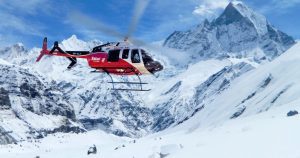
Mardi Himal Helicopter Tour
Nepal is home to several of the tallest mountains in the world. Climbing these mountains or even visiting the base camps is a highly fulfilling yet difficult experience. However, helicopter tours can make this stressful experience quite convenient and Pokhara Info is here to help you manage the Mardi Himal Base Camp.
The unique experience of the Mardi Himal base camp offers a bird’s eye view of the stunning Mardi Himal mountain range in Nepal, with all the luxury and comfort of a helicopter ride.
About Mardi Himal
Mardi Himal is a mountain range located in the Annapurna region of Nepal. The peak of Mardi Himal stands at 5,587 meters. There, you can enjoy the stunning views of the Himalayas. In recent times, the trek to Mardi Himal is becoming increasingly popular among trekkers and adventurers. As a result, so has the Mardi Himal heli tour.
About the Helicopter Tour of Mardi
Despite being in the same area, the Mardi Heli tour is much preferred by tourists over the ABC heli tour. The cinematic and most incredible horizontal perspective of towering mountains, the setting sun, fluttering clouds, and the picturesque tropical scenery may be seen on a helicopter tour to Mardi Himal. The centerpiece of the tour is Mardi Himal. Some other key mountains visible through this Mardi Heli tour are Machhapuchhre (6,993 meters), Dhaulagiri (8,167 meters), Singu Chuli, Hiunchuli, Khangsar Kang, Annapurna Ranges, Gangapurna, Tare Kang Glacier Dome, and so on.
This Mardi Helicopter Tour stands out as the finest option for individuals who want to enjoy the natural beauty in a shorter amount of time because it provides a close-up perspective of the complete Himalayan majesty. That also applies to individuals who are unable to break through the full route’s uphill and downhill march.
Why choose the Mardi Himal Helicopter Tour over the Mardi Trek?
- One of the biggest benefits of a helicopter tour of Mardi Himal is that it saves time. It is quite obvious yet true. Instead of spending days trekking to the base camp, you can explore the beauty of the mountain range in just a few hours. You’ll also be back at this time.
- Getting on a helicopter if you’ve never done so. Seeing the Himalayas from a bird’s eye view is an unforgettable experience. You might even be scared at first. The helicopter tour allows you to see the mountains and the surrounding landscape from a perspective that is not possible on a traditional trek.
- The trek is long and exhausting. Luckily, the helicopter tour is a luxurious experience. It features comfortable seating, air conditioning, and panoramic windows that offer stunning views of the Himalayas.
How to Book a Mardi Himal Helicopter Tour
Visitors can book the Mardi Heli Tour through tour operators and travel agencies that offer adventure tourism activities. It is recommended to book in advance to ensure availability and to get the best deals.
You can choose private helicopter outlets such as Simrik Air, Air Dynasty, or Nepal Helicopter Service among a few with choppers such as Airbus H125 or Bell 407GXP helicopter. You can visit the official website or also contact Pokhara Info to book your flight easily.
The price for a single passenger on the Mardi Heli flight is approximately US $1750. As previously said, you can reserve Mardi Heli services from private operators. Luckily, you can contact Pokhara Info to have the tour planned for you if you wish to avoid inconvenience.
The Flight Itself
The flight to Mardi Himal takes off from Lake City Pokhara and lasts for about 12 to 15 minutes. After you get to the Mardi base camp, the helicopter will leave you alone for around 30 minutes while you explore the area, take pictures and films, and create tons of memories. You will be flown back to Pokhara after spending some time there, and the trip should just take 12 to 15 minutes.
Best time for a Heli Tour at Mardi
At Mardi Himal, October to December or March to May are the ideal times to take a helicopter tour. The best views of the peak and the surrounding Himalayas are during these months because of the normally good weather and clear skies.
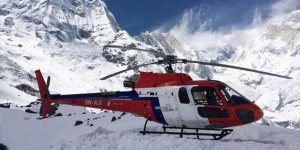
Annapurna Base Camp (ABC) Heli Tour
Nepal is a country with eight of the ten tallest mountains in the world and a gorgeous Himalayan range. If you wish to visit them all, or even see just the popular ones, a helicopter tour is the quickest yet most immersive way. In Nepal, there are a lot of Heli tour packages that you can choose including the Everest Heli tour, the ABC Heli tour (Annapurna base camp), the Rara Heli tour, and more.
For first-timers, the Annapurna Base Camp Heli Tour is an adventure trip that offers a unique way to explore the beautiful Annapurna region of Nepal. This two-hour Heli tour makes you feel more than just two hours. It takes you on a scenic helicopter ride to the base of the Annapurna mountains, where you can experience trekking, local culture, and food.
Overview of the Tour
The Annapurna Base Camp Heli Tour is a thrilling adventure that takes you on a helicopter ride to the base of the Annapurna mountains and the Annapurna region (not just the mountain). You can either start the tour from the capital city of Kathmandu or the city of Pokhara. Popularly, most tourists prefer the tour from Pokhara. This tour offers a unique way to explore the Annapurna region and provides stunning views of the Himalayas.
From Pokhara, the trip by helicopter to Annapurna Base Camp will start. The Annapurna Base Camp, Mounts Annapurna, Fishtail, Hiunchuli, and their ranges are all fairly close by from Pokhara Valley. It takes a helicopter 15 minutes to fly through breathtaking mountain scenery to get to ABC. A helicopter window provides a 360-degree view of the majestic Annapurna range including Mount Fishtail (Locally Machhapuchre), Mount Annapurna I (at 8,091m), Mount Dhaulagiri (at 8,167m), and other Himalayan peaks.
ABC Heli Tour Cost
There are two types of heli tours available for the ABC region. They’re charter-based private helicopter tours and group-joining helicopter tours. If you’re with a group or want to fly private, you can book the charter basis flight. In this, you (or your group) will book the helicopter and pay for the flight.
If you’re flying solo or duo and do not want to book the whole helicopter, you can choose a group joining flight. This package will include a total of five passengers that have booked individually. The full capacity of the helicopter is five people. The tour typically lasts 2-3 hours and costs around $360 – $420 per person. You can contact private heli tour operators like Simrik Air, Nepal Helicopter Tour, Air Dynasty, and more to book your flight. However, if you decide to go with Pokhara Info, we will manage all the hassles for the tour including the booking, and paperwork, and let you enjoy the tour effortlessly.
Why choose ABC Heli Tour?
- The tour offers a unique way to experience the beauty of the Annapurna region.
- It provides a chance to explore local culture and food in a short time.
- The tour is perfect for those who want to experience trekking but have limited time or physical ability.
- The tour provides a safe and comfortable way to explore the region.
- A way to experience a helicopter ride if you’ve never ridden one.
Best Time to visit ABC by helicopter
The best time to visit Annapurna Base Camp by helicopter is from March to May and September to November. During these months, the weather is clear and stable, making it perfect for a scenic flight and trekking. The tour generally starts in the morning as it’s the best time of the day to view the mountainous region without much clouds or fog. It’s important to note that the weather in the Himalayas can be unpredictable. So, it’s best to check weather forecasts and plan your trip accordingly.
You can select private helicopter providers such as Simrik Air (a recognized airline in Nepal) that has Airbus H125, 9N AJI, or Bell 407GXP helicopters. To make a flight reservation, you can go to the official Simrik Air website.
What to expect in ABC Heli Tour and Itinerary
The Annapurna Base Camp Heli tour begins with a scenic flight from the Pokhara Valley. Since Pokhara International Airport is the closest takeoff location to the Annapurna Sanctuary, the Annapurna Base Camp Heli Tour begins there. The Heli trip lasts for about 2-3 hours, taking into account the 30-minute flight time to the base camp. A member of the staff will provide a brief introduction to the members of the flight crew before outlining basic safety considerations that must be adhered to at all costs while on the charter. Safety is the first concern. Before getting on the helicopter, it’s necessary to make sure that you have understood all the instructions.
We formally begin the Annapurna Base Camp Helicopter Tour as we soar over the picturesque city of Pokhara (1,400 m), admiring the enchanted Fewa Lake. You will get to see some breathtaking vistas of heavenly nature interspersed by the sporadic Magar and Gurung settlements along the road. The massive snow-capped mountains of the Annapurna mountain range greet you after a 30-minute flight.
Staying for more than 30 minutes can be dangerous because the base camp is at a height of 4,130 meters. Acute Mountain Sickness could result from quickly gaining such a high altitude (AMS). Nonetheless, thirty minutes is more than time for us to take in some sightseeing, record some priceless moments, and savor a hearty and delicious meal. Thereafter, we go back to the airport in Pokhara.
How to Prepare:
There are a few important factors you should consider before you think of engaging in an ABC Heli tour.
Physical Fitness:
Even kids and senior citizens can perfectly experience the ABC heli tour. While the tour is suitable for people of all ages and fitness levels, it’s important to be physically prepared for the trek. Regular exercise and cardiovascular training are recommended.
Clothing and Equipment:
You’ll need to bring appropriate clothing and equipment for the trek. This includes warm clothing, hiking boots, and a daypack. It’s recommended to pack light to make the helicopter ride more comfortable.
Acclimatization:
Since you’ll be trekking at a high altitude, it’s important to acclimatize properly to avoid altitude sickness. You’ll need to spend a few days in Kathmandu before the tour to adjust to the altitude.
Top Things to Do in Annapurna Base Camp
The trek to the Annapurna Base Camp takes more than 10 days. There are a lot of things you can do in those ten days including:
- Trek to Annapurna Base Camp
- Visit Poon Hill for a sunrise view of the Himalayas
- Explore traditional villages like Chhomrong and Ghandruk
- Take a dip in the natural hot springs at Jhinu Danda
- Visit the Annapurna Conservation Area Project (ACAP) Museum
With the ABC heli tour, you can still view most of these attractions but do not have to spend the two weeks trekking and hiking. However, Pokhara Info also has ABC trekking tours available if you’re a trekking enthusiast.
The once-in-a-lifetime experience of the Annapurna Base Camp Heli Tour provides a singular approach to appreciating the Himalayas’ natural splendor. This tour is ideal for adventurers looking to experience the area securely and pleasantly because it offers breathtaking mountain views, trekking, local culture, and delicious food.
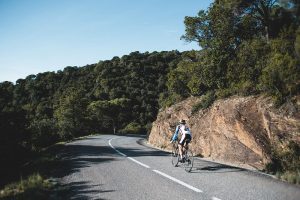
Cycling Adventures in Pokhara
Pokhara is an adventure-filled city in Nepal. To improve on the already-amazing tours that the city has to offer Pokhara Info also organizes a 1-day cycling adventure. It is a lovely city with a calm natural setting brimming with the most beautiful natural beauty, and it is undoubtedly a location to witness the riding experience.
As you climb higher and higher to the top of this “biking in Pokhara” experience, the more you will be able to see the valley, the calm and beautiful Annapurna and Machhapuchre mountain ranges, the nearby lakes, and the big and small green hills from which the fresh breeze starts and cools down your running and heating body. For a biking day trip, there are many choices.
Sarangkot hill biking
Sarangkot is the ideal location for viewing Pokhara’s true grandeur from an elevated vantage point. Here, you can see the entire Pokhara Valley and its stunning surroundings, which include mountain ranges, lakes, rivers, and lush hills.
The Sarangkot Biking Tour begins at your hotel near the lake, where our representative will be waiting with the bike. After breakfast, we’ll ride past to Bindhabasini, which is 2 km away, and then travel on an elevated, winding road to Sarangkot, which is 6 km from the highway and where you can see Pokhara’s true beauty.
You will remain in lodges for lunch and refreshments before we travel to Naudanda via Kaskikot, where you will also tour Kaskikot Durbar and enjoy the peaceful surroundings from which to view stunning landscapes, agricultural greenery, and swiftly flowing small and large rivers.
After that, we’ll travel 4 km to Naudanda, where you can relax, rehydrate, and eat lunch. Then we’ll take the road to Pokhara via a winding downhill road before arriving at a straight asphalt road via Hemja, where you can see the stunning hills that surround the city and its distinctive landscapes. Once we arrive at the road to Bindhabasini, you can then initially follow the track to your hotel room.
Phewa Lake Round Trip
The lake’s surrounding mountain biking paths are fantastic. Most people mistakenly believe that paths around lakes must be simple and level, but this is untrue. If you’re considering riding the Fewa Lake loop, get ready to put both your physical and mechanical abilities to the test.
The trails include the entire Pokhara Valley, the Lake Valley, the River Bay, people strolling solitary trails, difficult uphills, breathtaking scenery, Lake and Mountain Views, and technical and flowy downhills with rocks, roots, and stairways through forests. Although the queen forest has some of the finest single trails in the Pokhara Valley, it is not a man-made bike park. There are many ways to prolong the ride, so you can travel further.
Peace Pagoda Biking
The Peace Stupa in Pokhara is renowned for its distinctive setting and panoramic views of the city. This well-known location serves as a landmark for Pokhara’s top tourist attraction and is well known for preaching peace to the city.
The Peace Stupa Biking Tour begins when our representative picks you up with a cycle from your hotel near the lake. We’ll travel to Davis Falls and begin the four-wheel-drive road ascent to the peace monument. You can enjoy lunch at a lodge while taking in the finest views of Pokhara’s cityscape. After that, you can explore the area’s slopes and natural surroundings.
You will enjoy this place’s majestic style and well-chosen location. The captivating views of the Mountains, Fewa Lake, and Pokhara City will make you smile and allow you to take in the tranquility of this location in your special way. After that, we’ll change our direction and begin to descend a twisting road until we finally reach Davis Fall Point. We will drop you off at your hotel room after returning on the same route.
Lake Tour at Lekhnath
Some of the well-known lakes in Pokhara city include Begnas and Rupa, which are lovely and have a calm atmosphere. Although they are less crowded, they have magnificent scenes that every traveler wants to see. This one-day riding excursion is especially intended for keen, nature-loving adventurers.
The Begnas and Rupa Lake bicycling tour begins with a pickup from your accommodation by one of our representatives. We next travel to Bijayapur and then to Kalikasthan, where you will rest and have a tea break. Here, you can capture the stunning views of Pokhara city and the towering mountain top. You will then proceed to Sundari Danda, where you can both enjoy views of Begnas and Rupa Lake.
Every traveler’s once-in-a-lifetime experience will undoubtedly be ascending to some of the tower houses on the route to catch both glances of these lakes with breathtaking peaks in the peaceful surroundings. After having lunch and taking a break, you will go on to Begnas Lake from there. Depending on your preferences, you can spend an hour boating in this lovely lake. We will then turn around and head back to Talchowk and Bijayapur. Your one-day excursion will conclude once you return to your hotel room via the same route. Pokhara city and its lovely surroundings provided a wealth of experiences.
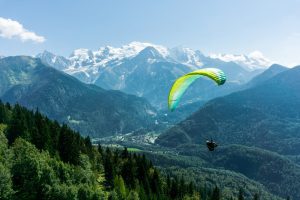
35 Interesting Facts about Pokhara
Exploring the natural beauty and cultural richness of Pokhara is an experience like no other. This magnificent city which lies in the lap of the Annapurna Mountains is a paradise for nature lovers and adventure seekers alike. In this article, we will provide you with 35 fascinating facts about Pokhara that will leave you in awe.
- The beautiful “Phewa Lake” is the second-largest lake in Nepal. The taal is surrounded by lush green hills of the valley and snow-capped mountains including Annapurna.
- The World Peace Pagoda is a popular attraction in Pokhara that was built to promote world peace. It is also known as Shanti Stupa.
- The Davis Falls is a unique waterfall that disappears underground when you see it from the outside. Locally the fall is known as Patale Chhango.
- The Tal Barahi Temple, located on an island in the middle of Phewa Lake, is a sacred Hindu temple and a popular tourist attraction.
- The Bindhyabasini Temple is another popular Hindu temple in Pokhara. The temple near Baglung buspark is dedicated to the goddess Durga.
- Sarangkot is a hill station located on the outskirts of Pokhara that offers a stunning panoramic view of the Mt. Annapurna and the Himalayas.
- Pokhara is the gateway to the famous Annapurna Circuit trek, one of the most popular treks in the world. You could say it is the start of the Annapurna Base Camp trek.
- The International Mountain Museum in Pokhara showcases the history and culture of mountaineering in the Himalayas.
- There is a Gurkha Museum in Pokhara. This museum honors the brave soldiers of the Gurkha regiment, who have served in the British Army for over 200 years.
- The Seti River Gorge is a natural wonder located in the heart of Pokhara. When you visit the Gorge you can see that the River has carved a deep gorge into the rock.
- The popular Mahendra Cave is a limestone cave located on the outskirts of Pokhara that is adorned with stalactites and stalagmites.
- Multiple kinds of bats find refuge in the Bat Cave, a spectacular cave system in Pokhara.
- On the outskirts of Pokhara, there are two magnificent lakes called Begnas Lake and Rupa Lake that are well-liked spots for boating and fishing.
- The famous hiking trail Kahun Danda gives breathtaking views of the Annapurna Range.
- In Pokhara, there is a well-known Hindu shrine to Lord Shiva located in the Gupteshwar Mahadev Cave.
- The Tibetan Refugee Camp in Pokhara is a cultural center where you can learn about the history and culture of the Tibetan people.
- The Devi’s Fall is a stunning waterfall located near the Gupteshwar Mahadev Cave that is named after a Swiss tourist who fell into the waterfall and died.
- The unusual museum in Pokhara known as the Annapurna Butterfly Museum displays the various types of butterflies that may be found in the Annapurna region.
- Another wonderful museum in Pokhara that highlights the history and culture of the area is the Pokhara Regional Museum.
- Adventure activities including paragliding, bungee jumping, zip-lining, and white-water rafting are also popular in Pokhara.
- Every year, the Paragliding World Cup in Pokhara draws paragliding fans from all around the world.
- One of the oldest temples in Nepal, the Bindhya Basini Temple, is thought to have been constructed in the sixteenth century.
- One of the most stunning mountains in the world is the Machhapuchhre, also known as Fishtail Mountain, a sacred peak in the Annapurna Range.
- Pokhara’s Old Bazaar is a lively marketplace where you can buy anything from contemporary clothing and technology to traditional handicrafts.
- Fish of many types, including carp, catfish, and trout, can be found in the Phewa Lake.
- One of Nepal’s cleanest rivers, the Seti River flows through the center of Pokhara and is noted for its milky white water.
- The Gurkha Memorial Museum in Pokhara honors the valiant Gurkha troops by showcasing their background and accomplishments.
- The Pokhara Skydive is a thrilling adventure activity where you can experience the ultimate adrenaline rush by jumping out of a plane and freefalling over the majestic Annapurna Range.
- A Swiss visitor who perished while attempting to swim in the basin below the cascade is remembered by the name Davis for the waterfalls.
- Among the bat species that live in Pokhara’s Bat Cave are the Himalayan whiskered bat and the horseshoe bat.
- Due to the region’s richness of many bird species, such as the common kingfisher and the white-throated kingfisher, the Begnas Lake and Rupa Lake are popular destinations for birdwatchers.
- Another popular trek in the Annapurna region, the Annapurna Base Camp trek, departs from Pokhara and travels through stunning mountain scenery and charming mountain hamlets.
- You can also go canyoning at the Seti River Gorge, where you can experience the rush of adventure by rappelling down the gorge.
- Due to its breathtaking views of the sun setting behind the Annapurna Range, the Kahun Danda is sometimes referred to as the “Sunset Hill.”
- The Pokhara Street Festival honors the city’s varied cultures and traditions every year between Christmas and New Year’s.

Phewa Lake: A Hidden Gem in Pokhara
The gorgeous and tranquil Phewa Lake, sometimes called Fewa Taal, is situated in the center of Pokhara, Nepal. Since the spectacular Himalayan Mountains encircle this idyllic lake, both nature lovers and adventurers will find it to be an absolutely breathtaking location.
The History of Phewa Lake
Phewa Lake has a long and fascinating history that is intricately entwined with the locals’ cultural heritage. Local folklore claims that a strong goddess carved the lake out of the surrounding mountains using her divine strength. The Lake is now regarded as one of the most significant spiritual locations in Nepal and is cherished by the locals as a mystical source of water.
Phewa Lake used to be a major supply of water for the community, which depended on it for drinking, agriculture, and fishing. The lake gained popularity over time as a destination for both visitors and locals, and it has since developed into one of Pokhara’s most well-known attractions.
The Beauty of Phewa Lake
It is simple to understand why Phewa Lake has grown to be such a well-liked tourist destination given its spectacular beauty. The lake is flanked by high Himalayan Mountains, lush green hills, and an absolutely stunning scene that is unmatched anywhere else in the world.
It is simple to understand why the Lake has grown to be such a well-liked tourist destination given its spectacular beauty. The lake is flanked by high Himalayan Mountains, lush green hills, and an absolutely stunning scene that is unmatched anywhere else in the world.
The Tal Barahi Temple, a floating island temple, is one of Phewa Lake’s most distinctive and alluring characteristics. The goddess who created the lake is claimed to reside in this tiny temple, which is regarded as a very sacred and significant location. Travelers can take a boat out to the temple and take in the breathtaking views of the lake and mountains in the area.
Activities to Enjoy
There are countless activities to enjoy at Phewa Lake. The activities mentioned below make a day-out to the lake a perfect destination for nature lovers, adventure seekers, and families alike. Some of the most popular activities include:
Boating: Take a leisurely boat ride on Phewa Lake’s calm waters and take in the area’s breathtaking landscape. A boat trip on the Lake is incredibly peaceful and restorative thanks to the tranquil murmur of the water and the expansive views of the Himalayas. This exercise is suitable for people of all ages and ability levels, whether you choose to play alone or with family and friends.
Hiking around the lake: The hills and mountains that encircle Phewa Lake are a hiker’s paradise and offer guests a variety of paths to discover. There is something for everyone, from short strolls to strenuous ascents. Discover new areas while taking in the breathtaking scenery and lake views.
Picnicking at Phewa Lake: The Lake is surrounded by green hills, making it the ideal location for a tranquil picnic. Bring your preferred snacks, beverages, and games, and spend the day relaxing outside. Picnicking at Phewa Lake is a wonderful experience whether you’re organizing a romantic retreat or a day full of family and friends. Spread a blanket and a picnic basket out, and while basking in the sunshine, take in the magnificent lake scenery.
Scenic Views at Phewa Lake
One of Phewa Lake’s top attractions is the breathtaking views it provides. On a leisurely boat trip on the lake’s serene waters, visitors can marvel at the spectacular views of the nearby mountains, hills, and woods. Two of the impressive peaks of the Annapurna Range, Mount Machhapuchhre and Mount Annapurna South, are also visible from the lake.
Wildlife at Phewa Lake
Phewa Lake is home to a wide range of animals, including different birds, fish, and aquatic life in addition to its breathtaking beauty. Visitors can witness colorful kingfishers, herons, and other bird species while taking a guided boat tour of the lake and the neighboring marshes. Numerous different fish species can be found in the lake, including the well-known Himalayan trout, which is a favorite among both local anglers and tourists.
The nearby hills and woodlands may appeal to nature enthusiasts because they are home to a number of rare and endangered animal species. Among them are the red panda, clouded leopard, and Himalayan black bear.
The Perfect Time to Visit
All seasons are good for visiting Phewa Lake, but the months of October through May are the most pleasant because of the temperate temperatures and clear skies. The monsoon season, which lasts from June to September, can make it challenging to explore the area because the lake can turn rather murky and the hills in the area can get quite muddy and slick.
Phewa Lake is a very beautiful and breathtaking location that is sure to make an impression no matter when you visit. So why not book your next journey to Pokhara, Nepal, and see for yourself the wonder and beauty of Phewa Lake?
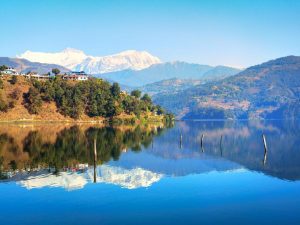
Beauty of Pokhara: A Guide to Nepal’s Hidden Gem
The Pokhara Valley is located among magnificent lakes at the foot of the Annapurna Mountain Range, which is home to three of the ten tallest mountains in the world. Pokhara is a beautiful location with the ideal balance of activity and rest. Visitors and nature lovers must visit this city in the foothills of the Himalayas because of the stunning snow-capped mountains and crystal-clear lakes that surround it.
Reasons to Visit Pokhara
Every type of traveler can find something to enjoy in Pokhara. It is a popular destination to visit whether you want to view the mountains, lakes, or all of its numerous attractions. It is the second-largest city in Nepal. Everything you require to have a memorable trip is in this city. This applies regardless of your preferences—adventure, a love of nature, or a quiet break. Following are some of the main motives people travel to Pokhara:
Adventure Activities
Pokhara is a haven for adventure enthusiasts. You can try anything from paragliding, bungee jumping, and zip-lining to rafting, kayaking, and rock climbing. So, you now know that the city offers a variety of thrilling activities that are sure to get your adrenaline pumping.
Scenic Beauty
The city is surrounded by stunning natural beauty that will take your breath away. Everywhere you look you’ll see clean localities with green hills surrounding the valley. You;’ll also see snow-capped peaks of the Himalayas, the pristine lakes, and the lush green forests make for a breathtakingly beautiful landscape that is hard to beat.
Relaxation
Don’t mention the relaxing activities you can indulge in while you’re in the city. From eastern yoga classes to western spa treatments, there are plenty of opportunities to unwind and recharge your batteries.
Cultural Experience
The city has a lots of temples and a rich cultural heritage. Furthermore, there are many monasteries, and museums allong with the hindu temples to explore. You can also participate in traditional festivals and events, and sample the local cuisine, to get a true feel for the local culture.
Must-Visit Places in Pokhara
Pokhara has many breathtaking attractions that are sure to leave you in awe. Here are some of the must-visit places in the city:
Phewa Lake: This magnificent lake is Pokhara’s focal point and is encircled by forested hills, snow-capped mountains, and temples. It is the second largest lake in Nepal, measuring roughly 4 km in length and 2 km in width. You may take a leisurely boat ride on the lake after paying a small fee. when you do so, you can visit nearby temples like the Tal Barahi Temple, or just rest by the shore and take in the stunning scenery.
Sarangkot: This tiny settlement perched atop a hill provides sweeping views of Pokhara and the Himalayas. At 1,592 meters above sea level, the hill is situated. Since Sarangkot offers some of the greatest views of the sun setting and rising over the Himalayas, many people consider it to be the ideal place for paragliding. Both domestic travelers and tourists from foreign countries like visiting Sarangkot.
Annapurna: One of the most beautiful mountain ranges in the world, the Annapurna Range is easily reachable from Pokhara. Some of the most well-known hiking routes in the world may be found in this range, which is home to over 20 peaks, including the 8,091-meter Annapurna I. There are many trekking opportunities available, ranging from short, easy climbs to multi-day treks, whether you’re an experienced hiker or simply enjoy picturesque walks.
Davis Fall: Nature lovers should definitely visit Davis Falls, a magnificent waterfall that is only a short stroll from Pokhara’s downtown. The waterfall creates a tranquil and beautiful ambiance as it flows into a large pool. Davi and his wife, a Swiss couple who are believed to have passed away close to the falls, gave the falls their name. Visitors can get near to the roaring water because the falls are situated in a small gorge and are reachable by a number of bridges and walkways.
How to Get to Pokhara
Pokhara is easily accessible from Kathmandu, which is the capital city of Nepal. The distance between the city full of lakes and Kathmandu is roughly 190–200 kilometers. You have the option of traveling there by plane, bus, or private vehicle. You can also stop along the way and visit the attractions on the road if you pick the option of roadways. The flight from Kathmandu to Pokhara lasts for around 30 minutes, while the bus ride lasts for almost 7-8 hours.
Conclusion
In conclusion, Pokhara is a place that combines natural beauty, adventure (if you’re ready for it), and cultural experiences in the ideal way. This hidden gem offers plenty to offer everyone, whether you’re an adventure seeker, a wildlife enthusiast, or just searching for a calm escape. Why not book your next trip to Pokhara right away and experience the splendor of this undiscovered treasure for yourself?
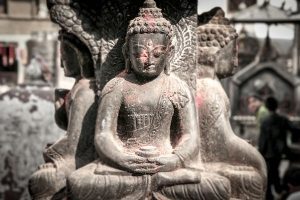
What Does Namaste Mean? Explained Simply
“Namaste” is a common greeting in Nepal, India, and other parts of South Asia. It is derived from the Sanskrit language and is a combination of two words, “namah” which means “bow,” and “te,” meaning “to you.”
In Nepal and generally, everywhere, the Namaste gesture is typically made by pressing the palms of the hands together and bowing the head as a sign of respect and recognition of the divine in the person being greeted.
The word can be translated to mean “I bow to you.” It is a gesture of respect and humbleness and is often used as a way to greet someone or show gratitude.
Where does Namaste Come From?
The term “namaste” is derived from Sanskrit, an ancient language of South Asia that is still widely employed in yoga and is mostly utilized by Hindu priests for religious rites. Namaste is a Sanskrit term that is still commonly used today to greet or gesture, usually to a senior or older. It is also commonly used in yoga programs.
Namaste is typically accompanied by a hand gesture that involves bringing the thumbs up to the sternum, closing one’s eyes, and bending one’s head. Another way to do it is to bow your head, put your palms together, and bring your thumbs between your eyebrows.
Global Recognition
Namaste has gained recognition and popularity beyond South Asia, becoming a symbol of peace, harmony, and mindfulness in global cultures, especially in yoga and wellness communities.
Namaste in Yoga
As cultural practices are borrowed and modified over time, they naturally alter. Namaste and its current usage in Western yoga are no exception.
In yoga, the phrase “Namaste” signifies acknowledging and honoring the divine essence that resides inside us. After class, the teacher will say “Namaste” as a sign of respect and gratitude for the students. Rather than using Namaste as a greeting, most students will repeat it to the teacher as a way of saying “thank you.”
Namaste has a deeper spiritual meaning in this context: “The divine in me honors the divine in you.” We try to establish a bond with each other by feeling a common love and appreciation, realizing that we are all equal and one.
What’s the Difference between Namaste and Namaskar?
When paying tribute to someone, namaste and namaskar are generally accepted as synonymous terms. When someone is highly esteemed, powerful, and spiritually significant, they are typically called namaskars. Think about how you are politely welcoming the Sun while you perform the Surya Namaskar.
Significance of Namaste in Different Religions
Significance of Namaste in Hinduism
In the Hindu faith, Namaste is commonly used as a formal greeting, similar to saying “hi” or “goodbye.” It is also employed when addressing elders or spiritual leaders to convey respect and humility. By recognizing the inherent divine spark in everyone, this gesture promotes a calm and non-violent mode of communication.
In Nepal, Namaste is deeply ingrained in both formal and informal contexts, as it symbolizes reverence, humility, and acknowledgment of the sacred essence within each individual.
Significance of Namaste in Buddhism
Namaste holds significance in Buddhism as well, representing respect and modesty. When greeting someone, Buddhists bring their hands together in a prayer-like position, pointing their fingers towards the person being greeted, and often accompany it with a slight bow. Buddhists also use Namaste as a way to express gratitude towards the Buddha and to acknowledge the interconnectedness of all beings on a spiritual level.
Significance of Namaste in Jainism
In Jainism, the phrase “Namaste” is used to express respect and humility towards others. Similar to the Buddhist greeting, Jains join their hands in a prayer-like gesture, pointing their fingers towards the person being greeted, and adding a slight bow. Jains also use the greeting “namaskar” to acknowledge the spiritual interconnectedness of all living things and emphasize the values of nonviolence and compassion in their daily lives.
Variations of Gestures in Namaste
Here are some variations of the Namaste gesture found around the world:
- India and Nepal: In these countries, the traditional Namaste gesture involves pressing the palms together in front of the chest with fingers pointing upward, accompanied by a slight bow of the head. The placement of the hands can vary from chest level to forehead level, depending on cultural norms and personal preference.
- Thailand: The Thai greeting, known as the “wai,” bears resemblance to Namaste. It involves pressing the palms together in a prayer-like gesture accompanied by a slight bow of the head. The height at which the hands are held can indicate the level of respect or formality.
- Japan: In Japan, the gesture of bowing, known as “ojigi,” is commonly used as a sign of respect and greeting. While not identical to Namaste, it shares similarities in its expression of humility and acknowledgment of others.
- Tibet and Bhutan: In Tibetan and Bhutanese culture, the gesture of greeting is known as “namaskar” and is similar to Namaste. It involves pressing the palms together in front of the chest, accompanied by a slight bow of the head.
- Indonesia: The traditional Indonesian greeting, called the “salam,” involves placing the hands together in a prayer-like gesture similar to Namaste. However, the hands are often placed at chest level or higher, and the gesture may be accompanied by a slight bow or nod of the head.
- Western Adaptations: In Western cultures, the Namaste gesture has been adopted in various contexts, particularly in yoga and mindfulness practices. While the basic form remains the same, individuals may modify the gesture based on personal preference or cultural influences.
Why Do We Offer Others Namaste?
In Hinduism, Namaste holds deep spiritual significance, rooted in the belief that every individual possesses a divine essence or spark, known as the Atman. The gesture of Namaste is a recognition of this divine presence within oneself and others. Here are some key insights into the spiritual context of Namaste:
- Divine Essence within All Beings
- Unity and Oneness
- Namaskar to the Divine
- Respect and Humility
- Yogic and Meditative Practice
- Cultural Expressions
Usage Namaste in Everyday Life
Saying Namaste with genuine intention is an act of affirmation. Choosing to apply the spiritual principles learned in a class to your life outside of a yoga or meditation practice is an intentional decision. Namaste is a greeting that is similar to an agreement to treat one another with respect on an equal footing.
Christopher Wallis explains how this realization may change the way you live in The Recognition Sutras.
Everything you do becomes an act of reverence once you realize the genuine essence of existence. Living your regular life with complete awareness turns it into a meditation practice, an ideal kind of worship, and an offering to all living things as well as to existence itself. Tantra teaches that all activities are actually the divine investigating, reverencing, and adoring itself because there is only one in the universe.
In everyday life, Namaste transcends its role as a mere greeting and becomes a multifaceted gesture used to express various emotions and sentiments. Here’s how Namaste is commonly employed beyond just a simple hello.
- Greeting
- Farewell
- Gratitude
- Reverence
- Cultural Etiquette
- Mindful Practice
Conclusion
The gesture does not need to be made in the direction of another person. As a kind of self-meditation, you might say “namaste” to oneself. Sadhguru claims that “Namaskar brings harmony between two polarities within.” It eliminates any dualistic feeling inside.
It is also a powerful method for improving social interactions. He claims that you can practically immediately see improvements when you bring your palms together and focus your loving attention on the person or circumstance you are honoring.
It will take you three to five minutes to start harmonizing. Peace and Namaskar. Give yourself a loving Namaskar. As he says, “Namaskar yourself into union.”
FAQs
- Can “namaste” be used in a non-spiritual context?
Despite having spiritual overtones, the phrase “namaste” can also be used in secular or non-spiritual contexts. Similar to saying “hi” or “goodbye,” it can simply be used as a formal and respectable approach to welcome or part ways with someone.
- Is it necessary to say “namaste” in a yoga class?
Although it is customary to say the word at the end of a yoga session, it is not required. The choice to utilize it or not is ultimately up to the individual, but it is a method to demonstrate respect and gratitude to the instructor and other pupils.
- Is there a difference between saying “namaste” and “namaskar”?
Although “namaskar” is seen as a more formal or courteous style of greeting, the words “namaste” and “namaskar” are similar and frequently used interchangeably. It is used to express reverence and to see the divine in others.
- Is Namaste hello or goodbye?
It is a common greeting, which is used both as a hello and a goodbye. So, you can use this when you meet or depart with someone.
- What does “Namaste” mean literally?
As mentioned earlier, Namaste means “greetings to you.” Originally found in the Vedas as a salutation to divinity, the usage and meaning of namaste have evolved. Today, among Hindi speakers worldwide, namaste has become a simple greeting to say hello.
- What are the three meanings of namaste?
Namaste carries three main meanings. First and foremost, it is an expression of appreciation and respect towards another person, entity, or deity. It can be used as a greeting when meeting someone or as a farewell when parting ways.
- Is it acceptable to say namaste?
Yes, it is perfectly acceptable to say namaste. Many people find it a meaningful and beautiful word, as long as it is used with respect and understanding of its cultural significance. It is important to acknowledge the roots of this sacred expression and use it appropriately.
- Is Namaste exclusively for Hindus?
No, namaste is not exclusively for Hindus. It is a non-contact form of greeting, offering a respectful and peaceful way to acknowledge others. Whether a person is Hindu or non-Hindu, it is perfectly acceptable for individuals from different cultures to use namaste as a form of salutation.
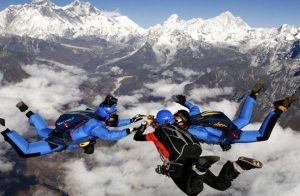
Skydiving over Annapurna range in Pokhara
If you’re an adrenaline lover, skydiving is an adventure sport that’ll keep you on your toes. Most people assume they would never be able to afford skydiving when discussing it because it is so pricey compared to other adventure sports. But these days, skydiving in Nepal is reasonably priced.
Pokhara is one of the most gorgeous valleys in Nepal. It is surrounded by spectacular Himalayan peaks including Mount Annapurna, Dhaulagiri, Fishtail, and Manaslu, and is encircled by emerald lakes. The Skydiving experience over Annapurna will allow you to see and enjoy all these locations while falling from the sky.
Skydiving in Pokhara
Pokhara is widely recognized as the starting point for several well-known trekking routes in the Himalayas, such as the Annapurna Basecamp, Upper Mustang, Annapurna Circuit, Ghorepani Poonhill, Jomsom-Muktinath, as well as a destination for leisurely excursions and relaxation.
Pokhara, known as the “Gateway to the Himalayas,” is the perfect place for an adventure like skydiving. And what better way to take in the stunning views of the Annapurna range than by jumping out of a plane and free-falling while enjoying the view?
Similar to paragliding, skydiving has become increasingly popular in recent years. The city has a few drop zones that offer skydiving experiences, and the most popular one is the one that offers skydiving over the Annapurna mountain range.
Safety Measures for Skydiving in Pokhara
Any adventure sport, including skydiving, has safety as its primary priority. To make sure you are at ease and confident before you dive in, you will go through a thorough training program with knowledgeable instructors. The gear used for skydiving is also of the highest quality and is routinely serviced to guarantee that it is in flawless operating order.
The instructors who will be accompanying you during the jump are highly experienced and have undergone rigorous training. They have completed hundreds of jumps and have the necessary skills and knowledge to ensure that you have a safe and enjoyable experience.
The instructors will be with you from the moment you arrive at the drop zone until the end of the jump. They will provide you with the necessary equipment, brief you on the safety procedures, and assist you throughout the jump.
The Jump: What to Expect
West of Phewa lake, you need to take a drive to the Pame Danda drop zone. Your professional crew members will provide you with skydiving instructions. Once you are all set, it’s time for the jump!
You will be jumping from an altitude of 13,000 feet and will experience a free-fall for around 60 seconds before the parachute is deployed. During the jump, you will be accompanied by an experienced instructor who will guide you through the experience.
And the best part? As you soar into the air, you’ll be able to admire the stunning vistas of the Annapurna range. The jump will last for about 5-7 minutes, and then you can watch a video of it to relieve the sensation.
As you softly descend to the ground after the parachute has been deployed, you’ll feel calm and quiet. The vistas are truly stunning from above. The stunning mountain ranges include the Annapurna I, Dhaulagiri, and many other peaks. You’ll also see emerald-green woods, and crystal-clear lakes will all be visible to you. The experience will live with you forever.
Planning Your Skydiving Adventure in Pokhara
In Pokhara, skydiving experiences can be quickly and easily reserved. Numerous tour operators in the city provide skydiving packages. If you’d want to attempt it, our experts at Pokhara Info can add skydiving to your trip schedules. It’s a good idea to reserve your leap far in advance to ensure a spot.
Skydiving is not always inexpensive, however, compared to Everest, Pokhara offers a more economical option. Foreigners should prepare to spend roughly $1000, while Nepalis can enjoy the dive in Pokhara for around Rs 70,000.
As you prepare for your trip, be sure to include warm clothes, supportive footwear, and a camera to capture the moment. In Pokhara, September through November are also the best months for skydiving.
Finally
You shouldn’t pass up the opportunity to skydive over the Annapurna range in Pokhara if you ever get a chance. You will be able to enjoy the exhilaration of free-falling as well as the breathtaking vistas of the Himalayas.
Although skydiving is not for the faint of heart, it is an experience you won’t soon forget. The feeling of free-falling through the air is definitely unforgettable, and the views of the Annapurna range from above are simply breathtaking.
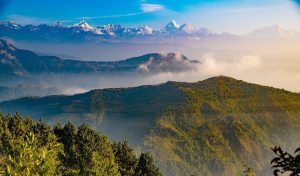
Discovering Tranquility: Short Hikes from Pokhara
If you’re in Pokhara, you don’t need to trek for several days to see the mountains. A trekker’s delight, the area north of Pokhara provides a variety of short hikes that can last for as few or as many days as you wish.
These quick hikes surrounding Pokhara will reward you with breathtaking views of the Dhaulagiri, Machhapuchare, Nilgiri, Annapurna, Manaslu, and other mountains, as well as charming hill towns populated by welcoming locals.
Begnaskot Hiking
The hilltop of Begnaskot is located on the northeastern end of Pokhara Valley. The locations offer a panoramic view of various mountain ranges, the Pokhara Valley, and a rolling green hillside. The hike provides a comprehensive understanding of mountain culture and way of life.
Sundari Danda, a prime example of Nepali agricultural tourism, is located across the road. Along the way, you can see Nepali villages and their daily activities as well as various views of the country’s lush hills, lakes, and valleys. A village of multicultural residents engages in agriculture and fishing as their everyday jobs.
Sikles
Sikles is a village in the northeast of Pokhara and one of the biggest Gurung villages. The journey showcases Nepal’s natural and cultural aesthetic splendor. The village is recognized as one of the primary sources of the Gurung people. Additionally, “Sat Saya Sikles” refers to a community of 700 households.
You can take a stroll through rhododendron forests, a variety of terraced hillscapes, plain lowlands, and lovely settlements. Sikles has its modest hydropower plant, thus load shedding is not an issue. The guesthouse amenities and handicraft creations are enjoyable.
Sarangkot
The three-hour journey uphill from Lakeside Pokhara is the shortest and simplest trek from Pokhara. The hill town is a well-liked one-night getaway because so many travelers stop there to take in the sunrise over the Annapurna range.
It is a lovely location for stunning views of the sunrise and sunset. Spectacular mountain range pink and orange colors occasionally. The expansive view of Pokhara, Fewa Lake, the sea of verdant hills, and the chain of snow-capped peaks will be to your liking. At Pokhara, it is a well-known paragliding location from which to soar over the valley and verdant trees. Trekking to Dhampus is an option if you want to make your trip a bit longer or more exciting.
Dhampus
The Dhampus village hike is one of the greatest hiking routes from Pokhara for families, slow trekkers, and kids. Dhampus hamlet, located at 1600 meters, is home to the friendly and welcoming Gurung people.
The technical aspects of climbing the mountain are simple. Dhaulagiri, Fishtail, Tukuche Peak, and other peaks are visible from Dhampus. It is possible to prolong this journey up to Pothana Village and Australian Camp, however, day hikes from Pokhara are the most common option.
Royal Trek
Prince Charles trekked the Royal Trek trekking route in the 1980s in Nepal’s Annapurna region. The best views and warmest hospitality are provided by the locals, making the royal walk truly royal. Along the trek, you must traverse fascinating valleys and challenging ridges. Within a short drive of Pokhara, you may see rare plants, animals, a vibrant culture, and ancient traditions.
The Gurung people who inhabit these paths are friendly and welcoming. They are eager to share with you their culture, delicious foods, libations, and attire. The towering terrace farms are a striking feature that is best captured on camera.
The huge Annapurna Mountain range forms the backdrop to the entire panorama, appearing to practically dissolve into the sky above. When there are few clouds in the sky in the spring, the mountain ranges are usually visible.
Naudada Hike
The Naudanda hikes are the finest if you’re searching for a quick escape from your busy life or to spend time with your friends and family on the weekend. A short climb near Pokhara that has recently gained popularity is the Naudanda day hike. On the route to Sarangkot, is a small town in the Kaski district.
One of the best areas to experience Nepali rural life is along the route. Views of the mountains, Phewa Lake, the Pokhara Valley, paragliding, and high-altitude terrace farming. It is a Gurung village where you may learn about the customs and diverse cultures of several ethnic groups.
At 1600 meters above sea level, you can enjoy the walk to Naudada. After your energetic walk, a classic Himalayan view is rewarded, especially on clear mornings.
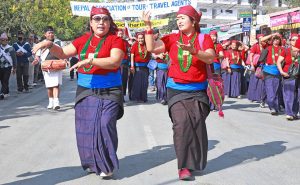
How Pokhara Celebrated the 24th Street Festival
Every year, the Pokhara Street Festival gets going in the city of Pokhara. The program is organized by the Restaurant and Bar Association (REBAN) Pokhara, Nepal. It’s an awesome way to show off the unique culture and customs of the place and brings people from everywhere to check it out with the slogan ‘Eat on the road, enjoy on the road’. The 24th Pokhara street festival took place from 28th Dec of 2022 to 1st of 2023 on the main street of the city where thousands of people participated.
The street festival is one of the biggest cultural shows in the country. The festival included traditional and cultural dance performances, floats displaying the richness of Pokhara’s culture, and more.Vehicles were prohibited from the designated area from Fishtail gate to Jarebar.
At night, the Lakeside area is all lit up and the partying gets even better with live music acts! There were all sorts of options, like food and clothing vendors, plus activities for the kiddos. And to top it off, they had Lok-Dohori shows in the afternoons.
At the festival there were plenty of things to do, like cultural performances, art and food exhibitions, Dohori singing competitions, parades, night concerts, boat races, veterans tennis tournaments, waiter races, tug-of-war and documentaries about popular spots in Pokhara.
The last day of the festival was also the inauguration of Pokhara international airport. After Kathmandu and Bhairahawa, Chinnedanda will house the $216 million international airport that would serve as Nepal’s third international hub. The construction of the new airport took five years and five months to complete. People are now quite enthusiastic about the new infrastructure and its potential to revitalize the tourism industry after three years of uncertainty. Overall, The new Pokhara International Airport will eventually aid in increasing the amount of tourists. PM Puspa Kamal Dahal inaugurated the airport on the new year’s day.
Aama Samuha from all around Pokhara got behind the festival. People got to see all sorts of tasty treats using traditional cooking techniques and tools. Different villages’ mom groups set up homestays to help push rural tourism, and they made local organic food too. The goal was to help out rural tourism while also highlighting traditional Nepali foods like millet bread and momos.
At the festival, there was lots of local food plus a bunch of other cuisines like Indian, Chinese and Continental. The restaurants and food stalls were even giving out deals and discounts to entice people. The Pokhara Street Festival was awesome! It had great food and was a cool way to experience Nepali art and culture.
The festival was created to educate both local travelers and students about Nepalese culture and arts and to give foreigners a better understanding of the country and its people.
Organizers spread the word about the festival by doing promotional campaigns in cities both in Nepal and overseas.
At the festival, people had the chance to watch a cultural parade put on by various communities, like Gurung, Magal, Bujel, Tal, Kilat and Newar. Those who attended had a blast grooving to bhajans, chutkas and panche bhajas (a set of five traditional Nepalese musical instruments) in the streets.
The business owners in Pokhara reckon the festival has become well-known all over the country. It has really helped to promote activities such as paragliding in Pokhara and homestays in and around Kaski, and it brings in a ton of people from within Nepal. During the festival period, hotels were packed.
People from all across the city and from many backgrounds joined together for the 24th annual Pokhara street festival, which was a blast. The local economy benefited greatly from it, and tourists also got to experience Pokhara’s rich cultural diversity through the vendors and artists who sold their wares to the large audience that attended.
In summary, the 24th Pokhara Street Festival was a huge success celebrating the city’s culture and traditions. It brought everyone in town together and provided a platform for local artists and vendors to showcase their work.
If you wish to enjoy the 25th Pokhara street festival, stay prepared and we have got your traveling activities covered.
After you’ve enjoyed the thrilling and joyful experience, you can choose whether to visit other beautiful places in Nepal or head back home. No matter what you choose, we hope you have a fantastic time.
We can accommodate group tours for this trip; however, you may also opt for a private tour according to your liking. We can arrange private trips at any time of the year at any date of your choosing. Please let us know what your preferred travel dates are so that we can accommodate you.
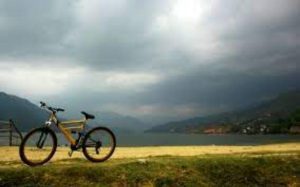
Best Outdoor Activities in Pokhara
Pokhara is a beautiful city located in the western part of Nepal. It is known for its picturesque landscape and breathtaking natural and outdoor beauty. Situated in the picturesque Annapurna region of Nepal, it is known for its stunning natural beauty and outdoor adventure opportunities. Along with trekking and hiking, the city offers a range of sports activities for visitors to enjoy. Here are some sports that you can indulge in during your stay in Pokhara.
Trekking
There are many trekking routes in the area that offer breathtaking views and a chance to explore the region’s unique culture and wildlife. Some popular trekking routes in the Pokhara area include the Annapurna Circuit, the Annapurna Base Camp trek, and the Poon Hill trek. Trekking in Pokhara allows visitors to explore the beautiful Annapurna range, which includes several peaks over 7,000 meters. The most popular trek is the Annapurna Circuit, which takes around 10-12 days to complete. It offers breathtaking views of the Himalayan mountains, as well as the opportunity to experience the local culture and traditions of the Gurung and Thakali people.
Paragliding
Pokhara is a popular destination for paragliding enthusiasts, with its scenic views and perfect weather conditions. Paragliding in Pokhara offers breathtaking views of the Annapurna mountain range, Phewa Lake, and the surrounding landscapes. With experienced pilots and state-of-the-art equipment, visitors can soar above the clouds and experience the thrill of flight. Many paragliding companies in Pokhara offer tandem flights for beginners, as well as advanced courses for experienced pilots. Some popular takeoff points for paragliding in Pokhara include Sarangkot, Kaskikot, and Dhampus. Paragliding in Pokhara is a thrilling experience and is perfect for those looking for an adrenaline rush.
Rock climbing
Rock climbing in Pokhara, Nepal, is a popular activity for adventure seekers and climbers. Located in the Annapurna region, Pokhara offers a variety of rock climbing options for beginners and experienced climbers. The most popular climbing areas in Pokhara include:
Sarangkot: Sarangkot offers beginner-friendly routes as well as more challenging ones for experienced climbers.
Ratnamali Hill: Located in the heart of Pokhara, Ratnamali Hill offers a variety of routes for climbers of all levels.
Mahendra Cave: The Mahendra Cave is a popular spot for climbers looking for a unique experience. It offers a series of challenging routes through a natural cave.
Khahare Danda: Khahare Danda offers a mix of easy and difficult routes for climbers of all levels.
Begnas Lake: Begnas Lake is a great spot for climbers looking for a scenic climb with beautiful views of the lake and surrounding mountains.
Kayaking
Pokhara, located in the beautiful Annapurna region of Nepal, offers a unique and exciting kayaking experience. With its stunning natural beauty, clear waters, and abundant wildlife, kayaking in Pokhara is a must-do activity for adventure seekers.
There are several popular kayaking routes in Pokhara, including the Phewa Lake, the Mahendra Cave, and the Seti River. Phewa Lake, the second-largest lake in Nepal, offers calm waters and stunning views of the Annapurna range. The Mahendra Cave, located on the outskirts of Pokhara, is a natural cave formed by the Seti River and offers an exciting kayaking experience through its winding passages. The Seti River, with its white-water rapids, is perfect for those looking for a more thrilling kayaking adventure.
No matter which route you choose, kayaking in Pokhara is sure to be an unforgettable experience. The beauty of the surroundings, the serenity of the waters, and the thrill of the ride make it an activity not to be missed.
Mountain biking
Pokhara is a great destination for mountain biking enthusiasts, with a variety of trails that cater to different skill levels and preferences. Some popular options include the Annapurna Circuit, the Royal Trek, and the Kali Gandaki Valley.
The Annapurna Circuit is a challenging route that takes riders through some of the most stunning landscapes in the Annapurna region. The route starts at Besisahar and heads north to reach the Thorong La Pass, offering breathtaking views of the surrounding peaks and valleys. The trail then continues south to Jomsom and back to Pokhara.
The Royal Trek is another popular option, with a relatively easy trail that takes riders through traditional villages and stunning views of the Annapurna range. The route starts from Begnas Lake and heads north to reach the scenic Rupa Lake before returning to Pokhara.
The Kali Gandaki Valley is another beautiful destination for mountain biking, with a trail that follows the Kali Gandaki River and offers views of the Annapurna and Dhaulagiri ranges. The route starts at the town of Beni and heads north to the village of Jomsom before returning to Pokhara.
Overall, Pokhara offers a great range of options for mountain biking enthusiasts, with trails that cater to different skill levels and preferences. Whether you are a beginner or an experienced rider, there is a trail in Pokhara that will suit your needs.
Rafting
Pokhara is a popular destination for rafting due to its beautiful scenery and thrilling rapids. The Kali Gandaki and Seti rivers offer a range of rafting options for beginners and experienced rafters alike. Rafters can enjoy the stunning views of the Annapurna range and other Himalayan peaks as they navigate the rapids. Many tour companies offer guided rafting trips, providing all necessary equipment and safety instructions. The Seti and Trishuli rivers that flow through Pokhara offer exciting rafting opportunities for adventure seekers. The Seti river has gentle rapids and is perfect for beginners, while the Trishuli river has more challenging rapids for experienced rafters. You can join a guided rafting tour or rent equipment and explore the rivers on your own.
Fishing
Fishing in Pokhara is a popular activity for tourists and locals alike. The city is located near several major rivers and lakes, providing ample opportunities for fishing. Some popular spots for fishing in Pokhara include Phewa Lake, Seti River, and Mahendra Cave. Fish species commonly caught in the area include mahseer, catfish, and carp. Visitors can hire a boat and fishing gear from local vendors or join a fishing tour to experience the thrill of fishing in Pokhara. Pokhara’s Phewa Lake is a popular spot for fishing, with its abundance of fish species such as rainbow trout and mahseer. You can rent fishing equipment from the lakeside and try your luck at catching some fish. Fishing in Pokhara is a relaxing and peaceful activity and is a great way to unwind after a day of adventure sports.
In conclusion, Pokhara offers a wide range of sports activities for visitors to enjoy. From paragliding and rock climbing to kayaking and mountain biking, the city has something for everyone. Whether you are an adventure seeker or a nature lover, Pokhara has something to offer for every type of traveler. So, if you are planning a trip to Pokhara, remember to indulge in some of these exciting sports activities. If you want some help, we have got you covered.
After you’ve enjoyed the thrilling and joyful experience, you can choose whether to visit other beautiful places in Nepal or head back home. No matter what you choose, we hope you have a fantastic time.
We can accommodate group tours for this trip; however, you may also opt for a private tour according to your liking. We can arrange private trips at any time of the year at any date of your choosing. Please let us know what your preferred travel dates are so that we can accommodate you.
Finally, we will transfer you to Pokhara’s domestic airport after breakfast for your flight back home to Kathmandu. Furthermore, if you are flying back home from Kathmandu today, please schedule your flight to depart no earlier than 11 am to ensure you’ll have enough time to catch your flight
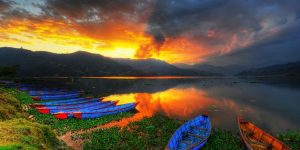
How to Spend Week Long Vacation in Pokhara?
Pokhara is a city in Nepal that is known for its natural beauty and rich culture. Located in the central region of the country, it is the second-largest city in Nepal and is a popular destination for trekkers and adventurers who are looking to explore the Annapurna mountain range.
One of the best things about Pokhara is its stunning location. The city is situated on the banks of Phewa Lake, which is the second-largest lake in Nepal. The lake is a beautiful sight to behold, with crystal clear waters and a serene atmosphere. The city is also surrounded by the Annapurna mountain range, which provides a stunning backdrop to the city.
Another reason why Pokhara is a great place to visit is its rich cultural heritage. The city is home to a number of temples, such as the Tal Barahi Temple, which is situated on an island in the middle of Phewa Lake. The temple is a popular spot for pilgrims and tourists alike and offers a unique insight into the cultural and spiritual life of the city.
In addition to its natural beauty and cultural attractions, Pokhara also offers a range of activities and adventures for visitors to enjoy. Trekking is one of the most popular activities in the area, with the Annapurna mountain range offering a range of trails for hikers of all levels. The city is also a popular spot for paragliding, with the views of the mountains and lake providing a truly unforgettable experience.
There are also plenty of other things to see and do in Pokhara. The city is home to a number of museums and galleries, which offer a fascinating insight into the history and culture of the region. There are also a number of markets and shops in the city, where visitors can buy souvenirs and handicrafts, as well as sample the local cuisine.
Overall, Pokhara is a truly incredible place to visit. Its natural beauty, rich cultural heritage, and range of activities and adventures make it an ideal destination for anyone looking to experience the best of Nepal. Whether you are a trekker, an adventure seeker, or simply looking to immerse yourself in the local culture, Pokhara has something for everyone.
Pokhara is popular among tourists for its natural scenery and outdoor activities. Here are a few suggestions for how to spend a week in Pokhara as a tourist:
- Visit Phewa Lake and go boating on the lake to get a beautiful view of the surrounding mountains.
- Hike up to Sarangkot Hill for sunrise or sunset and enjoy the panoramic view of the Annapurna range and the city below.
- Go paragliding to get a bird’s eye view of the city and the surrounding landscape.
- Visit the International Mountain Museum to learn about the history and culture of mountaineering in Nepal.
- Take a day trip to the Peace Pagoda, a Buddhist monastery that offers a peaceful and serene environment to relax and meditate.
- Explore the caves at Mahendra Gufa and learn about the unique geology and history of the region.
- Visit the Gurkha Museum to learn about the history and culture of the Gurkha people. People know them for their bravery and martial prowess.
If you want any activity-specific tour, you can choose one of these specific topics.
- Boating on Phewa Lake: Phewa Lake is a picturesque lake in the center of Pokhara, and a popular spot for boating. You can rent a boat and explore the lake at your own pace, or take a guided tour to learn more about the history and culture of the area.
- Hiking and trekking: Pokhara is surrounded by the Annapurna mountain range, which offers numerous hiking and trekking opportunities. You can take a day hike to Sarangkot Hill for panoramic views of the mountains, or go on a longer trek to the base camp of one of the many peaks in the region.
- Paragliding: Pokhara is one of the best places in the world for paragliding, thanks to its scenic landscape and favorable weather conditions. You can go paragliding to get a bird’s eye view of the city and the surrounding mountains.
- Visiting museums: Pokhara is home to several interesting museums that provide insight into the history and culture of the region. You can visit the International Mountain Museum, the Gurkha Museum, or the Peace Pagoda Museum to learn more about the people and history of Pokhara.
- Exploring caves: Pokhara is home to several natural caves, including Mahendra Gufa and Bat Cave. You can explore these caves to learn about their unique geology and history, and see the fascinating rock formations inside.
If you want to visit Swayambhunath, we have got you covered.
After you’ve enjoyed the thrilling and joyful experience, you can choose whether to visit other beautiful places in Nepal or head back home. No matter what you choose, we hope you have a fantastic time.
We can accommodate group tours for this trip; however, you may also opt for a private tour according to your liking. We can arrange private trips at any time of the year at any date of your choosing. Please let us know. If you have the opportunity to go to Nepal, you now know which places to see first. Enjoy your experience, and have a safe journey.
Overall, Pokhara is a beautiful and interesting city that offers a wide range of activities and sights to explore. This makes Pokhara a popular destination for tourists who want to enjoy a trip to a new and exciting place.

Ten of the Best Places for First-time Pokhara Visitors
Call it a city of lakes, a holiday paradise or the ultimate tourist destination; Pokhara has all the charms you could ever ask for. Renowned for its magnificent landscapes, Pokhara is the most favored tourist destination in Nepal. It is also Nepal’s second-largest city in terms of its population.
Pokhara is the base city for many majestic trekking trails welcoming the likes of trekkers, backpackers and holidaymakers. One of the best places to rejuvenate your body, this metropolitan city is blessed with varied serene lakes, mountains, museums and the best spots for adventure sports that are sure to add enthralling experiences to your lifelong memories.
Let us dive into the list of top ten places to visit in Pokhara.
Fewa Lake
Fewa Lake is the second largest lake in Nepal and has a beauty that it’s truly overwhelming. The lake encompasses a total area of 4.43 square kilometers. Treating your eyes to the surreal reflections of alluring Mount Machhapuchre on a fine day in a paddling boat while on your way to Tal Bahi temple is a typically touristy thing you can do in Fewa Lake.
This freshwater Lake is one of the places in Pokhara that has visitors crowding the premise even during the week.
Tal Barahi
Tal Barahi is another spiritual retreat for Hindu pilgrims, which remains at the center of Fewa Lake. You gotta take a boat ride to reach this place of land in the middle of the lake.
The boats are always available; it would take just 10 to 20 minutes to get to the temple from the Bank of Lake. Tal Barahi is a small pagoda-style temple which is dedicated to Hindu goddesses and is popular because of its ideal location and the great religious value that it carries. This temple attracts many Hindu disciples who come to worship the goddess.
Davis Falls
Davis Falls might not sound new to many, including both the locals and international visitors, but how well do you know the history behind its famous name? Reportedly, a woman named Davi went swimming here on the 31st of July, 1961 but drowned due to the overflow of water.
To pay respect to his daughter, Davi’s father wished the name the place after her, hence the name. This canyon cascades down at the south side of Fewa well Lake. And the water passes through a cave called Gupteshwor Cave. After exiting the tunnel, it is called Patale Chango in Nepali and has scenery that can be used as stunning backdrops for photos and videos.
Gupteshwor Cave
Gupteshwor Cave is an ancient temple whose history dates back hundreds of years. It’s probably one of the longest caves in South Asia, which is located close to Davis Falls on the other side of the world peace pagoda. The passes through this cave are usually damp and dark. Those small light bulbs are facilitated to make them come in handy for tourists.
As you descend deeper, you can find several statues and shrines inside, the largest of which is dedicated to Lord Shiva.
Mahindra Cave
Amongst numerous caves in Pokhara, Mahindra cave is a popular site located close to the Seti River. It was named after the late King Mahendra Bir Bikram Shah.
A statue of Lord Shiva can also be seen inside the cave limestones in its natural and rare form of rock structures containing stalagmites. It attracts thousands of tourists every year. Artificial lights lighten the walls of this cave, giving it a shimmery and glittery outlook, which the sight Sears love to admire. A visit to Mahindra Cave is more of an adventure as you move further and deeper down the cave.
Pokhara Santi Stupa
Pokhara Santi Stupa is a pogoda-style Buddhist monument nestled in the top of the heel of Pumdikot. It adds yet another beauty to Pokhara and its marvels. The Suppa facilitates the site of the never-ending Himalayan range adoring the spectacular cityscape below while the blue Fewa lake sits perfectly. You could hike or cycle along the trails or travel by any other means to reach the spiritual retreat.
Sanangkot
Sanangkot, situated on Sanangkot hill, is a village of the same name, which is a game place you should not miss out on. When in Sanangkot, you could catch a riveting glimpse of the mountain sweep, including the Machhapuchre and Manaslu. Hiking to Sanangkot is one of the ways you can drown in the heavenly views of sunsets and sunrises. Moreover, the place is also a very popular spot for paragliding.
Bindabasi Temple
Bindabasi Temple is also known as the guardian deity of Pokhara. The Temple is a white pagoda temple that is situated near the old bazaar of the Pokhara. Goddess Durga, in the form of Parvati, is worshiped in the temple, hence holding a significant religious value. Lying 3000 feet up the sea level, the Bindabasi temple is overcrowded during the day of a major festival of Dashain when several people offer animal sacrifices to the goddess.
With a pleasant scent of loop and panoramic views, a visit to this temple can be accompanied by a stroll around the old bazaar.
Begnas Lake
Begnas Lake covers about 3.28 square kilometers of area. The Begnas Lake, or Begnas taal stands in the third position of the largest lakes in Nepal. It with lush Greens forest surrounding this lake and offering you the most tranquil and serene environment.
It is located on the southeastern side of the main city and is tentatively crowded. If you prefer to enjoy boating with a site of snowcap peaks, stand by the taal overlooking the gorgeous forest below with a sip of your preferred drinks. Then the visit to Begnas lake might just be perfect for you.
Mountain Museum.
The mountaineering museum has a history of its own in Nepal. And this is best showcased in the International Mountain Museum of Pokhara. Mysteries and important figures relating to not only the mountains of Nepal but also Japan, Slovakia, and other countries have been illustrated in this museum.
Additionally, you can find the rarest of Flora and Fauna collected from different parts of Himalayan reasons that are well preserved here. Models of several peaks, including Mountain Everest, mountain gear, and everything and anything associated with mountains are exclusively found. So, that’s the end of our list of the top 10 places to visit in Pokhara.
What do you guys think about the list, and what do you like the most about this beautiful valley? If you want to visit Pokhara, we have got you covered.
After you’ve enjoyed the thrilling and joyful experience, you can choose whether to visit other beautiful places in Nepal or head back home. No matter what you choose, we hope you have a fantastic time.
We can accommodate group tours for this trip; however, you may also opt for a private tour according to your liking. We can arrange private trips at any time of the year at any date of your choosing. Please let us know.
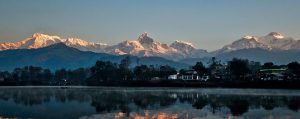
Best Short Distance Treks in Nepal
Many people visit Nepal for the beauty of the mountains, dreaming of climbing or trekking in the mountains. Others are attracted to the culture of Kathmandu, Chitwan, Pokhara, or any other city in Nepal, and still, others are hoping to achieve spiritual awakening. But, Short Distance Treks in Nepal are something everyone will surely love.
If you dream about trekking through the scenic landscapes of Nepal, you’ll always have lots of options. However, not all people can afford or manage long-distance treks but want to make the most of their time in Nepal. In Nepal, there are many destinations with short-distance trekking as well as equally mesmerizing locations and rewarding experiences for such people.
Do not fret if you plan to do some trekking in Nepal but do not wish to waste much of your time. We have compiled a list of a few of the best trekking spots in the country that can be completed within a week.
- Ghandruk Village Trek
- Mardi Himal Trek
- Trek to the Sikles Village
- Ghorepani and Poon Hill Trek
- Panchase Trek
Those trekking trails are sure to make for a fantastic trip, but if you still aren’t convinced, let’s look at them a bit more closely.
Ghandruk Village Trek
The trek to Ghandruk village introduces you to the typical hillside Gurung village. This is a popular gateway to the Annapurna Base Camp Trek and one of the best Short Distance Treks in Nepal. You have the opportunity to see the local tourism-related activities in the villages to make your trek more enjoyable. Furthermore, enjoy the view of alpine lakes, fields, and mountains, including Annapurna South, while sleeping in comfortable teahouses along the trails.
In terms of real village experience amidst massive Nepali cities, Ghandruk is one of the most beautiful ones out there and quite honestly mesmerizing. A Gurung museum is also located in the village. The trek is ideal for anyone looking for a short hike around Pokhara with easy trails and few climbs or descents.
- Preferable Season: All year round
- Trek Duration: Approximately five days
- Starting Point: Pothana
- Maximum Altitude: 1,940 meters
- Trek Permits: No
- Accommodation Type: Teahouse and Homestays
- Difficulty: Moderately Easy
Mardi Himal Trek
Mardi Himal Trekking is a relatively new venture in Nepal’s Annapurna region that features some splendid examples of Mother Nature in a clean and lively atmosphere. In just a few short years, the trek has gained a lot of popularity. There is nothing more refreshing than a short trek through the mountains of the Annapurna region, walking through amazing glacier villages and rarely seen landscapes.
As spring approaches, you will view the Rhododendron blossoms. Also, the locals are ready to provide you with warm and cozy accommodations. Plus, the Mardi Himal Trek is a completely unspoiled trail with surprises along the way. Unlike other treks, we do not need to repeat the same route because the trail circumnavigates the Mardi Himal.
As you trek through the Mardi Himal area, you’ll get a view of the Annapurna, Dhaulagiri, and Manaslu ranges, as well as the villages of Siding, Australian Camp, Pothana, and Lwang. Sheep and goat herders once used these trails to take their sheep and goats for grazing.
- Preferable Season: From March to May (Mild Weather) and from late September to early December (Cold Weather)
- Trek Duration: Approximately seven days
- Starting Point: Phedi
- Maximum Altitude: 4,250 meters
- Trek Permits: ACAP, TIMS
- Accommodation Type: Teahouse and Lodges
- Difficulty: Moderately Easy
Additionally, the trail is a great way to learn about the locals’ culture, festivals, lifestyles, customs, and practices and experience their hospitality. The locals are friendly and show you a great time.
Trek to the Sikles Village
You will walk through lush rhododendron forests and serene landscapes on the Siklesh trek. This trek will take you through the pristine hillside settlements beneath giant peaks. If you want to participate in some late-night singing and dancing during your stay, you can join Rodhi Ghar. Also, you can see the local handicrafts and participate in some tourism activities. Finally, you can explore the rich biodiversity of the area.
A well-preserved village located in the Kaski district, Sikles is one of the region’s earliest and largest Gurung settlements. Sikles is located on a hill at the height of 2,000 meters. Moreover, the villagers of Sikles village are primarily of Gurung ethnicity, and they are considered Nepal’s second-largest Gurung village. The distance from Pokhara city to Sikles villages is nearly 20 Km.
- Preferable Season: From March to May (Mild Weather) and from late September to early December (Cold Weather)
- Trek Duration: Approximately five days
- Starting Point: Bijaypur Khola
- Maximum Altitude: 2,000 meters
- Trek Permits: No
- Accommodation Type: Teahouse and Homestays
- Difficulty: Moderately Easy
Ghorepani and Poon Hill Trek
Ghorepani Poon Hill trek is one of the best short treks in the Annapurna region! It is suitable for hikers of all ages, particularly good for families with children, and it can be accomplished in a maximum of 4 or 5 days while still getting the experience of the Annapurna region. One of the best Short Distance Treks in Nepal.
You can enhance your trekking experience at Ghorepani by being able to see the beautiful Poon hills from this small village below Poon Hill, where the people primarily belong to the Magar community. The Poon Hill is also the best viewing point for Annapurnas, the Dhaulagiri and Varaha Shikhar mountains, the Nilgiri and Tukuche mountains, and Lamjung Himal.
- Preferable Season: All year round
- Trek Duration: Approximately five days
- Starting Point: Nayapul
- Maximum Altitude: 3210 meters at Poon Hill
- Trek Permits: ACAP, TIMS
- Accommodation Type: Teahouse and Homestays
- Difficulty: Moderately Easy
Panchase Trek
Panchase is a hillock in the Annapurna region that is renowned for its religious significance. The top of the hill is a great vantage point for taking in the amazing view of the Annapurna range. The varied landscape makes it a picturesque place. There are a lot of religious sites like Siddha Baba, Panchase Lake, Boudha Stupa, Caves, and terraced rice fields. Lush vegetation, alpine meadows, and terraced rice fields make it heaven on Earth.
From Panchase Hill’s peak, you can enjoy views of snowcapped mountains over 8000 meters. After walking for three to four days through dense jungle and alongside streams, you will finally reach the Himalayan range with its stunning sceneries.
- Preferable Season: From March to May (Mild Weather) and from late September to early December (Cold Weather)
- Trek Duration: Approximately four days
- Starting Point: Bundi
- Maximum Altitude: 2517 meters
- Trek Permits: No
- Accommodation Type: Teahouse and Homestays
- Difficulty: Moderately Easy
Purchase offers a wonderland of nature to city folks and foreigners alike. Located at an elevation of around 1500 meters and a few kilometers west of Pokhara valley, Panchase is distinguished by its natural beauty.
Our Trek Package Cost includes:
- Arrival & Departure transport via private Car/Van/Bus.
- Three meals per day throughout the Trip(Breakfast, Lunch & Dinner)
- Accommodation during the trek.
- Nights’ accommodation in Kathmandu with B/B.
- Guide and a porter with Insurance, food, and accommodations.
- Sightseeing in Kathmandu or Pokhara valley with a car and tour guide
- First Aid kit.
- Trekking permit (Conservation fee).
- TIMS card (Trekking information management system) is like a permit.
- All needed government tax/vat.
Our Trek Package Cost excludes:
- International Airfare.
- Your travel insurance.
- Sightseeing entrance fees
- Nepal Visa fee (US$ 50 for 30 days and US$ 30 for 15 days; you should get a visa open your arrival)
- Any kind of drinks, items of personal expenses like hot shower, battery charge, telephone, missing meal, WIFI Porters, etc.
- Tips for Guide and Porters
Finally, all the trekking destinations mentioned above are top-notch, thrilling and mesmerizing, and short at the same time. Short-distance treks in Nepal do not need much commitment, but they provide an abundance of thrill and joy. If you intend to, you can probably trek to all these locations within a month and have the time of your life. However, if you do so, be sure to cherish all the moments during the trek so the memories last forever in your memories.
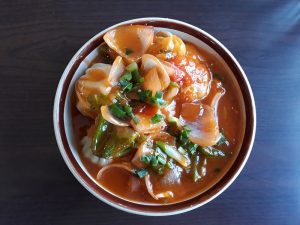
Exploring the Best Street Foods in Pokhara: From Momos to Chaat
Every travel experience is all about the destination, the culture, the journey, the activities, and most importantly, the food. No trip is complete without trying the local delicacies that a given place has to offer. Nepal is one such country that has lots to offer in terms of street food and local cuisine. Pokhara’s street food is renowned for its diverse flavors, so savor them while wandering around the streets.
For interested travelers looking into planning a trip to Pokhara, The following are some of the top food items a foodie can find in Pokhara’s streets. If you are a foodie, you know how these local street foods are popular and have great taste. Street foods often provide a more affordable option for enjoying delicious dishes.
20+ Must Try Street Foods In Pokhara
-
Momos
Momos are often called the national dish of Nepal. Most people recommend you try Momos as a main dish in Nepal. Momos come in different varieties. Momo is made with freshly made flour; inside the flour, you will find minced meat with a variety of spices in it. Momos is one of the top street foods in Pokhara. The best part of the momo is its chutney, which is a bit sweet, spicy, and tasty.
Most of the Pokhrelis love the momos from Mittho Momo which is located at Tundikhel of Pokhara. If you are a buff lover then this place will be best suitable for you.
-
Chowmein
Due to its affordable price and ability to fill you up, Chowmein is one of the most popular street dishes in Pokhara. Though the method of preparation is distinct, it is a unique kind of noodle. Spices are blended with noodles and other vegetables, meats, and peas. Chutney and ketchup are included.
One of the best places to have Chowmein is at Hemja, Milanchowk; it’s a very undervalued place to have it from Garbuja Khaja Ghar.
-
Samosa
Samosa is among one of the top-selling street foods in Pokhara. It is cheap and is available in most of the places of Pokhara food vendors. It is a crispy, flavourful snack with a savory veg filling such as minced potatoes, lentils, and peas. It is popular in its triangular forms.
The most famous place to have samosa is Fishtail Food Park which is located at the centre of the Siddhartha Chowk. In this location, Chicken Samosa is more famous than any other item.
-
Chatpatey
Chatpatey is one of the most popular snacks among teenagers. It is a must-have street food when you are traveling with your friends. It is quick and extremely easy to prepare. A mixture of noodles, onions, puffed rice, lime, coriander, and spices products with your liking.
People with different tastes and choices may have different places with their favorite spots but Chatpate Vendor at Gandaki Hospital Chowk opposite URL Hospital is one of the favorite spots of many youngsters in Pokhara.
-
Panipuri
It is a common street food in Nepal which is a breaded hollow spherical shell with an inch diameter, filled with finely sliced onions, potatoes, peas, and different spices mixtures. It is served with water, and lime with a chilly mixture.
If you want to taste the best Panipuri while you are in Pokhara, Model Hospital PaniPuri will be the best spot for you. It is located in Newroad, Pokhara.
-
Sekuwa
Sekuwa is roasted meat in a wooden fire which is made by mixing different spices. It can be made up of goat meat, buffalo meat, chicken meat, pork meat, and many others. If you want to taste the best sekuwa in Pokhara visit Halal Jhirr House. It is located in Miyapatan. Near Baal Bidhya School Pokhara.
-
Bhuttan
Bhuttan is one of the most liked street foods in Pokhara. It involves cooking raw meat with various spices until it becomes dry and brown in appearance. This cooking process infuses the meat with rich flavors and tenderizes it to perfection.
Once cooked, Bhuttan is typically served with a side of chutney, adding a tangy and refreshing contrast to the savory meat. This hearty dish is cherished for its robust taste and is often enjoyed as a satisfying meal in many households and restaurants.
There is no specific place for Bhuttan in Pokhara, you can find Bhuttan in most of the street stalls but if you want to experience the best taste then you need to visit the Newari Shop.
-
Chhoila
Choila consists of spiced grilled meat, typically made with buffalo meat but can also include mutton, chicken, duck, or mushroom. The meat is grilled and seasoned with a blend of spices, resulting in a flavorful and aromatic dish.
It is often served with rice flakes and is known for its spicy flavor profile. Choila is a popular and cherished street food in Pokhara. If you want to experience the best taste of Chhoila then we recommend you visit Newari restaurant.
-
Sausages
Sausages are a type of meat product made from ground meat mixed with various flavorings and spices. They are often grilled or fried to perfection, resulting in a juicy and flavorful snack. Sausages are a popular street food in Pokhara. If you are looking to taste the best Sausages in town, you can visit the Ratna Chowk area to try it.
-
Donut
Doughnuts are delicious fried treats made from dough. They come in different shapes and flavors, like glazed or filled with jam. People love to enjoy them as snacks or desserts, especially with a cup of coffee or tea. If you are out of your home for a morning walk, you might be able to see freshly prepared donuts in the nearby tea shops. There is no particular place for Doughnuts in Pokhara, but you can find Doughnuts in most of the street stalls.
-
Sel Roti
Sel roti is among the most popular street foods in Pokhara and is loved for its authentic Nepalese flavor. Rice flour is used to create this delicious fried dough, which gives it a unique taste and feel.
There are a lot of food stalls in Pokhara that sell Sel roti, each having a unique take on this traditional dish. It is a street food experience that both locals and visitors to Pokhara must have because of its popularity.
Several restaurants in Chipledhunga offer the best sel roti that you can enjoy during your lunchtime.
-
Naan
This cooking process involves placing the bread directly onto the hot surface of the Bhatti, where it cooks quickly over intense heat. As a result, the flatbread develops a distinct smoky flavor and a crispy exterior, while remaining soft and fluffy on the inside.
If you are looking for the best place to have Naan then Himalayan Naan House which is located in the Nadipur area is one of the top places in Pokhara to try the different varieties of Naan.
-
Shafala
Shafala is one of the very popular street food. A dish where minced meat is placed inside the fried dough. It comes with chutney. You can have either Chicken Shafala or Buff Safala. Most of the People from Pokhara love to visit Tibetian Yak Restaurant which is located at Birauta, near Devis Fall.
-
Pakauda
Pakauda is a favorite street snack in Pokhara, made by deep-frying different ingredients. One popular type is onion pakoras, which taste similar to onion rings. They can be spicy, but you can ask for them without chili if you prefer.
Sometimes, vendors add big pieces of fresh green chili for extra spice. You can find these yummy snacks along trekking routes and in many restaurants in Pokhara. If you are craving freshly prepared pakauda in Pokhara, you can roam in the street of Pokhara in the morning time.
-
Katti Roll
Katti Roll is a popular street food. It is a rolled roti with different basic ingredients like meat, veggies, sausages, creams, ketchup, and other ingredients of your choice which are wrapped in a roll. It is one of the top street foods in Lakeside. The best place to have katti roll in Pokhara is Syanko Katti Roll which is located in the street of Lakeside, Pokhara.
-
Aloo Chop
Aloo chop is one of the varieties of potato, steamed potato is mashed and molded into a patty and then deep fry it. Then it is served with chutney. This is a favorite among children and teenagers.
You can find different stalls that sell Aloo Chop. But one of the favorite spots among the people of Pokhara is Nadipur Chop House. It is located in Nadipur, opposite to Bal Mandir School.
-
Laphing
Laphing is a spicy cold meal of plain flour noodles, topped with various condiments such as vinegar, soy sauce, and tsulazi (chilli oil). Laphing is a popular street food in Tibet that is famous for its spicy taste and chewy texture.
It is made with mung bean starch, has a sauce consisting of soy sauce, vinegar, sesame oil, garlic, and chili, and is served cold. It’s a cool and filling snack that’s ideal for eating on the go or during hot weather, and it’s garnished with fresh herbs. If you want to try the best Laphing, you can simply go to any place near Monasteries and Gumbas.
-
Chaat
It is a tasty snack that is usually sold at roadside stands. Fried dough, which provides a crispy texture that contrasts with the variety of items they are served with, is a common ingredient in these snacks. NS chat center is one of the best places to try different varieties of Chaat. It is located in Ranipauwa.
-
Chatamari
Chatamari is a dish made from rice, also known as Newari pizza. Previously made during festivals and special occasions, Chatamari is now a popular snack among Pokhara’s Newar population. You can find mouthwatering Chatamari with egg or ricotta cheese toppings in a variety of small eateries and stalls.
-
Bara
Traditional Newari snacks such as Bara are healthy alternatives to other fast foods. They are made from yellow or black lentils and are fried to make them look like pancakes. They can be both deep-fried or fried in the pan. Although it is a vegetarian dish, you can also add eggs and meat to it.
-
Thukpa
You will be craving something warm and satisfying when it is cold outside in Pokhara. A hot bowl of thukpa is the answer. It is a Tibetan noodle soup with boiled noodles, broth, meat, and vegetables. Garam masala in thupka adds a little bit of spice and flavor.
However, there’s no special occasion necessary to savor this bowl of delight. It’s a portion of comfort food that can fill you up and give you a full meal by itself. If you are expecting the best thukpa then you need to visit a restaurant near the Davis Fall Area.
Conclusion
Exploring the street foods in Pokhara will be one of the greatest experiences you have in Pokhara. If you are a food lover then Pokhara will surely hold your best memories. Pokhara’s streets are full of delicious foods, from the crispy sweetness of samosas to the spicy joys of momos.
You will find different varieties of food with different price ranges also with different tastes. Pokhara offers a wide variety of street food options to suit any taste, whether it is salty or sweet.
Also, the costs are typically rather affordable, allowing you to experiment with a wide range of options without going over budget. When in Pokhara, make sure not to miss this delicious and entertaining adventure.
FAQs
- What is the best time of day to explore the street food scene in Pokhara?
The best time is after the afternoon. If otherwise, it’s simple to find different local food in Pokhara at various vendors afternoon.
- How can I ensure that the street food I am buying is hygienic?
It is clear that street food is not considered hygienic but here in Pokhara, local vendors put hygiene at the top of their priority list.
- Are there any street food walking tours or guided experiences available in Pokhara?
No, you will not find one. But if you want some food, you have to directly contact them.
- Do street vendors in Pokhara accept cash only, or can I pay digitally?
You can do both. There is the availability of digital payment in Pokhara.
- Are there vegetarian or vegan options available among Pokhara’s street foods?
Vegetarian items are rarely available in the streets of Pokhara. You will have a variety of chicken options.
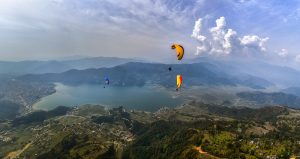
A Guide to the Best Activities in Pokhara
There’s certainly a reason why Pokhara is a top traveling destination for tourists, national or international. However, suppose Pokhara is a destination you wish to travel to in the near future. In that case, you’d be surprised to learn about all the exciting activities in Pokhara you can indulge in while there.
Hearing about all the beautiful lakes, amazing hotels, and the clean city along beautiful hills and mountains might look mind-boggling for oblivious thrill-seekers.
Additionally, choosing between rafting, hiking through the surrounding hills, sunset and sunrise, seeing from various hilltops, trekking, cycling throughout Pokhara valley, boating in various lakes, paragliding from Sarangkot, chartered flying, sightseeing, or bungee jumping might seem hectic.
All the activities mentioned above feel extremely exhilarating while planning for a trip to Pokhara and its surrounding area, which, to be honest, are exciting and enchanting.
But, since you can’t spend all your time out of your work or hometown, you must plan the best activities that’d be worthwhile.
Booking a tour guide or arranging for an activity planner might be a good option but might cause unnecessary expenses. Therefore, in order to minimize your travel expenses, we have put a little effort into you and chosen the best activities that’d make your trip productive and enjoyable.
So, here are five of the top activities to partake in Pokhara for the best experience.
Paragliding in Pokhara
The first activity in this list is the most obvious one. Even people who’ve never been to Pokhara might have heard about the joy of flying in Pokhara’s sky via paragliding. And, there’s a good reason for its popularity.
Flying in the beautiful sky of Pokhara while hundreds of thousands of people spend their daily lives below on the ground would surely be exhilarating. Paragliding allows people to experience the world through a bird’s eye and fly in between the clouds.
In Nepal, if you wish to indulge yourself in paragliding, there’s only one place for that. That’s from the hilltop of the beautiful Sarangkot hill in western Pokhara. Nonetheless, this natural spot is the most suitable one for a great takeoff.
When you get to a certain elevation, you will be able to see the beautiful Pokhara valley alongside all the pleasant and luscious hills with greenery all over them. Not to mention that you’d be able to view the mighty Phewa Lake in its full glory.
Despite these natural attractions, here are a few more of reasons why you should partake in paragliding:
Availability of expert and professional paragliding guides
- Beautiful scenery
- Best quality tools and equipment
- For rare, thrilling moments
- Top-class safety guidelines
- Affordable and high value
So, if you were on a fence, be sure to add paragliding to your to-do list.
Lake Boating and Sightseeing
Pokhara, along with its sister city of Lekhnath, which lies within the Pokhara valley, is also called the city of lakes. Furthermore, these lakes are famous for their beauty and the enchanting view they provide. And a great way to take in these lakes’ beauty and richness can be through boating in the lakes themselves or sightseeing the surrounding area.
The conservation committee of the two beautiful Phewa and Begnas lakes has arranged for a great boating infrastructure. From affordable to luxurious boats available to rent and use, you can make a whole day out of these lakes with your friends and family.
You can visit the gorgeous Pame region or the multiple picnic spots on the opposite side of Phewa Lake. Additionally, Phewa Lake consists of Barahi Temple in the center of the lake, which thousands of religious people visit yearly and can only be reached by boat.
Similarly, you can travel to Majhikuna village, which lies on the opposite shore of the Begnas Lake, via a boat and enjoy the delicious fish from the lake itself caught by the local fishermen.
Though two of these lakes allow luxurious boating services, six of the rest lakes lack the luxury of the first two. Nonetheless, this insufficiency is fulfilled by the beautiful trees surrounding the lakes and the hospitality provided by the local people. Thus, be sure to visit these lakes when in Pokhara.
Bungee Jumping
During dry seasons, bungee jumping is an enthralling adventure sport that everyone should try once in their lifetime. With breathtakingly beautiful locations, Pokhara offers exceptional bungee jumping locations in places such as Hamja, where you can feel amazing adrenaline flow in your body that you’ll always have in your memory.
There are multiple bungee jumping spots in Pokhara. But, it’s only allowed for people above 18, so if you have kids with you, better keep them waiting until they grow up.
Additionally, bungee jumping is an affordable activity where about 4500 rupees can be enough for a jump.
Ultralight Flight
When in Pokhara, the view of Mount Machhapuchre, along with the mountains in the Annapurna range, provides your eyes with a glimpse of heaven. But, if you spend a bit more money, you can admire the Himalayas from a much closer range and with a much better view.
With Ultralight flight booking, you can ride on a small plane that provides you a tour of all the mountains mentioned earlier from a much closer distance. Furthermore, this flight, cheaper than mountain flights, allows the traveler to enjoy the view of settlements and the green hills and houses in Pokhara valley from a bird’s view.
While extremely safe, ultralight flights provide a personalized experience that cannot be duplicated anywhere other than Pokhara.
Cycling
An underrated activity that suits the landscape of Pokhara is cycling. Multiple hills, as well as the beautiful blacktopped roads throughout Pokhara city, are perfect for day-long bicycling trips.
Furthermore, with bicycling packages available for multiple individuals throughout Pokhara, getting a hold of a few cycles can be equally convenient.
Bicycling Routes in Pokhara
If you really look into it, there are more than 30 amazing biking routes within the Kaski district. But, since the routes around Pokhara city are just as enthralling as any other, here are a few of the best routes in Pokhara.
- Around Phewa Tal: If you decide on the trip around the beautiful Phewa lake, it’d be about 28 km long. Renting bicycles is easily accessible throughout multiple shops or lodges around the lakeside area. Moreover, when you take this trip, you can enjoy the enchanting view of Phewa Lake from all sides.
- Lovely Hill and Methlang: The ride around the lovely hill and Methlang can be a nice morning ride with a good mix of dirt road and single tracks. Furthermore, this 20-25 km trail has paths from an elevation of 460 m to 1100 m from sea level.
- Downhill biking from Sarangkot: As mentioned earlier, the luscious Sarangkot hill consists of a mesmerizing view of the whole Pokhara valley. So, while riding downhill from the hill, you can enjoy the fresh air while having a great view of people flying in the sky above you on the way to Phewa Taal.
If you had a certain time limit for your visit to Pokhara, the activities mentioned above would all be worth your precious time and money. Although you enjoy these adventures and want more, there are always more activities in Pokhara and basically many amazing things available to do in Pokhara.
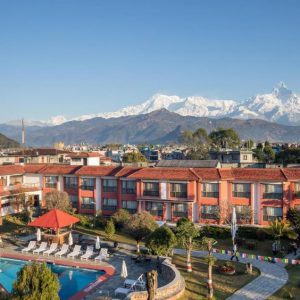
Elevate Your Stay with Luxury Hotels in Pokhara
Pokhara is a top traveling destination with a lot to offer tourists of all backgrounds. However, suppose you’re thinking of visiting Pokhara in the near future. In that case, you’d be surprised to learn about all the gorgeous locations and hotels in Pokhara and the activities you can participate in while you’re there.
Also, during your stay in Pokhara, you’ll be amazed by the many resorts and hotels you can choose from, all equipped with excellent facilities and services.
The idea of all the beautiful lakes, open hills, and mountains surrounding this beautiful city might seem incomprehensible to thrill-seekers. But, after spending a day exploring Pokhara, you’d want the same level of satisfaction from your stay.
You won’t need to worry, though, as you can choose from hundreds of top-notch hotels and resorts in this beautiful city. Of course, that might pose a problem since you just need a single place to rest at the end of the day.
Luckily, we have dug in a bit deeper and researched to help you find the best lodging and dining options in Pokhara. After looking at countless options, here are five of the best hotels to stay at during your trip to Pokhara.
Rupakot Resort
There are many ideal vacation destinations, such as Rupakot Resort – a Himalayan enclave that combines fun activities and exclusive accommodation for holidaymakers while retaining a relaxed Himalayan atmosphere and impressive communal surroundings.
Named after the gorgeous and lustrous hill surrounding the beautiful Rupa taal, Rupakot resort provides its guests with one of the finest lodging experiences in Pokhara. Furthermore, a spectacular view of Mount Annapurna and Machhapuchhre that guests can view from within the resort further adds to the appeal of the place.
Unlike many of the other resorts, Rupakot resort does not lie near the popular lakeside area. As the resort lies on a hill overlooking Lekhnath Municipality, traveling there can be a bit of a commute.
As of recently, the resort has been offering discounted shuttle service, which allows its guests and in-house staff to commute easily back and forth from the resort.
Furthermore, here are a few of the services and amenities provided by the Rupakot Resort team for their guests:
Within the Confines of the property:
- Free Parking
- Free High-Speed Internet (WiFi)
- Pool
- Fitness Center with Gym / Workout Room
- Free breakfast
- Hiking
- Children Activities (Kid / Family Friendly)
- Kids pool
The high quality of the resort’s comfort and luxury can make it an expensive place to stay. It costs approximately 15 thousand to 18 thousand rupees per night for the services provided.
Hotel Barahi
With its central location on Pokhara’s famous lakeside, Hotel Barahi offers its guests excellent views of the Annapurna and Machapuchare mountains and easy access to Pokhara’s thriving and enchanting lake street.
Furthermore, its conference halls and pleasant lawns cater to the needs of its guests. Moreover, it is 3 km from Pokhara’s domestic airport, so guests do not need to hassle to get there.
Additionally, the Hotel Barahi team offers its guests the following services and amenities:
Within the Confines of the property:
- Free Parking
- Free High-Speed Internet (WiFi)
- Pool
- Free breakfast
- Bicycle rental
- Boating
- Children’s television networks
- Airport transportation
- Secured parking
- Wifi
- Pool/beach towels
Furthermore, it costs roughly ten thousand to twelve thousand rupees for the services provided per night due to the high level of comfort and luxury the resort offers.
Hotel Middle Path and Spa
The beauty of Pokhara attracts visitors from all over Nepal and worldwide. Some like to pay top bucks for their luxurious accommodations here, but not everyone can afford it.
In contrast, Hotel Middle Path and Spa provide top-quality luxurious service at a much more affordable price.
Located at the heart of Pokhara’s top attraction of Lakeside, Hotel Middle Path and Spa is one of the best service-oriented hotels for budget travelers.
Furthermore, with the availability of a beautiful garden, swimming pool, 24-hour front desk service, along with a fine breakfast buffet, no customer would leave the hotel unfulfilled.
Additionally, the Hotel Barahi team offers its guests the following services and amenities:
Within the Confines of the property:
- Free Parking
- Free High-Speed Internet (WiFi)
- Saltwater pool
- Sauna
- Free breakfast
- Bicycle rental
- Boating
- Airport Transportation
In addition to these amazing services, Hotel Middle Path and Spa is located just 5 minutes of walking distance from the beautiful Phewa Lake. Furthermore, all these amazing services can be had for just 4 thousand rupees. So, do not let this chance pass by.
Fish Tail Lodge
One of the most unique lake resorts, Fish Tail Lodge, is located on a peninsula between a forest-covered hill and Fewa Lake, offering phenomenal views from every angle. Guests are picked up from the shore of the lake by boat or floating suttles.
Fish Tail Lodge has been providing their services since 1960, initially from unique round cottages which were located amidst a lush green garden.
If you do not prefer the Hi-Fi outlook most hotels provide, this small hotel with very high standards in terms of its services can be your ideal place.
Additionally, the Hotel Barahi team offers its guests the following services and amenities:
Within the Confines of the property:
- Free internet
- Pool
- Fitness Center with Gym / Workout Room
- Bar / lounge
- Airport Transportation
- Conference facilities
- Banquet room
- Spa
A typical night’s stay at the resort typically costs between ten thousand and twelve thousand rupees due to its high level of comfort and luxury.
Himalayan Front Hotel
At the base of Sarangkot Hill, overlooking Fishtail and Annapurna ranges in Pokhara, is the Himalayan Front Hotel, part of the Kathmandu Guest House Group of Hotels.
As similar to the services of the owner’s other hotel, Himalayan Front Hotel has been providing luxurious and relaxing stays for their guests for a very reasonable price.
Additionally, the Hotel Barahi team offers its guests the following services and amenities:
Within the Confines of the property:
- Free Parking
- Free High-Speed Internet (WiFi)
- Pool
- Fitness Center with Gym / Workout Room
- Bar / lounge
- Hiking
- Pets Allowed ( Dog / Pet Friendly )
- Airport Transportation
A hotel of the quality and luxury of this resort can be an expensive place to stay. Although, it costs roughly 5 to 8 thousand rupees per night for the services they provide. In addition, the resort’s hospitality is one the guest will remember for a very long time, and Pokhara info is here to take care of it.
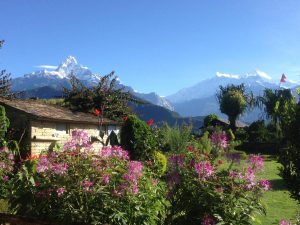
12+ Best Villages in Pokhara to Visit
Pokhara stands out as a vibrant gateway to the majestic Himalayas, among adventurers and nature enthusiasts from all over the world. But are you aware of the enchanting villages in Pokhara? Beyond the serene shores of Phewa Lake and the breathtaking Annapurna mountain range lies a world of hidden treasures. Many picturesque villages reflect the true essence of the natural beauty of Pokhara.
In this blog, we embark on an expedition to paradise, to the must-visit charming villages in Pokhara. These villages have their unique character and allure, that promises an escape from the hustle of urban life and a deeper immersion into the rich tapestry of Nepali culture and natural beauty.
We invite you to join us on a journey where you discover the hidden gems that make Pokhara and its surrounding villages such a remarkable destination. Get ready to explore and experience the magic of these iconic destinations near Pokhara.
Hidden Treasures: 15 Best Villages in Pokhara
The beauty and cultural richness of Pokhara extends far beyond its bustling city. As we venture beyond the tourist hub of Pokhara, a world of serene and scenic villages comes into view. In this blog, we uncover 15 best villages in Pokhara, each with its unique charm. From the majestic landscapes of Ghandruk to the mystical Pothana, these villages promise an authentic and immersive experience, offering a glimpse into the beauty of Nepal and the lifestyle of Nepali. Join us as we embark on a journey to find these hidden treasures, where stunning sceneries, warm hospitality, and most importantly unforgettable memories in villages in Pokhara await.
Ghandruk
Ghandruk, a tribal cultural village in the lap of the Annapurna range is the must-visit village near Pokhara. Nestled at an elevation of approximately 6,365 feet (1,940 meters), Ghandruk boasts some of the most awe-inspiring Himalayan views ever witnessed. This Gurung village is known not only for its breathtaking mountain views but also for its rich cultural heritage and warm hospitality.
Location and Accessibility
Ghandruk is located just about a 2-3 hour drive from Pokhara, making it a perfect spot for a short outing. The journey itself is an adventure as it takes you through winding roads and scenic landscapes. You can reach the village by jeep, bus, or on a hike.
Highlights of Ghandruk Village
- Cultural Exploration
- Gateway to any Annapurna Sanctuary Trek
- Ghandruk offers cozy accommodation options
- Paranomic View of Mt Annapurna, Mt Machapuchare, Gangapurna and Mt Hiunchuli.
Things to do in Ghandruk
- Explore the Ghandruk village and beautiful stone houses.
- Savor authentic Gurung cuisine and hospitality at local teahouses.
- Visit the Annapurna Conservation Area Project (ACAP) Museum to learn about the local culture and environment.
Ghandruk is an absolute beauty near Pokhara, where tradition, nature, and community exist harmoniously. Here you can unwind and soak in the tranquility of nature surrounded by the grandeur of the Himalayas.
Panchase
Our journey through the best villages in Pokhara takes us to the mystical and enchanting Panchase Village, which combines lush forests, cultural significance, and panoramic views in a truly mesmerizing form.
Location and Accessibility
Panchase is nestled in the southwestern part of the Annapurna Conservation Area and is easily accessible from Pokhara. The journey generally involves a combination of driving and hiking, with a total travel time of around 3-4 hours.
Highlights of Panchase Village
- The region is rich in biodiversity, featuring a diverse range of flora and fauna in lush woods.
- Panchase village is home to Panchase Dham, a place of religious and cultural importance for the locals.
- Panchase Hill offers a 360-degree view of the Himalayan mountain range, including Annapurna, Dhaulagiri, and Machapuchare.
Things to do in Panchase Village
- Explore the surrounding forests and observe various species of birds and wildlife.
- Hike to Panchase Hill for the breathtaking sunrise and panoramic mountain views.
- Visit Panchase Dham to learn about the spiritual and cultural significance of the site.
Panchase is a place that seamlessly blends nature, spirituality, and cultural richness. Whether you are a nature lover, a cultural enthusiast, or simply seeking stunning mountain views, Panchase has something to offer.
Ghorepani Poon Hill
Ghorepani Poon Hill is a destination that holds a special place in the hearts of trekkers and nature enthusiasts, offering a blend of natural beauty, cultural richness, and stunning views of mountains that are truly awe-inspiring.
Location and Accessibility
Ghorepani is situated in the Annapurna region, approximately a 3-4 day trek from Pokhara. The journey to Ghorepani is equally special as the final destination itself.
Highlights of Poon Hill
- Poon Hill is famous for breathtaking sunrise views over the Annapurna and Dhaulagiri mountain ranges.
- During the spring season, the region bursts into vibrant colors as the rhododendrons bloom.
- Witness the rich cultural heritage of ethnic groups, such as Gurungs, Magars, and Poon people.
Things to do in Poon Hill
- Explore the Ghorepani village.
- Interact with locals to learn about their cultures and traditions.
- Trek to Poon Hill to witness the spectacular sunrise over the Himalayas.
Ghorepani and Poon Hill is one of the shortest trek of the Annapurna region, drawing in trekkers and travelers from around the globe. The panoramic views, cultural diversity, and the sense of accomplishment that comes from reaching Poon Hill viewpoint make this destination an unforgettable experience.
Dhampus
Moving forward to our journey to the best villages in Pokhara, our next stop is the serene village of Dhampus. Situated on a hillside overlooking the Annapurna and Machapuchare mountains, Dhampus offers a blend of natural beauty, tranquility, and a warm cultural experience to its visitors.
Location and Accessibility
Dhampus is conveniently located just a short drive from Pokhara, taking only 1-1.5 hours to reach. The road to Dhampus offers stunning views of the Himalayan range.
Highlights of Dhampus
- Gurung and Brahmin communities offer visitors a chance to explore their traditions and lifestyles.
- Dhampus is a quiet destination, perfect for those seeking a break from the hustle of city life.
- Dhampus provides dramatic views of the Annapurna and Machapuchare mountains, particularly during sunrise and sunset.
Things to do in Dhampus
- Witness the spectacular sunrise or sunset over the mountains from Dhampus Hill.
- Engage with the villagers and perhaps enjoy a traditional Nepali meal in their homes.
- Explore the nearby forests and trails, making it an excellent destination for short hikes.
Dhampus Village is a beautiful blend of nature and culture, making it a peaceful destination for travelers. If you are a photographer, a cultural adventurer, or simply seeking a calm retreat, Dhampus promises a delightful experience.
Sikles
Our exploration of the charming village near Pokhara takes us to this Gurung village of Sikles, a hidden gem that captivates travelers with its stunning landscapes and unique traditions.
Location and Accessibility
Sikles is located in the Annapurna region, about a 3-4 hour drive from Pokhara, followed by a short hike to reach the village. The journey to the village is also an adventure as it leads through rolling hills and lush forests.
Highlights of Sikles
- Sikles offer the opportunity for individuals to immerse themselves in Gurung traditions and rituals.
- The village is inhabited by the Gurung community and is rich in cultural heritage and warm hospitality.
- Sikles is surrounded by lush green hills and offers awe-inspiring views of the Annapurna and Lamjung mountain ranges.
Things to do in Sikles
- Explore the ancient Gurung houses and witness the detailed woodwork and architectural details.
- Attend cultural events and performances organized by the locals, offering insights into their customs.
- Interact with the friendly Gurung residents, learning about their way of life and savoring delicious local cuisine.
Sikles is a village that combines natural beauty with cultural depth, offering an authentic and immersive experience for travelers. Sikles promises a delightful and enlightening experience as it invites you to discover the charm and culture and a rich tapestry of Gurung traditions and natural wonders.
Sirubari
Sirubari is a pristine hamlet that is often referred to as the model village of Nepal. Situated in the Syangja district, Sirubari is a place where nature and culture coexist harmoniously, offering an authentic and heartwarming experience for travelers.
Location and Accessibility
Sirubari is located approximately 2.5 hours from Pokhara by road. The roadway to this village passes through scenic landscapes, terraced fields, and lush forests, providing a glimpse into rural life in Nepal.
Highlights of Sirubari
- Try the local cuisine
- Explore Sirubari Community Village
- Engage in cultural programs, traditional dances
- Spectacular views of mountains like Manaslu, Machhapuchare, Annapurna, and Dhaulagiri.
- Learn about the traditional architecture from beautifully designed homes and detailed woodwork.
Things to do in Sirubari
- Embark on hikes in the surrounding hills and forests.
- Visit the local monastery and immerse yourself in the spirituality.
- Stroll around the village to learn about local customs and traditions.
Sirubari is a community-based tourism model that benefits the residents, allowing tourists to be a part of their daily lives and culture. The beauty of this exceptional village and the genuine warmth of the people will leave you with memories to treasure for a lifetime.
Lwang Ghalel
Our quest to the beautiful villages in Pokhara brings us to the charming and culturally rich village of Lwang Ghalel. Nestled only 26km away from Pokhara, this village offers a glimpse into the traditions and lifestyle of the Ghale and Gurung communities. For adventure seekers, Lwang Ghalel also offers the thrilling possibility of canyoning in the nearby waterfalls.
Location and Accessibility
Lwang Ghalel is situated at a distance of about 26 kilometers from Pokhara, making it accessible by a scenic 1-2 hour drive. The road takes you through lush forests, terraced fields, and picturesque landscapes.
Highlights of Lwang Ghalel
- Explore the unique traditions and cultural practices of the Ghale and Gurung people
- Lwang Ghalel is popular among adventurous lovers for the possibility of Cannoying in Pokhara
- Lwang Ghalel offers the opportunity to stay with local families, immersing visitors in authentic village life.
Things to do in Lwang Ghalel
- Try Cannoying
- Experience the warmth and hospitality of the locals in community homestays.
- Participate in traditional cultural programs, including dances, songs, and rituals.
Lwang Ghalel is a destination that beautifully preserves the cultural heritage of the Ghale and Gurung communities, providing an enriching experience for travelers. Lwang is the perfect destination for cultural enthusiasts, nature lovers, or thrill-seekers.
Pothana
Another off-beaten village near Pokhara is the tranquil and scenic village of Pothana. Situated in the Annapurna Conservation Area, this village is a paradise for nature lovers and trekkers, offering breathtaking views and a serene atmosphere.
Location and Accessibility
Pothana is only about a 1-2 hour drive from Pokhara. The village is situated at an elevation of approximately 190 meters above sea level, providing a refreshing escape from the lower-altitude regions.
Highlights of Pothana Village
- Pothana Village is an ideal spot for bird and animal watching
- Pothana serves as a base camp for trekkers heading to Annapurna Base Camp
- Pothana is renowned for its views of the Annapurna and Machapuchare mountain ranges.
Things to do in Pothana Village
- Encounter various species of butterflies, birds, and animals.
- Enjoy the panoramic mountain views at sunrise or sunset, capturing the essence of the Himalayas.
- Stay at the local tea houses and lodges, which offer comfortable accommodations and warm hospitality.
Pothana is a destination that harmoniously blends nature, adventure, and tranquility. Whether you are a trekker, a nature enthusiast, or someone in search of serene mountain vistas, Pothana promises an unforgettable and peaceful experience.
Astam Eco Village
The charming village of Astam located in Machhapuchhre Rural Municipality of Kaski is a hidden gem that captivates visitors with its natural beauty. Situated approximately 20km north-west of Pokhara from Astam offers a serene escape from the bustling city life.
Location and Accessibility
Astam is easily accessible by 3-4 hours jeep/ private vehicle ride, making it a convenient destination for a day trip or an extended stay. The scenic route unveils lush landscapes, providing a picturesque drive for travelers.
Highlights of Astam
- Best sunset and sunrise views.
- Explore the traditional lifestyle of the locals, known for their warm hospitality.
- Astam boasts panoramic views of the surrounding hills and Annapurna mountain range.
Things to do in Astam
- Take in breathtaking sunrise and sunset views against the backdrop of the Annapurna range.
- Visit the nearby Australian Base Camp for a more extensive adventure.
- Interact with the villagers, experiencing their customs and traditions firsthand.
Astam attracts tourists seeking a peaceful retreat surrounded by nature’s wonders.
Kade
Nestled in the lap of nature, Kade is a quaint village that enchants visitors with its simplicity and scenic charm. Located approx. 30 km away from Pokhara, Kade is an ideal destination for those yearning for a peaceful getaway.
Location and Accessibility
Kade can be reached within 45-50 minutes rides from Pokhara, through winding roads in charming rural scenery.
Highlights of Kade
- Discover the authenticity of rural life and agriculture practices in Kade.
- The village provides a gateway to various trekking trails and natural attractions.
- Marvel at the traditional architecture and cultural richness of the community.
Things to do in Kade
- Nature walks to explore the surrounding forests and landscapes.
- Visit the local markets to experience the flavors of traditional cuisine.
- Engage in cultural exchanges with the friendly locals.
Kade promises a serene retreat for those seeking a connection with nature and local culture.
Naudanda
Naudanda is a village that sits gracefully on the hills near Pokhara. With a distance of approximately 40km from Pokhara, Naudanda is a perfect short trek that offers breathtaking views of the Annapurna and Manaslu mountain ranges.
Location and Accessibility
Naudanda is accessible by jeep within 35 minutes ensuring a delightful journey through scenic landscapes and charming villages.
Highlights of Naudanda
- Naudanda serves as a starting point for many trekking trekking trails.
- Explore the village, known for its traditional architecture and warm hospitality.
- Witness stunning sunrise and sunset views, casting a warm glow over the majestic Himalayan peaks.
Things to do in Naudanda
- Capture the mesmerizing scenery with your camera or simply enjoy the moment.
- Engage in local homestays to experience the authentic lifestyle of the villagers.
- Hike to nearby viewpoints for a closer look at the surrounding mountains.
Nirmal Pokhari
Situated in the Lekhnath, Nirmal Pokhari enchants visitors with its pristine lake views and tranquil surroundings. Located in Lekhnath, Nirmal Pokhari is a heaven for nature lovers that provides the view of three big lakes Pokhara, Fewa Lake, Begnas Lake, and Rupa Lake.
Highlights of Nirmal Pokhari
- Offers a peaceful retreat away from the hustle of city lifestyle.
- Experience the simplicity of village life and connect with the friendly locals.
- Nirmal Pokhari is a birdwatcher’s paradise, with various species to spot in the surrounding area.
Things to do in Nirmal Pokhari
- Bird Watching.
- Explore the varied vegetation of the area.
- Take strolls around the village, soaking in the natural beauty.
Nirmal Pokhari promises a serene and rejuvenating experience for those seeking solace in nature.
Kaskikot
Perched on a hill overlooking the Pokhara Valley, Kaskikot is a village that charms visitors with its breathtaking views and cultural allure. Located approximately 40km from Pokhara, Kaskikot offers a perfect blend of history and natural beauty. The ruins of the old palace of the Kaski still exist in the Kaskikot.
Accessibility
Kaskikot is easily accessible by your private vehicle or hired vehicle within 40 minutes.
Highlights of Kaskikot
- Marvel at the panoramic views of the Pokhara Valley and the surrounding mountains.
- Explore the historical significance of Kaskikot, with ancient temples and cultural landmarks.
- Engage in agricultural activities with the locals, experiencing the rural way of life.
Things to Do In Kaskikot
- Visit the Kaskikot Durbar for a glimpse into the region’s historical and cultural heritage.
- Take a leisurely walk through the village, interacting with the friendly residents.
- Savor local cuisine at traditional eateries for an authentic culinary experience.
Kaskikot invites travelers to step back in time and appreciate the beauty of a bygone era.
Siding
Tucked away in the hills near Pokhara, Siding is a hidden gem that offers a serene escape from the bustling city life. Located 2-3 hours away from Pokhara, Siding is a peaceful village known for its natural beauty and cultural simplicity.
Location and Accessibility
Siding is accessible by jeep/ private vehicles in just 2-3 hours, providing a scenic drive through charming landscapes.
Highlights of Siding
- Experience the authenticity of rural life in Siding, away from the tourist crowds.
- Siding is a starting point for treks to the Ghorepani Poon Hill circuit.
- Interact with the friendly locals and participate in agricultural activities.
Things to do in Siding
- Witness the beautiful terrace farming.
- Stay in local homestays for an experience in the village lifestyle.
- Explore the surrounding forests and enjoy the tranquility of the natural surroundings.
Siding invites travelers to unwind in a peaceful environment and embrace the simplicity of village life.
Lumle
Lumle makes it to the end of our list of villages in Pokhara due to the blend of natural beauty, adventure, and cultural richness. This village is located just a short drive from Pokhara and serves as a portal to some of the world’s most breathtaking mountain scenery.
Location and Accessibility
Lumle is just a short drive from Pokhara, approximately 45 minutes away. This convenient proximity makes Lumle a popular starting point for treks into the Annapurna region, including the renowned Annapurna Base Camp trek.
Highlights of Lumle
- Lumle serves as a trekking hub for expeditions into the Annapurna Sanctuary.
- The village is home to the Gurkha Memorial Museum and the Annapurna Eco-Museum. It also boasts a beautiful botanical garden that showcases a wide variety of Himalayan flora.
- Lumle is inhabited by Gurung, Brahmin, and other ethnic communities, offering visitors a chance to explore extensive traditions and lifestyles.
Things to Do in Lumle
- Explore the lush botanical garden to discover the diverse plant life of the Himalayas.
- Visit the Museum and the Annapurna Eco-Museum to gain insights into the local culture, history, and environment.
- Interact with the friendly villagers to learn about their customs, partake in cultural events, and try authentic Nepali cuisine.
Lumle is a destination that provides the essence of the Annapurna region, offering not only natural beauty but also a wealth of cultural and historical insights.
Final Say
As we wrap up this blog, it is clear that these hidden treasures extend beyond the bustling city of Pokhara. The villages we have listed are not only rich in the natural beauty of the Himalayas but are also rich in cultural heritage.
We hope this exploration has inspired you to embark on your adventures to discover these hidden villages in Pokhara. These villages around Pokhara are more than just places on a map, they are breathing testaments of the beauty of nature and cultural diversity of this extraordinary country.
FAQ
How do I reach the villages near Pokhara from the city?
To reach the charming villages surrounding Pokhara, you can use various modes of transportation such as jeeps, public buses, or even hiking.
Are there opportunities for adventure activities in the villages around Pokhara?
Yes, adventure activities such as canyoning, trekking, and bird watching are possible in villages near Pokhara.
How can I immerse myself in the local culture during my visit to these villages?
Discover ways to engage with the local communities and experience their traditions firsthand. You can take part in activities like attending cultural events, interacting with villagers, and trying authentic local cuisine, ensuring a deeper connection with the rich tapestry of Nepali culture.